Similar presentations:
FM 5-277 Headquarters department of the army
1.
*FM 5-277HEADQUARTERS
DEPARTMENT OF THE ARMY
Washington, DC, 9 May 1986
Field Manual
No. 5-277
B A I L E Y
B R I D G E
Distribution Restriction: Approved for public release. Distribution is unlimited
*This publication supersedes
TM 5-277, 3 August 1972.
i
2.
FM 5-277C1
Change 1
Headquarters
Department of the Army
Washington, DC, 15 August 1991
DISTRIBUTION RESTRICTION: Approved for public release; distribution is unlimited.
3.
FM 5-277ii
DISTRIBUTION RESTRICTION: Approved for public release; distribution is unlimited.
9 May 1986
4.
FM 5-277iii
5.
FM 5-277LIST OF FIGURES - BAILEY BRIDGE (FM 5-277)
iv
6.
FM 5-277v
7.
FM 5-277vi
8.
FM 5-277vii
9.
FM 5-277viii
10.
FM 5-277ix
11.
FM 5-277x
12.
FM 5-277xi
13.
FM 5-277xii
14.
LIST OF TABLES – BAILEY BRIDGE (FM 5-277)xiii
15.
FM 5-277x i v
16.
FM 5-277x v
17.
FM 5-277PREFACE
This manual is intended for use by engineer bridge to the British War Office which paid
commanders, staff officers, combat engi- him the equivalent of $48,000 in 1985
neers, and bridge specialists who are required American currency.
to build the Bailey bridge.
The Bailey bridge used in World War II was
The purpose of this manual is to provide the designed to be moved, rebuilt, or replaced in
user instructions needed to build the standard several hours, even under enemy fire. It was
Bailey bridge and its several variants. It used widely and well by Allied armies in Italy
describes bridge components, loading and and northwest Europe, 1943-45. British Field
transport, methods of assembly, and main- Marshal Lord Bernard Law Montgomery
tenance. It also describes special applica- said: “Without the Bailey bridge, we should
tions, such as two-lane, extra-wide, deck, not have won the war. It was the best thing in
railway, pier- and barge-supported bridges, that line we ever had.” Donald Bailey was
and towers built from Bailey bridge compo- knighted in 1946 for this contribution to the
Allied victory in World War II.
nents.
The Bailey bridge has several distinctive
features. It is built by manpower alone. It is
made entirely from prefabricated parts, the The proponent agency of this publication is
most notable of which are its light-steel the US Army Engineer School. Submit
panels linked by pinned joints. It is a changes for improving this publication on
‘through-type bridge. And it can be moved DA Form 2028 (Recommended Changes to
Publications and Blank Forms) and forward
from one site to another.
to Commandant, US Army Engineer School,
The Bailey bridge was invented by Donald ATTN: ATZA-TD-P, Fort Belvoir, Virginia
Coleman Bailey, an English civil engineer. 22060-5291.
In 1941, Bailey gave his first sketch of the
xvii
18.
FM 5-2771
19.
FM 5-277This change supersedes page 2.
CHAPTER 1
HISTORY AND USE OF THE BRIDGE
At the outset of World War II, the United
States (US) Army sought a versatile bridge
that could span a variety of gaps and be
quickly assembled by manpower alone. For
this reason, we adopted the design for the
British prefabricated Bailey bridge, US
nomenclature Ml. We revised the design to
provide a greater roadway width of 12% feet
and designated it the Panel Bridge, Bailey
M2 (Figure l-l). The British then modified
the US version by widening the bridge again,
thus producing the extra-wide Bailey M3
bridge. The US Army does not stock the M3
bridge in its arsenal. The Bailey bridge is a
through-type truss bridge, the roadway being
carried between two main girders. The trusses
in each girder are formed by 10-foot panels
pinned end to end. In this respect, the Bailey
bridge is often referred to as the “panel” or
“truss” bridge.
ADVANTAGES
Some of the characteristics that make the
Bailey bridge valuable to field commanders
are—
It is easy to install. Each part of the
Bailey bridge is a standard machinemade piece and is interchangeable among
spans. Inmost cases, no heavy equipment
is required to assemble or launch a Bailey
bridge; only basic pioneer skills and equipment are needed.
2
It is highly mobile. All parts of the bridge
can be transported to and from the bridge
site by 5-ton dump trucks and trailers.
It is versatile. Standard parts can be used
to assemble seven standard truss designs
for efficient single spans up to 210 feet
long and to build panel crib piers supporting longer bridges. With minor nonstandard modifications, the expedient
uses of bridge parts are limited only by
the user’s imagination.
CONSTRUCTION
Transverse floor beams, called transoms, are
clamped to the bottom chords of the trusses
and support stringers and decking. Sway
braces between the girders provide horizontal
bracing; rakers between the trusses and
transoms keep the trusses upright; and
bracing frames and tie plates between the
trusses provide lateral bracing within each
girder.
Main girders
The main girders on each side of the centerline of the bridge can be assembled from a
single truss or from two or three trusses side
by side. For greater strength, a second story
of panels can be added to the trusses. The
upper stories are bolted to the top chord of the
lower story. For greatest strength, a third
story is added. These three basic types are
shown in Figure 1-2 (page 4). The types of
possible truss assemblies are given in Table
1-1 (page 4). A single-truss, double-or triplestory bridge is never assembled because it
would be unstable. All triple-story bridges
with the deck in the bottom story are braced
at the top by transoms and sway braces
which are fastened to overhead-bracing supports bolted to the top chords.
Materials
The decking, called chess, is wood. Panels,
end posts, transoms, and ramps are a lowalloy, high-tensile steel. All other parts are
carbon structural steel. All joints in the parts
are welded.
Deck
The clear roadway between curbs, called ribbands, is 12 feet 6 inches wide. The transoms
supporting the roadway are normally set on
the bottom chords of the bottom story. Footwalks can be carried on the transoms outside
of the main trusses on each side of the bridge.
Bearings
End posts pinned to the end of each truss sit
on cylindrical bearings which rest on a steel
base plate. On soft soil, timber grillage is
used under the base” plates to distribute the
load. The bridge can be assembled between
banks of different elevations, but the slope
should not exceed 30 to 1.
20.
This change supersedes page 3.FM 5-277
TYPES OF STRUCTURES
Panel bridge equipment can be used to
assemble fixed bridges and panel crib piers
and towers. Other special structures such as
floating bridges, suspension bridges, retractable bridges, and mobile bridges, can be
assembled using special parts. Panel bridge
equipment is normally used to assemble fixed
simple-span, through-type bridges from 30 to
210 feet long. The bridge can be assembled to
meet varying conditions of span and load.
Bridge weight per bay is given in Table 1-2
(page 5). The following special assemblies are
also possible:
Two-lane, through-type bridges; deck-type
bridges; railway bridges; bridges on piers;
and floating bridges can be built with
panel bridge equipment.
Panel crib piers and towers up to 70 feet
high supporting continuous spans, and
up to 110 feet high supporting broken
spans, can be assembled with panel bridge
equipment and special crib-pier parts.
Many expedient structures can also be
built with panel bridge equipment. These
include causeways, box anchors, towers
for floating bridge cables, and loading
hoppers and gantries.
3
21.
FM 5-2774
22.
This change supersedes page 5.FM 5-277
5
23.
FM 5-277CHAPTER 2
BASIC
EQUIPMENT
BRIDGE PARTS 6
ERECTION EQUIPMENT 15
BRIDGING TRUCK LOADS 19
The Bailey M2 bridge set contains 29 different
items of bridge parts and 30 items of erection
equipment. Table A-1 in Appendix A shows
the number of parts needed to build a specific
Bailey bridge.
WARNING: Due to the size and weight of
components, personnel are advised to use
extreme care when handling them. Failure
to do so may result in serious.
PANEL
The panel (Figure 2-1) is the basic member of
the bridge. It is a welded, high-tensile steel
truss section 10 feet (3.0 meters) long, 5 feet 1
inch (1.5 meters) high, and 6 1/2 inches (16.5
centimeters) wide. It weighs 577 pounds (262
kilograms) and can be carried by six soldiers
using carrying bars.
The horizontal members of the panel are
called chords. Both chords have male lugs at
one end and female lugs at the other. Panels
are joined end to end by engaging these lugs
and placing panel pins through the holes in
the lugs. On the top of the bottom chord are
four seatings or dowels. The beams that
6
BRIDGE PARTS
support the bridge roadway will be clamped
to these dowels. Table 2-1 lists the holes in the
panel.
PANEL PIN
The panel pin (Figure 2-2) is 8 5/16 inches (21.1
centimeters) long, 1 7/8 inches (4.8 centimeters)
in diameter, and weighs 6 pounds (2.7 kilograms). It has a tapered end with a small hole
24.
FM 5-277for a retainer clip. A groove is cut across the
head of the panel pin parallel to the bridge
pin retainer hole. Panel pins should be
inserted with the groove horizontal; otherwise, the flanges of the panel chord channels
make it difficult to insert the retainer clip.
WARNING: Never jack against transoms
that are held in place by transom clamps, as
the clamps will fail. This failure may result
in severe injury or death and/or extreme
damage to bridge components.
SHORT PANEL PIN
The short panel pin (Figure 2-3) is 3/4 inch (1.9
centimeters) shorter than the normal panel
pin and weighs 5.8 pounds (2.6 kilograms). It
is used to pin the end posts of the outer and
middle trusses in a triple-truss bridge.
TRANSOM
The transom (Figure 2-4, page 8) is a steel
beam that supports the floor system of the
bridge. It is 10 inches (25.4 centimeters) by 19
feet 11 inches (6.1 meters) long. It has a 4 1/2inch (11.4 centimeters) flange and a 5/16-inch
7
25.
FM 5-277WARNING: Sway brace is a multi-hinged
component; use care when handling to
prevent injury.
(0.8 centimeter) cover plate on each flange.
SWAY BRACE
The transom weighs 618 pounds (280 kilograms). It can be carried by eight soldiers The sway brace (Figure 2-6) is a 1 1/8-inch (2.9
using carrying tongs clamped to the upper
flange or carrying bars inserted through centimeters) steel rod, hinged at the center,
holes in the web.
The underside of the transom has six holes
into which the panel dowels fit. The transom
rests on the lower chord of the panel and is
held in place with a transom clamp. The
upper side of the transom has six lugs with an
additional lug near each end. The stringers
and rakers (explained later in this chapter)
attach to these lugs.
Transoms are normally spaced 5 feet (1.5
meters) apart, one at the middle and one at
the end of each panel, to support vehicles of
class 70 or less. Four transoms per bay—two
in the middle and one at each end of the
panel—are required to support vehicles over
class 70.
WARNING: Transom clamp is a hinged
component; use care when handling to
prevent injury.
TRANSOM CLAMP
The transom clamp (Figure 2-5) is a hinged
screw-in type clamp, 13 1/2 inches (34.3 centimeters) high and 8 inches (20.3 centimeters)
across the top. It weighs 7 pounds (3.2 kilograms). It clamps the transom to the vertical
and bottom chord of the panel. It is tightened
by a vise-handled screw.
8
and adjusted by a turnbuckle. It weighs 68
pounds (30.8 kilograms). At each end is an
eye, and a chain with a pin attached. This pin
is inserted through the eye to the sway brace
to the panel. The sway brace is given the
proper tension by inserting the tail of an
erection wrench in the turnbuckle and
screwing it tight. The locknut is then screwed
up against the turnbuckle. Two sway braces
are required in the lower chord of each bay of
the bridge, except the first bay of the
launching nose, and in each bay of overhead
bracing.
RAKER
The raker (Figure 2-7) is a 3-inch (7.6 centimeters) steel beam with a 2 3/8-inch (6.0 centimeters) flange. It is 3 feet 8 5/16 inches (1.11
meters) long and weighs 22 pounds (10.0
kilograms). A raker connects the ends of the
26.
FM 5-277transom to the top of one end of each panel of
the inner truss. This prevents the panels from
overturning. An additional raker is used at
each end of the bridge. Both ends of the raker
have hollow dowels for the bracing bolts. The
dowels fit through a hole in the panel and a
hole in the transom.
BRACING FRAME
The bracing frame (Figure 2-8) is a rectangular frame, 4 feet 3 inches (1.3 meters) by
1 foot 8 inches (50.8 centimeters) with a
hollow conical dowel in each comer. It weighs
44 pounds (20.0 kilograms). The bracing
frame is used to brace the inner two trusses
on each side of the double- and triple-truss
bridge. Bracing bolts attach the bracing
frames horizontally to the top chords of the
bridge, and vertically on one end of each
panel in the second and third stories.
TIE PLATE
A tie plate (Figure 2-9, page 10) is a piece of
flat steel 2 1/2 by 3/8 by 12 inches (6.4 by 1.0 by
30.5 centimeters) weighing 3 1/2 pounds (1.6
kilograms). It has a hollow conical dowel at
each end. The tie plate is used only in tripletruss bridges. It secures the second truss to
the third truss using the unoccupied raker
holes in the panels at each joint and at the
ends of the bridge.
9
27.
FM 5-277BRACING BOLT
A bracing bolt (Figure 2-10) is 3/4 inch
(1.9 centimeters) in diameter, 3 1/2 inches
(8.9 centimeters) long, and weighs about
1 pound (0.5 kilograms). A special lug on its
head prevents rotation when the bolt is
tightened. A l 1/8inch (2.9 centimeters) wrench
is used to tighten it. The bracing bolt is used
to attach rakers, bracing frames, and tie
plates to panels. It is inserted into the hollow
dowels of the braces to draw parts into proper
alignment.
CHORD BOLT
A chord bolt (Figure 2-11) is 1 3/4 inches (4.4
centimeters) in diameter, 10 1/2 inches (26.7
centimeters) long, and weighs 7 1/2 pounds (3.4
kilograms). It is tapered through half its
length to assist in drawing the panels into
alignment. A 1 7/8-inch (4.8 centimeters)
wrench is used to tighten the bolt. Chord
bolts join the panels, one above the other, to
form double and triple-story bridges. Two
bolts per panel pass upward through holes in
the panel chords and are tightened with nuts
on the lower chord of the upper story. They
are also used to fasten overhead bracing
supports to the top panel chord.
STRINGERS
Stringers (Figure 2-12) carry the bridge’s
roadway. Each stringer consists of three 4inch (10.2 centimeters) steel beams, 10 feet
(3.0 meters) long, joined by welded braces.
There are two types of stringers: plain
stringers weighing 260 pounds (118 kilograms) and button stringers weighing 267
pounds (122 kilograms). They are identical
except that the latter has 12 buttons which
10
hold the ends of the chess (roadway) in place.
Each bay of the bridge has six stringers: four
plain stringers in the middle, and a button
stringer on each side. The stringers are positioned by the lugs on the top of the transoms.
CHESS
Chess (Figure 2-13), often referred to as deck
or decking, form the road surface. A piece
of chess is 2 inches (5.1 centimeters) by
8 3/4 inches (22.2 centimeters) by 13 feet
10 inches (4.2 meters). It is made of wood and
weighs 65 pounds (29.5 kilograms). It is
notched at the ends to fit between the buttons
of the bottom stringer. Each bay of the bridge
contains 13 chess, which lie across the
stringers and are held in place by the buttons.
Chess are held down by ribbands.
STEEL RIBBAND (CURBS)
A ribband (Figure 2-14) is a metal curb
8 inches (20.3 centimeters) high and 10 feet
(3.0 meters) long. It weighs 162 pounds (73.5
kilograms). It is fastened to the button
stringers by four J-type ribband bolts.
RIBBAND BOLT
A ribband bolt (Figure 2-15) is a J-type bolt, 1
inch (2.5 centimeters) in diameter and 8 5/8
inches (21.9 centimeters) long. It weighs 4 1/2
pounds (2.0 kilograms). A 1 1/2-inch (3.8 centimeters) wrench is used to tighten it. The
ribband bolt fastens the ribband to the button
stringers and ramps. The hook end of the bolt
grips the lower flange of the outer beam of the
button stringer or ramp.
28.
FM 5-277END POSTS
End posts (Figure 2-16, page 12) are used on
both ends of each truss of the bridge to take
the vertical shear. They are placed only on
the story carrying the decking. They are 5foot 8-inch (1.7 meters) columns made of two
4-inch (10.1 centimeters) channels and plates
welded together. There are two types; male
and female, having male and female lugs,
respectively. These lugs are secured to the
end panels of the bridge by panel pins placed
through holes in the lugs. The male and
female end posts weigh 121 and 130 pounds
(54.9 and 59.0 kilograms), respectively. End
posts have a step to support a transom outside
11
29.
FM 5-277the panel at one end of the bridge. In jacking
the bridge, the jack is placed under the step.
The lower end of the end post has a bearing
block with a semicircular groove which fits
over the bearing.
BEARING
The bearing (Figure 2-17) spreads the load of
the bridge to the base plate. A bearing is a
welded steel assembly containing a round
bar which, when the bridge is completed,
supports the bearing blocks of the end posts.
During assembly of the bridge, it supports
the bearing block of the rocking roller (explained later in this chapter). The bar is
divided into three parts by two intermediate
sections that act as stiffeners. The bearing is
4 5/16 inches (11.9 centimeters) high and
weighs 68 pounds (30.8 kilograms). One
bearing is used at each corner of a singletruss bridge and two bearings per corner for a
double- or triple-truss bridge.
BASE PLATE
The base plate (Figure 2-18) is a welded steel
assembly with built-up sides and lifting-hook
eyes on the top at each corner. It is used under
the bearings to spread the load from the
bearings over the ground or grillage. The
bottom surface of the baseplate is 13 1/2 square
feet (1.25 meters 2). The base plate weighs 381
pounds (173 kilograms) and is large enough
for the bearings at one corner of a single-,
double-, or triple-truss bridge. Bearings can
slide 9 inches (22.9 centimeters) longitudinally on the baseplate. The numbers 1,2, and
3 are embossed on the edges of the base plate
to indicate the position of the plate under the
inner truss of single-, double-, and triple-truss
bridges respectively.
RAMPS
Ramps (Figure 2-19) are similar to stringers
but consist of three 5-inch (12.7 centimeters),
instead of 4-inch (10.2 centimeters), steel
beams. They are 10 feet (3.0 meters) long and
are joined by welded braces. The lower surface
of the ramp tapers upward near the ends.
There are two types of ramps: plain ramps
weighing 338 pounds (153 kilograms), and
button ramps weighing 349 pounds (158 kilograms). They are identical except that. the
latter have 12 buttons which hold the ends of
the chess in place. The ends of the ramps fit
into lugs on the transoms at the ends of the
bridge.
RAMP PEDESTAL
Ramp pedestals (Figure 2-20) are built-up
welded steel assemblies weighing 93 pounds
(42.2 kilograms). They prevent the transoms
supporting multiple-length ramps from over-
12
30.
FM 5-277turning and spread the transom load over the
ground. They are held in place by spikes or
pickets driven through holes in their base
plates.
FOOTWALK
The footwalk (Figure 2-21, page 14) may be of
wood or aluminum. The wood footwalks are 2
feet 6 inches (0.8 meter) wide and 10 feet (3.0
meters) long. The aluminum footwalks are
25 3/4 inches (65.4 centimeters) wide and 9 feet
11 1/2 inches (3.0 meters) long. Supported on
footwalk bearers, footwalks are laid along
the outer sides of the bridge for use by foot
troops.
FOOTWALK BEARER
A footwalk bearer (Figure 2-22) is a built-up
beam of pressed steel 4 feet (1.2 meters) long,
13
31.
FM 5-277weighing 23 pounds (10.4 kilo grams). Bearers
are attached to all transoms and hold the
footwalk post.
FOOTWALK POST
A footwalk post (Figure 2-23) is 4 feet (1.2
meters) high, weighs 10 pounds (4.5 kilograms), and is fitted into every footwalk
bearer. Hand ropes are threaded through two
eyes on each post and secured either to
holdfasts on the banks or end footwalk posts.
OVERHEAD-BRACING SUPPORT
The overhead-bracing support (Figure 2-24)
is used to clamp overhead transoms and
14
sway braces to trusses for overhead bracing
of triple-story bridges. The support is a welded
metal assembly that weighs 150 pounds (68.0
kilograms). It is fastened to the tops of thirdstory panels by chord bolts. A transom is
seated over the pintles on top of the support
and secured by cleats over the lower flange
held by four nuts and bolts. One support per
girder is placed on each bay of bridge.
32.
FM 5-277ERECTION EQUIPMENT
ROCKING ROLLER
The rocking roller (Figure 2-25), weighing 206
pounds (93.4 kilograms), consists of three
rollers housed in a balanced arm which fits
over the bearing, and is free to rock on it. Two
side rollers on the flange on each side of the
rocking roller frame act as guides for the
trusses. The side rollers can be removed from
the flanges by removing split pins from
spindles underneath the flange; they then
remain loosely attached to the frame by a
chain. The rollers distribute the bridge load
along the bottom chord during launching.
The maximum allowable load on one rocking
roller is 30 tons (27.2 metric tons).
PLAIN ROLLER
The plain roller (Figure 2-26) is 2 feet 1 1/2
inches (64.8 centimeters) wide and weighs
116 pounds (52.6 kilograms). It consists of a
welded housing containing a single roller
split in two. The maximum allowable load on
one roller is 10 tons (9.1 metric tons). Trusses
of single-truss bridges can be carried on
either half of the roller. Second and third
trusses of triple-truss bridges are carried on
both halves.
TRANSOM ROLLER
The transom roller (Figure 2-27) is a roller
having an outside diameter of about 1 7/8
inches (4.8 centimeters) (or 1 1/2-inches [3.8
centimeters] extra-heavy steel pipe) and a
15
33.
FM 5-277length of 6 5/8 inches (16.8 centimeters). The
roller is fitted with bronze bushings at each
end and revolves on a l-inch (2.5 centimeters)
diameter steel pin mounted in a steel frame
which is built up from standard steel bars
and angles. The roller assembly is 8 inches
(20.3 centimeters) long, 7 5/8 inches (19.4 centimeters) wide, and 5 3/4 inches (14.6 centimeters)
high overall. It weighs about 12 pounds (5.4
kilograms). The roller is used to make the
placement and removal of transoms easier
during the assembly and disassembly of the
bridge.
WARNING: Two personnel are required
on each jack handle to operate jack. These
two persons must work together to prevent
either from taking all of the load.
JACK
The jack (Figure 2-28) is used to lift the bridge
on and off the rocking rollers. It is a mechanical lifting jack (the type normally used in
rigging, railroad, and construction work). It
has a lifting range of 15 inches (38.1 centimeters) and a capacity on the top of 15 tons
(13.6 metric tons). When the weight is carried
on its toe, its capacity is only 7 1/2 tons (6.8
metric tons). Jacks from different manufacturers have different spacing (pitch) between
the teeth, as listed in Table 2-2. Where jacks
are lifting at the same point, all jacks used
must have the same tooth pitch so they can be
operated in unison. The jack weighs 128
pounds (58.1 kilograms).
1 6
JACK SHOE
The jack shoe (Figure 2-28) is a welded
assembly which fits over the bearing and
supports the jack. In jacking under the step of
the end posts, the bearing can be placed
readily without removing the jack shoe. The
shoe is 4 3/16 inches (10.6 centimeters) high
and weighs 36 pounds (16.3 kilograms). It fits
over the bearing on the base plate.
WRENCHES
The wrenches provided in the bridge set are
shown and listed in Figure 2-29.
PANEL LEVER
The panel lever (Figure 2-30), used in assembling the second and third trusses after the
first truss is in place over the gap, is a wooden
bar 7 feet 9 inches (2.4 meters) long weighing
48 pounds (21.8 kilograms). It has a fulcrum
near the center and a lifting link at the end.
The lifting link has a swiveling crosspiece
which can be readily attached to the top of a
panel by passing it through the upper chord
and turning it. The upper end of the link
slides in a slot—the inner end of the slot is
used when erecting the second truss, the
outer end is used when erecting the third
truss. The fulcrum is always placed on the top
of the first truss. Two levers per panel are
required, with two soldiers operating each
lever.
CARRYING BAR AND TONGS
A wooden carrying bar (Figure 2-31) is 3 feet 6
inches (1.1 meters) long and reinforced by a
steel band at the middle. It is used to carry
panels and transoms. It weighs 8 pounds (3.6
kilograms). Carrying tongs are steel and
34.
FM 5-277shaped like railroad tongs, as shown in Figure
2-32. These tongs are used to carry transoms
by clamping them over the top flange. One
soldier carries one of the two handles. Normally, four pair of tongs and eight soldiers
are used to carry a transom.
17
35.
FM 5-277CHORD JACK
The chord jack (Figure 2-33) consists of two
welded steel frames joined by a knucklethreaded screw assembly. It is operated by a
ratchet lever. The lever has a shackle at its
end to which a rope can be attached, making
operation easier. The chord jack is used to
force the panels apart so the chord lug holes
align and the chord bolts can be inserted.
PIN EXTRACTOR
The pin extractor (Figure 2-34) assists in
dismantling the bridge. After the pin has
been driven part way out, and the recess
under the head of the pin is exposed, the pin
extractor grips the pin head and forces the
pin out by a levering action. It is particularly
18
useful for dismantling the third truss of a
triple-truss bridge where the closeness of the
second truss makes it impossible to drive the
pins out with a hammer.
LAUNCHING-NOSE LINK MK II
The launching-nose link Mk II (Figure 2-35)
is about 10 inches (25.4 centimeters) long and
7 inches (17.8 centimeters) wide and weighs
28 pounds (12.7 kilograms). It consists of two
steel frames welded back to back. The lugs of
two panels fit into the link. The sides of the
link have holes into which panel pins can be
inserted. The links lie flush with the underside
of the bottom chords and have a false flange
welded on the bottom edge so the bridge can
be rolled out on launching rollers. It also has
a pintle on the top to seat a transom.
Launching-nose links overcome the sag
occurring when the launching nose is cantilevered over the gap. They are also used
between the upper jaws of span junction
posts during the launching of broken-span
bridges.
TEMPLATES
Two types of templates are provided, one to
locate the bearings for the rocking rollers and
the other for the plain rollers. The rockingroller template (Figure 2-36) weighs 78 pounds
(35.4 kilograms) and consists of a timber base
with timber strips on top forming two spaces
large enough for rocking-roller bearings. At
one end of the template are two angle cleats
which are used as measuring points. The
plain-roller template (Figure 2-37) weighs 22
pounds (10.0 kilograms). It consists of a
timber base with timber strips on three sides
and a steel strip on the fourth. The strips
surround a space large enough for the base-of
a single plain roller. The template also has
two angle cleats at one end for measuring
points.
36.
FM 5-277BRIDGING TRUCK LOADS
BASIC BRIDGE SET
Parts for standard truck loads are drawn
from these basic sets. Tables A-2 and A-3 in
Appendix A list components of the M2 panel
bridge basic set. The set contains enough
parts. and equipment to install two 80-foot
(24.4 meters) double-single M2 bridges with
launching nose or one 130-foot (39.0 meters)
double-double bridge with launching nose.
Conversion Set No. 3, Panel Crib Pier, M2 is
used with equipment from the basic set to
build panel crib piers. Table A-4 in Appendix
A lists component parts of conversion set No.
3. Enough parts are issued with each of these
sets to provide the assembly of a triple-truss
pier supporting two triple-truss broken spans
and containing both horizontal and vertical
stories.
RECOMMENDED BRIDGING LOADS
The engineer company (panel bridge) normally transports one set of the Bailey bridge
on 5-ton dump trucks and 4-ton bolster
trailers. The company has two platoons, each
capable of transporting one 80-foot (24.4
meters) bridge (the most common bridge
installed). The loads shown in Figures 2-38
through 2-47 and Tables 2-3 through 2-13
(pages 20 through 30) have the following
features:
The number of trailers is 40 percent of the
number of trucks. This makes it possible
to use trucks to tow trailers if necessary.
All loads are within the rated capacity of
the assigned vehicles.
Steel cables are used for tiedowns on all
truckloads.
Erection equipment is spread over four
trucks and one trailer, thereby minimizing
the effect of loss or breakdown.
Trucks are loaded with all the female or
all the male panel ends toward the rear of
the vehicles.
The loading lends itself to stockpiling or
assembly on a restricted site. A launching
nose can be started with only three loads
on the site.
19
37.
FM 5-27720
38.
FM 5-27721
39.
FM 5-27722
40.
FM 5-27723
41.
FM 5-27724
42.
FM 5-27725
43.
FM 5-27726
44.
FM 5-27727
45.
FM 5-27728
46.
FM 5-277Conversion set No. 3 is carried in 2 crib-pier
loads. Information on the capabilities of different standard truck loads is given in Table
2-13, and Tables A-5 and A-6 in Appendix A.
BAY LOADS
The recommended bridge load for combat
operations is the bay load (Figure 2-47, page
30). Each bay load truck contains all the
parts, except transoms, required for one bay
(10 feet) (3.0 meters) of double-single Bailey
bridge. This loading lends itself well to most
combat engineer Bailey bridge missions.
Table 2-14 (page 30) lists the parts found in
the bay load. Four-ton bolster trailers carry
the transoms with the bridge load mentioned
earlier. The bay load is designed to be easily
unloaded by crane. However, the load may
also be unloaded by hand or dumped if a
crane is not available. If the load is dumped,
take care not to damage the chess. For a
complete bridge, parts and grillage,
launching nose, ramp, footwalk, spares, and
overhead-bracing loads must also
be included.
29
47.
FM 5-27730
48.
FM 5-277CHAPTER 3
PLANNING AND ORGANIZATION
Each bridge site must be reconnoitered to
select the site most economical in use of
available personnel, equipment, and time.
The reconnaissance officer must be told the
following before making the reconnaissance
Where bridge is needed. The general
location of the bridge is determined by
tactical requirements.
Class of bridge needed. The class of the
bridge is determined by the type of
vehicles it must carry.
When bridge is needed. The time set for
the bridge to become operational affects
seriously planning for the mission.
Who is to construct the bridge.
SITE RECONNAISSANCE
A thorough evaluation of information from
preliminary studies may aid the reconnaissance by limiting it to a few suitable sites.
Sources of preliminary information are intelligence studies and reports, interviews with
local civilians, maps, aerial photographs
(including stereo-pairs), and aerial reconnaissance.
SITE SELECTION
Whenever possible, make aground reconnaissance. The following site selection factors are
desirable for a panel bridge:
There should be access routes at each end
of the bridge tying into the main road net.
These routes should not require excessive
maintenance or preparation.
Approaches should require little preparation. These approaches should be two
lane and straight for 150 feet (45.7 meters)
at each end of the bridge. Their slope
should not exceed 10 percent (1 in 10).
Special consideration must be given to
the amount of work required to prepare
the approaches and piers, since this work
frequently takes as much time as the
bridge installation itself.
Banks should be firm and stable and of
about equal height.
The site should be large enough for
assembly of the bridge and wide enough
for unloading and stacking the parts and
erection tools. The approach road often
provides such space.
There should be a turnaround area large
enough to allow trucks and bolster trailers
to completely turn around so they can
back into the site. This area is normally
located about 50 feet (15.2 meters) from
the bridge site.
There should be space for an engineer
equipment park—a covered and concealed
area ½ to 5 kilometers behind the bridge
site, in which to store vehicles and
equipment when not in use at the bridge
site.
A bivouac site for construction and maintenance crews and crossing noncommissioned officer in charge should be
available.
Following the reconnaissance, make out a
report. The reconnaissance report describes
every usable site reconnoitered, and recommends a site. The report includes
Location of site.
Width at gap.
Length, truss type, and type of grillage of
bridge that would be assembled at site.
Slope of bridge.
Condition of banks and capacity of
abutments.
Proposed location of site layout.
Site preparation required.
Recommended method of transporting
troops and equipment to far bank.
Sketch showing profile of centerline of
the bridge, extending 100 feet (30.5 meters)
31
49.
FM 6-277on the near shore and 50 feet (15.2 meters)
on the far shore.
Sketch showing layout of assembly site,
and location of turnaround and engineer
equipment park.
Truck route to bridge site from engineer
equipment park.
SITE LAYOUT
When the bridging is being unloaded directly
from the trucks, the site must be cleared for at
least as long as the width of the gap, but the
width of the site need only be the width of the
approach. If the bridging is to be unloaded
and stacked at the site, the site must be about
150 feet (45.7 meters) wide. The stacks are
arranged as shown in Figure 3-1. In restricted
areas, 30 feet (9.1 meters) should be available
at least on one side of the bridge to permit
insertion of transoms. Otherwise, transoms
must be threaded from within two bridge
truss girders.
ORGANIZATION
The work force is normally organized into
unloading parties and an assembly party.
Each unloading party consists of one noncommissioned officer and eight soldiers. The
number of unloading parties depends on the
length and type of the bridge (Table 3-l).
Unless an unusually large cleared area exists
at the site, no more than three or four unloading parties will be able to work efficiently
at one time.
32
50.
FM 5-277WARNING: The left rear soldier calls the
lift commands after ensuring that all crew
members are prepared to lift to prevent
injury.
The various details in the assembly party are
shown in Table 3-2. In most cases, this includes the panel, transom, bracing, and
decking details. The duties of the panel detail
are as follows:
1 It carries, places, and pins together panels
in the launching nose and bridge.
2 As soon as all panels are in place, it
divides into two crews. One crew crosses
to far bank and begins dismantling the
launching nose. The other carries necessary parts to the far bank for completion
of the end of bridge and installation of the
ramp.
3 It reforms as a single detail and completes
dismantling of the launching nose.
5. It jacks down far end of bridge.
6 It installs far-bank ramp, placing chess and
ribbands.
4 It installs far-bank end posts.
33
51.
FM 5-277Duties of the transom detail areas follows:
1 It carries, places, and clamps down transoms.
2 It removes plain rollers on near bank.
3 It installs end posts on near bank.
4 It helps decking detail in jacking down
near end of bridge.
5 It installs near-bank ramp and helps
decking detail in placing chess and ribbands on it.
Duties of the bracing detail are to obtain,
install, and adjust the following parts:
Sway braces.
Rakers.
Bracing frames, on all but single-single
bridges.
Chord bolts, on double- and triple-story
bridges only.
Tie plates, on triple-truss bridges only.
Overhead-bracing supports, on triplestory bridges only.
Duties of the decking detail areas follows:
1 It assists panel detail in starting assembly
of the launching nose.
34
2 It lays stringers, chess, and ribbands on
bridge.
3 It jacks down near end of bridge.
4 It lays chess and ribbands on near-bank
ramp.
ASSEMBLY TIME
Time for assembly and installation of a
normal bridge is given in Table 3-3. Table 3-3
shows estimated times for daylight assembly
and launching of various lengths of different
types of bridges when built by manpower
alone and when using one crane. Times do
not include preparation of site and layout of
rollers. These times assume there is a favorable assembly site, trained personnel are
available, equipment is stacked at the site,
and footwalks are omitted. Use of untrained
troops, poor weather, various terrain conditions, and enemy activity will lengthen
assembly time by 30 percent. Added time
must also be allowed for placing wear treads.
Add ½ to 4 or more hours for preparation of
site and layout and placing of rollers (depending upon the amount of work required to
level site, install grillages, and crib up rollers).
Add ½ hour for unloading from trucks if
separate unloading parties are available. If
not available, add 1 to 2½ hours according to
type of bridge. For blackout conditions,
increase daylight times by 50 percent. For
mission-oriented protection posture (MOPP)
conditions, increase final construction (all
other conditions considered) by 50 percent.
52.
FM 5-277INSTALLATION PROCEDURE
Installation procedure begins with site preparation (clearing mines, removing obstacles,
constructing a turnaround for trucks). Installation then includes the following steps: roller
layout (including baseplates), unloading of
bridge equipment, bridge assembly and
launching, bridge jackdown and ramp assembly, and installation of wear treads and
footwalks.
MOVEMENT CONTROL
Proper planning for the movement of bridge
trucks is important in providing, without
confusion, the bridge equipment when it is
needed. If the equipment is to be stacked at
the site, time the transportation to arrive as
soon as the stacking site is ready.
35
53.
FM 5-277CHAPTER 4
FIELD DESIGN AND CLASSIFICATION
LENGTH, TRUSS TYPE, AND GRILLAGE TYPE 36
LAUNCHING NOSE 49
ROLLERS AND JACKS 51
RAMP REQUIREMENTS 52
EXAMPLE FIELD DESIGN PROBLEM 54
BRIDGE CLASSIFICATION 56
The Bailey bridge may be adapted to fit
almost any gap. The field design procedure
first determines the initial length of bridge
required, and then the truss type needed to
carry the required class of traffic is deter-
mined. Finally, the required grillage is
determined. However, the grillage type may
cause a change to the initially determined
bridge length. If so, the truss type will have to
be rechecked, as well as the grillage type, for
the new bridge length. To complete the field
design, the number of rollers and jacks needed
must also be determined.
LENGTH, TRUSS TYPE, AND GRILLAGE TYPE
DETERMINING INITIAL
BRIDGE LENGTH
The initial bridge length is determined by
adding the width of the gap, the safety
setbacks, and the roller clearances.
and headwall with footers and deadman.
Technical Manual (TM) 5-312 gives more
detailed information on prepared abutments.
The gap is measured between the faces of two
prepared abutments.
If both prepared and unprepared abutments
exist on one bridge site, the gap is measured
from the face of the prepared abutment to the
toe of the slope of the unprepared abutment.
Gap
The measurement of the gap depends on the
condition of the abutments (Figure 4-1). These
are usually classified as prepared, unprepared, or a combination of the two.
An unprepared abutment is one which would
probably fail if the bridge load were applied
close to its edge. Examples of unprepared
abutments are natural slopes, demolished
abutments, or abutments with headwalls that
are not strong enough to hold the load. The
gap is measured from the toe of the slope of
one unprepared abutment to the toe of the
slope of the other.
Caution: Care must be taken when
completing the design process or the
bridge will fail. Abutment types and
location of the toe of the slope for
unprepared abutments should be done
carefully. Incorrectly classifying
abutment types or locating the toe of
the slope is the most common and
dangerous design mistake. When in
doubt, always classify the abutment
as unprepared. If an abutment is par-
Prepared abutments are abutments which
can hold the bridge load close to the face
without failing. Examples of prepared abutments are mass concrete, headwall with piles,
36
54.
FM 5-277tially prepared, determine the toe of
the slope at the base of the prepared
face. If the face is in poor condition,
determine the "real" toe of slope. Be
sure to remember to measure bank
height at the toe of the slope.
Safety setback
Safety setback is the minimum distance that
each rocking roller must be behind the bank
of the gap. This distance depends on the
condition of the abutments on each bank
(Figure 4-2). If the bridge site has prepared
abutments, the rocking rollers are set back a
minimum of 3 feet 6 inches (1.1 meters) from
the edge of the abutment.
When unprepared abutments exist, the safety
setback must be calculated. If the rollers are
placed too close to the edge of the gap, the soil
may fail during launching. Therefore, place
the rocking rollers at a location behind the
toe of slope of the soil. For field design, the toe
of slope is where the bank’s surface is 45
degrees (an average value) from the horizontal direction. This would mean that the
rocking roller should be set back a distance
equal to the height of the bank. However, an
additional safety factor of 50 percent is added.
Therefore, the safety setback is 1.5 times the
bank height. The bank height is measured
from the toe of the slope to the ground level at
the abutment. The safety setback is measured
back from the toe of the slope.
EXAMPLE:
Given:
Unprepared abutment
Bank height 8 feet (2.44 meters)
Required:
Determine the safety setback (SS)
Solution:
Safety setback = 1.5x bank height
or 1.5 x 8 feet = 12 feet (3.66 meters)
Roller clearance
Roller clearance is the distance from the
center of the rocking roller to the center of the
bearing on which the bridge end posts will
rest (Figure 4-3, page 38). The normal roller
clearance, about 2 feet 6 inches (0.76 meters),
is always used when determining the initial
bridge length. The actual roller clearance will
be determined by the type of grillage used.
37
55.
FM 5-277Bank height—Near shore: 9 feet
(2.74 meters)
Far shore: 12 feet
(3.66 meters)
Required:
Determine initial bridge length
Solution:
bLi = gap + safety setbacks + roller
clearances
bLi = 57 feet + [1.5(9 feet) +
1.5 (12 feet)] + (2.5 feet+ 2.5 feet)
= 93.5 feet (28.5 meters)
bLi = 95.5 (29.11 meters)
Round up to the next 10 feet (3.05 meters)
to equal 100 feet (30.48 meters)
An example of computing bridge length with
one prepared and one unprepared abutment
(Figure 4-4) is as follows:
An example of computing bridge length with
both abutments prepared (Figure 4-4) is as
follows:
bLi = 56 feet+ (3.5 feet+ 3.5 feet) +
(2.5 feet + 2.5 feet)
bLi = 68 feet (20.73 meters)
Given:
Gap is 56 feet (17.07 meters)
(abutment to abutment)
Round up to the next 10-foot (3.05 meters)
length to equal 70 feet (21.37 meters)
Required:
Determine initial bridge length
An example of computing bridge length with
both abutments unprepared (Figure 4-4) is as
follows:
Solution:
Initial bridge length (bLi) = gap +
safety setbacks + roller clearances
Given:
Gap measurement (toe to toe)—
57 feet (17.37 meters)
38
Given:
Gap measurement (toe to toe)—
53 feet (16.15 meters)
Bank height unprepared shore—
10 feet (3.05 meters)
Required:
Determine initial bridge length
56.
FM 5-277plates. Grillages are used to spread the load
over a larger area (Figures 4-5 through 4-11,
pages 40 through 44) when the soil-bearing
capacity is exceeded. Grillages also serve as
cribbing to raise base plates or rollers to the
desired level.
Solution:
bLi = gap + safety setbacks +
roller clearances
bLi = 53 feet+ [3.5 feet+
1.5(10 feet)] + (2.5 feet + 2.5 feet)
bLi = 76.5 feet (23.32 meters)
Description
Grillages are made of squared timbers laid
under the base plate or roller template. These
must be carefully leveled transversely; grillages on each side of the bridge must be level
with each other so that all trusses will rest on
bearing plates. If bearing plates are not level
transversely, only one truss will carry the
load at first, until deflection under load brings
the other trusses to bear. The first truss to
bear will then be overstressed before the last
truss can be fully utilized. This can result in
failure under less than the rated load of the
bridge.
Round up to 80 feet (24.38 meters)
TRUSS TYPE
The required truss type for a given length of
Bailey bridge to carry a specified class of
traffic is found in Table A-7 in Appendix A.
The actual class of the bridge maybe greater
than required, but not less.
Note: The truss type required for a normal
crossing is always used unless otherwise
directed by the field commander.
EXAMPLE:
Given:
Bridge length — 80 feet
(25.97 meters)
Timbers for use as standard grillages are
supplied in panel bridge sets. The panel
bridge set supplies 144 each 6-by 6-inch (15.2
by 15.2 centimeters) timbers 4½ feet (1.4 meters)
long, and 48 each 3- by 6-inch (7.6 by 15.2
centimeters) timbers 4½ feet (1.4 meters) long
for grillage. Standard grillages using these
timbers and panel bridge parts are illustrated
in Figures 4-5 through 4-8.
Required class — 60 wheel/60 track
Required:
Determine the truss type required
Solution:
From Table A-6 in Appendix A
Truss type: triple-single
Design class — 85 wheel/80 track
TYPE OF GRILLAGE NEEDED
The end posts at each end of the bridge are
supported by bearings set on base plates.
During launching, the entire weight of the
bridge is carried by the near-bank rocking
rollers, which rest on rocking-roller tem-
On soft soils, some of the heavier bridges will
require larger grillages than can be built
from the timbers supplied in the set. For these
bridges, grillages built from 8- by 8-inch (20.3
by 20.3 centimeters) timbers are shown in
Figures 4-9 through 4-11.
39
57.
FM 5-27740
58.
FM 5-27741
59.
This change supersedes page 42.4 2
60.
FM 5-27743
61.
FM 5-27744
62.
This change supersedes page 45.FM 5-277
From Table 4-4, grillage type required is
type 4
Nonstandard grillages, made of other size
timbers, can be used if each layer is at least as
thick and wide as the corresponding standard
grillage. Squared timbers should be used,
since rough cut timbers often result in uneven,
wobbly cribs.
Selection of grillage
The selection of grillage is determined by the
bridge length, the truss type, and the soilbearing capacity. Table 4-1 give the safe
bearing pressure in tons per square foot (t/sf)
on various soils. A careful evaluation of the
soil character is essential to prevent grillage
failures. Note that in sandy or gravelly soils,
the bearing power of the soil is increased
when the grillage is dug in so that it bears on
the soil 1½ feet (.46 meter) or more below the
surrounding surface.
Note: If soil-bearing capacity value from
Table 4-1 is not listed on Table 4-4, the
number must be rounded down to obtain
the proper grillage type.
Table 4-2 (page 46) gives the load on grillage
at one comer of the bridge. Note that in some
bridges the rocking-roller reaction is greater
than the base-plate reaction. Table 4-3 (page
47) gives the load capacities for the grillage in
varying soils. The type of grillage required
may be found by determining the bridge
reaction from Table 4-2 and then selecting a
grillage type from Table 4-3 which has the
required capacity for the proper soil type. The
Detailed analysis:
From Table 4-2, corner reactions are 59
tons (54 metric tons)—base plate, 19.0 tons
(17.2 metric tons)—rocking rollers
From Table 4-3, type 4 grillage provides the
necessary capacities. Type 4 provides 71
tons (64 metric tons)—base plate, 57 tons
(52 metric tons)—rocking roller.
grillage types for various soils and bridge
types are also given in Table 4-4 (page 48).
EXAMPLE:
Given:
Bridge length—80 feet
(25.97 meters)
Truss type— triple-single
Soil type—loose fine sand
Required:
Determine the grillage type
required
Field solution:
From Table 4-1, soil-bearing capacity is
2 t/sf
It is unlikely that the near and far banks
would have different soil-bearing capacities
but, if so, grillage is determined separately
for each bank. The maximum allowable slope
for a Bailey bridge is 1 to 30. If bank heights
differ enough to cause a greater slope, the low
end may be cribbed up to decrease the slope.
The cribbing must have at least the same
bearing area as the required grillage. If
cribbing is impractical, the high end may be
excavated to reduce the slope. Figures 4-5
through 4-11 show the dimensions and necessary materials for the grillage types.
Note: Types 5, 6, and 7 are made from
materials not issued with the bridge set.
DETERMINING FINAL
BRIDGE LENGTH
The grillage type required may increase the
roller clearance. This may affect the required
bridge length. If so, the truss and grillage
type must be rechecked for the new bridge
length. The required roller clearances for
4 5
63.
FM 5-277each type of grillage are shown in Figures 4-5
through 4-11. The roller clearance and total
grillage height are given in Table 4-5 (page
49).
EXAMPLE:
Given:
Initial bridge length—76.5 or 80 feet (23.9
or 24.4 meters)
Required class—50 wheel/55 track
Initial truss type—double-single
Soil-bearing capacity—2 t/sf
Required:
Determine the final bridge length, truss,
and grillage type
Solution:
Use the following steps:
1 Grillage from Table 4-4
—type 1 required
2 Roller clearance from Table 4-5 or
Figure 4-5—4 feet 6 inches (1.4 meters)
3 Initial roller clearance was 2 feet 6 inches
(.76 meter); therefore, 2 more feet (.6
meter) must be added to each end of
bridge:
New bridge length
= 76.5 feet + 2 feet + 2 feet
= 82.5 or 90 feet (27.43 meters)
46
64.
FM 5-2774 Recheck truss type, Table A-6 in
Appendix A—90 feet
—triple-single required
5 Recheck grillage, Table 4-4
—type 3 required
7 Final design—
90 feet (27.43 meters)
triple-single,
type 3 grillage
6 Recheck roller clearance, Table 4-5,
Figure 4-7—3 feet 6 inches (1.07 meters)
This will not increase the bridge length
47
65.
FM 5-27748
66.
FM 5-277LAUNCHING NOSE
COMPOSITION
The launching nose (Figure 4-12, page 50) is a
skeleton framework consisting of panels,
transoms, rakers, sway braces, and, when
necessary, launching-nose links. It does not
have stringers or decking. One transom with
transom clamps and rakers is used behind
the leading upright of each panel. Sway
bracing is used in all but the first bay at the
front of the launching nose. Footwalks are
not assembled on the nose.
USE OF LAUNCHING NOSE
The panel bridge is normally launched by
cantilevering the launching nose over the
gap. The weight of the bridge acts as the
counterweight. When the launching nose
reaches the far shore, it rests on the rocking
rollers and supports the bridge as it is pushed
across the gap. The composition of the nose
depends on the length of the bridge and the
type of assembly. The composition of the
launching nose for the various combinations
of span and bridge assembly is shown in
Figure 4-12 and given in Chapter 6, Tables 6-1
through 6-3; Chapter 7, Tables 7-1, 7-2; and
Chapter 8, Tables 8-1, 8-2. These tables must
be followed exactly.
USE OF LAUNCHING-NOSE LINKS
The launching nose tends to sag as it is
cantilevered over the gap. The approximate
sag at the end of the nose just before it
reaches the far bank is shown in the above
mentioned tables. To overcome this sag,
launching-nose links are used. Using one
launching-nose link in each truss increases
the length of the bottom chords of the nose by
7½ inches (19.0 centimeters); thus, the end of
the launching nose is raised by 13½ inches
(34.3 centimeters) for each bay ahead of the
links. Because links must not be inserted
with more than four bays of the launching
nose ahead of them, the maximum amount of
lift that can be obtained from one pair of links
is about 54 inches (137 centimeters). If a
greater amount of lift is required, an added
pair of links can be used in one of the joints
between the original pair and the end of the
nose. Its position depends on how much lift is
required. Figure 4-12 shows the vertical lifts
that can be obtained using one or more pairs
of links. The maximum lift obtainable using
launching-nose links is 94½ inches (239.8
centimeters). When calculating the position
of the links, add 6 inches (15.2 centimeters) to
sag values shown for safety.
When the far-bank seat is higher than or level
with the near-bank seat, launching-nose links
must be used to compensate for sag, and the
tops of all rollers must be in the same plane. If
necessary, block and tackle should be used to
prevent the bridge from sliding backwards.
Launching-nose links are necessary if the
far-bank seat is low enough to require the use
of block and tackle on the near bank to
prevent the bridge from running away when
the balance point passes the rocking rollers.
Use the following steps to determine the
position of launching-nose links:
1 Determine sag from Tables 6-1 through
6-3, 7-1 and 7-2, or 8-1 and 8-2
2 Safety sag of 6 inches (15.27 centimeters)
49
67.
FM 5-2773 Lift required (LR):
LR = steps 1 + 2
4 Position of launching-nose link (Figure
4-12)
EXAMPLE:
Given a 160-foot (48.8 meters) triple-single
bridge with grillage type 1 on both the near
shore (NS) and far shore (FS). The far-bank
seat is level with the near-bank seat.
Problem:
Are launching-nose links required? If
links are required, at what distance are
they placed from tip of launching nose?
Solution:
Launching-nose links are required. Therefore the following steps are used:
1 Determine sag for 160-foot triple-single
(Table 6-3)
77 inches (195.58 centimeters)
2 Safety factor of
6 inches (15.24 centimeters)
50
68.
FM 5-2773 Lift required (LR):
LR = (steps 1 + 2)
LR = 77 inches + 6 inches
LR = 83 inches (210.82 centimeters)
Table A-1 in Appendix A gives the number
and position of launching-nose links required
for normal bridges. This table assumes that
both near-and far-shore rocking rollers are at
the same elevation.
4 Position of launching-nose link (Figure
4-12):
Two pairs of launching-nose links placed
at 30 feet (9.144 meters) and 40 feet
(12.192 meters) from the tip of the nose
ROLLERS AND JACKS
ROCKING ROLLERS
Use rocking rollers on both banks during
launching. Normally, use two rocking rollers
on the near bank for single-single and doublesingle truss bridges of 100 feet (30.5 meters)
and shorter. Use four for all other assemblies.
Two rocking rollers are normally required on
the far bank; however, use four if the skeleton
launching nose is double-truss in any part.
Table 4-6 shows the required number of
rocking rollers on near and far banks for
various bridge lengths and assemblies.
PLAIN ROLLERS
Place rows of plain rollers behind the rocking
rollers at intervals of 25 feet (7.6 centimeters)
to support the bridge during construction.
The number of rollers in each row depends on
the type of bridge. Single-single and doublesingle bridges need two plain rollers per row.
All other types of construction need four
plain rollers per row (Chapter 5). The number
of rows required depends on the construction
backspace needed. Place plain rollers only
every 25 feet (7.6 meters). More rollers are not
required to support an overhang under 25 feet
(7.6 meters). In addition, two construction
rollers are used to aid in inserting the launchingnose links. These are plain rollers placed 12½
feet (3.8 meters) behind the rocking rollers
and 2 to 4 inches (5.0 to 10.1 centimeters)
below the plane of the other rollers. They may
be removed once the construction extends
back to the first row of plain rollers. The
number of plain rollers needed for various
bridges is shown in Table 4-7 (page 52).
Note: Jacks must be positioned so that
they carry no more than 7½ tons (6.8
metric tons) on the toe or 15 tons (13.6
metric tons) on the top.
JACKS
The number of jacks required to jack down a
bridge depends on the span length and the
type of the bridge. The number of jacks
needed to jack down the end of the bridge is
shown in Table 4-8 (page 52). Details on
jacking procedures are given in Chapters 6, 7,
and 8.
51
69.
This change supersedes page 52.FM 5-277
RAMP REQUIREMENTS
Ramps are used at each end of the bridge. The
slope of the ramp must not exceed 10 to 1 for
loads up to and including 50 tons, and 20 to 1
for loads over 50 tons.
SUPPORT FOR END OF RAMP
The end of the ramp will carry about one
quarter of the weight of the heaviest tracked
vehicle to pass over it when the ramp is
supported at midspan. If there is no midspan
support, the end of the ramp will carry about
40 percent of the weight of the tracked vehicle.
One or two stacks of chess, side by side, are
laid in two layers under the tapered end of the
ramp to provide the necessary bearing area
on the soil. If greater area is needed for heavy
loads on very soft soil, footings are used
under the chess. On soil capable of supporting
2 tons per square foot, two chess under the
52
tapered end of the ramp are enough for
bridges up to class 67. For higher capacity
bridges, four chess are used (Figure 4-13). One
chess on edge at the end of the ramp serves as
an end dam, so the approach can be made
level with the ramp floor. An alternate
method for supporting the ramps on the
ground is to use a transom as a sill under the
ramp.
MIDSPAN RAMP SUPPORTS
For loads of 45 tons (40.8 metric tons) or over,
each ramp section must be supported at its
midpoint by cribbing and wedges. This support will carry one half of the class of the
vehicle passing over, and the base of the
cribbing should be large enough to spread the
load over the soil without exceeding the
allowable bearing pressure of the soil. On soil
capable of supporting 2 tons per square foot,
two chess side by side under the cribbing
provide enough bearing area for all bridges.
An alternative method for loads of 45 tons or
more is to make the ramp level with at least
3½ feet (1.07 meters) of the ramp supported on
the abutment (Figure 4-14).
70.
FM 5-277PEDESTAL SUPPORTS
Because the slope of the ramp should not
exceed 1 to 10, it may be necessary to use two
or more ramp bays. The junction of the ramp
bays rests on a transom supported by four
ramp pedestals spaced as shown in Figure
4-15. These pedestals (Figure 4-16, page 54)
take two thirds of the class of the vehicles
passing over and must be set on enough
grillage to spread the load over the soil. Three
6-by 6-inch (15.2 by 15.2 centimeters) timbers
4 feet 6 inches (1.4 meters) long under each
pair of pedestals provide enough area for 40ton loads on soil that will carry 2 tons per
square foot. For heavier loads, three chess are
placed side by side under the 6- by 6-inch (15.2
centimeters by 15.2 centimeters) timbers.
53
71.
This change supersedes page 54.FM 5-277
SUPPORTS FOR END TRANSOM
For loads of 40 tons (36.3 metric tons) or more, use
cribbing and wedges under the midpoint of the end
transom. This support will carry 40 percent of the
weight of the heaviest tracked vehicle to pass over,
and the area of the base of the cribbing should be
large enough to spread the load over the ground
without exceeding the allowable bearing pressure
on the soil. Seven 6- by 6-inch (15.2 centimeters by
15.2 centimeters) timbers 4-feet 6-inches (1.4
meters) long laid side by side provide enough area
for all the bridge loads on soil that will carry 2 tons
per square foot.
EXAMPLE FIELD
DESIGN PROBLEM
MISSION GIVEN: Design a Bailey to span the
gap shown in Figure 4-17. Bridge must have
Military Load Class (MLC) 60 wheeled/60 tracked.
All data required is given in Figure 4-17.
6. Initial bridge class. (Table A-7, p 303)
a. Class must meet or exceed the MLC given in
the mission.
b. The truss/story type selected is always based
1. Gap measured during reconnaissance (p 36)
on
a NORMAL CROSSING unless otherwise
'
112
1.
directed by the TACTICAL COMMANDER.
2. Safety setback. (p 37)
6.
60/60
a. Prepared abutment = constant of 3.5’.
II. ADJUSTED/FINAL BRIDGE DESIGN
b. Unprepared abutment = 1.5x bank height.
7. Selection of grillage.
2. NS 1.5 x 18' = 27'
a. Safe soil bearing. (Table 4-1, p 45)
3.5'
FS
7a. NS 2 tons/ft²
3. Initial roller clearance. Always use a constant of
FS 6tons/ft²
2.5’.
b.
Safe
soil pressure. (Table 4-4, p 48). If the
2.5’
3. NS
soil bearing capacity values from step 7a are NOT
2.5’
FS
listed in Table 4-4, round DOWN to the closest
4. Initial bridge length.
value listed. Use these values for step 7c.
a. Add steps 1+2+3.
7b. NS 2 tons/ft²
147.5'
4a.
FS 3.5 tons/ft²
b. If value in step 4a is NOT a multiple of 10,
round UP to the next highest 10.
I. INITIAL BRIDGE DESIGN
(Steps 1 through 6)
5. Initial truss/story type. (Table A-7, p 303)
5.
DT
54
72.
This change supersedes page 55.c. Grillage required.
7c. NS Type(s) 4,6,& 7
FS Type(s) 2
8. Determine adjusted bridge length.
a. Distance required for new roller clearance.
(Table 4-5, p 49)
4.5'
8a. NS
FS
4.5'
b. Add steps 1+2+8a.
8b.
151.5'
c. If value in step 8b is NOT a multiple of 10,
round UP to the next highest 10.
NOTE: Compare the value in step 8C to the value
in step 4b. If different, you must redesign the
bridge as outlined in steps 9 through 12, using
length from step 8C to find truss type in step 9. If
not, use this as your final bridge length and go to
step 13.
9. Final truss/story type. (Table A-7, p 303)
10. Final bridge class. (Table A-7, p 303)
a. Class must meet/exceed the MLC given in the
mission.
b. The Truss/Story Type selected is always
based on a NORMAL CROSSING unless otherwise directed by the TACTICAL COMMANDER.
11. Final grillage selection.
a. Safe soil bearing. (Table 4-1, p 45)
FM 5-277
b. Safe soil pressure. (Table 4-4, p 48). If the
soil bearing capacity values from step 11a are NOT
listed in Table 4-4, round DOWN to the closest
listed. Use these values for step 11c.
exceed the BP and RRT capacities listed in Table
4-2, p 46 and Table 4-3, p 47, FM 5-277. Make
your decision and go to step 13. In this example
problem, the designer chose to select Type 3 grillage for the FS. Since this was not an option within
step 11c he had to look at Tables 4-2 and 4-3 under
a 150' DT
bridge with a safe soil pressure of 3.5
2
c. Grillage required.
tons/ft to see if the BP and RRT capacities were
exceeded:
Table 4-2
Table 4-3
BP
Allowable
BP
Reaction
12. Determine final bridge length.
=
61
tons OK
=
55
tons
a. Distance required for new roller clearance.
RR Reaction RRT Allowable
(Table 4-5, p 49)
= 54.8 tons = 60 tons OK
Had the designer not accomplished this, he
would have been forced to build the 160’ TT bridge
b. Add steps 1+2+12a.
shown under the "TRY 1" column and wasted a lot
c. If value in step 12b is NOT a multiple of 10, of assets.
2. If these are different, you must redesign the
round UP to the next highest 10.
bridge by entering the "TRY 2" column with the
bridge length from step 12c "TRY 1" to determine
NOTE: (1) FOR TRY 1: Compare the value in the truss/story type in step 9.
step 12c to the value in step 8c.
NOTE: (2) FOR TRY 2 and HIGHER: Compare
a. If the same, go to step 13.
this value in step 12c to the value in step 12c of the
b. If different, compare this value (step 12c) to previous "TRY" column. If the same, go to step 13.
If different, use the same methodology and repeat
the value in step 4b:
1. If these are the same, the designer is placed the design sequence until the value obtained in a
in a judgmental situation. Repeating the design se- particular step 12c matches the value in step 12c of
quence under the "TRY 2" column using the bridge the previous design. Go to step 13.
length from step 12c of "TRY 1" column will place
you in an endless circle unless the final bridge
length can be reduced. In these cases, one will
have to use common sense and either overdesign a
longer final bridge as shown in the "TRY 1" column
or choose a higher number grillage than that
originally selected in step 7c. The latter procedure
could reduce the roller clearance on one or both
banks so that the required bridge length/final trussstory may be at the minimum to do the job. You
may choose a higher number grillage than allowed
within step 11c; however, you must be careful not to
55
73.
This change supersedes page 56.FM 5-277
13. Slope
check. (p 45)
a. The maximum allowable bank height difference is 1 in 30. Therefore, maximum allowable
bank height difference = final bridge length + 30.
13a. 150+30 = 5 2
b. If:
(1) The step 13a value > actual bank height
difference the slope is all right.
(2) The step 13a value < bank height difference
(a) Choose another site,
OR
(b) Crib up/excavate the FS or NS until the
bridge slope is within limits.
13b. (GO)/NO GO(circle one)
REMARKS:
14. Final bridge requirements:
Length 150'
Truss/Story Type DT
60/60
Class
Grillage: NS Type 6
FS Type 3
15. Launching nose composition. (Tables 6-1
through 6-3, p 64/65, Tables 7-17-2, p 95, or Tables
8-1/8-2, p 104, dependent upon truss type)
15. 9 Bays (5 Sgl Truss/4 Dbl Truss)
56
16. Placement of launching nose links.
a. Sag. (See tables as in step 15)
16a.
34"
b. Safety sag. (Constant of 6")
+ 6"
16b.
c. Lift required. (Add steps 16a + 16b)
16c.
= 40"
d. Position of launching nose links (Figure 4-12,
pg 50)
16d. 30' from tip of nose
17. Rocking rollers needed. (Table 4-6, pg 51)
17. NS
4
FS
4
18. Plain rollers needed.
a. SS and DS bridges ONLY have two rollers per
row. All others have four rollers per row. Use
Table 4-7 to determine the number of rows then
multiply.
18a. 4x4= 16 rollers
b. Add two more plain rollers to allow for your
construction rollers.
18b.
+ 2
c. Add steps 18a to 18b.
18c.
= 18 rollers
19. Jacks required. (Table 4-8)
19. 8 jacks
NOTE: Only one end of the bridge will be jacked
down at any onetime.
20. Ramp requirements.
a. Slope requirements (check one)
(1) Final bridge class < 50= 1 to 10 ( ).
(2) Final bridge class > 50 = 1 to 20 (x)
b. Support for end ramp (check one)
(1) Final bridge class < 67 = 2 Chess (x).
(2) Final bridge class > 67 = 4 Chess ( )
c. Midspan ramp supports (check one)
(1) Final bridge class < 44 = Not needed ( ).
(2) Final bridge class > 44 = Needed (x)
d. Pedestal supports (check one)
(1) Not needed ( )
(2) Needed (x)
NOTE: See Page 53 for criteria and drawings.
Ramp length must be estimated from the site sketch.
e. Support for end transoms (check one)
(1) Final bridge class < Class 39 = Not
needed ( ).
(2) Final bridge class > Class 39 = Needed
(x)
21. Personnel required. (Table 3-2, p 33)
21. 7/122 w/o Crane 7/97 with Crane
NOTE: Check the difference between manpower
only and crane construction.
22. Assembly time. (Table 3-3, p 34)
22. 13 1/4 hrs w/o Crane/ 11 3/4 w/Crane
74.
This change is inserted.FM 5-277
BRIDGE CLASSIFICATION
CLASSIFICATION OF
EXISTING BRIDGES
Bailey bridge classifications may be determined by entering Table A-6 in Appendix A
with the span length and truss type. This will
give the classification of the bridge for normal, caution, and risk crossings. Table 4-9
gives restrictions for the types of crossing.
Notes: The caution class number is found
by test and is normally 25 percent greater
than the normal class. Risk loads will
probably cause permanent deformation of
bridge parts and may result in failure if
repeated. Therefore, the engineer officer
must thoroughly check the condition of the
bridge before and after such a crossing.
The grillage, cribbing, and number of transoms per bay must also be checked and the
bridge class reduced or upgraded to obtain
the required classification. The condition
of the bridge and its supports must also be
considered in its classification. If the
bridge is deformed or damaged, the grillage
has rotted, or the abutment has failed, the
bridge classification must be drastically
lowered.
EXAMPLE:
Given:
Bridge length—80 feet
(24.4 meters)
Truss type —double-single
Cribbing—none
Condition—excellent
Required:
Determine the normal track
classification of the bridge
without upgrading
Solution:
Take the following steps:
1 Class—55 track
(from Table A-6 in Appendix A)
2 Grillage—install type 1 as a
minimum (Table 4-4)
3 Cribbing
Midspan ramp supports
None—limits class to 44 tons
(39.9 metric tons)
End transoms
None—limits class to 39 tons
(35.4 metric tons)
4 Condition—excellent,
no reduction
5 Final classification—39 track. The overall classification is determined by the
lowest classification of steps 1 and 3.
Grillage—none
Soil-bearing capacity—10 t/sf
56-1
75.
FM 5-27756-2
This page is inserted.
76.
FM 5-277CHAPTER 5
ROLLER
LAYOUT
This chapter describes the longitudinal and
lateral spacing of rocking rollers and plain
rollers. The elevation of rollers and base
plates, as well as a simple method of leveling
and placing rollers, is discussed.
LAYOUT OF ROCKING ROLLERS
Establish the longitudinal location of the
rocking rollers by the safety setback determined in the field design of the bridge. To
determine the lateral spacing, place a rocking
roller (Figure 5-1, page 58) on each side of the
bridge 7 feet 5 inches (2.26 meters) from the
centerline (Figure 5-2, page 58). This gives a
constant value of 14 feet 10 inches (4.52
meters) between the centers of the rocking
rollers. Most bridges are double- or tripletruss and need another set of rocking rollers
(Figure 5-3, page 59) placed 1 foot 6 inches (.46
meter) out from each of the first set of rocking
rollers (Figure 5-4, page 59).
Rocking-roller templates have been made
which help the proper 1-foot 6-inch (.46 meter)
center-to-center spacing of the rocking rollers.
On the interior side of these templates, smallangle iron lugs are attached to aid roller
spacing. The edge-to-edge spacing of the
rocking-roller templates (lug to lug) is 11 feet
6½ inches (3.51 meters) (Figure 5-4). The lugs
are, however, frequently lost through use and
the most accurate method of spacing the
rollers is to use the 14-foot 10-inch (4.52
meters) constant. The Bailey bridge transom
is manufactured with a small hole in its
center web and two dowel holes toward each
end. These holes can be used to properly
space the rocking rollers, as shown in Figure
5-5 (page 60).
LAYOUT OF PLAIN ROLLERS
To determine longitudinal spacing, place two
or more plain rollers every 25 feet (7.6 meters)
behind the rocking rollers to support the
bridge during assembly and launching. Place
temporarily an extra set of plain rollers
(called construction rollers) 12½ feet (3.8
meters) behind the rocking rollers. The construction rollers aid in inserting the
launching-nose links and provide clearance
between the links and the ground. Remove
these construction rollers after the links have
passed over the rocking rollers.
To determine lateral spacing, for single-story,
single- and double-truss bridges, place two
plain rollers one on each side of the centerline
every 25 feet (7.6 meters). The center-to-center
roller spacing is 14 feet 10 inches (4.52 meters)
or 7 feet 5 inches (2.26 meters) each side of the
centerline. Plain rollers are normally placed
on plain-roller templates which increase the
bearing area over the ground. These templates also aid in the lateral spacing of the
rollers. The templates are equipped with angle
iron lugs, like the rocking-roller templates.
Place the template so the lugs face the centerline. The distance between lugs, then, is 11
feet 6½ inches (3.51 meters) (Figure 5-6, page
60).
For all other assembly types use four plain
rollers every 25 feet (7.6 meters), two on each
side of the centerline. Each plain roller consists of two small independent rollers. For
triple-truss or multistory bridges, place the
inside plain rollers so that the inside truss
will rest upon the second small roller (Figure
5-7, page 60). The spacing between the centers
of these small rollers, then, is 14 feet 10 inches
(4.52 meters). Place the other set of plain
rollers so that the second truss will rest on the
first small rollers of this set (Figure 5-7). The
distance between these trusses is 1 foot 6
inches (.46 meter). The third truss will rest on
the outermost small roller. Plain-roller templates also aid in lateral spacing of the plain
rollers for the triple-truss or multistory
bridges. Use one template under each roller.
Place two templates end to end on each side of
the centerline, with the angle iron lugs of the
inside templates facing center and the outside
lugs facing away from center. When the
spacing between the inside lugs is 10 feet 10%
inches (3.31 meters), the plain rollers will be
at the proper spacing (Figure 5-7).
BASE PLATES
Establish, by the type of grillage required,
longitudinal spacing between the center of
the rocking rollers and the center of the base
plate. The grillage type is determined as
described in Chapter 4. To establish lateral
spacing, place the base plates under the
trusses as shown in Figure 5-9 (page 61).
57
77.
FM 5-277Space the bearings on the base plates (under
the trusses), as shown in Figures 5-8 (page 61)
and 5-9.
GRILLAGES
Figures 4-5 through 4-11 show the size of the
areas to be leveled off to accommodate the
grillages. Take care that the rocking rollers
and base plates are properly positioned when
placed on the grillage. The grillage can be
cribbed up or dug in as needed for leveling.
ELEVATION OF ROLLERS AND BASE
PLATES
Set the base plates at an elevation to keep the
slope of the ramp bays less than 10 to 1. Also,
allow for the depth of wear tread. Set all
rollers (both plain and rocking), except the
construction rollers, so their tops are in the
same horizontal plane. Normally this plane
is level, but a slight inclination, not to exceed
30 to 1 slope along the line of the bridge, is
permissible. Set the construction rollers 2 to 4
inches (5.1 to 10.1 centimeters) below the level
of the other rollers. Placing the far-bank
rocking rollers a few inches lower than the
plane formed by near-bank rollers allows for
near-bank settlement caused by bridge
weight.
PLACEMENT CONTROL LINES
A simple method of leveling and placing
rollers is the use of placement control lines.
The bridge centerline is first placed and
extended 25 feet (7.6 meters) on the far shore
and the length of the bridge and launching
nose on the near shore. Then position two
placement control lines parallel to and 7 feet
58
78.
FM 5-2775 inches (2.26 meters) to either side of the
centerline. Position the placement control
lines level with the proposed plane of the
rollers. Use line levels at several spots on the
placement control lines to ensure that they
are level. It is also important to ensure that
the placement control lines are parallel to the
centerline. The rollers can then be cribbed up
or dug in as needed to bring their tops to the
level of the placement control lines (Figure
5-10, page 62).
59
79.
FM 5-27760
80.
FM 5-27761
81.
FM 5-27762
This change supersedes page 62.
82.
FM 5-277CHAPTER 6
ASSEMBLY OF SINGLE-SINGLE BRIDGES
LAUNCHING NOSE 64
ASSEMBLY OF DOUBLE-SINGLE BRIDGE 71
ASSEMBLY OF TRIPLE-SINGLE BRIDGE 83
LAUNCHING, JACKING DOWN, AND RAMPING 85
REINFORCING BRIDGE AND CONVERTING BRIDGE 91
This chapter describes the assembly and
composition of double-truss single-story and
triple-truss single-story bridges and their
respective launching noses. The assembly of
single-truss single-story bridges, which have
little carrying capacity, is the same as that
for the launching nose (Figure 6-l). This
chapter also covers the launching, jacking
down, and ramping of these bridges. The
procedure for adding extra trusses to increase
the class of single- and double-truss bridges is
also covered.
Single-story bridges are normally assembled
and launched by manpower. They can be
assembled on the rollers and launched or the
bridge and nose can be pushed out over the
gap after every two bays are assembled.
63
83.
FM 5-277LAUNCHING NOSE
COMPOSITION
The number and types of bays used in the
nose depend on the length and truss type of
the bridge. The composition of the launching
nose for the various lengths of the singlestory bridge is given in Tables 6-1 through
64
6-3. These tables must be followed exactly
with respect to the composition of the
launching nose. Assembly of the launching
nose is the same for all three types of singlestory Bailey bridges.
84.
FM 5-2773 Place pair of sway braces in second bay.
4 Lift front end of assembled bays onto
rocking rollers (Figure 6-4, page 68) and
secure with steel pickets through bottom
chord of panels and rocking rollers (Figure
6-5, page 69) to prevent rolling.
An alternative method (for rocking rollers
on low cribbing) is as follows:
a Assemble first bay on ground.
b Lift front end of bay onto rocking rollers
(Figure 6-6, page 70) and secure with
steel pickets.
c Raise rear end and slide construction
rollers under it 2 inches (5.1 centimeters) below plane of tops of rollers.
This places construction rollers approximately 9 feet (2.7 meters) from rocking
rollers.
d Add second bay.
ASSEMBLY AND LAUNCHING
After roller layout is complete, proceed with
assembling and launching of nose as follows:
panel behind the forward uprights. Secure
rakers to transom and panel with bracing
bolts (Figure 6-2, page 66).
1 Place two panels (female ends forward
and male ends resting on construction
roller) on the ground directly behind the
rocking rollers. Clamp the transom to the
2 Connect second bay (Figure 6-3, page 67).
Insert panel pins (points outward) with
grooves in the heads of pins horizontal.
Clamp transom to panels behind forward
uprights.
5 If required, place launching-nose links in
position between panels as determined by
assembly conditions. See Chapter 4 to
determine the number of links and their
position in the nose.
6 Continue adding panels with a transom
every 10 feet (3.0 meters). Add sway braces
in every bay and rakers on every transom
until the required amount of skeleton is
built.
65
85.
FM 5-27766
86.
FM 5-27767
87.
FM 5-27768
88.
FM 5-27769
89.
FM 5-27770
90.
FM 5-277ASSEMBLY OF DOUBLE-SINGLE BRIDGE
FIRST BAY OF BRIDGE
When assembly of the nose is completed,
assemble the first bay of the bridge as follows:
1 Connect first two panels of inner truss
with last bay of nose (Figure 6-7). Insert
panel pins with points outward and
grooves in heads of pins horizontal. Place
transom roller on top of the lower panel
chord at the transom location. Hook the
bottom angle lug of the roller over the
near side of the top flange on the chord to
hold the roller assembly in position. Lift
the head of the transom onto the roller
and shove it halfway across bridge width,
at which point two soldiers should guide
it to its seat on the panel chord. Then raise
the near end of the transom enough to
permit removal of the roller. Place the
first transom in front of the middle vertical and clamp loosely with transom
clamps. Then move the transom roller to
each succeeding transom point.
2 Add panels of outer truss in first bay and
hold in place with transom clamps (Figure
6-8, page 72).
3 Insert second transom in front of rear
vertical and third transom behind front
vertical. Clamp loosely. Fix rakers to
second transom and panel (Figure 6-9,
page 73). Then position sway braces with
short ends pinned to same side of bridge
so both turnbuckles are under one stringer. All sway braces, transom clamps,
bracing frames, rakers, and tie plates in
one bay should be left loose until all parts
71
91.
FM 5-277except stringers and decking are fitted for
the next bay being assembled.
4 Add second bay of panels (Figure 6-10,
page 74). Place outer truss with panel pins
pointing inward and inner truss with
panel pins pointing outward.
5 Place a chess on top of transom behind
front vertical in first bay and position
stringers for first bay. Leave stringer over
sway-brace turnbuckles on edge until
sway braces have been tightened (Figure
6-11, page 75). After bridge has been
launched and end-post transom is inserted, the chess holding up the stringers
and decking in the first bay can be pushed
clear with crowbars, and decking will
drop into position.
6 Position panels of third bay. As panels of
the third bay are being placed, insert
transoms in second bay, one in front of
middle vertical and one in front of rear
vertical (Figure 6-12, page 76).
7 After transoms are in position in second
bay, fix sway braces, rakers, and bracing
frames loosely (Figure 6-13, page 77).
Rakers are installed only on the transoms
at the end verticals.
8 Tighten bracing in first bay, and deck
first bay (Figure 6-14, page 78).
72
92.
FM 5-277REMAINDER OF BRIDGE
Assemble the remainder of the bridge as
follows:
1 Position stringers in second bay and leave
stringer over sway-brace turnbuckles on
edge until sway braces have been
tightened (Figure 6-15, page 79).
2 Add fourth bay of panels and at same
time insert transoms in third bay (Figure
6-16, page 80).
3 Add bracing in third bay. Tighten bracing
in second bay, and deck second bay
(Figure 6-17, page 81).
The sequence is complete. Use the same
sequence for the rest of the bridge. Do all jobs
at the same time; the sequence is used to
prevent crowding of assembly and carrying
parties.
Normally, footwalks are not used. However,
when time, troops, and materials are available, footwalks can be assembled. Footwalks
should be assembled before launching because it is awkward to place bearers and
footwalks after bridge is in place. Attach
bearers to all transoms. They fit over and
under special lugs welded to the transom.
Position footwalks by lugs on bearers. Insert
footwalk posts in sockets at the ends of
bearers and thread hand ropes through the
eyes of the posts. Figure 6-18 (page 82) shows
the completed footwalk.
73
93.
FM 5-27774
94.
FM 5-27775
95.
FM 5-27776
96.
FM 5-27777
97.
FM 5-27778
98.
FM 5-27779
99.
FM 5-27780
100.
FM 5-27781
101.
FM 5-27782
102.
FM 5-277ASSEMBLY OF TRIPLE-SINGLE BRIDGE
METHOD OF ASSEMBLY
The method of assembly for the triple-single
bridge is similar to that for the double-single
bridge. The assembly of the outer truss in one
bay must be delayed, however, so panel pins
in the second truss can be inserted. In addition, use short pins in the middle and outer
truss end posts because normal length pins
will not fit.
FIRST BAY OF BRIDGE
Assemble the first bay of the bridge as follows
(Figure 6-19, page 84):
1 Connect first two panels of inner truss
with last bay of nose. Insert first transom
in front of middle vertical and clamp
loosely with transom clamp.
5 Add outer truss panels to first bay. Position construction transom behind forward
verticals in first bay. Add inner truss
panels to second bay.
2 Place stringers in second bay. Position
middle truss panels in fourth bay, and at
same time insert transoms in third bay
(Figure 6-19).
6 Place chess on the construction transom
and position stringers in the first bay.
3 Add bracing in third bay. Tighten bracing
in second ‘bay, and deck second bay
(Figure 6-19).
7 Position middle truss panels in third bay.
As panels are being placed in the third
bay, insert transoms in second bay, one in
front of the middle vertical and one in
front of the end vertical.
8 Add bracing in second bay. Tighten
bracing in first bay, and deck first bay.
2 Add panels of middle truss in first bay
and hold in place with transom clamps.
REMAINDER OF BRIDGE
Assemble the remainder of the bridge as
follows:
3 Insert second transom in front of rear
vertical. Attach rakers and position
bracing frames and sway braces. The
construction transom behind front vertical is omitted until the outer truss in the
first bay has been positioned.
1 Position outer truss of second bay. Connect to middle truss with tie plates bolted
to top raker holes in forward verticals of
panels (Figure 6-21, page 85). Add inner
truss of third bay (Figure 6-19). Figures
6-20 (page 85) and 6-21 show the position
of panel pins in triple-single bridge.
4 Add middle truss panels in second bay.
This panel must be positioned before the
outer truss panel in the first bay so panel
pins can be inserted.
The sequence is complete, and the same
sequence is used for the rest of the bridge.
When loads greater than class 70 are to be
carried, such as an 80-foot (24.4 meters) triplesingle bridge, four transoms per bay are
required. The procedure for assembling the
transoms in the first bridge bay is the same.
In addition. a fourth transom is added behind
the center vertical. In order to clamp both
transoms at the center vertical, the transom
held behind the vertical should be clamped to
the inside trusses and the other to the outside
trusses. In all subsequent bays, the four
transoms are placed in regular order, the first
behind the front vertical, one in front of the
center vertical, one behind it, and one in front
of the rear vertical.
83
103.
FM 5-27784
104.
FM 5-277LAUNCHING, JACKING DOWN, AND RAMPING
USE OF COUNTERWEIGHT
During launching, the entire bridge (including the nose) must be counterbalanced so
the structure does not tip into the gap. The
counterbalance is normally obtained by
adding enough bays of bridge behind the
near-shore rocking rollers to act as a counterweight, keeping the balance point between
the plain rollers and the rocking rollers. This
condition must prevail until the launching
nose reaches the rollers on the far bank. The
point is illustrated in Tables 6-1 through 6-3
which show the bridge and launching nose
just spanning the gap. In this position, the
bridge is completely assembled and the
balance point is slightly behind the nearshore rocking rollers. As the bridge is pushed
across the gap from this position, the balance
point passes the rocking rollers. The part of
the bridge acting as a counterweight is no
longer needed to maintain balance since
there is now no danger of it tipping into the
gap.
Note: Counterbalance is still needed, however, to avoid excess stress in the launching
nose until launching is complete. Dismantling any part of the bridge behind the
rocking rollers will throw additional stress
on the launching nose and on the part of
the bridge which is across the gap. This
may result in failure of the nose.
Caution: The near-bank rocking
rollers and the far-bank rocking
roIlers must carry the entire load after
the launching nose reaches the farbank rocking rollers (Figure 6-22,
page 86). The launching nose may fail
if the near-bank plain rollers are per-
mitted to carry any load after the nose
reaches the far-bank rocking rollers.
The rear of the bridge must hang free
to act as a counterweight. This is done
by cribbing up the near-bank rocking
rollers, or removing plain rollers so
the rear end of the bridge does not
rest on them after the launching nose
reaches the far-bank rocking rollers.
If removal of plain rollers does not
provide the required clearance, excavate until the overhang is free of the
ground. If the far-bank rocking rollers
are placed several inches below the
level of the other rollers, the entire
weight of the bridge on the near-bank
rocking rollers will be offset so that
the resulting launching plane will be
level or err on the safe side. In addi85
105.
FM 5-277tion, the extra 6-inch (15.2 centimeters) safety allowance in the positioning of the launching-nose links
will help prevent an unsupported
length of bridge from the far-bank
reeking rollers to the first near-bank
plain rollers from being clear of the
rocking rollers. Once the links have
passed over the far-bank rollers,
check the launching plane. If too much
settlement has occurred on the near
bank, remove the plain rollers.
LAUNCHING
After the nose and first bay of the bridge have
been completed, proceed with launching as
follows:
1 One pair of plain rollers has been placed
25 feet (7.6 meters) behind the near-bank
rocking rollers. Additional plain rollers
86
are not required when launching bridges
up to 80 feet (24.4 meters) long. Bridges
over 80 feet (24.4 meters) long require
additional sets of plain rollers spaced at
25-foot (7.6 meters) intervals. Bridges are
assembled on the rollers. When necessary,
jacks are used to aid insertion of the lower
panel pins of panels resting on rollers.
2 Continue assembly of bridge and pushing
it out on the rollers (Figure 6-23). When
the forward end of the launching nose
106.
FM 5-277all of the launching nose has cleared the
far-bank rocking rollers.
After the launching nose passes over the
far-bank rocking rollers, always make
certain the weight of the bridge is carried
only by the near-and the far-bank rocking
rollers.
JACKING DOWN
After the end posts and end transom have
been installed, proceed with jacking down as
follows:
reaches the rollers on the far bank (Figure
6-24), a detail guides it onto the rollers
(Figure 6-25, page 88) and dismantles it
bay by bay.
3 When the end of the bridge proper clears
the rollers on the far bank, attach the
near-bank end posts. At the same time,
attach the far-bank end posts and lay a
transom across their steps. The middle
and outer truss end posts on the tripletruss bridge are pinned with short panel
pins and tied together with tie plates in
the raker holes. Pins in middle truss end
posts are inserted with points outward
and in outer truss with points inward
(Figures 6-20 and 6-21). Normal pins and
methods of pinning are used on the inner-
truss end posts. Remove construction
chess behind the front vertical in the first
bay so decking drops into place.
Take the following precautions when completing the assembly and launching
Do not use bent or distorted parts.
Do not attempt to convert the launching
nose into the bridge by adding parts to it.
In launching the bridge over rollers, keep
the center of gravity behind the rocking
rollers until the launching nose reaches
the far bank. Thereafter, do not dismantle
the bridge behind the near-bank rocking
rollers or remove the counterweight until
1 Place jack shoe in baseplate and jacks on
shoes with toes of jacks under steps of end
posts (Figure 6-26, page 88). Only enough
room is present to work four jacks at one
end of the bridge. More jacks may be
placed under a transom only when held
by end posts. To prevent failure of jacks,
use them in unison so the load is distributed evenly between them.
Note: Pitch of teeth may vary in jacks of
different manufacture. Jacks used together
must always have the same pitch. Check
jacks to ensure that they have the same
manufacturer’s name.
2 Jack up the ends of the bridge successively
and remove the rocking rollers. Place
bearings on baseplate as shown in Figure
5-9.
3 Lower bridge in stages (Figure 6-27, page
89). Place cribbing under the bottom chord
of the trusses to catch the bridge if it slips
87
107.
FM 5-277off the jacks. It does not matter which end
of the bridge is lowered first, but the jacks
must be operated in unison.
Note: Jacks must be operated on only one
end of the bridge at a time.
88
RAMPING
Refer to already determined design in Chapter
4 for installing cribbing and supports (Figure
6-28). Position ramps and add decking (Figure
6-29, page 90). Brace approach to ramps, and
bridge is complete.
108.
FM 5-27789
109.
90110.
FM 5-277REINFORCING BRIDGE AND CONVERTING BRIDGE
PROCEDURE
The class of existing single- and double-truss
bridges can be increased by adding extra
trusses. Construction starts from the center
of the bridge, and panels are added toward
each end. Panel levers are used to aid in
positioning the extra panels (Figure 6-30).
For all assemblies over class 70, the deck
system must be reinforced by increasing the
number of transoms per bay from two to four
and by adding a 3-inch (7.6 centimeters)
longitudinal wear tread. These transoms can
be threaded a bay at a time from inside the
bridge.
CONVERTING SINGLE-SINGLE
TO DOUBLE-SINGLE
TO convert a single-single bridge to a doublesingle bridge, proceed as follows:
1 Remove footwalk (if any).
2 Position first panel at center of bridge.
3 Lower panel over side with chain or rope
slings at ends of panel and position with
levers (Figure 6-30).
4 Insert transom clamps and tighten.
Tightening transom clamps helps reduce
effect of sag.
5 Position second panel, insert transom
clamps, and tighten. Insert panel pins
(point inward) first in bottom and then in
top of panel.
6 Connect outer truss to inner truss with
bracing frames bolted to top chord. Continue adding panels toward each end of
bridge.
7 Jack bridge off bearings (ramps need not
be removed) and install end posts.
Caution: At the end of bridge where
the transom is in the end post, panel
and post must be added as one unit.
8 Position bearings for double-truss
assembly, jack bridge down on bearings,
and replace footwalks (if any).
9 Check to ensure that the existing grillage
is strong enough to carry the reinforced
class.
Figure 6-31 (page 92) shows a complete
double-single bridge with footwalk.
91
111.
FM 5-277CONVERTING DOUBLE-SINGLE
TO TRIPLE-SINGLE
To convert double-single bridge to a triplesingle bridge, proceed as follows:
1 Use same procedure as for converting
single-single to double-single bridge,
through insertion of panel pins in top and
bottom of panel.
2 Connect outer truss to middle truss with
tie plates bolted to top raker holes in the
same upright of successive panels
(Figure 6-20). Continue adding panels
toward each end of bridge.
3 Jack bridge off bearing (ramps need not
be removed) and crib under first and
second truss (Figure 6-32).
Note: Cribbing must not extend out beyond second truss.
92
4 Install end panel and end post by raising
into position with levers (Figure 6-33).
Caution: At the end of the bridge
where the transom is in the end post,
the panel and post must be added as
one unit.
5 Insert panel pins, point inward, slot
horizontal. Add tie plates.
6 Shift bearings for double-truss assembly
to bearings for triple-truss assembly. Jack
down bridge on bearings (Figure 6-34).
7 Replace footwalk if needed.
8 Check to ensure that the existing grillage
is strong enough to carry the reinforced
class.
112.
FM 5-27793
113.
FM 5-277CHAPTER 7
ASSEMBLY OF DOUBLE-STORY BRIDGES
THE DOUBLE-DOUBLE BRIDGE 94
THE TRIPLE-DOUBLE BRIDGE 97
LAUNCHING AND JACKING DOWN 98
REINFORCING BRIDGE AND CONVERTING BRIDGE 99
Methods of assembly for double-story bridges
are similar to those used for single-story
bridges. The second-story panels, however,
can be hand carried from trucks or other
platforms. Truck-mounted cranes, 5-ton
wreckers, or gin poles can also be used. It is
possible to assemble the second story during
bridge assembly or after the bridge has been
entirely launched. It is preferable, however,
to assemble the entire bridge before pushing
it across the gap. The same methods of
launching are used as for single-story
assembly. For long heavy bridges, it maybe
necessary to use trucks or a bulldozer. The
composition of the launching nose for the
various combinations of spans and truss
types is given in Tables 7-1 and 7-2. The
tables must be followed exactly.
THE DOUBLE-DOUBLE BRIDGE
FIRST BAY OF BRIDGE
When the nose is completed, proceed with the
first bay of the bridge as follows:
1 Assemble three bays of double-single
bridge as shown in Figure 7-1 (page 96)
and as described in Chapter 6.
2 Begin double-story assembly in the first
bay of bridge with a separate working
party (Figure 7-1). Continue bottom-story
assembly at the same time, using the
procedure for the single-story bridge. The
second story always lags by two bays.
Use an erection platform when placing
second-story panels. Footwalks can be
used as a working platform or panels can
be hand carried from trucks maneuvered
alongside the bridge (Figure 7-2, page 96).
94
Panels must be loaded on trucks to allow
standing room in the truck for the working
parties. The second story is assembled as
follows:
a Lift panel from truck at side of bridge.
Place flat on top chord of bridge. Slide
panel in toward center of bridge.
b Lift panel upright. Pivot so it is parallel
to existing truss. Position and pin
panel. Insert chord bolts, but do not
tighten them.
c Repeat process with panels on outer
truss.
d Position bracing frames on front and
rear verticals and on top chord.
e Tighten chord bolts and bracing frame
bolts.
f When footwalks are not used and trucks
cannot be maneuvered alongside the
bridge, second-story panels can be
placed from a temporary deck inside
the bridge or by the use of gin poles.
REMAINDER OF BRIDGE
The remainder of the bridge is built the same
as the first bay except that bracing frames
are positioned only on the rear verticals and
top chord of the second story (Figure 7-1).
When enough bays of bridge have been built
to counterbalance the nose, move the bridge
forward so the first bay is over the rocking
rollers. Movement will not be necessary again
during assembly unless the overhang at the
114.
This change supersedes page 95.FM 5-277
tail causes excessive sag. When adding panels
from outside the bridge, place inner panels
first with panel pins inserted from the outside.
Then place outer truss panels with pins inserted from the outside. When adding panels
from inside the bridge, place the outer panels
first and insert all pins from the inside.
9 5
115.
FM 5-27796
116.
FM 5-277THE TRIPLE-DOUBLE BRIDGE
METHOD OF ASSEMBLY
The triple-truss, double-story assembly
(Figure 7-3) is essentially the same as double
truss, double-story assembly. With triple-truss
assembly, however, the outer truss in both
the lower and second story must lag by one
bay to allow insertion of the panel pins in the
middle truss when panels are added from
outside the bridge. When second-story panels
are added from inside the bridge, the inner
and middle trusses must lag by one bay to
allow insertion of the panel pins in the outer
truss.
LAUNCHING NOSE
The composition of the launching nose is the
same as that for the double-double bridge.
For the length and assembly of nose required
for various spans, see Table 7-2.
FIRST BAY OF BRIDGE
When assembly of the nose is completed,
proceed with the first bay of the bridge as
follows:
1 Assemble four bays of single-story bridge
as shown in Figure 7-4 (page 98) and
described in Chapter 6.
2 Add double-story assembly using the same
assembly method as for the double-double
bridge (Figure 7-1).
3 Position bracing frames on the front and
rear verticals and on the top chord of the
first bay of bridge before the chord bolts
are tightened.
97
117.
This change supersedes page 98.FM 5-277
REMAINDER OF BRIDGE
Assemble the remainder of the bridge the
same as the first bay, but position bracing
frames only on the rear verticals and top
chords of the second story. Connect outer
truss to middle truss with tie plates bolted to
the top raker holes in the forward panel
uprights of both stories. See Chapter 4 for
ramp construction and Chapter 9 for traffic
control.
LAUNCHING AND JACKING DOWN
LAUNCHING
Launching of double-story bridges normally
begins after the assembly of the entire bridge.
Use the same launching methods and precautions as for launching single-story
bridges. When launching with bulldozers or
trucks, take the following precautions:
Do not apply power directly to the end of a
panel except at the junction of the di98
agonals. Apply it against the end posts,
or a transom at the junction of the diagonals (Figure 7-5). When applying power
against a transom, make sure it is distributed across the length of the transom.
Roller heights must be fixed so that the
tail of the bridge is at least 6 inches (15.2
centimeters) off the ground during the
entire launching.
Rig a line to control lateral movement of
the bridge.
If the bridge requires two trucks or bulldozers to move it, use one against the end
post of each girder.
When using a bulldozer, bolt ribbands at
the tail of the bridge so they extend
beyond the end of the bridge. Place a
118.
FM 5-277transom on its side on the ribbands so the
transom rests against the end vertical at
the junction of the diagonals. Face transom lugs toward the nose of the bridge.
Control lateral movement of the bridge by
fastening winch lines from two trucks to
male panel holes for positive control.
Launch the bridge with the bulldozer
blade pushing against the transom
(Figure 7-5).
JACKING DOWN
Use the same jacking methods and precautions used for single-story bridges (Chapter
6).
REINFORCING BRIDGE AND CONVERTING BRIDGE
METHOD
The class of existing single-story bridges can
be increased by adding extra stories. For all
assemblies over class 70, the decking system
must be reinforced by increasing the number
of transoms per bay from two to four, and by
adding a 3-inch (7.6 centimeters) longitudinal
wear tread.
CONVERTING DOUBLE-SINGLE
TO DOUBLE-DOUBLE
To convert an existing double-single bridge
to a double-double bridge, proceed as follows:
1 Remove bracing frames.
2 Carry first panel to midpoint of bridge
and place on top chord of existing bridge.
Erect outer truss first (Figure 7-6, page
100). Before raising panels, insert
wrenches in the top chord of the existing
bridge to prevent the panel from skidding
out. The inner truss assembly should
follow closely behind the outer truss in
order to speed construction.
a Place first panel of second story at
center of bridge and insert chord bolts.
Do not tighten bolts.
3 Insert chord bolts and panel pins. Where
necessary, use chord jacks (Figure 7-7,
page 100) to overcome sag when inserting
panel pins. Tightening chord bolts also
helps reduce difficulty caused by sag.
Chord jacks are not required when adding
a second story to double-truss spans 120
feet (36.6 meters) or less in length if the
following method is used simultaneously
on both sides of the bridge:
c Tighten all chord bolts to reduce sag.
Drive lower panel pins with a sledge
hammer.
b Place a panel at each end of the center
panel of the second story. Insert chord
bolts and upper panel pins.
d After the first three panels are in place,
add other panels, one at a time, working
toward both ends of the bridge.
99
119.
FM 5-277e As each panel is placed, insert chord
bolts. Do not tighten until the upper
panel pin has been inserted.
f It maybe necessary to drive upper and
lower panel pins simultaneously,
starting at the ends of the bridge.
Tighten chord bolts to reduce sag.
g Place bracing frames vertically on the
same end of successive panels and
horizontally along the top chord of the
second story.
See Figure 7-8 for partially completed bridge.
100
120.
FM 5-277101
121.
FM 5-277CHAPTER 8
ASSEMBLY OF TRIPLE-STORY BRIDGES
LAUNCHING NOSE AND OVERHEAD BRACING 103
THE DOUBLE-TRIPLE BRIDGE 107
THE TRIPLE-TRIPLE BRIDGE 107
ASSEMBLY OF BRIDGES WITH UNDERSLUNG STORY 109
This chapter describes the assembly and
composition of triple-story bridges and their
launching noses. The normal cantilever
method used for launching single- and
double-story bridges is used for launching
triple-story bridges. However, some triplestory bridges must be launched incomplete to
reduce launching weight.
Triple-story bridges are normally assembled
by truck-mounted cranes. If cranes are not
available, parts can be placed with gin poles,
5-ton wreckers, or carried by hand. Triplestory bridges can be assembled with all three
stories above the decking system (Figure 8-1)
or with one story underslung (Figure 8-2).
When all three stories are above the decking
system, the top chord of the upper story must
be braced laterally with transoms and sway
braces. When one story is below the decking
system, lateral bracing in the bottom chord of
the underslung story is required only when
the wind velocity is more than 50 miles (80.6
kilometer) per hour. The class of triple-story
bridges is not affected by the location of the
deck or by the omission of one story of panels
in each end bay.
102
122.
FM 5-277LAUNCHING NOSE AND OVERHEAD BRACING
LAUNCHING NOSE ASSEMBLY
AND COMPOSITION
Assembly of the launching nose for triplestory bridges is the same as for single- and
double-story bridges. However, the launching
weight of the nose and bridge is limited by the
120-ton (108.8 metric tons) capacity of the
near-bank rocking rollers and the lowerbridge chords which they support. The composition of the launching nose for the various
combinations of span and bridge assembly is
given in Tables 8-1 and 8-2 (page 104). These
tables must be followed exactly.
OVERHEAD BRACING
The upper story of triple-story bridges, with
all three stories above the floor system, is
braced by using overhead-bracing supports
with transoms and sway braces on the top
chord of the upper story (Figure 8-l). Another
method is to invert the third-story panels and
place transoms and sway braces in their
normal seating on the inverted panels.
With overhead-bracing supports
When overhead-bracing supports are used,
place one support per girder on each bay of
the bridge. Position the supports on panels of
the inner and second truss over the chord-bolt
holes nearest to the female lugs. This provides
clearance for the bracing frames on the top
chord. Fasten transoms to the tops of the
supports and pin sway braces to the projecting ears on the supports (Figure 8-3, page
105).
Without overhead-bracing supports
When overhead-bracing supports are not
used, the panels of the third story must be
inverted so that transoms and sway braces
can be inserted (Figure 8-4, page 106). Transoms are fitted on the transom seats beneath
the upper chord of the top story and are held
in place by transom clamps. Sway braces are
placed in the sway-brace holes in the sides of
the upper chord of the third-story panels. One
transom and two sway braces are used per
bay.
103
123.
FM 5-277104
124.
FM 5-277105
125.
FM 5-277106
126.
FM 5-277THE DOUBLE-TRIPLE BRIDGE
DESCRIPTION
Double-triple bridges are normally assembled
bay by bay on rollers and launched complete.
Some of the longer, spans, however, must be
launched incomplete to reduce the launching
weight.
to aid handling. Place bracing frames on
front and rear panel verticals in second
and third stories and on top chord of third
story.
1 Connect inner and outer truss panels to
last bay of nose. Assemble parts into
place.
4 Lift overhead-bracing supports with
cranes and position over chord-bolt holes
nearest female lugs of panels. Bolt to
girder on one side of bridge only. Bolts on
other side are left out because bolt holes
may not line up when transom is placed
on supports, since the girders tend to lean
slightly toward center.
2 Add transoms, bracing, and decking in
the same way as for single-story bridges.
5 Position overhead transom and fasten by
the two clamps on each support.
3 Add panels to second and third story with
cranes. Stockpiles are located near cranes
6 Insert jack between support that is not
bolted and outer truss of bridge. Force
METHOD OF ASSEMBLY
When assembly of the nose is completed,
assemble the first bay of the bridge as follows:
girders out and insert two chord bolts in
the support.
7 Position overhead sway braces but do not
tighten until overhead transom in next
bay has been fixed.
8 Place the rest of the panels with cranes.
Assemble on the ground a single-truss
section of two panels connected by chord
bolts. When the two-panel section is
completed, attach a sling and lift the
section into place by a crane. Insert top
panel pins first and bottom ones next.
9 Add the transoms and deck while
assembling the rest of the stories.
THE TRIPLE-TRIPLE BRIDGE
DESCRIPTION
Triple-triple assembly is uncommon. Its
heavy launching weight could cause failure
of the rollers or lower chord of the bridge. For
this reason, special methods must be used for
assembling triple-triple bridges.
ASSEMBLY AND LAUNCHING
Triple-triple bridges can be launched incomplete or by using a temporary launching pier.
Triple-triple bridges are launched incomplete,
using the assembly given in Table 8-2, to
reduce launching weight and prevent overload of the rollers. The bridge is assembled
and launched as follows:
1 Assemble nose and partial bridge exactly
as shown in Table 8-2 according to span
length, and launch to far-bank rollers
using normal methods of assembly and
launching.
2 Continue launching bridge over gap until
near-bank rocking rollers are under last
triple-triple bay of bridge. Dismantle nose
beyond far-bank rocking rollers (Figure
8-5, page 108).
3 Make near-bank end double-triple bay
triple-triple, and add enough triple-triple
bays to obtain required bridge length (six
more triple-triple bays at most). This gives
the required bridge length for all but the
210-foot (64 meters) span. Because of
staggered assembly, the end bay of the
latter bridge must be left double-triple at
this point. Decking in 180-foot (54.9
meters) and shorter spans can be continued to the end of the bridge (Figure 8-5).
4 Continue launching bridge until the nearbank rocking rollers are again under the
last triple-triple bay of bays added (Figure
8-5).
107
127.
FM 5-2775 Add five bays of double-single nose to the
near-bank end of all bridges (Figure 8-5).
Add two more bays to the 210-foot (64
meters) bridge to get the required bridge
length before adding this tail assembly.
6 Launch bridge forward until the three
double-triple bays at front of bridge are
beyond far-bank rollers. Complete doubletriple bays by converting to triple-triple
and adding transoms (Figure 8-5).
7 Pull bridge back to final position, remove
double-single tail, and complete assembly
in usual manner (Figure 8-5).
Triple-double bridges can be launched using
a temporary launching pier. Assemble and
launch a normal triple-double bridge. At the
same time, assemble a temporary launching
pier from panel-bridge parts. The pier can be
offset from the center of the gap so the short
span is not less than 60 percent of the long
span. After the pier is completed, place a
platform on top of it to carry jacks. When the
triple-double bridge has been jacked down
onto the bearings, insert jacks under the
bridge at the pier, and jack up the bridge to
about horizontal. Then use a truck crane to
place the third-story panels and the overhead
bracing. Jacking most of the sag out of the
bridge makes it possible to place the thirdstory panels. When a fixed pier cannot be
used, use a floating pier. The pontons are
partly filled with water to float the pier under
108
128.
FM 5-277the bridge, and the water is pumped out to
raise the bridge. Information on pier reactions
is given in Chapter 16, and on panel crib piers
in Chapter 17.
VERTICAL CLEARANCE
The vertical clearance in triple-story bridges
is of prime importance when loaded tank
transporters are to pass over them. This is
especially true when expedient overhead
bracing is used. If greater vertical clearance
is needed, underslung stories or deck-type
construction may be used to provide the
required bridge class.
USE OF MECHANICAL MEANS
It is normally necessary to launch triple
story bridges by mechanical means. Take
special care to see that the assembly of the
bridge and nose is correct and that the rollers
are properly leveled. The launching weight of
these bridges is high and slight errors can
cause failure.
JACKING DOWN
Normal jacking down methods cannot be
used for triple-story bridges. There is not
enough room at the end posts to use the
required number of jacks. Use either jacks of
higher capacity or the methods of jacking
down bridges on intermediate piers. Using
intermediate pier methods requires room
ahead of the bearings for placing the jacks
and the timber grillage under the bottom
chord to catch the bridge if the jacks slip or
fail.
ASSEMBLY OF BRIDGES WITH UNDERSLUNG STORY
METHODS
Triple-story bridges with underslung story
are normally assembled and launched by one
of the following methods:
Launched with underslung story, using a
temporary launching pier at center of
gap. This method is normally used when
the launching pier can be positioned.
Launched as double-story bridge, with
underslung story added after bridge is in
place. This method is normally used when
the launching pier cannot be positioned.
Launched as double-story bridge, jacked
down approximately 6 feet (1.8 meters),
with third story added on top chord. This
method requires jacking the bridge an
excessive distance and generally is not
used.
USING TEMPORARY
LAUNCHING PIER
This method requires a temporary intermediate launching pier at the center of the
gap. It also requires enough room under the
near-bank abutment to add one story of
underslung panels. The bridge is assembled
and launched as follows:
1 Assemble a panel crib pier at the center of
the gap strong enough to carry the completed triple-story bridge (Chapter 17).
The pier must have at least two bays of
panels horizontal (Figure 8-6, page 110).
On the pier bay toward the far bank, place
rocking rollers at same elevation as nearbank rollers. On the near-bank side of the
pier, assemble a bay one panel height
below the bay toward the far bank, and
place rocking rollers.
2 Assemble double- or triple-truss singlestory bridge using normal launching nose
and assembly methods for abridge length
equal to one half the width of the gap
(distance from near bank to forward
rocking rollers on pier).
3 As soon as the launching nose has landed
on the pier rocking rollers on the far-bank
side of the pier, add underslung panels,
starting with the second bay of bridge.
4 Continue launching the double-or tripletruss single-story bridge and adding the
underslung story until the underslung
story reaches the pier (Figure 8-6).
5 When the underslung panels land on the
pier rocking rollers on the near-bank side
of the pier (Figure 8-6), remove the pier
rocking rollers under the launching nose.
Also remove the top bay of panels on the
far-bank side of the pier under the
launching nose.
109
129.
FM 5-2776 Continue launching until bridge lands on
far-bank rocking rollers. Remove
launching nose and position end posts.
Before jacking bridge down onto bearings,
remove one complete story from pier and
place a working platform on the pier.
7 Jack up center of bridge at intermediate
pier until bridge is approximately level.
This reduces sag and eliminates difficulty
in placing third-story panels.
8 Add third-story panels by using truck
crane or truck, or by hand.
9 Remove construction pier. Bridge is now
complete.
ASSEMBLY IN PLACE
An underslung story can be added to a
double-story bridge in place by using a truck
crane. This is the easiest and fastest way.
Lower single panels over the side with a truck
crane and attach them with chord bolts.
Place inner panels first. Use blocks and
tackle to position the inner truss panels.
Other truss panels can be positioned directly
with the crane.
When a truck crane is not available or when it
causes too much sag in the bridge, the underslung story can be added as follows:
1 After the double-story has been assembled
and launched, position plain rollers outside of and about 10 inches (25.4 centimeters) from the existing outside truss.
Place the front roller 3 feet 6 inches (1.07
110
130.
FM 5-277meters) from the base plate position and
another roller 25 feet (7.62 meters) from
the first. Additional rollers 25 feet (7.62
meters) apart can be placed if necessary.
2 Assemble a single-truss girder one half of
the total length of the bridge minus one
bay (not to exceed 12 bays).
3 Attach one raker per bay to the bottom
bracing-frame hole on the inner truss
panel chord. Lay rakers flat across the
bottom chords of the panels so they project
beyond the side of the bridge and over the
gap.
4 Place 3-by 6-inch (7.6 by 15.2 centimeters)
packing timbers on top chord of bridge in
every fourth bay. Hold in place with
chord bolts through chord-bolt holes
nearest female lugs. Place l-inch (2.54
centimeters) timber packing between grillage and chord. Suspend double-or tripleblock and tackle from each timber, one at
outside end and one between first and
second truss.
5 Launch single girder over plain rollers on
bank and rakers on bridge until it is in
position to be lowered. Attach outer tackle
to girder, remove rakers, and then lower
girder until top chord is below bottom
chord of the bridge. Attach inside tackle
below the bottom chord of the bridge to
the girder with a sling which passes
around the bottom chord of the inner
truss of the bridge (Figure 8-7).
6 Remove outer tackle and lift girder into
position under lower chord of bridge with
inner tackle.
7 Insert chord bolts and tighten to fix girder
into position.
8 Remove inner tackle and repeat procedure
for the rest of the trusses.
111
131.
FM 5-277CHAPTER 9
TRAFFIC CONTROL
To ensure that vehicle drivers recognize and
follow class and clearance restrictions, and
that vehicles come upon the bridge properly,
use traffic control measures.
To avoid congestion, waiting vehicles are
directed to park off the road.
BRIDGE SIGNS
Mark bridges and access roads with standard
North Atlantic Treaty Organization (NATO)
bridge and vehicle classification signs. These
signs state the class, the roadway width, and
the overhead clearance of the bridge. Details
on the proper posting of NATO bridge signs
are found in Field Manual 5-34.
Keep vehicles spaced properly and within
speed limits specified for the type of
crossing authorized.
BRIDGE GUIDES
Post traffic guides at each end of long bridges
or at one end of short bridges. The guides’
duties are to—
Enforce traffic restrictions and bar unsafe
vehicles. The guide determines the proper
crossings of critical vehicles and bars all
vehicles having vehicle class numbers
exceeding the posted bridge class. The
guide permits caution and risk crossings
only when so authorized and in the
presence of higher authority. (This higher
authority must have theater or area
approval of caution and risk crossings.)
Keep traffic moving to avoid congestion.
Arrange for alternative flow of traffic
when needed to keep the bridge exit clear.
112
Stop traffic when bridge is damaged.
Help drivers of wide vehicles by giving
instructions and signal guidance across
the bridge.
Maintain markers in a clean and easily
recognizable condition. This is particularly necessary for the luminous
painted panel verticals and roadway centerline when these are used.
Approach guides are stationed on approach
roads or at the intersection of an approach
road with the main traffic net. They control
the traffic on the approach roads. Normally,
units other than the bridge crew provide the
approach guides.
The two guides on long bridges should
communicate by telephone. The guides at the
bridge and the guides on the approach roads
should also be able to communicate directly.
BRIDGE MARKING
Luminous tape for distinguishing the bridge
during blackout conditions is provided with
the bridge set. The tape is attached to the
approach posts and is not visible from the air.
These markers help guide drivers to and
through the bridge and help to keep traffic
moving steadily. They may be arranged on
the bridge and at the approaches in different
ways, according to the type of approach,
length of the bridge, and amount of skylight.
Figure 9-1 shows a suggested arrangement of
blackout markers on the approach and on the
bridge. On the bridge, place tape level with
the top of the bottom story.
As a further aid in night driving and
particularly as a guide for very wide vehicles,
a 4-inch (10.1 centimeters) wide centerline in
the roadway should be painted with luminous
or white paint. Ribbands, end posts, panel
verticals, panel chords, and gusset plates
may also be painted with luminous or white
paint. These painted markings aid in guiding
wide vehicles in the daytime as well as all
night traffic (Figure 9-2). Since luminous
paint might be seen from the air, use it only
when and where the tactical situation permits
its use.
ROAD SURFACE
To avoid shocks and possible displacement of
the bridge from the impact of vehicles striking
its end, build up the road surface to about an
inch (2.5 centimeters) above the decking of
the ramp.
132.
FM 5-277113
133.
FM 5-277CHAPTER 10
TWO-LANE
THROUGH-TYPE
The two-lane through-type panel bridge is
used to provide two-way traffic where bridge
supports at a demolished bridge are too
narrow for two separate bridges (Figure 10-1).
This type of bridge is also useful where a
narrow launching site necessitates lateral
movement of separately launched bridges to
position them on their bearings. In this case,
it would be easier to build a two-lane bridge.
DESCRIPTION
The bridge consists of two independent outer
girders and a common middle girder, assembled from standard panel-bridge parts.
The middle girder carries about half the total
load and must be about twice as strong as the
outer girders. Transoms overlap and occupy
alternate transom seatings on the middle
girder. Only the types of construction shown
in Figures 10-2 to 10-7 (pages 116 and 117)
and listed in Table 10-1 are used. Table 10-2
gives maximum spans that can be assembled
and launched with standard equipment.
Longer spans can be launched by using
greased timbers or other expedients.
CLASS
The class and maximum spans of two-lane
bridges are the same as those of single-lane
bridges, with the same truss assembly as the
outer girders (Table 10-3, page 118).
LIMITATIONS
Two-lane through-type bridges have the following limitations:
114
BRIDGE
The maximum span that can be launched
by standard launching methods is 160
feet.
Launching and jacking down are more
difficult than for a single-lane bridge.
NUMBER OF PARTS AND SPARES
Formulas for computing the number of parts
and spares required to assemble the bridge
and nose are given in Table A-8, Appendix A.
The percentage of spares used for single-lane
bridges is also used for two-lane bridges.
134.
FM 5-277ASSEMBLY DETAILS
The assembly of two-lane bridges differs
from single-lane assembly in several ways.
The first of these concerns transom seating
in triple-single/triple-double bridges. The
spacing of trusses in the girders of this bridge
is normal with respect to one lane. With
respect to the other lane, however, the two
middle-girder trusses nearest that lane are
spaced at 8 1/2 inches (20.8 centimeters) instead
of 1 foot 6 inches (44.1 centimeters). Accordingly, transoms from that lane do not fit on
seating pintles of the center truss; these
pintles must be removed or transoms drilled
(Figure 10-8, page 119).
Ramp clearance also differs. To provide clearance between transoms and ramps at the
ends of single-single/double-single and doublesingle/double-double bridges, cut a 3 1/2- by
4 1/2-inch (86 by 11 centimeters) notch in tran-
soms seated on the end posts and offset the
ramp transoms 2 1/4 inches (5.5 centimeters)
from the bridge centerline (Figure 10-9, page
120).
The number of bays and assembly of
launching noses is determined as follows:
For single -single/double-single and
double-single/ double-double bridges,
noses consist of three single-single
trusses. Assemble one completely braced
nose of the required length for one lane.
For the second lane, add a single truss
and connect it to the middle truss by
transoms overlapping the transoms of
the first lane. Add rakers to the second
lane, but omit sway bracing (Figure 10-10,
page 121).
For triple- single/triple-double, triple-
single/quadruple-double, and doubledouble/quadruple-double bridges, noses
normally consist of single-single outer
girders and two single-single middle girders (Figure 10-11, page 121). However, all
girders in the last two nose bays of the
140-foot (43 meters) double-double/
quadruple-double and the last three nose
bays of the 150- (46.2 meters) and 160-foot
(49.2 meters) double-double/quadrupledouble bridges are double-truss assembly.
In all cases, place transoms in alternate
seatings and brace the nose the same as
for normal assembly. Transoms connect
the nose girders of the triple-single/tripledouble bridge. However, the nose girders
of the triple-single/quadruple-double and
double-double/quadruple-double bridges
cannot be connected because transoms
are not long enough except in doublesingle/quadruple-single nose bays.
115
135.
FM 5-277116
136.
FM 5-277117
137.
FM 5-277118
138.
FM 5-277119
139.
FM 5-277120
140.
FM 5-277121
141.
FM 5-277WORKING PARTIES
AND ASSEMBLY TIME
With the same party organization as for a
single-lane bridge, assembly time for a twolane bridge is slightly more than twice as
long. With a specially organized crew (Table
10-4), assembly time for a two-lane bridge is
slightly less than twice the assembly time for
a single-lane bridge. Unloading and security
details are the same as for a single-lane
bridge.
ROLLER LAYOUT
Figures 10-2 to 10-7 show lateral spacing of
rocking rollers for various types of bridge
assembly. Roller loads for outer girders are
the same as for single-lane bridges. However,
since roller loads for the middle girder are
about double, use enough plain rollers under
this girder to prevent overloading them.
These plain rollers must be staggered to
provide clearance between them (Figure 1012). Chapter 5 describes the method of using a
transom to position bearings for rocking
rollers. Rocking rollers are used on the far
bank for all bridges except single-single/
double-single, where plain rollers may be
used.
ASSEMBLY AND LAUNCHING
Methods of assembling and launching the
two-lane bridge are the same for both the
single-lane assembly party and the organization given in Table 10-4.
Assembling
Assemble a single-single/double-single, and
double-single/double-double bridge as
follows:
1 Assemble one lane of launching nose
with sway bracing in every bay, using
launching links if necessary. Place one
transom behind forward upright of panel
in first bay and one transom on front of
rear upright of panel at each joint. Fix
rakers at each joint.
2 Add third truss for other lane, using
launching links if necessary.
3 Place one transom of panel in first bay
and one transom behind upright of panel
at each joint. Fix rakers at each joint.
4 Assemble bridge the same as for singlelane bridge assembly, keeping panels in
one lane one bay ahead of panels in the
other lane. Attach all bracing frames as
for a single-lane bridge.
Assemble a triple-single/triple-double, a triplesingle/quadruple-double, and a doubledouble/quadruple-double bridge the same as
for single-lane assembly, keeping panels in
one lane one bay ahead of panels in other
lane. For double- and triple-truss middle
girders, attach bracing frames, tie plates,
and rakers as in single-lane bridge assembly.
When middle girder is quadruple-truss assembly, do not use tie plates between center
trusses; use full number of bracing frames
and rakers (Figures 10-2 to 10-7).
122
142.
FM 5-277Launching
Table 10-3 gives the launching weight for
each type of assembly. The lighter bridges
listed in the table can be launched by singlelane launching methods. For heavier bridges,
use vehicles with winches to aid in launching.
To keep the balance point of bridge and nose
behind the near-shore rocking rollers, be
careful not to overload rollers. Spans longer
than those listed in Table 10-2 can be
launched by—
Skidding the bridge over greased timbers
to give more bearing along the lower
chord of the girders. The bridge load,
however, must not exceed the crushing
strength of the timber.
Launching the bridge in skeleton form so
the allowable load on the rollers is not
exceeded.
Using a special rocking distributing beam
for mounting two rocking rollers in line
under each truss.
Assemble a double-triple/quadruple-triple
bridge the same as a double-double/quadruple-double bridge. However, when using
overhead bracing supports in both lanes,
make sure female panel lugs in one lane face
in opposite direction to female lugs in other
lane. This prevents interference between overlapping transoms.
Jacking
Jacking of a single-span two-lane bridge is
done the same as for a single-lane bridge. For
jacking bridges on piers, see Chapter 16.
Table 10-5 (page 124) gives maximum lengths
of adjacent spans of continuous-span twolane bridges that can be jacked over intermediate piers with jacks arranged as shown
in Figures 16-18 and 16-19.
REINFORCED TWO-LANE BRIDGES
Two-lane bridges are reinforced by adding
trusses or stones using the same methods as
for single-lane bridges. Normally, reinforcement for only one lane is necessary. For
capacity greater than class 70, the deck
system must be reinforced by using four
transoms per bay instead of two and by
adding longitudinal wear treads. Table 10-6
(page 125) gives the truss asssembly of
reinforced two-lane bridges. Stories can be
added to the top of the existing girders or they
can be underslung. However, when the middle
girder is reinforced to triple-story, the panels
must be underslung unless the reinforced
outer girder is also triple-story; otherwise,
overhead bracing cannot be installed.
Reinforcing one outer girder
One lane of a two-lane bridge can be reinforced by reinforcing one outer girder. However, the reinforced lane has the capacity of a
single-lane bridge of the same assembly as
the reinforced outer girder only when the
normal lane is closed to traffic.
Reinforcing one outer girder
and middle girder
When both the outer and middle girders are
reinforced, the reinforced lane has the same
capacity as a single-lane bridge of the same
assembly, without closing the normal lane to
traffic.
123
143.
FM 5-277CONVERSION OF SINGLE-LANE
BRIDGES TO TWO-LANE BRIDGES
A single-lane bridge can be converted to a
two-lane bridge without closing the bridge to
traffic for along period. If a two-lane bridge is
to be centered on an old bridge centerline,
proceed as follows
1 Remove approach ramps on each bank
and jack bridge up. Lay transom on three
plain rollers on each bank perpendicular
to bridge centerline, so raker lugs come
directly under space between girders of
end bays. Add extra bays to the bridge
where insufficient working space on bank
is available, before placing transoms.
124
2 Prepare new bank seats and position
grillage. The center grillage must be twice
the width of the outer grillage.
3 Jack bridge down on the transoms resting
on the rollers, and move bridge sideways
to new position.
Note: Launching nose for triplesingle/triple-double, triple-single/quadruple-double, and the remainder of doubledouble/quadruple-double bridges is similar, with extra transom and two bays of
double-single/quadruple-single assembly
omitted.
4 Position bearings for bridge in its new
location. Bearings are placed under original end span or extra span, depending on
bank conditions. Jack bridge onto
bearings.
5 Place ramps and open single lane of
bridge to traffic (Figure 10-13).
6 Position rollers for third girder and launch
by single-girder method (Figure 10-13).
See Chapter 19 for launching by single
girders. The third girder can also be
launched by using a truck crane on deck
of existing bridge.
144.
FM 5-2777 Connect third girder to rest of bridge with
transoms. If available, use a truck crane
to place transoms. If a truck crane is not
available or if sag is great, add second
story to middle girder before connecting
third girder with transoms.
8 Add second story to middle girder.
9 Deck second lane.
If the existing bridge is to remain in position,
proceed as follows:
1 Jack bridge up and double grillage area
under center girder. Jack bridge down. If
bridge is to be lengthened, add extra bays
and locate bearings and grillage in new
position.
2 Proceed as for two-lane bridge.
Note: Single lane is open to traffic during
construction.
125
145.
FM 5-277127
146.
FM 5-277CHAPTER 11
EXTRA-WIDENED BAILEY BRIDGE M3
COMPONENT PARTS 130
ASSEMBLY AND LAUNCHING OF SINGLE-STORY BRIDGES 132
ASSEMBLY AND LAUNCHING OF DOUBLE-STORY BRIDGES 135
ASSEMBLY AND LAUNCHING OF TRIPLE-STORY BRIDGES 136
GRILLAGES AND RAMP SUPPORTS 136
The introduction of wider vehicles prompted
the development of the extra-widened Bailey
bridge M3. The US Army does not stock the
M3 Bailey bridge. It is a standard bridge in
the United Kingdom. This bridge has a 13foot 11¾-inch (4.3 meters) clear roadway and
a clear distance between trusses of 15 feet 81/2
inches (4.8 meters), as shown in Figure 11-1.
This added width requires certain new parts
that are not contained in the M2 bridge set.
The most important of these are a long
transom, more stringers, long chess, sway
braces, and bracing frames. The bridge normally is assembled for either class 30 or class
80 loads. The maximum spans for each type
of assembly at these classes are given in
Table 11-1. The weight, in short tons, per
typical bay for each type of assembly, class,
and span is given in Table 11-2.
128
147.
FM 5-277129
148.
FM 5-277COMPONENT PARTS
TRANSOM
The transom is a 12-inch (29.4 centimeters)
I-beam, 19 feet 11 inches (6.1 meters) long,
tapered at the ends to 10 inches (24.5 centimeters) as shown in Figure 11-2. Two transoms per bay are used for class 30 bridges and
four transoms per bay are used for class 80.
CHESS
The chess are 15 feet (4.6 meters) long, 8¾
inches (21.4 centimeters) wide, and 3 5/8 inches
(8.9 centimeters) deep. Thirteen chess are
required for each bay of the bridge except the
head bay, which requires 14. The latter is for
class 80 only.
STRINGERS
The plain and button stringers are the same
as those used in the M2 bridge, except that
the length of the head bay for class 80 bridges
requires two long button stringers, M3, and
two plain stringers, M3. These stringers are
10 feet 11½ inches (3.2 meters) long. They are
used in the class 80 bridge only and not in the
class 30 bridge.
TRANSOM CLAMP
The transom clamp is the same as that used
in the M2 bridge except that the width across
the top has been reduced slightly to prevent
the arm from interfering with the vertical
bracing frame used in the bottom story of
triple-truss bridges.
RIBBANDS
The ribbands are the same as those in the M2
bridge, except that two long ribbands, M3,
are required in the head bay of the class 80
130
bridge. These are 10 feet 11¼ inches (3.4
meters) long.
END POSTS
The male and female end posts are the same
as those used in the M2 bridge except that in
tripe-truss bridges the male end posts for the
middle truss of both class 30 and class 80
bridges above the transom bracket removed.
This permits rakers to be connected between
the end posts on the inner trusses and the
transom. Use female end posts, M3, only on
the middle truss of the end bay of class 80
bridges.
HEADLESS PANEL PIN
Headless panel pins are used on triple-truss
assembly to connect the end posts, M3, to the
middle trusses. They enable the end posts to
be fitted after the launching nose has been
removed and allow damaged end posts to be
replaced. These panel pins, M3, are similar to
those in the M2 bridge except the head is
removed (Figure 11-3).
RAKER
A new type of raker, M3, has been developed
for use with the extra-widened Bailey bridge,
M3. It is a 3-inch (7.4 centimeters) channel, 3
feet 8 5/16 inches (1.1 meters) long, as shown in
Figure 11-4.
RIBBLT BOLT
A ribband bolt, M3, is used as shown in
Figure 11-5.
149.
FM 5-277BRACING FRAME
The bracing frame, M3, has an additional
pair of dowels, as shown in Figure 11-6, to
accommodate the bracing bolts connecting it
to the middle truss of a triple-truss bridge.
SWAY BRACE
The sway brace, M3, is similar to that in the
M2 bridge, but is 18 feet 1/8 inches (5.3 meters)
between centers of eyes with the turnbuckle
screwed tight.
OVERHEAD SWAYBRACE EXTENSION
The overhead sway-brace extension has an
eye at one end and a jaw at the other. It is
connected to the sway brace, M3, for use in
the overhead bracing of intermediate bays of
triple-story bridges.
RAMP PEDESTAL
The ramp pedestal, M3, is used to support the
deeper (12-inch) (29.4 centimeters) portion of
the M3 transom. It is similar to the pedestal
used in the M2 bridge, but is deeper and has a
wider space for the transom (Figure 11-7).
131
150.
FM 5-277ASSEMBLY AND LAUNCHING OF SINGLE-STORY BRIDGES
METHOD
The method of assembling and launching
single-story M3 bridges is the same as that
for the M2 bridge except for roller layout,
launching nose, triple-truss assembly, and
class 80 decking. The number of parts required per bay is given in Tables A-9 and
A-10, Appendix A, for class 30 and class 80
bridges.
ROLLER LAYOUT
The lateral spacing of rollers is shown in
Figure 11-8. The rollers must be staggered for
triple-truss assembly. There is no suitable
bridge part to use as a distance gage, and the
roller templates must be positioned by means
of steel tape or improvised gage.
For 30- and 40-foot (9.2 and 12.3 meters)
bridges, place a plain roller 15 feet (4.6 meters)
from the rocking roller. On longer spans,
space plain rollers at 27 feet (8.3 meters) and
up, in increments of 25 feet (7.7 meters);
consequently, the longitudinal spacing of
plain rollers is normally at 27 feet (8.3 meters),
52 feet (23.3 meters), 77 feet (23.7 meters), and
so forth.
LAUNCHING NOSE
Information on launching weights and
launching nose assemblies for various types
of class 30 and class 80 bridges is given in
Tables 11-3 and 11-4 (page 134).
Note the following:
The bridge is launched complete with
decking and footwalks, except where
shown.
132
151.
FM 5-2772 Place a transom through these panels in
front of the center vertical, and connect
the long arms of the sway braces to the
front ends of the panels.
3 Assemble two panels for the middle
trusses, and connect them to the transom
clamps.
4 Assemble two panels for the outer trusses,
and connect them to the transom clamps.
5 Pass a second transom through all three
trusses of the first bay behind the front
vertical, and a third transom in front of
the rear vertical. Connect the panels to
the transom with transom clamps.
6 Connect the short arms of the sway braces
to the rear position, and fit bracing frames
in the first bay on the top chords.
For the class 80 double- or triple-truss
bridge, two rocking rollers are needed
under each side, including the far bank
for the launching nose.
Use launching links not more than 40 feet
behind the end of the single-single portion
of the nose, and not more than 20 feet
behind the end of the double-single portion
of the nose.
Due to the greater width of the bridge, set
one transom with two rakers in each bay
of the nose, and also set sway braces in
each bay.
TRIPLE-SINGLE ASSEMBLY
After assembly of the skeleton launching
nose, assemble the bridge trusses in echelon,
with each outer truss always having one
panel more than the adjacent truss. It is not
possible to add a third truss to a double-truss
bridge.
Assemble the first bay of the bridge as
follows:
1 Connect the first two inner-truss panels
to the inner trusses of the launching nose,
driving the panel pins outward.
7 Fit bracing frames in front of the front
verticals and behind the rear verticals.
The front bracing frames are removed
before the end posts are fitted.
8 Tighten transom clamps and sway braces.
Place stringers and decking.
Assemble the second bay of the bridge as
follows:
1 Place two panels for the outer trusses and
connect them with pins driven inward.
Drive outward all further pins on all
trusses.
133
152.
FM 5-2772 Place two panels for the outer trusses of
the third bay, and connect them with pins
driven outward.
3 Place two panels for the middle trusses in
the second bay, using headless panel
pins.
4 Connect two additional panels in bays
four, three, and two, driving the panel
pins outward.
5 Fit front end of sway brace in the second
bay.
6 Pass a transom through all trusses in the
second bay in front of the rear vertical,
and another in front of the center vertical.
Connect them with transom clamps.
7 Connect the sway braces to the rear
positions.
8 Fit the bracing frames on the top chords,
and behind the rear verticals of the second
bay.
9 Tighten transom clamps and sway braces.
For subsequent bays, the sequence of assembly is similar to that described above.
Make sure that each truss in each outer bay
has one more panel than the truss in the next
inner bay.
For decking, the placing of stringers and
chess follows the same sequence as in the M2
bridge, except for the number of stringers in
134
all bays, and the number of chess in the head
bay.
truss, and the rear transom to the panels
in the first and third trusses.
CLASS 80 DECKING
The triple-single assembly procedure just
given is based on class 30 decking. For class
80 decking, the procedure is as follows:
3 Continue the stringers to the transoms on
the end posts at each end. This makes the
head bay of decking an n-foot bay. To do
this, lay the first bay of stringers with two
button stringers, M3, on the outside, then
two plain stringers, M2, inside these, and
two plain stringers, M3, inside again, and
one plain stringer, M2, in the center. In
the last bay use three plain stringers, M3.
In all other bays use plain and button
stringers, M2.
1 Four transoms are required per bay. In
both double- and triple-truss bridges, add
the extra two transoms behind the center
and front verticals.
2 Fit transom clamps alternately on the
center vertical. For example, clamp the
front transom to the panel in the second
153.
FM 5-2774 In the first bay use 14 chess and ribbands,
M3. Use M2 ribbands and 13 chess in
other bays.
seating. The inner bearing carries the end
post of the inner truss on its outer seating,
as shown in Figure 11-9.
END OF BRIDGE
Place the end posts, bearings, and base plates
in the same way as the M2 bridge for singleand double-truss bridges. Make the following
changes on triple-truss bridges:
Fit end posts, M3, to each end of the
second truss, using headless panel pins.
Place base plates as for double-truss
bridges. The outer bearing carries the end
posts of the second and third trusses on
the two seatings each side of the center
Fit rakers on inner end posts, and tie
plates between end posts on second truss.
It is not possible in the class 30 bridge to
fit rakers at the tail end of the bridge
because there is no transom on the end
posts.
ASSEMBLY AND LAUNCHING OF DOUBLE-STORY BRIDGES
METHOD
The method of assembling and launching a
double-story M3 bridge is the same as that for
the M2 bridge, except for a few differences
and the need to assemble the lower story.
ROLLERS
In addition to the pair of plain rollers required
on each side of the bridge 50 feet (15.4 meters)
behind the launching rollers, a pair is required 75 feet (23.1 meters) behind them. For
bridges over 140 feet (43.1 meters), double
rollers are required at 125 feet (38.5 meters)
behind the launching rollers.
SECOND-STORY,
TRIPLE-TRUSS BRIDGE
For a second-story, triple-truss bridge, the
assembly is the same as that for the M2
bridge, but the sequence of adding panels
must be the same as in triple-single assembly.
It is not necessary to use headless pins,
provided the order of assembly is as follows:
Bay No. l—Outer panel
Bay No. 2—Outer panel
Bay No. l—Second panel
Bay No. 3—Outer panel
Bay No. 2—Second panel
Bay No. l—Inner panel
Bay No. 4—Outer panel
Bay No. 3—Second panel
Headless pins must be used on the end posts,
M3, where they are connected to the lower
chords of the second truss of the second story.
Tie plates are not required.
135
154.
FM 5-277ASSEMBLY AND LAUNCHING OF TRIPLE-STORY BRIDGES
METHOD
The method of assembling and launching a
triple-story bridge is the same as that for an
M2 bridge, except for several factors. For a
triple-triple bridge, the sequence of adding
panels in the top story must follow the order
given for a second-story, triple-truss bridge
except that assembly begins in the second
bay. There are no panels in the top story of
the first and last bays. Similarly, the sequence
for the lower story of a bridge with underslung
bottom story must be the same.
LAUNCHING
For all class 30 bridges, launch the bridge
with the top story in place. For the class 80
bridge with a span of 120 feet (36.9 meters), it
is possible to launch the bridge as double
story and add the third story afterwards.
GRILLAGES AND RAMP SUPPORTS
GRILLAGES
The same grillages as those for the M2 bridge
can be used. The maximum base plate reactions are given in Table 11-5 and the
maximum launching roller weights in Tables
11-3 and 11-4.
RAMP SUPPORTS
The end transoms of both class 30 and class
80 bridges must be supported at their midpoint. For class 80 bridges, the ramps must be
supported as shown in Figure 11-10.
136
OVERHEAD BRACING
The only difference from the assembly of the
M2 bridge is that the overhead sway-brace
extensions are fitted to the sway braces before
they are connected to the overhead-bracing
supports, which are reversed so that the
sway-brace pinholes are on the outside of the
girders.
155.
FM 5-277137
156.
FM 5-277CHAPTER 12
DECK-TYPE
BRIDGES
Deck-type panel bridges are normally twolane, class 50 or higher bridges assembled to
replace single-lane bridges. A deck-type panel
bridge has the following advantages over a
through-type bridge
Roadway can be wider for passage of
extra-wide vehicles.
Deck-type assembly allows greater side
overhang of vehicles.
A lighter decking system can be used
when the roadway is supported by trusses.
With some sloping banks, the span between abutments is shorter than in a
through-type bridge, because bearings are
set 5 feet (1.5 meters) below road level.
Demolished piers need not be built Up to
the level of the roadway.
There are no overhead restrictions.
A deck-type panel bridge has the following
disadvantages:
Excavation at abutments may be necessary because bearings are 5 feet (1.5
meters) below the roadway.
It is more difficult to launch.
138
It must be lowered 5 feet (1.5 meters) onto
the bearings.
Waterway clearance is decreased.
RECOMMENDED BRIDGE DESIGNS
Use the following guidance in designing
deck-type bridges:
Group the trusses into three-truss girders,
and space girders evenly under the roadway. The trusses may be single-or doublestory assembly, as shown in Figure 12-1.
Use bracing frames staggered at opposite
ends of each bay (see Figure 12-1) to tie the
trusses of each girder together. Every two
bays are cross braced by angles welded
diagonally across the bottom chords of all
trusses. The decking system serves as top
lateral bracing.
Make the decking system from standard
panel-bridge parts (transom, stringers,
and chess) or timber.
End posts attached to top-story panels
may be rested on standard panel-bridge
bearings. In multistory assembly, omit
the end panels of the lower stories to allow
room for the abutment. If end posts are
not used, rest the trusses on timber
blocking or a rocker bearing under the
joint between the first and second bay
from each end. If the spans are broken at
the pier, fit the two ends with end posts. If
the spans are continuous, use a distributing beam and rocker bearing (see
Chapter 16).
CLASS
The capacity of the standard two-lane decktype panel bridge varies with the span and
the number of traffic lanes loaded. The
bridges are given two class ratings, one for
one-way traffic and the other for two-way
traffic. Each of these ratings may be either a
single or a dual classification. For maximum
spans and classes of standard design twolane deck-type bridges, see Table 12-1 (page
140).
STANDARD DESIGNS
Standard design deck-type panel bridges are
illustrated in Figure 12-1. Material requirements of the standard-design deck-type
panel bridge can be found in Table A-11,
Appendix A.
ASSEMBLY
The most practical load distribution is obtained by spacing the trusses uniformly under
a relatively stiff deck. Use five three-truss
girders (15 trusses) under the bridge deck.
Space trusses in each girder 1 foot 6 inches
(44.1 centimeters) apart and tie together with
bracing frames.
157.
FM 5-277Bracing
Use bracing frames as much as possible at
panel junctions to space the trusses and to
provide lateral stability in each three-truss
girder. To brace and tie the five three-truss
girders together, weld 3-by 3-inch (7.4 by 7.4
centimeters) angles diagonally across the
bottom chords of each two bays. Welding
must be done carefully so the properties of the
high tensile steel in the panel-bridge parts
are not changed. Use mild steel bracing members,
and weld them in place before any loads are
applied to the bridge.
Decking
Before the timber decking is laid, weld 3-inch
(7.4 centimeters) angles transversely to the
top chords of the trusses at 5-foot (1.5 meters)
centers. These angles tie the trusses together
and provide a brace for clamping the ribband
bolts.
Laminate the timber decking or lay it in two
layers. Laminated decking (Figure 12-2, page
141) is better than layered decking because
the nails cannot work out under traffic
vibration. This reduces maintenance. Lay
timbers on edge perpendicular to the long
axis of the bridge and nail together horizontally. For ease of assembly, 2½-foot (73.5
centimeters) sections of laminated deck can
be prefabricated before-hand and then two
sections laid between each pair of angles.
Notch the end timber of each section to fit
over the horizontal legs of the angles. Then
nail timber wear treads to the deck.
139
158.
FM 5-277For layered decking (Figure 12-3, page 142),
lay 3- by 12-inch (7.4 by 29.4 centimeters)
planks across the trusses between the angles.
Notch every fifth timber to fit over the
horizontal legs of the angles. Then nail timber
wear treads to the deck.
Bearings
When end posts are used (Figure 12-4, page
143), place them at both ends of each truss
and seat them on standard bearings. Cutoff
the top lugs of the end posts flush with the
trusses so they do not interfere with the
decking.
When end posts are not used (Figure 12-4),
support the span on timber blocking at the
first panel junction from each end. The timber
blocking must extend at least 1 foot (29.4
centimeters) on each side of the joint. An
alternative method is to use a distributing
beam on a rocker bearing similar to the
support over immediate piers. With this type
of bearing, the effective bridge length is 20
feet (15.2 meters) greater than the gap between bearings. Also add timber blocking
under the cantilevered end of the panel to
eliminate a reversal of stress in panels near
the end of the bridge as a vehicle moves onto
the bridge. Over intermediate piers, the
trusses can be continuous or broken. If they
are continuous, provide a rocker bearing
(Chapter 16). If they are broken, attach end
posts to the ends of the trusses and seat two
ends on separate bearings. If timber decking
is used, the gap between the ends of the
spans may require an intermediate trestle to
support the decking (Figure 12-5, page 143).
140
With panel-bridge decking, the gap between
the ends of spans can be bridged by expedient
timber or steel stringers and chess (Chapter
16).
EXPEDIENT ASSEMBLY
For ease in launching, group trusses into twoor three-truss girders tied together by bracing
frames. (Space these girders uniformly under
the deck.) If other spacings of the trusses are
used, expedient braces must be welded to the
end verticals of the panels in place of bracing
frames. Cross bracing must also be welded
across the bottom chords. Examples of expedient assembly are given in Table A-12,
Appendix A.
159.
FM 5-277LAUNCHING
Use the following guidelines when launching
a deck-type panel bridge:
Each three-truss girder may be launched
separately, or the entire bridge may be
launched as a unit by welding added
bracing to tie the girders together.
Launch individual girders of a singlestory bridge by pushing or pulling the
girder and launching nose out over the
gap, by launching from a high line, by
launching with derrick and preventer
tackle, or by lifting directly into place
with one or two cranes. Over a water gap,
girders may be placed on rafts and floated
out into the gap and then lifted into place
by a crane on a raft. See Chapter 19 for
details of these launching methods.
A single-story bridge may also be
launched as a unit by pushing or pulling
it on rollers out over the gap.
Use the following guidelines when launching
a double-story bridge as a unit
Tie the girders together by transverse
channels welded across the tops of the
bottom and intermediate chords.
The entire unit may be launched with a
launching nose and then jacked down
onto the bearings.
If a temporary pier can be built in the
middle of the gap to support the cantilevered end, the bridge can be launched as
141
160.
FM 5-277a single-story platform just below the
near-bank seat. This method reduces the
jacking height. It is similar to the method
for launching triple-story bridges with
the underslung bottom story described in
Chapter 8.
LOWERING TO BEARINGS
A crane at each end of the bridge can be used
to lower the girders to the bearings. Jacks can
be used as an expedient, although the 5-foot
(1.5 meters) drop requires several lifts. During
jacking, blocking must be used under the
trusses to take the load in case the jacks fail.
EXPEDIENT DESIGN BRIDGES
Table A-12, Appendix A lists several typical
World War II deck-type panel bridges built in
the European theater of operations (ETO).
142
161.
FM 5-277143
162.
FM 5-277CHAPTER 13
RAILWAY
BRIDGES
Panel-bridge equipment can be used as an
expedient for the assembly of railway bridges.
However, use it only in special conditions
because there is much deflection. Spans
longer than 70 feet (21.5 meters) are normally
impractical because a quadruple-double truss
bridge is required (Table 13-1). Usually,
panel-bridge railway bridges are assembled
as single-track bridges.
Panel-bridge equipment has the following
advantages for use as railway bridging
Equipment can be transported in trucks
to the bridge site. This permits bridge
assembly at the same time repairs are
being made on the approach tracks.
Either through- or deck-type bridges
— can
be assembled.
Panel-bridge equipment has the following
disadvantages for use as railway bridging:
Through-type bridges provide restricted
clearance.
Traffic over bridge must be controlled to
eliminate excessive vibration and side
sway.
Pin clearance allows more sag than is
found in a normal bridge.
144
Bridge requires more maintenance than a
standard bridge.
RAILWAY BRIDGE ASSEMBLY
Railway panel bridges are either throughtype or deck-type. Assemble the through-type
railway bridge the same as the normal panel
bridge, but use ties and rails in place of chess.
Girders can be single-, double-, triple-, or
quadruple-truss and single- or double-story.
The trusses of double-story bridges infringe
US main line and Berne international clearance gages but allow passage at slow speeds
(Figure 13-1). If decking of double-story
trusses is placed in the top story, the trusses
do not infringe standard clearance gages.
In the deck-type railway bridge, space the
trusses under the ties. The trusses are usually
single story. Tie them together laterally by
163.
FM 5-277bracing frames, tie plates, expedient angle
cross bracing, and the ties.
CLASS
The standard designs described will carry
standard or modified Cooper’s E-72 loading.
See Figure 13-2 (page 146) for diagrams of
loadings. Table 13-2 gives the shears and
moments caused by these loadings. Table 131 gives the assembly required for 10-to 100foot (3.1 to 30.1 meters) spans using two
standard designs.
ASSEMBLY OF
THROUGH-TYPE BRIDGE
Single-, double-, and triple-truss assembly
can be used as in normal panel-bridge assembly. A quadruple truss can be assembled
by inserting a fourth truss between the inner
and second truss of a triple-truss assembly.
Use bracing frames and tie plates to tie the
four trusses together (Figure 13-3, page 147).
Use transom clamps on all panel verticals
except the three verticals in each bay covered
by bracing frames. Modify transoms by
cutting a hole in the flange and web at each
end to seat the pintle of the fourth truss. Since
the fourth truss interferes with the use of
rakers, double-story quadruple-truss bridges
are usually assembled with the decking in the
top story.
Decking system
For railway loads, always use double transoms. Place stringers as in a normal panel
bridge. If 8- by 10-inch (19.6 by 24.5 centimeters) by 14-foot (4.3 meters) ties are used,
place them directly on the stringers at 2-inch
(4.9 centimeters) spacings and hook-bolted to
the button stringers (Figure 13-4 page 147).
To use standard ties (6 by 8 inches by 8 feet 6
inches) (14.7 by 19.6 centimeters by 2.6
meters), lay chess and ribbands in the normal
145
164.
FM 5-277manner and spike the ties to the chess (Figure
13-5). By building up timber treads on each
side and between the rails, the bridge can be
used for rail or highway traffic (Figure 13-6).
To reduce impact, rail joints on the bridge
should be tight, with no allowance for
expansion.
146
End bearings
Use end posts and bearings as in a normal
panel bridge. Grillage must be enough to
carry the loads given in Table 13-3. Ramp
sections must be level with the bridge deck.
165.
FM 5-277147
166.
FM 5-277ASSEMBLY OF DECK-TYPE BRIDGE
Two deck-type assembly designs are described here. Type I is used for spans up to 90
feet (27.7 meters), type II is used for spans up
to 100 feet (30.8 meters). Use the following
steps to assemble type I designs:
1 Arrange trusses side by side and connect
them by bracing frames and tie plates, as
shown in Figure 13-7. Bracing is supplied
by the ties, welded sway bracing, and
modified transoms. Seat the modified transoms adjacent to the center vertical in the
top and bottom chord of every second and
third bay. To seat the upper transom,
invert every other truss. Cut the modified
transoms to the desired length and hole
them to seat the pintles on the panels.
Weld three-inch (7.4 centimeters) angle
sway bracing diagonally under the bottom chords of every two bays.
2 Use four 6- by 12-inch (14.7 by 29.4
centimeters) ties in each bay for the deck
system. Chord bolt every other tie to the
trusses. Drill holes for the chord bolts as
shown in Figure 13-8 (page 150). Spike a
6-by 6-inch (14.7 by 17.4 centimeters) curb
to the ties.
3 Use end posts at each end of each truss
and seat them on standard bearings.
Grillage under the bearings at each abutment must be sufficient to support loads
given in Table 13-3. Rocker bearings over
intermediate piers can be made similar to
those described in Chapter 16.
148
167.
FM 5-277Use the following steps to assemble type II
designs:
1 Brace trusses by bracing frames and tie
plates into two-, three-, or four-truss
girders suitable for launching separately.
Group the girders together to form six-,
seven-, eight-, nine-, ten-, twelve-, and
sixteen-truss bridges as shown in Figure
13-9 (page 150). The two-truss girder is
made from two trusses braced at the end
verticals by bracing frames. A 3-foot (92.3
centimeters) wide three-truss girder is
made from three trusses braced by bracing
frames. A 1½-foot (44.1 centimeters) threetruss girder is made by adding a third
truss between the trusses of the two-truss
girder and bracing it with tie plates to one
of the outer trusses. A four-truss girder is
made by adding another truss 8½ inches
(21.6 centimeters) outside a 1½-foot (45.7
centimeters) three-truss girder and
bracing it with tie plates. Tie the girders
together in the bridge by the ties and two
modified transoms on the bottom chord of
each bay. Modify transoms by cutting
149
168.
FM 5-277holes in the flange to seat the pintles on
the panels. Weld raker lugs to the transom
so rakers can be used betweeen the
transom and the outside trusses.
2 Use the same deck system as that used in
the type I bridge.
3 Use bearings of the same type as those
used in the type I bridge.
150
169.
FM 5-277LAUNCHING
Launch a through-type bridge on rollers in
the same manner as that for a normal panel
bridge.
Use the following guidance when launching
a deck-type bridge:
Type I bridges are designed to be launched
complete on rollers. They can be pushed
or pulled across by a winch line.
Launching noses can be used as shown in
Figure 13-10 (page 152). During launching,
use extra bracing frames and tie plates on
the top chords.
Type II bridges are launched, girder by
girder, by cantilevering out on rollers.
Add decking and bracing between girders
after girders are in place. For other
methods of launching single girders, see
Chapter 19.
Welded vertical cross bracing at each
panel junction can be used instead of
bracing frames and tie plates. Four-inch
(10.2 centimeters) channels welded across
the panel chords can be used in place of
transoms.
EXPEDIENTS
Table A-13, Appendix A lists panel railway
bridges built in World War II in the European
theater of operations (ETO). Figures 13-11
through 13-17 (pages 153 and 154) illustrate
expedient bridges. The following expedients
are available:
If end posts are not used, the abutment
bearings can be made from a rigid distributing beam on timber grillage. The beam
must support at least two panel-support
points (Figure 13-11).
151
170.
FM 5-277Each truss or two-truss girder can be
launched from a highline or lifted directly
into place by a crane.
152
171.
FM 5-277153
172.
FM 5-277154
173.
FM 5-277CHAPTER 14
REINFORCED
BRIDGES
The critical design factor in most fixed-panel
bridges is bending moment. This factor varies
from a maximum at the center of the span to
zero at the supports. Unit assembly of the
panel bridge, however, produces girders of
uniform section and strength throughout
their entire length. Therefore, only center
bays of most spans are fully stressed. The
greater part of the capacity of end bays is not
used. By reinforcing only the center bays
where bending moment load is greatest, a
more uniform distribution of stress is obtained. Reinforced bridges carry more load
for bridge parts used in their assembly than
do standard bridges. Short spans of singlesingle, double-single, double-triple, and tripletriple are limited in capacity by shear in end
bays. They cannot be strengthened by local
reinforcement of center bays and are not
included in capacity Tables 14-1 and 14-2
(pages 156 and 157).
REINFORCEMENT WITH
PARTIAL STORY
Double-single, triple-single, double-double,
and triple-double bridges, not limited by end
shear, can be strengthened by converting the
center portion to spans double-double, tripledouble, double-triple, and triple-triple, respectively. The number of bays converted
depends on the increase in load class. Added
panels must be complete with bracing frames
and tie plates; in triple-story assembly, overhead bracing is also necessary.
Assembly and launching
Partial stories can be added before or after
launching. When added before launching,
use standard launching nose for complete
bridges of the heavier assembly if the length
of reinforcement is more than half the “span.
If the length of reinforcement is half the span
or less, use launching nose for standard
bridge of the lighter assembly.
Class
Table 14-1 gives safe classes of bridges reinforced with partial stories. Length of reinforcement and the class of each is also shown.
Note the following
Caution classes are all 25 percent greater
than the safe values.
Check grillage to ensure it will carry
increased load.
Build bridges with a normal rating over
class 70 with double transoms.
REINFORCEMENT WITH
SUPPLEMENTARY CHORDS
All types of bridges except spans limited by
end shear can be reinforced with supplementary chords cut from damaged panels.
Pin the supplementary chords together and
bolt to existing top and bottom chords with
chord bolts. Bracing frames, modified to clear
the chord bolts, must be used (Figure 14-1).
Overhead bracing supports cannot be used
with supplementary chords unless bolts 4
inches (10.2 centimeters) longer than standard chord bolts are used. If overhead bracing
supports are not used, overhead transoms
can be clamped under the top chord or welded
on top of the supplementary chords.
SPECIAL PARTS
Special parts for reinforced bridges are—
Supplementary chords (Figure 14-1, page
158) cut from salvaged panels. These
chords must be straight and undamaged.
The web channels must be burned off and
ground smooth without damaging the
chord channels. Both upper and lower
chords must always be reinforced. To use
lower panel chords as top-chord reinforcement on all types of bridge, transom seats
must also be carefully removed and
ground smooth. A supplementary chord
weighs about 200 pounds (90.9 kilos).
Horizontal bracing frames on double-and
triple-truss bridges reinforced with supplementary chords. These frames must be
modified to clear the projecting chord
bolts (Figure 14-1). Weld a tube, 1½ inch
(3.8 centimeters) long and between
2¾ inches (7 centimeters) and 3¼ inches
(9.5 centimeters) in internal diameter,
into each longitudinal angle 8 7/16 inches
155
174.
FM 5-277(21.5 centimeters) from the bolt holes at
one end of the frame. Use an improvised
jig to hold the bracing frame during
cutting and welding to maintain alignment of the bolt holes. This modification
does not prevent normal use of the bracing
frame.
Assembly and launching
Supplementary chords cannot be added to
the lower chord before launching because
projecting chord bolts interfere with rollers.
They can be added to upper chords, however,
with no change in standard launching noses.
Bracing bolts for fastening horizontal
bracing frames must be inserted in supplementary chords before the chords are bolted
to the truss. When chord bolts are tight,
remove nuts from the bracing bolts, and add
bracing frames (Figure 14-1).
Class
Table 14-2 gives the maximum safe class of
bridges reinforced with supplementary
chords and the corresponding length of reinforcement required.
Note the following:
Caution classes are 25 percent greater
than the safe values.
Check grillage to ensure it will carry
increased load.
Build bridges with a normal rating over
class 70 with double transoms.
156
175.
This change supersedes page 157.FM 5-277
157
176.
FM 5-277158
177.
FM 5-277CHAPTER 15
CABLE REINFORCEMENT SET
DESCRIPTION AND USE 159
COMPONENTS 167
INSTALLATION AND DISMANTLING 177
OPERATION UNDER UNUSUAL CONDITIONS 187
OPERATOR’S AND ORGANIZATIONAL MAINTENANCE 187
SHIPMENT AND LIMITED STORAGE 189
The cable reinforcement set for panel bridge
M2 (Bailey type) increases to class 60 wheel
and track the classification of triple-single
Bailey bridge for span lengths from 100 feet
to 170 feet (30.8 to 52.3 meters). For a span of
180 feet (55.4 meters) the class is 50 wheel and
60 track. This system significantly reduces
the assembly time and equipment necessary
to cross class 60 traffic over spans of between
100 and 180 feet (30.8 and 55.4 meters).
DESCRIPTION AND USE
PRINCIPLE OF OPERATION
The cable reinforcement set consists of a
system of cables attached to each end of the
bridge and offset from under the bridge by
posts. The cables are tensioned, causing the
bridge to deflect upward. When a vehicle
crosses the bridge, the bridge deflects downward, transferring most of the load into the
cables.
USE
To install the cable reinforcement set with a
panel bridge use the following procedure:
1 Sling from two to six cables under the
bridge (Table 15-1). Connect them to ends
of the bridge by cable-connection beams.
The standard Bailey end posts on each
truss must be replaced by standard span
junction posts in order to install the cableconnection beams (Figure 15-1, page 161).
Hold cables away from bottom of bridge
by two or four, approximately 8-foot (2.5
meters) vertical posts (Figure 15-2, page
161). The number and placement of these
posts depend on bridge span length (Table
15-1).
2 Pretension cables to cable tension given
in Table 15-1. The cables are tensioned by
the cable-tensioning assembly, consisting
of double-action hydraulic cylinders and
a hydraulic power unit. Two types of
hydraulic power units are used: electric
and hand. The electric unit (Figure 15-3,
page 162) is normally used for installation
of the system. Two are needed and require
one 10-kilowatt or two 5-kilowatt electric
generators.
3 Check cable tension, using a hand-driven
hydraulic pump (Figure 15-4, page 163).
Read cable tensions directly from a cabletension gage mounted on either hydraulic
power unit. Tension cables from near
bank only. The near-bank end of the
bridge is called the tensioning end. The
far end is called the dead end.
Six cables are provided with the set. Each
cable is 179 feet 6 inches (55.2 meters) long.
159
178.
FM 5-277On the tensioning end of the cable is a
threaded stud. On the dead end of the cable
are nine buttons spaced about 10 feet (3.1
meters) apart starting 100 (30.8 meters) feet
from the stud end. This provides a connection
of the cable at the dead end, according to the
bridge span length.
TRANSPORTATION
The cable reinforcement set is transported in
three 5-ton dump trucks. One truck carries
the set assemblies and components (Figure
15-5), the second carries the cables (Figure
15-6), and the third carries the span junction
posts (Figure 15-7).
CLASSIFICATION
The classifications in Table 15-2 are obtained
with the cable reinforcement set.
160
179.
FM 5-277161
180.
FM 5-277162
181.
FM 5-277163
182.
FM 5-277164
183.
FM 5-277165
184.
FM 5-277166
185.
FM 5-277COMPONENTS
DESCRIPTION
The following assemblies and components
comprise the cable reinforcement set. Description of these parts includes function and
location.
POST ASSEMBLY
The vertical-post assembly is a fabricated
structural steel member suspended directly
below a vertical member of the bridge panel.
A saddle welded on the lower end of the
vertical post provides a seat for the cables,
and a cable retainer is bolted to the base to
support the cables before they are tensioned.
The post assembly is secured to the lower
panel chord of the M2 Bailey bridge by the
post-connection fixture (Figure 15-8). The post
assembly weighs 269 pounds (122.3 kilos).
167
186.
FM 6-277POST-CONNECTION FIXTURE
The post-connection fixture (Figure 15-9) connects the post assembly with the bridge panel
lower chord (Figure 15-8). Secure this fixture
to panel lower chord by four bolts and hex
nuts. Use two chord plates on one side of
connection fixture to adapt bridge panel for
securing fixture. The fixture weighs 178
pounds (80.9 kilos).
BRACE-CONNECTION FIXTURE
Left-hand and right-hand brace-connection
fixtures (Figure 15-10) secure braces, which
support the post assembly, to lower chord of
bridge panel. Secure one brace-connection
fixture to panel lower chord by three bolts
and hex nuts. Secure the opposite brace
connection by the same hardware plus addition of chord for securing this braceconnection fixture. The fixture weighs 32
pounds (14.5 kilos).
BRACES
There are two types of post braces, longitudinal and transverse (Figure 15-11). The longitudinal braces are flat steel bars bolted to the
brace-connection fixtures and the lower end
of the post assembly (Figure 15-8). They are 8
feet ¼ inch (2.5 meters) long, 3 inches (7.6
centimeters) wide, 3/8 inch (1 centimeter) thick,
and weigh 32 pounds (14.5 kilos) each. Transverse braces are steel angles which are placed
between posts on each side of the bridge
(Figure 15-12). These braces are bolted to
welded plates on each end of the vertical post.
For convenience of storage and transportation, each transverse brace consists of two
parts: a 7-foot 4-inch (2.3 meters) brace angle
with a welded splice plate on one end, and a
168
securing the brace-connection fixture and
post-connection fixture to the panel lower
chord.
10-foot (3.1 meters) brace angle bolted to the
splice plate of the shorter bracing. A highstrength bolt and hex nut secure the two
transverse braces together where they cross
between post assemblies (Figure 15-12). The
total weight of one transverse brace is 88
pounds (40 kilos).
CHORD PLATE
The chord plate (Figure 15-13) is used to
adapt the bridge panel lower chord for
CABLE ASSEMBLY
The cables are 1¼-inch (3.2 centimeters)
diameter high-strength wire ropes with
threaded stud on one end and nine buttons at
specific intervals along the cable length. The
first button is about 100 feet (30.8 meters)
from the stud end of the cable and the remaining eight buttons are spaced at approximately 10-foot (3. 1 meters) intervals toward
the opposite end. Each button is marked with
the applicable length of the M2 panel bridge.
Screw stud end of cable into a rod-to-cable
coupling (Figure 15-14, page 170) and secure
by a bolt-type setscrew. The rod-to-cable
coupling also has internal threads to retain
the pull rod. The cables are 179 feet 6 inches
(55.2 meters) long and weigh 595 pounds
(270.5 kilos). They are wound on wooden
187.
FM 5-277Secure cable reel shaft to each cable reel
support by a bolt inserted through each end
of the pipe shaft and secure bolt by a nut. The
cable reel support and cable reel shaft together weigh 287 pounds (130.5 kilos). The
shaft is 10 feet (3.1 meters) long.
cable reels for convenience of storage and
shipping. The reels weigh 180 pounds (81.8
kilos) each. Six cables come with the reinforcement set.
CABLE REEL SUPPORTS
The cable reel supports (Figure 15-15, page
171) are steel frames that support a cable reel
shaft on which three cable reels are retained.
CABLE-CONNECTION BEAM
Left-hand and right-hand cable-connection
beams (Figure 15-16, page 171) are steel
frames secured to each corner of the M2 panel
bridge for connection and tensioning of
cables. Pin these components to bottom of
span junction posts which replace end posts
of M2 panel bridge. Each cable-connection
beam is a frame, with provisions for three
cables with buttons or pull rods to pass
through it. The cable-connection beam weighs
315 pounds (143.2 kilos). These beams serve
two purposes:
They serve as a dead-end cable-connection
beam. After inserting the cables, with
buttons, through the holes provided in the
169
188.
FM 5-277cable-connection beam, place half-cable
retainers (Figure 15-17) between the
bearing surface and the button to anchor
the cable (Figure 15-18).
They serve as a tensioning-end cableconnection beam. After connection to the
rod-to-cable couplings, feed pull rods
through the cable-connection beam and
retain them by serrated nuts (Figure 1519, page 172).
A double-acting hydraulic cylinder, when
installed on each pull rod, bears against the
front surface of the cable-connection beam
through the use of an adapter (Figure 15-20).
Use the double-acting hydraulic cylinders to
tension cables (Figure 15-21).
170
189.
FM 5-277171
190.
FM 5-277172
191.
FMBRIDGE SEAT ROCKERS
Bridge seat rockers (Figure 15-22) are placed
between the bridge bearing and the cableconnection beam at the tensioning end only
(Figure 15-23, page 174). These rockers provide for longitudinal displacement that occurs while heavy traffic is crossing the bridge.
Each rocker weighs 15 pounds (6.8 kilos).
PULL-ROD ASSEMBLY
The pull-rod assembly (Figure 15-24, page
174) consists of a 2¼-inch (5.7 centimeters)
high-strength threaded rod, a rod-to-cable
coupling, and two serrated nuts. The assembly provides for the connection of the
cable to the cable-connection beam on the
tensioning end and serves as a means to
5-277
tension the cables. Thread one end of pull rod
into one end of rod-to-cable coupling. Secure
pull rod and rod-to-cable coupling by bolt and
nut (Figure 15-14). When the cable is tensioned, a serrated nut bears against the
bearing surface of the cable-connection beam
to take cable-tensioning loads. The second
serrated nut retains the double-acting hydraulic cylinder when it is installed on the
pull rod. The two serrated nuts are identical.
The nut used to retain the cable is called the
cable nut and the nut used to retain the
double-acting hydraulic cylinder is called the
cylinder nut. The pull-rod assembly is 5 feet
10 inches (1.8 meters) long and weighs 60
pounds (27.3 kilos).
173
192.
FM 5-277PULL-ROD CHAIN
The pull-rod chain (Figure 15-20) is 12 feet (3.7
meters) long and is screwed into the end of
the pull-rod assembly after installation of
pull rods in the cable-connection beam. This
pull-rod chain helps to advance the cable nut
before installation of hydraulic cylinders.
ADAPTER
An adapter (Figure 15-25) is used during the
cable-tensioning procedure to take the cabletensioning load from the hydraulic cylinder
until the cable nut is tightened. Use one
adapter for each cable. The adapter weighs
20 pounds (9.1 kilos).
174
CABLE-TENSIONING ASSEMBLY
The cable-tensioning assembly is used to
tension the cables. It has two basic components: a hydraulic power unit asembly,
and double-acting hydraulic cylinders.
The hydraulic power unit assembly consists
of a hydraulic power unit gage, hose assemblies, quick-disconnect couplings, and a flow
regulator. The hydraulic power unit has a
filler/vent plug for adding or removing
hydraulic oil, an electric switch for controlling the amount of fluid flow, and a valve
for controlling the direction of fluid flow. Two
hydraulic power units are required for a
193.
FM 5-277HYDRAULIC RAM PUMP
The hand-driven hydraulic ram pump (Figure
15-4) is included in the kit to provide a means
for periodic checking and adjusting of cable
tension. It has an end dipstick/plug for
checking and adjusting fluid level, a gage
adapter, gage, hose assemblies with quickdisconnect couplings, flow regulator, and a
control valve to direct fluid flow to and from
the cylinders.
BOLTS
Three types of bolts (Figure 15-26) are used to
secure major parts of the cable reinforcement
set together and to the M2 panel bridge:
machine, chord, and high-strength bolts.
Machine bolts secure parts in assemblies
such as the cable reel shaft. Chord bolts
secure fixtures to the panel lower chord.
High-strength bolts secure bracings to the
post assemblies. High-strength bolts are
identified by radial lines embossed on the
head.
JACKING LUG
Jacking lugs (Figure 15-27), when pinned to
end holes of the span junction posts, provide
a lifting surface for jacking up bridge.
bridge. Each weighs 65 pounds (29.5 kilos).
They are powered by either one 10-kilowatt
generator or two 5-kilowatt generators.
One double-acting hydraulic cylinder (Figure
15-21) is required for each cable. A hole
through the center of the cylinder allows
installation of the cylinder on the pull rod.
The power unit is used to expand and retract
the cylinders. When the cylinder is pressurized to expand, it advances the pull rod
through the cable-connection beam, increasing cable tension. Each cylinder weighs
65 pounds (29.5 kilos).
SPAN JUNCTION POSTS
Male and female span junction posts (Figure
15-28, page 176) from bridge conversion set
No. 3, Bailey type, panel crib pier, fixed M2
are used in place of the standard end post.
The male post weighs 194 pounds (88.2 kilos)
and the female post weighs 202 pounds (91.8
kilos).
BOX WRENCH
5
A special 2 /8-inch (14.3 centimeters) box
wrench (Figure 15-29, page 176) with offset
head is used to tighten the chord bolts inserted
through chord plates. After the nut is tightened as much as possible by normal means,
use this wrench to tighten it another onefourth turn by striking the end of the wrench
with a sledgehammer.
175
194.
FM 5-277176
195.
FM 5-277INSTALLATION AND DISMANTLING
SERVICE UPON RECEIPT
When new, used, or reconditioned material is
first received by the using organization, make
sure this material has been properly serviced
by the supplying organization, and that it is
in proper working condition. Keep records on
any missing assemblies or component parts
and equipment. Perform the following inspections and services for the cable reinforcement
set before any installation procedures:
Remove any cushioning material or protective covers from packaged cabletensioning assemblies and pull-rod
assemblies.
Perform preventive maintenance checks
and services as required, in accordance
with Table B-3, Appendix B.
Inspect cable-tensioning assembly for any
leakage or damage which would limit
effective operation.
USE WITH NEW BRIDGE
The cable reinforcement set can be used with
both new and existing panel bridges. When
used with a new bridge, it should be installed
concurrently with assembly of the new bridge.
Placement of material
Install material before assembly of the bridge
as follows:
1 Unload contents of trucks which carry all
assemblies and component parts (except
the cables and cable reels) and stack them
in the vicinity of the end posts in the M2
panel bridge standard layout.
2 Place three cable reels with cables, which
are retained on the cable reel supports, on
each side of the roadway at rear of bridge
erection site. Remove cable reels from bed
of truck by using crane or gin poles.
To erect cable reel supports, place three unloaded cable reels side by side; insert cable
reel shaft through center hole of cable reels;
lift one end of cable reel shaft, close to cable
reel; and slide cable reel support on cable reel
shaft. Repeat for other end of cable reel shaft.
Post assembly
Attach post assemblies to the lower panel
chords of the bridge according to Table 15-1.
To install each vertical post, proceed as
follows:
Caution: In order to install a post
assembly correctly, the post-connection fixture must be installed directly
beneath the vertical member between
two panels (from now on referred to
as the panel point).
1 When panel point has sufficiently cleared
rocking roller, position post-connection
fixture directly beneath panel point.
2 Secure post-connection fixture to bridgepanel lower chord using four l¾-inch (4.5
centimeters) diameter chord bolts and
hex nuts. Tighten bolts firmly. Place bolts
on one end of the post-connection fixture
in holes normally used for adding secondor third-story tiers to Bailey bridge. Secure
the other end by placing two chord plates
on top of lower chords, using two 1¾-inch
(4.5 centimeters) bolts and hex nuts.
3 When a point approximately 4 feet (1.2
meters) behind the panel point has cleared
the rocking rollers, install brace-connection fixtures. Position large holes in
brace-connection fixtures about 3 feet 9
inches (1.2 meters) ahead of and behind
panel point. On one side, holes will lineup
with holes in lower chord used for multistory construction. Secure brace-connection fixture by placing chord bolts through
these holes and tightening hex nuts. On
the other side, use two chord plates and
bolt through the panel lower chords. Place
bolt with nut on top of chord plate. Tighten
nut enough to secure brace-connection
fixture but to allow for adjustment later.
4 When at least 8 feet (2.5 meters) of
clearance is available below panel point,
install vertical post. Remove cable retainer from vertical post and lower post
over side of bridge using ¾-inch (1.9 centimeters) hemp rope. Secure vertical post to
post-connection fixture, using four ¾-inch
(1.9 centimeters) diameter high-strength
bolts and hex nuts.
WARNING: All personnel who are lowered
over the side of the bridge in a boatwain's
chair must also wear a safety belt connected
to a lashing which, in turn, is secured to the
side of the bridge.
177
196.
FM 5-2775 Secure one longitudinal brace to plate
weldment of brace-connection fixture with
two ¾-inch (1.9 centimeters) diameter
high-strength bolts and hex nuts. Bolt
opposite end of longitudinal brace to plate
weldment on bottom end of vertical post,
using two high-strength bolts and hex
nuts (Figure 15-8).
6 Secure second longitudinal brace to plate
on brace-connection fixture which is
secured with chord plates, with two ¾inch (1.9 centimeters) diameter highstrength bolts and hex nuts. Attach
opposite end of brace to plate weldment
on lower end of vertical post using the
same hardware. A small adjustment in
position of this longitudinal braceconnection fixture may be necessary to
complete installation of the second longitudinal brace. Once brace-connection
fixture is positioned, tighten 5chord bolts
through chord plates using 2 /8-inch (6.7
centimeters) box wrench having offset
head. Turn nut on bolt threads one-fourth
turn, from point where a person can no
longer tighten bolt by applying hand
pressure to wrench, by striking wrench
with sledgehammer (Figure 15-30) to
complete installation of longitudinal
braces.
7 Connect long transverse brace to short
transverse brace, which has a welded
splice plate, with four ¾-inch (1.9 centimeters) diameter high-strength bolts and
hex nuts to form full-length transverse
brace. Repeat this procedure to form all
178
..
full-length transverse braces. Connect two
transverse braces to plates on each end of
vertical posts to form X-type bracing.
Secure each end of transverse braces to
vertical post weldment plates by two
¾-inch (1.9 centimeters) high-strength
bolts and hex nuts. Bolt the two transverse
braces together where they cross by
installing a ¾-inch (1.9 centimeters)
diameter high-strength bolt and hex nut
through the hole provided in the braces
(Figure 15-12).
Caution: This bolt provides a stabilizing function for the transverse
braces. Do not forget to install it.
Omission of this bolt could result in
damage to the equipment.
197.
FM 5-277tate carrying and lashing of cable (Figure
15-31). Using these ropes to support cable,
carry cable onto bridge.
3 When cable button number 180 is at the
panel which will be the end panel on far
shore, lash cable to panels.
4 Repeat the three steps above for each
cable on each side of bridge. If three
cables are installed on each side of bridge,
lash cable to be installed in inner slot of
vertical-post saddle to lower part of bridge
panels. Lash cable for center saddle slot
to middle of panels and lash outside cable
to top part of panels.
Span junction posts
Just before final positioning of the bridge,
install female span junction posts on one side
of the bridge. Then do as follows:
1 Insert a transom through holes in female
span junction posts and push through
hole until flange of transom hits side of
female span junction posts.
2 Install female span junction posts on the
other side.
Position of cables
The total number of cables used depends on
the bridge span; Table 15-1 gives the number
needed for various spans. Place the required
cables in a preliminary position on the bridge
structure before launching the bridge, using
the following procedure:
1 Unwind one cable at a time from cable
reels, button end first.
3 Position the transom properly on studs of
the six female span junction posts.
2 Loop 16-foot (4.9 meters) length of ¾-inch
(1.9 centimeters) diameter hemp rope to
cable at 2-foot (61.1 centimeters) intervals.
Make a loop at each end of rope to facili1 7 9
198.
FM 6-277Bridge bearing plate
To position the bridge bearing plate, do as
follows:
1 Position bridge so that centerline of first
panel pin, through bottom of span junction post, measures 4 inches (10.2 centimeters) to centerline of outer rocking
roller.
2 Place the back inside edge of the base
plate about 18 inches (45.8 centimeters)
behind centerline of first panel pin.
3 On tensioning end of bridge, place special
bridge seat rocker (Figure 15-22) over
each bearing to allow longitudinal displacement of bridge under load.
Note: When bridge is jacked down, bearing
shoe on bottom of installed cable-connection beam will mate bearings on baseplate
or rockers on bearings.
Jacking up of bridge
Jack up the bridge as follows:
1 Install two jacking lugs (Figure 15-27) at
each bridge corner, one on end hole of
outside span junction post and one on the
end hole of inside span junction post,
using panel pins (Figure 15-32).
2 Install railroad jacks and jack up end of
bridge to ease installation of cableconnection beams.
180
199.
FM 5-2773 Use normal bridge installation procedure
for removal of rocking rollers and templates, and we cribbing under the lower
chord for safety in case bridge slips off
jacks.
Cable-connection beam
To install cable-connection beam, do as
follows:
1 Position cable-connection beams on
bridge seat rockers (tensioning end only)
or bearings (dead end) under raised span
junction posts.
2 Using normal jacking procedure, lower
bridge onto cable-connection beams until
holes in beam lugs align with lower center
holes in span junction posts (Figure 15-33).
3 Secure the cable-connection beams to
span junction posts using a set of standard
panel pins, and secure panel pins with
retainer clips.
4 Complete jacking bridge down onto the
bearings (Figure 15-34, page 182) and
continue with normal procedure for standard installation of the bridge.
181
200.
FM 5-277Caution: It is essential that both nearand far-shore abutment cribbings be
level transversely with each other in
order to eliminate eccentric loading
causing bridge elements to be stressed
beyond their capacity. It should also
be noted that the bridge seat rockers
will cause the tensioning end to be
higher by the installed height of the
rockers.
Installation of cable
After the bridge has been decked, install all
cables. Use the following procedure for each
cable
1 Remove lashing ropes from side panels of
bridge but not from cable.
2 Using the ropes to support the cable,
thread button number 180 and the following cable through dead-end cableconnection beam. If only two cables are
used, one on each side, thread each cable
through center hole of cable-connection
beam. If four cables are used, two on each
side, no cable is threaded through center
hole. Continue threading operation until
cable button stamped with number corresponding to span length in feet has
passed through cable-connection beam.
3 Place two half-cable retainers between
button and cable-connection beam
bearing surface (Figure 15-18) to prevent
button from being pulled through cableconnection beam during cable tensioning.
4 At tensioning end of the bridge, remove
cable and cylinder nuts from pull rod and
thread pull rod into rod-to-cable coupling.
182
201.
FM 5-2771
bottoms. Insert a /2-inch (1.3 centimeters)
diameter setscrew.
5 Feed pull rod through proper hole in
cable-connection beam and retain with
cable nut (Figure 15-35). Then advance
cable nut so that pull rod extends beyond
cable-connection beam at least 21 inches
(53.4 centimeters). This may be done by
threading the eyebolt on the 12-foot (3.7
meters) pull-rod chain into pull rod and
pulling, advancing the cable nut as pull
rod advances; by advancing pull rod using
hemp rope tied to cable at or near rod-tocable coupling; or by advancing cable nut
using chord-bolt wrench.
6 Position cable below vertical posts and
remove all rope lashings from cable.
Caution: The cable must be guided
into the correct slot of the verticalpost saddle by bridge personnel while
the cables are being tensioned.
Continue turning pull rod until it bottoms
in rod-to-cable coupling. Turn pull rod
back one-half turn or more to align hole
through pull rod
and rod-to-cable
1
coupling. Insert a /2-inch (1.3 centimeters)
diameter bolt (inset, Figure 15-14) through
the rod-to-cable coupling and pull rod.
Install hex nut on end of bolt. Thread
coupling onto stud end of cable until it
7 Repeat the six steps above to install all
cables on bridge. After cables are installed
on both sides of bridge, secure each cable
retainer
to vertical-post saddle with four
1
/2-inch (1.3 centimeters) diameter bolts
and hex nuts.
USE WITH EXISTING BRIDGE
The procedures for installing the cable reinforcement set on an existing panel bridge,
M2, are similar to those for a new bridge.
Place the contents of the trucks carrying all
assemblies and component parts on each side
of the bridge as close to the area of installation
as possible. Next, remove the cable reels from
the trucks on the near shore and install on
cable reel supports on each side of the
roadway, close to the bridge.
Cable-supporting structures
Install the post-connection fixture, post cable
assembly, brace-connection fixtures, and longitudinal and transverse braces like the
installation for a new bridge and as follows:
1 Using rope, lower post-connection fixtures
over side. Pull up into position using
ropes placed through the two openings
between the three panels. Note that
bearing plate on top of post-connection
fixture must be placed under center panel.
2 Remove cable retainer
from vertical post
1
by removing four /2-inch (1.3 centimeters)
diameter bolts and hex nuts. Install vertical post using a rope over outside of
bridge. Attach two ropes to the top of
vertical post and pull it into position with
ropes through the two openings between
the three panels. Note that fixtures on
vertical post for transverse braces must
be on inside.
3 Attach brace-connection fixtures in a
similar manner. Note that bolts on the
brace-connection fixture not using the
slotted holes in the bridge panel should
not be tightened yet, to allow for lateral
movement when fitting longitudinal
brace.
183
202.
FM 5-2774 Attach longitudinal and transverse
braces, using a boatswain's chair.
WARNING: All personnel who are lowered
over the side of the bridge in a boatswain's
chair must also wear a safety belt connected
to lashings, which, in turn, are secured to
the side of the bridge.
Span junction posts
To install span junction posts and cableconnection beams, jack up end of bridge
enough to place cribbing under lower panel
chords near end posts to temporarily support
bridge. Remove jacks from end of bridge.
Note: Ignore any reference to rocking
rollers, since these items have been previously removed from under bridge.
Remove standard end posts from bridge and
install span junction posts. Install cableconnection beams.
Cable assemblies
To install cable assemblies, do the preliminary procedure to prepare cables for installation on the bridge. Carry the cable across
the bridge and install button end of cable
through cable-connection beam on far shore.
Then complete installation of cables as
described earlier.
CABLE TENSIONING
Before tensioning the cables, set up a level
reference so the deflection of a point on the
bridge at midspan, relative to a point at the
184
support, can be measured. The purpose of
measuring deflections is to provide a check
during cable tensioning. Tension all cables
simultaneously.
Note: One 10-kilowatt or two 5-kilowatt,
60-cycle alternating current (ac) generators
are required for operation of the hydraulic
power unit.
To tension each cable, install an adapter and
a double-acting hydraulic cylinder on each
pull-rod assembly; connect the hydraulic hose
to the cylinders and the hydraulic power unit;
and install and tighten cylinder nut on each
pull rod to retain adapter and cylinder of
cable-tensioning assembly (Figure 15-20).
The hydraulic power unit is operated as
follows:
1 Loosen filler plug to vent reservoir.
2 Place control-valve lever in advance position (inset, Figure 15-36).
3 Turn switch to RUN position.
4 Turn switch to OFF position when any
cylinder has reached full stroke. The JOG
position on switch may be used to run
power unit in short bursts.
5 Pressure may be slowly released by
moving control-valve lever toward center
position.
The cable-tension gage (Figure 15-36) is
located on the hydraulic power unit of the
cable-tensioning assembly and the hand1
driven hydraulic ram pump. The gage is 3 /2
inches (8.9 centimeters) in diameter and has
l-ton (.9 metric ton) graduations on the dial
throughout a 60-ton (54.6 metric tons) scale.
Cable tensions for the various bridge spans
are given in Table 15-1.
Note: Loads should be read while tensioning cables. Readings during detensioning are inaccurate due to gage lag.
The retract position is used to return cylinders
to normal operating position, after cable nuts
have been tightened during tensioning
procedures.
Operate the hydraulic power unit of the cabletensioning assembly to cause one complete
stroke of the cylinder at a time to tension the
cables. Cable tensioning is accomplished in
increments of cylinder strokes, as follows:
1 As cylinder advances, tighten cable nut
by hand against bearing surface of the
cable-connection beam. At the end of each
cylinder stroke, release pressure, retract
cylinder, and hand tighten cylinder nut
back to retracted cylinder.
Note: If cable nut cannot be hand tightened
because thread on pull rod is damaged or
burred, use a Bailey structural wrench, as
shown in Figure 15-37 (page 186) to pry
203.
FM 5-277cable nut free of damaged area. Hand
tightening of cable nut can then be continued. Cylinder nut can also be turned
through damaged or burred threads, using
a chord-bolt wrench.
2 Repeat the last two steps until load, as
indicated on gage of cable-tensioning
assembly (Figure 15-38, page 186), is equal
to 2 tons (1.82 metric tons) more than
value listed in Table 15-1. Then slowly
release pressure in hydraulic cylinder by
slightly opening valve on hydraulic power
unit until gage indicates a tension value 4
tons (3.64 metric tons) less than that
listed in Table 15-1. Repressurize to appropriate value in Table 15-1. This must be
done with the cylinders near midstroke.
Note: This procedure eliminates friction
between the cable and vertical post.
3 Tighten cable nut against bearing surface
of cable-connection beam. Release all pressure in cable-tensioning assembly by
opening valve on power unit. Then hand
tighten cylinder nut against cylinder.
Note: Cylinders must be fully retracted
before disconnecting hydraulic power unit.
4 Measure deflection of bridge at midspan,
relative to end of bridge. Compare the
measured value obtained to values shown
in Table 15-1. If the deflection measurement is less than the values listed in
Table 15-1, refer to maintenance procedures later in this chapter for troubleshooting tips to correct conditions. As
part of regular maintenance, check cable
tension using manual hydraulic-pump
assembly by pressurizing cylinders just
enough to free cable nuts, and comparing
gage reading with cable-tension value in
Table 15-1.
185
204.
FM 5-277Cable removal
To retrieve the cable, the following procedure
for cable removal must be used for all cables
installed on the M2 panel bridge
1 Reinstall lashing ropes 20 feet (6.2 meters)
apart, along entire length of the cables.
Make certain that cables are fully supported by lashings before continuing with
removal operations.
DISMANTLING OF SET
The sequence for dismantling the cable
reinforcement set must be closely followed in
order to prevent damage to equipment or
possible injury to personnel.
Cable tension
To relieve cable tension, unload tension on all
cables simultaneously, as follows:
1 Move
cylinder nuts away from cylinders
1
to /4 inch (.6 centimeter) lees than full
cylinder stroke. By pumping, increase
load on each cable until cable nut turns
freely.
2 Keep cable nut free of cable-connection
beam bearing surface while carefully
186
opening valve on the power unit, permitting cylinder to slowly collapse.
3 Tighten cable nut against bearing surface
when cylinder is almost completely collapsed. Cylinder should not be completely
collapsed because tension in cable prevents hand loosening of cylinder nut.
4 Repeat the three steps above until tension
in cables is relieved and cables are free of
vertical-post saddles.
5 With cable nut against bearing surface of
cable-connection beam, remove cylinder
nut, cylinder, and adapter from pull rod.
2 Remove cable retainer from each verticalpost saddle by removing bolts and hex
nuts.
3 On near-shore tensioning end of the
bridge, continue retrieval as follows:
unscrew cable nut from pull rod; pull pull
rod out of cable-connection rod; remove
bolt and hex nut which retain pull rod on
rod-to-cable coupling, unthread pull rod
from rod-to-cable coupling; and reinstall
cable and cylinder nuts on threads of pull
rod.
4 On the far shore, pull cable from dead-end
cable-connection beam far enough to
remove half-cable retainers. Then pull
cable back through dead-end cableconnection beam.
205.
FM 5-2775 Lift cable up and over panels of bridge.
Carry cable to cable reel. Wind cable on
cable reel, removing lashing ropes as
cable wraps on reel.
Caution: During winding of cable on
cable reel, be careful to prevent cable
buttons from snagging on structure,
and cable from wearing against anything which could fray or break the
wire.
Cable-connection beams and
span junction posts
To remove cable-connection beams and span
junction posts correctly, do as follows:
1 Remove retainer clips from ends of panel
pins (Figure 15-33).
2 Place safety cribbing under lower panel
chords.
3 Install jacking lugs and railroad jacks,
and jack up end of bridge enough to
unload panel pins connecting span junction posts to connection beams.
4 Continue jacking up end of bridge until
cable-connection beam is clear of span
junction posts.
5 Install rocking rollers as when dismantling normal Bailey bridge (Chapter
21).
7 Remove jacks, jack shoes, jacking lugs,
span junction posts, and cable-connection
beams.
Posts and bracing
To remove braces, post assemblies, and
connection fixtures do the reverse of installation procedures outlined earlier in this
chapter. After removing post assemblies from
bridge, reinstall cable
retainer on vertical1
post saddle with four /2-inch (1.3 centimeters)
diameter bolts and hex nuts. To complete
dismantling, continue removal of the bridge
as outlined in Chapter 21.
6 Jack bridge down onto rocking rollers.
OPERATION UNDER UNUSUAL CONDITIONS
TEMPERATURE EXTREMES
The cable-reinforcement set can be installed
and used in all extremes of temperature
without a change of existing components.
Cable tensions in Table 15-1 are higher than
required under normal conditions, to compensate for extremes of temperature.
SPECIAL ENVIRONMENTS
When operating in dusty, sandy, tropical, or
salty areas, do as follows:
Lubricate cable, bridge set rockers,
threaded surfaces, and slots in verticalpost saddles.
Paint surfaces of parts which are subject
to rust and corrosion, in accordance with
TM 43-0139, if surfaces indicate absence
of paint or excessive weathering. Do not
paint cable.
OPERATOR’S AND ORGANIZATIONAL MAINTENANCE
BASIC TOOLS
Tools and equipment normally issued to the
panel bridge company and those issued with
the cable reinforcement set are adequate for
maintaining this set. All maintenance will be
performed by the using organization. Basic
issue tools and supplies issued with or authorized for the cable reinforcement set are
listed in Table B-1, and shown in Figure B-1,
Appendix B. There are no special tools
required to perform operator’s and organizational maintenance on the cable reinforce
ment set.
187
206.
FM 5-277LUBRICATION
Lubrication of parts and equipment is an
essential part of maintenance. Lubrication
procedures are as follows:
Keep all lubricants in closed containers
and store in a clean dry place away from
external heat. Allow no dust, dirt, water,
or other foreign material of any kind to
mix with lubricants. Keep all lubrication
equipment clean and ready to use.
Service lubrication points at proper
intervals.
Keep all external parts not requiring lubrication clean of lubricants.
Before lubricating equipment, wipe all
lubrication points free of dirt and grease.
Clean all lubrication points after lubricating to prevent accumulation of foreign
matter.
PREVENTIVE MAINTENANCE
To ensure that the cable reinforcement set is
ready for operation at all times, inspect it
systematically to discover and correct defects
before they cause serious damage or failure.
Note defects found during operation of the
unit and correct them immediately. Stop
operation at once if a defect is noted which
would damage the equipment were operation
continued. Every organization equipped with
the cable reinforcement set must train its
personnel to effectively maintain it.
188
Preventive maintenance checks and services
are listed and described in Table B-3, Appendix B. The item list indicates the sequence of
minimum inspection requirements.
MAINTENANCE PROCEDURES
Perform maintenance procedures as follows:
Service the cable-tensioning and manual
hydraulic-pump assemblies by checking
the level of the hydraulic oil in the
reservoir of the pumping unit and filling
or draining this component. This includes
replacing the gage, quick-disconnect
couplings, or hose assemblies when inspection reveals a need for this.
Note: Always use the following standard
procedures when disassembling a
hydraulic component
1 Make certain all pressure has been relieved
before opening any part of a hydraulic
component.
2 Provide a container to catch any
draining fluid.
3 Cover any exposed openings to prevent
foreign matter from entering the hydraulic system.
4 Apply a small amount of pipe dope to
all threaded connections to assure a
tight connection.
WARNING: Do not permit open flames in
immediate area because hydraulic fluid is
flammable.
Service the pumping reservoirs as shown
in Figures B-2 and B-3, Appendix B.
When inspection reveals the need, replace
the following parts of the cable-tensioning
assembly and manual hydraulic-pump
assembly, as illustrated and described in
Figures B-4 and B-5, Appendix B, respectively: cable-tension gage; hose assemblies and quick-disconnect couplings;
gage adapter (hand pump only); and cylinders (cable-tensioning assembly only).
TROUBLESHOOTING
Malfunctions which may occur in the cable
reinforcement set and its components are
listed in Table B-4, Appendix B. Each malfunction is followed by a list of probable
causes of the trouble and the corrective action
recommended to remedy it. Malfunction may
occur while the cable reinforcement set is
being used in the field where supplies and
repair parts are not available and normal
corrective action cannot be done. When this
occurs, follow the expedient remedies also
listed in Table B-4, Appendix B.
REPAIR PARTS
Repair parts needed to maintain the cable
reinforcement set are listed in Table B-5,
Appendix B. A number of these parts are
illustrated in Figures B-6 through B-12,
Appendix B.
207.
FM 5-277SHIPMENT AND LIMITED STORAGE
PREPARING FOR SHIPMENT
Prepare the cable reinforcement set for domestic shipment as follows
1 Inspect entire unit for unusual conditions
such as damage, rusting, and theft. Do
preventive maintenance services outlined
earlier in this chapter.
2 Remove all contamination from unit by
an approved method. Approved methods
of cleaning and drying, types of preservatives, and methods of application
are described in TM 38-230-1.
3 Repaint all surfaces where paint has been
removed or damaged. DO NOT paint the
cables.
4 Complete properly annotated DA Form
2258 (Depreservation Guide for Vehicles
and Equipment), concurrently with preservation for each item of mechanical
equipment, and outline unusual needs in
blank space on form. Put completed guide
in waterproof envelope marked "Depre
servation Guide," and fasten it in a conspicuous place. Before using equipment,
and before inspection, do depreservation
of the item as outlined in the guide.
5 Coat exposed machined surfaces with
preservative (P-6), conforming to specification MIL-C-11796, class 3. If preservatives is not available, GGP-GREASE,
General Purpose, may be used.
LOADING EQUIPMENT
To load the equipment for shipping, use a
lifting device of suitable capacity to lift heavy
components. The cable reinforcement set may
be transported in three M51 trucks. One truck
transports cables, reels, and supports,
another transports the span junction post,
and the third truck transports the remaining
parts of the cable reinforcement set (Figures
15-5, 15-6, and 15-7).
Caution: Attach a guide rope when
lifting the equipment to avoid
swinging and damaging the cable reinforcemnent set.
Securely block and lash the cable reinforcement set in M51 trucks. The cabletensioning assembly is contained in its own
box with protective wrapping. Also, the pull
rods can be stored in cardboard tubes to
protect the threads from dirt or other foreign
matter. This set may also be stored in a
shelter or motor pool. If stored in the open,
make sure components are placed on cribbing
to reduce rust and corrosion.
189
208.
FM 5-277CHAPTER 16
BRIDGES ON PIERS
BROKEN-SPAN BRIDGES 190
CONTINUOUS-SPAN BRIDGES 198
CANTILEVER-SPAN BRIDGES 206
Long simple spans become increasingly uneconomical because of excessive dead weight
and reduced class. Generally, intermediate
piers should be used to avoid assembly of
class 50 continuous spans longer than 150
feet (46.2 meters) or class 75 continuous spans
longer than 120 feet (36.9 meters). Bridges
supported by piers may be either broken (at
each pier) into separate spans or continuous
for their entire length. For efficient assembly,
the time required to assemble one span and
prepare it for launching should be as nearly
equal as possible to the time required to
assemble and place one pier.
BROKEN-SPAN BRIDGES
DESCRIPTION
Broken-span bridges are multispan structures
with the top chord broken and the bottom
chord either broken or pinned at the piers.
The two adjacent spans act independently
under load. One advantage of broken-span
over continuous-span assembly is that the
reaction on intermediate piers is less. Also,
pier settlement will not result in reduced
bridge capacity, adjacent spans may be of
any length, and seating operations are simplified. Existing piers of demolished structures
(Figure 16-1), panel crib piers, framed bents
or cribs (Figure 16-2), pile piers, or combinations of these (Figure 16-3, page 192) are
used for intermediate supports.
ASSEMBLY
Independent spans can be single-, double-, or
triple-truss and single- or double-story assembly. If truss assembly is changed over the
pier when using conversion set No. 3 (Chapter
190
17), the heavier assembly should be continued
for two bays into the lighter assembly to
stabilize the junction link. For example, if a
double-single bridge is joined to a triplesingle or double-double bridge, the triplesingle or double-double should be continued
for two bays past the junction into the lighter
truss types. Keep transom clamps in these
bays tight. If a triple-truss panel crib pier
supports a double-truss bridge, distribute the
load to all trusses in the pier by triple-truss
assembly, and use three transoms over the
pier and in three adjacent bays of each span.
Piers
Any type of supporting crib or pier capable of
209.
FM 5-277centimeters) timber stringers decked with
two chess. If bearings are butted against
each other (Figure 16-5, page 192), the
stringers must be 2 feet (61.1 centimeters)
long.
Standard stringers cut to desired length
can be used to bridge the gap between
spans.
7
If bearings are spaced 4 feet 6 /8 inches
(1.4 meters) center to center, bridge the
gap by setting standard panel-bridge
stringers back 5 feet (1.5 meters) along
bridge (Figure 16-6, page 192). Use extra
panels to support overhanging stringers
at one end of bridge.
taking the end reactions of the spans can be
used. Bailey-type panel crib piers for supporting broken-span bridges are described in
Chapter 17. It is desirable to make the top of
all piers in the same plane as the abutments,
but a change in slope between spans may be
used if needed. Guy tall, narrow piers to
prevent lateral movement.
Bridge seatings
With panel crib pier parts (conversion set No.
3), take special care that piers are exactly
aligned and spaced so that the ends of two
adjacent spans are on a common junctionlink bearing. Attach span junction posts to
the end of each span, and pin the posts to the
junction links fitting in junction-link
bearings. Bridge gap between two spans with
junction chess. The use of standard conversion set No. 3 severely limits the bridge
pier reaction.
If the panel crib pier parts are unavailable,
attach the end posts to the ends of adjacent
spans and seat on separate bearings (Figure
16-4, page 192). Use any of the following three
methods to bridge the gap between spans:
If junction chess are used, seat an extra
transom in the end posts of one span and
space the bearings 21¾ inches (55.4
centimeters) apart center to center (Figure
16-4).
If junction chess are unavailable, use
seventeen 4- by 4-inch (10.2 by 10.2
If end posts are not used, fasten steel plates to
pier cap for truss bearings. Pin only the lower
chords of spans. Omit top pin at junction so
two spans can act independently.
If timber trestle or pile bents are used as
intermediate piers, build the top of the bent as
shown in Figures 16-7 through 16-11 (page
193). If end posts are not used, reinforce the
capsill with a steel bearing plate under each
line of trusses. On single bents, use corbels
with knee braces to provide a jacking platform for light bridges (Figure 16-8). If double
bents are used with end posts and standard
bearings, lay timbers across caps to provide a
platform for seating bearings (Figures 16-10
and 16-11). Group timbers together under
each line of trusses.
191
210.
FM 5-277192
211.
FM 5-277CLASS
Normal spans, spans without end posts, and
piers each have their own class designation,
as follows:
class when fitted with end posts or span
junction posts as a simple-span bridge of
the same span length and type of
assembly.
Since spans of a broken-span bridge act
independently, each span has the same
If end posts or span junction posts are not
used, the class of spans is limited. For
classes of Bailey bridges without end
posts, see Table 22-3.
In a series of broken spans, the class of
the weakest span is the class of the bridge.
For classes of panel crib piers, see Chapter
17.
193
212.
FM 5-277The load on a pier from two adjacent independently supported spans can be computed. The formula is based on a vehicle
spacing of 100 feet (30.8 meters). Allowing 15
percent of the live load for impact, and a
coefficient of 1.13 for eccentricity, the total
factor is 1.3. The formula is—
1
R
= 1.3P + /2 Wd
R
= load in tons on pier.
P
= maximum live-load shear in
tons.
Wd
= total dead weight in tons of
the two spans.
The following example illustrates how to find
the pier reaction of a broken-span bridge:
Given:
Spans of 130 and 80 feet (40 and 24.6
meters) on each side of an intermediate
pier.
Broken-span panel bridge to span these gaps
must carry class 50 load in normal crossing.
Required:
Determine bridge assembly needed.
Determine load on pier.
Solution:
From Table A-7, Appendix A, the 130-foot
(40 meters) span will require triple-double
truss assembly and the 80-foot (24.6 meters)
194
span double-single truss assembly. The
triple-double construction must be continued for two bays of the double-single
construction to stabilize the junction link.
Using the formula given, P is determined
from Figure 16-12 by entering the bottom
of the graph at 210 feet (64.6 meters) (total
of the two spans), reading up to the class 50
curve and then to the left margin. In this
instance P is determined to be 74 tons. To
determine Wd, refer to Table 1-2 which
shows that one bay of triple-double bridge
weighs 5.88 tons and one bay of doublesingle weighs 3.41 tons. The heavier construction must be continued two bays into
the lighter construction. This results in 15
bays of triple-double and 6 bays of doublesingle construction. By multiplication we
find Wd is 108.66 tons. Load on pier is
then—
R
1
= 1.3P + 1 /2 Wd
= 1.3(74) = /2(108.66)
= 96.2 + 54.33
= 150.53 tons
METHODS OF LAUNCHING
Broken-span bridges are launched by cantilevering the entire bridge with launching
nose over the gap as a continuous bridge and
breaking it, by launching each span by single
girders, or by floating each span into position.
LAUNCHING AS A
CONTINUOUS BRIDGE
Normally, an entire single- or double-story
bridge with nose is launched over interme-
diate piers and then broken at the piers.
Long, heavy single- or double-story bridges
can be launched incomplete to make the
launching easier. Connect the spans directly
or by span junction posts and launching
links. Push the bridge across the gap or pull it
across by winch line. In general, launch a
continuous bridge as follows:
1 Place rocking rollers on each pier and on
abutments in the same horizontal plane.
Spike or lash rocking-roller bearings, base
plates, or templates to piers to prevent
shifting during launching. When span
junction posts are not used and the bridge
is to be cut over the pier, the pier top must
be wide enough to allow placing of two
rocking rollers end to end under each
truss.
Note: The number of rocking rollers on a
pier must be equal to the number required
on the near shore.
2 Use a launching nose in the same manner
as for a normal bridge. The length of the
launching nose should be the same as
required for a single span bridge of the
same length as the longest span in the
broken-span bridge. Use launching-nose
links in bottom chords of nose to compensate for sag. When estimating sag in
nose to determine position of links, allow
an extra 6 inches (15.3 centimeters) of sag
for safety.
3 During launching, guy piers to offset
longitudinal thrust of the bridge. When
213.
FM 5-277completely launched, pull bridge back
slightly to relieve stress in guy lines.
4 Jacking down over intermediate piers
requires jacking beams similar to those
described later in this chapter.
SPANS WITH SPAN JUNCTION POSTS
ON JUNCTION-LINK BEARINGS
Launch spans with span junction posts on
junction-link bearings as follows:
1 Fit span junction posts to ends of spans
and pin bottom jaws of adjacent posts
together. Three methods of making junctions areIf spans are all the same length, begin
with first junction and fit alternate
junctions with launching links between
tops of span junction posts. This makes
bridge continuous at these points.
These junctions are called locked junctions. Do not connect top chords at
other junctions.
If spans are not all the same length,
make first length of continuous bridge
plus launching nose twice the length of
longest span. This counterweights the
nose over the gap.
In double-story assembly, place span
junction posts in each story. Pin the
bottom jaws of posts in lower story
together and use Mk II launching-nose
links to connect top of posts in top
story. Do not make a pin connection
195
214.
FM 5-277between posts at top of lower story and
bottom of top story.
2 Remove launching-nose links from top
chords at locked junctions by the following two methods:
For bridges with several long heavy
spans, remove launching-nose links at
point of contraflexure. In a continuous
girder, there is a point near each support where the girder changes from a
downward sag in the gap to an upward
bend over the pier. At this point (point
of contraflexure), there is no bending
moment in girder, no stress in links in
top chord, and panel pins are easy to
remove. If the pins are heavily greased,
they can be pulled by hand. To find
point of contraflexure in span, station
personnel at each link to test pins for
slackness as soon as links are one-third
span length from far pier. Push bridge
ahead slowly and continue to test pins.
When pins are loose, remove links.
After removing links, continue
launching until bridge is in final position over piers. Then jack down bridge
simultaneously at alternate supports.
For short light bridges of two or three
spans, remove launching-nose links
over piers. Launch bridge completely
before attempting to remove links. After
launching, jack up ends of bridge and
substitute cribbing at same height as
rocking rollers at abutments. Then
196
remove rollers and cribbing at each
center pier and jack bridge down slowly.
As jacks at center pier are lowered,
tension in top chord decreases. When
tension is zero, remove pins in Mk II
links. Then jack bridge down on center
pier. Repeat this procedure at adjacent
piers, working toward abutments. See
Table 16-1 for maximum lengths of
bridge and jacking arrangements,
based on dead weight of two spans over
the intermediate pier. When using this
table, note the following:
For heavier bridges, use jacks at the
pier also.
With jacks arranged as in Figure 1618 (page 205), and two jacks under
trusses at each side of bridge, jack
strength (15 tons) limits this arrangement to a capacity of 56 tons. With
four jacks used instead of two under
trusses, jack strength limits this
arrangement to a capacity of 111
tons.
With jacks arranged as in Figure 1619 (page 205), and 6 jacks under
trusses at each side of bridge, jack
strength limits this arrangement to
a capacity of 85 tons (jack strength
on toe is 7.5 tons). With 12 jacks used
instead of 6 under trusses, jack
strength limits this arrangement to
a capacity of 168 tons, and two ramps
on each side of bridge are needed.
Whether 2, 4, 6, or 12 jacks are used,
truss spacing causes eccentric load
on jacking beam.
SPANS WITH END JUNCTION POSTS
ON STANDARD BEARINGS
Launch spans with end posts on standard
bearings as follows:
1 Launch as a continuous bridge until far
span is in position.
2 Disconnect far span from rest of bridge,
and pull bridge back until next span is in
position. To remove pins, bridge may be
jacked up slightly either at junction or at
end.
3 Repeat procedure until all spans are disconnected over their piers.
4 Pin end posts to ends of spans, and jack
spans down on bearings.
LAUNCHING WITHOUT END POSTS
Launch spans without end posts as follows:
If bottom chords of all spans are to be
pinned together and only top chords
broken at piers, make junctions, launch
bridge, and remove pins in same manner
as for spans with span junction posts.
If both top and bottom chords are to be
broken at piers, launch bridge in same
manner as for bridge with end posts.
215.
FM 5-277LAUNCHING BY SINGLE GIRDERS
To launch by single girders, assemble bridge
by launching girders of each span from deck
of previously completed spans. Add transoms
and decking after girders are in place. For
detailed procedure, see Chapter 19.
LAUNCHING BY FLOTATION
To launch by flotation, assemble span on
rollers on shore, launch onto pontons or
crafts, and float into position between piers.
For detailed procedure, see Chapter 18.
JACKING ON PIERS
Where it is necessary to jack on intermediate
piers, the distance through which the bridge
is raised or lowered should be kept to the
minimum by adjusting the levels of the
intermediate rollers. In the case of flat cribs,
the jacking problem is considerably eased,
since the jacks can be readily positioned
under the inner trusses of the bridge. A
satisfactory method of jacking the bridge off
the intermediate rollers and positioning the
distributing beams is as follows:
1 Place jacks beneath panel verticals or
diagonals of inner trusses on each side of
bridge with handles toward the center,
and remove sway braces. Lift bridge clear
of rocking rollers, and remove rollers and
cribbing. Place temporary cribbing under
inner trusses, and position base plate
with bridge bearing placed centrally.
2 Place distributing beams on bridge
bearings under middle and outer trusses.
Jack down to within 3 inches (7.6 centimeters) of final position. Place cribbing
197
216.
FM 5-277between bottom chords of bridge and top
of distributing beams and lower bridge on
the cribbing. Remove jacks from under
inner truss.
4 Place jacks beneath distributing beam
under inner truss of bridge, jack up,
remove packing from middle and outer
trusses, and lower onto bearings.
3 Put distributing beams centrally under
inner truss so that crib bearing is over
bridge bearing.
5 Weld guide plates to end stiffeners of
distributing beams, with lug on top of
plate between middle and inner trusses.
CONTINUOUS-SPAN BRIDGES
ADVANTAGES
A continuous-span bridge is one in which
both upper and lower chords are continuous
over intermediate piers between abutments.
Advantages of continuous-span bridges are
that siting of piers is not limited to 10-foot
increments or to exact longitudinal alignment
by panel junction, as in broken-span bridges.
Assembly is faster and class is increased for
most types of assembly. Classes for continuous spans over piers are found in Table 16-2.
ASSEMBLY
The number of spans is limited by the effect
of harmonious vibration setup by loads and
by the difficulty of keeping long bridges in
alignment during launching. Normally, continuous-span bridges are limited to four spans
or 500 feet (153.8 meters).
The maximum span of a continuous-span
bridge to carry a specified load is given in
Tables 16-2 and 16-3. The short span must be
at least 60 percent of the length of the longer
adjacent span. If the short span is less than
60 percent, a heavy load on the long span
198
6 Secure bridge bearing in position in base
plate with timber.
MAINTENANCE
Check periodically to record any sinking of
piers. Prevent lateral shifting of the bridge by
timber blocking on each side of bearings and
lateral guy lines on high piers.
217.
FM 5-277triple-triple respectively over a pier for
two bays on each side of the pier-bridge
connection.
raises the end of the short span off its bearing.
If spans less than 60 percent are essential,
break the bridge at the pier to make the short
span independent.
Change of assembly over a pier
Avoid changes in truss assembly whenever
possible. If changes must be made, change
number of stories rather than number of
trusses to give better redistribution of stresses
between adjacent spans. If one pier is used,
the construction of both sides of the pier
should be the same. Use Table 16-2 for equallength spans and Table 16-3 for unequallength spans. For both types of span, bridges
with a normal rating over class 70 must be
built with double transoms.
If two or more piers are used in the assembly
of continuous spans (for example, 120 feet
[36.9 meters], 120 feet, and 70 feet [21.5
meters]), the assembly may change over the
last bay of the bridge. To determine whether
a change is permissible, check Tables 16-2
and 16-3 to see if the lighter construction will
give a sufficient class. Extend heavier
assembly of longer span beyond intermediate
pier a distance equal to 25 percent of shorter
span. Make only the following changes of
assembly between spans: single-single to
double-single, double-single to double-double,
triple-single to triple-double, and doubledouble to double-triple. Whenever doubledouble or double-triple truss types are used,
they must be reinforced to triple-double and
Construction of piers
Use any type of supporting crib or pier
capable of taking the reactions of the spans.
Piers are normally built before the bridge is
launched over them. Where piers are inaccessible from the ground because of extreme
height or a rapid stream, a high line can be
used in construction or the soldiers and
materials can be lowered from the end of the
cantilevered launching nose of the bridge.
Figure 16-13 (page 200) illustrates how this
has been done. On two-span bridges, the
bridge may be launched across the gap and
pier parts lowered from the bridge. Be sure to
check the capacity of the bridge over the
combined gap to ensure that it will carry the
pier construction crew and materials. Guy
tall, narrow piers to prevent lateral
movement.
Construction of bridge seating
Some form of rocker bearing must be used at
the intermediate pier to allow for deflection of
girders under load. Normally, a rocker
bearing for the bridge is placed at the top of
the pier. If a rocker is placed at the base of the
pier, the bridge can be fastened rigidly to the
pier (Chapter 17). Various types of rockers at
top of pier are described below. The distributing beam on the rocker bearing must be
strong enough to prevent excessive local
bending in the bottom panel chord. Table
16-4 (page 200) gives the number of panelsupport points (points under panel verticals
199
218.
FM 5-277and junctions of panel diagonals) that must
be effectively supported by the distributing
beam to prevent excessive bending stress in
the bottom chord. The procedures for providing rocker support to panel-support points
are as follows:
When rocker must support two panelsupport points, use a crib capsill, crib
bearing, and standard bearing from the
panel crib pier set as shown in Figure
16-14. Because of the flexibility of the crib
200
capsill, this rocker gives full support to
only two panel-support points. Pier reaction with this arrangement is limited to
17 tons (15.5 metric tons) per truss.
When rocker must support three panelsupport points, use a crib capsill, an
inverted junction-link bearing, and a
junction link from the panel crib pier set
as shown in Figure 16-15. Pier reaction
with this arrangement is limited to 25
tons (22.3 metric tons) per truss.
219.
FM 5-277When rocker must support five panelsupport points, reinforce the crib capsill
in Figure 16-14 with an 8-foot 4-inch (2.6
meters) section of transom as shown in
Figure 16-16 (page 202). Weld capsill,
transom, and crib bearing together and
pin by chord clamps to panel chord. Weld
small channels across bottom of transom
sections at each side of bridge to give
lateral stability to each rocker. Weld more
diaphrams and an end plate to the rocker
bearing. The crib capsill may be omitted
if a 10-foot (3.1 meters) section of transom
is used, but end plates must be recessed to
prevent lateral movement of the trusses
being supported.
Anchoring of bridge
Allowance must be made for slight longitudinal movement of the bridge due to
deflection under loads, and for expansion
and contraction due to temperature changes.
With temperature changes of 60 degrees
Fahrenheit (15.6 degrees Centigrade), a movement of 1/2 inch (1.3 centimeters) per 100 feet
(30.8 meters) of bridge can be expected. To
allow for this movement, grease base plates
so bearings can move longitudinally on them.
Restrain the bearings laterally with timber
guides. If sloping bridges are erected, alternate expansion and contraction makes the
bridge creep downhill. To offset this, keep
slopes under 1 in 30 and fix the uphill end of
bridge to prevent creeping. At the end of a
bridge with a short end span, lash or clamp
end posts to bearings so posts cannot jump
their seatings if end of bridge lifts when a
heavy load is on the second span.
Leveling supports
The bottom chord of the bridge must be in the
same plane over all the intermediate supports.
Normally, this plane is level, but a slight
inclination is permissible. If any pier settles
more than 6 inches (15.3 centimeters) below
the bridge plane, then the rockers must be
cribbed up. Without the cribbing, the superstructure will fail.
PIER REACTION
The class of continuous-span bridges varies
with span lengths. For shorter spans, it may
be less than that of broken-span bridges
because shear at the piers is greater. Tables
16-2 and 16-3 give the capacities of continuousspan bridges. Note that in most cases, the
class is greater than it is for corresponding
simple spans. Table 16-4 gives pier reactions
and the number of panel points (points under
panel verticals and junctions of panel diagonals) that must be supported by the rockerbearing distributing beam to distribute
stresses in bridge panels over the pier. The
rocker bearing shown in Figure 16-16 has a
distributing beam long and stiff enough to
support five panel-support points and suitable
for any of the spans in the tables.
The following example illustrates how to use
this table:
Given:
Spans of 130 and 80 feet (40 and 24.6
meters) respectively on each side of an
intermediate pier.
201
220.
FM 5-277Continuous-span bridge to span these gaps
must carry class 50 loads in normal
crossing.
Required:
Determine bridge assembly needed.
Determine type of rocker bearing to use.
Determine load on pier.
Solution:
Table 16-3 shows that double-double truss
construction will provide desired class
loading.
Table 16-4 shows three panel-support
points are required for two equal spans of
130 feet (40 meters) using double-double
construction. Since the 80-foot (24.6 meters)
double-double span is not given, the 100foot (30.8 meters) double-double span is
used because this is the maximum reaction
that can be generated on a double-double
truss. The panel-support points required
are again three; therefore, truss of the
girder must be supported under three
panel-support points (use bearing shown
in Figure 16-15).
Table 16-4 shows the pier reaction is 194
tons (176.5 metric tons) for two equal spans
of 130 feet (40 meters) using double-double
construction. Again, since the 80-foot (24.6
meters) double-double span is not shown,
the length is taken as the worst condition,
in this case 100-foot (30.8 meters) doubledouble construction. The reaction under
202
221.
FM 5-277two such spans is given as 226 tons (205.7
metric tons). The average of these two
spans is used to determine the pier loading,
which in this instance is 210 tons (191.1
metric tons).
Solution:
Three panel-support points must be used
(Table 16-4). Use bearing shown in Figure
16-16 to support pier load.
Note: One advantage of continuous-span
bridges over broken-span bridges is shown
by the example problem for finding pier
reaction of a broken-span bridge given
earlier in this chapter. Span lengths and
class requirements are identical; however,
in broken-span construction a total of 15
bays of triple-double and 6 bays of doublesingle construction are required to obtain
class 50/55. In continuous-span construction, a total of 21 bays of double-double
construction will suffice and provide class
60/65. Assuming panels are a critical item,
the continuous-span bridge is more economical since it requires only 168 panels,
whereas the broken-span bridge requires
204 panels.
METHODS OF LAUNCHING
Continuous-span bridges are launched by
cantilevering the entire bridge with
launching nose over the gap or by floating
intermediate spans into position and then
pinning.
Another example of the use of Table 16-4 is as
follows:
Given:
Spans of 80 and 120 feet (24.6 and 36.9
meters) respectively on each side of an
intermediate pier with triple-single truss
assembly and class 30 overall.
Required:
Determine type of rocker bearing.
Determine load on pier.
Load on pier from two 80-foot (24.6 meters)
triple-single bridges is 167 tons (152 metric
tons) and load on pier from two 120-foot
(36.9 meters) triple-single bridges is 127
tons (115.6 metric tons). The average of the
two is 147 tons (133.8 metric tons).
When launching with launching nose (Figure
16-17), the length of launching nose required
is the same as for a simple-span bridge of the
same length as the longest span in the
continuous-span bridge. Use launching links
to compensate for sag. When estimating sag
in nose to determine position of links, allow
an extra 6 inches (15.3 centimeters) of sag for
safety. The launching procedures are as
follows:
Use plain rollers as in a single-span
bridge. Place rocking rollers at each
abutment and on top of each intermediate
pier.
Note: The quantity of rocking rollers on
top of each intermediate pier is equal to the
near-shore requirement.
Place rollers on intermediate piers in the
same plane as near- and far-shore rollers,
and spike or lash them to piers. Check
level and alignment of rollers before
starting bridge assembly.
For long bridges, mechanical power may
be needed to launch the bridge. Use
methods described in Chapter 7. In addition, or as an alternative, use winch on far
shore to pull bridge across gap. Careful
alignment of bridge during early stages
of launching is important.
203
222.
FM 5-277Long, heavy bridges can be launched
incompletely to make the launching
easier. Add extra trusses and decking
needed to complete bridge after it is
launched.
During launching, use guy lines to
counteract forward thrust of launching.
When bridge is completely launched, pull
back slightly to relieve stress in guy lines
if necessary.
When launching by flotation, float intermediate spans into position, as described in
Chapter 18. Lower and then pin to adjacent
spans.
METHODS OF JACKING
Jack down shore ends of bridges with jacks
under end posts, as described in Chapter 6. At
intermediate piers, use expedient jacking
methods. Jacking 1load on toe of each jack
must not exceed 7 /2 tons (6.8 metric tons);
jacking load on top, 15 tons (13.6 metric tons).
Also, jacks operated in unison must be of the
same manufacture. Figures 16-18 and 16-19
show two methods of jacking at intermediate
piers. Table 16-1 gives lengths of adjacent
spans of continuous-span bridges that can be
jacked with these arrangements. The two
methods are as follows:
204
Use two jacks, one on each side of trusses,
under a section of transom under top
chords of lower story (Figure 16-18). A soft
metal plate between jack head and transom eliminates danger of jack head
slipping. Place transom section close to
verticals of panels. Block under jacks to
raise transom sections to level of top
chord.
Arrange six jacks under ramp section
placed across underside of bottom chords
(Figure 16-19).
SAMPLE PROBLEM
Given:
Spans of 80 and 120 feet (24.6 and 36.9
meters) over an intermediate pier with
triple-single truss assembly.
Required:
Determine number of jacks required to
jack down bridge.
Solution:
First select method to be used over pier.
The method used in Figure 16-18 is the best
one because it makes maximum use of
mechanical advantage of jack.
Table 16-1 indicates four jacks are required
under trusses at each side of bridge.
Total number of jacks required for the pier
is 4 + 4 = 8 jacks.
MAINTENANCE
Pier sinking causes increased stress in the
bridge and must be checked immediately by
blocking or wedging under bridge bearings.
Check ends of short spans for any tendency
to lift off bearings. If end posts do lift off
bearings, lash posts to bearings or break
short end span at pier. Check anchorage to
keep bridge from creeping under traffic.
Maintain blocking to prevent lateral movement on piers.
223.
FM 5-277205
224.
FM 5-277CANTILEVER-SPAN BRIDGES
USES
It is possible to use cantilever construction to
produce clear span lengths greater than those
obtained with conventional through-type
construction. A clear span of 400 feet (123.1
meters) can be obtained using cantilever
construction, but this span requires the use of
20 trusses, which is excessive and which
would become too cumbersome. The design
data and information contained in this section are based on cantilever construction, as
shown in Figure 16-20.
DESIGN
The following design features are assumed:
Tables 16-5, 16-6, and 16-7 (page 208) are
based on a class 60 live load on a single
lane, with a 14-foot (4.3 meters) roadway.
The dead load is based on a panel weight
with bracing of 600 pounds (272.7 kilos)
and an 8-inch (20.4 centimeters) wooden
flooring weighing 400 pounds (181.8 kilos)
per foot. A single-story truss was assumed
capable of resisting 380 foot-tons, a doublestory truss 700 foot-tons, and a triplestory truss 1,310 foot-tons.
206
An impact equal to 15 percent of the live
load was used.
The minimum number of trusses in both
the simple span and the cantilever span
was set at four. If less than four trusses
are used, the allowable capacities must be
decreased due to excessive concentration
of wheel loads on a truss, and the type of
floor must be changed.
The maximum number of trusses was
taken at 10.
The single-axle load equivalents (SALE)
charts for moment and shear have been
used for those spans on which wheeled
vehicles governed. Appendix C describes
in detail the use of SALE charts in determining moment and shear. For spans of
120 feet (36.9 meters) and above, the
critical vehicle is the 60-ton (54.6 metric
tons) tracked vehicle. A spacing of 100
feet (30.8 meters) from front to rear of a
convoy of tanks moving across the spans
gives a center of gravity of the loads at
225.
FM 5-277of the counterweight span is not being
used to its full capacity. The maximum
span length shown provides for this use
but, if this length is exceeded, even with
proper loading, the section may fail.
Table 16-7 gives combinations with the
same number of trusses in both the
cantilever and the suspended spans.
These combinations are not as economical
as those in Table 16-6.
The following is a design example:
Step 1: Design of suspended span(S) (Figure
16-20).
114 feet (35.1 meters) center to center, and
this was the maximum load used.
A minimum safety factor of 1.15 was used
against overturning of the cantilever span
(c).
The following tables should be used
Table 16-5 gives the required number of
triple-, double-, and single-story trusses
which were used for the simple suspended
span (S).
Table 16-6 gives the various spans which
can be built-using cantilever-type construction. The combination shown is the most
economical based on the number of panels
required for the center-to-center pier spans
(L) using the minimum length of anchor
arm. It is important to note that there is
both a maximum and a minimum length
of anchor arm. The minimum length of
anchor span (A) provides the necessary
counterweight for the cantilever arm, and
the bridge is stable if built in this way.
However, the positive resisting moment
Assume S = 190 ft
SALE = 66.7 tons
MLL = PL/4
= 66.7 x 190/4
= 3,170 ft-tons
MLL + MI = 3,170 x 1.15
= 3,650 ft-tons
Estimated triple-story trusses = 5
MDL = [5(.09) + .2] 1902/8
= 2,930 ft-tons
MTOT = 6,580 ft-tons
Actual number of trusses required=
6,580/1,310 = 5
Therefore, 5 triple-story trusses will be
used.
207
226.
FM 5-277Maximum end shear:
LL+ I = 84 + .15 (84)
= 96.6 tons
DL shear = 61.7 tons
ShearTOT = 96.6+ 61.7
= 158.3 tons
Step 2: Design of cantilever span (C) (Figure
16-20).
Assume single-story construction with 6
trusses
Try 10-ft span:
Resisting moment = 6 x 380
= 2,280 ft-tons
2
MDL= [6(.03) + .2] 10 /2
= 19 ft-tons
End shear (on hinge) possible:
P(10) = 2,280-19
= 2,261 ft-tons
P = 2,261/10
= 226.1 tons.
Therefore, this construction and span
length is suitable to carry end shear of
suspended span of 118 tons.
Step 3: Design of minimum anchor span (A)
(Figure 16-20).
W = 6(.03) + .2
= .38 ton/ft
(R1 assumed= 0)
A = 2,280 X 2/.38
= 12,000
A = 109.5 ft (try 100 ft)
Overturning moment about R2
= 19 + 158.3(10)
= 1,602 ft-tons
208
Resisting moment about R2
= 1,900 ft-tons
Safety factor = 1,900/1,602
= 1.18
(within 1.15 assumed allowable)
Therefore, minimum A = 100 ft (30.48m)
227.
FM 5-277Step 4: Design of maximum anchor span (A)
(Figure 16-21).
Maximum resisting positive moment
= 2,280 ft-tons
Assume span = 110 ft
SALE + SALE1
=58 X 1.15
= 66.7 tons
R1 = 66.7(55) - (61.7 X 10)+
= 48.4 tons
Moment at center
= 2,087 ft-tons
Therefore, maximum A = 110 ft (33.53m)
Therefore, the total maximum length of
bridge for this combination is:
S+2(C)+ 2(A) = 190+20+220
= 430 ft (131.06m)
The pier-to-pier span length:
L = S+2(C)
= 190+20
= 210 ft
(64.0lm) (Table 16-7)
Note: Although six single-story trusses
would be able to carry more than the
maximum end shear of 158.3 tons (144.1
metric tons) on a cantilevered 10-foot span,
an examination of steps 3 and 4 shows
they are needed for even the minimum
length of anchor span required.
209
228.
FM 5-277CHAPTER 17
PANEL CRIB PIERS AND TOWERS
Panel crib piers are made of trusses with
panels set horizontally or vertically and are
normally braced with transoms, sway
bracing, rakers, bracing frames, and tie plates
in a panel bridge.
Panel crib piers assembled from parts of the
Bailey bridge set can be used as—
Intermediate supports for through- and
deck-type fixed bridges. The piers can be
set on timber grillage, piles (Figure 17-1),
masonry footings (Figure 17-2), or partially demolished piers.
Piers in barge bridges.
Intermediate landing-bay piers in floating
panel bridges with double landing bays.
Expedient towers for suspension bridges,
lift bridges, gantries, and floating-bridge
anchor-cable systems.
Expedient marine piers.
CHARACTERISTICS OF CRIBS
Types of panel crib piers have their own
distinguishing characteristics. Panel crib
piers are described by the number of trusses
(single, double, triple, and so on, as in a panel
bridge); the number of stories (number of
panels along the vertical axis in one bay, as
in the panel bridge); the number of bays
(number of panels along the horizontal axis
210
in a given story); and the position of panels in
each story (horizontal or vertical). Table 17-1
(page 212) lists the abbreviations used to
describe typical panel crib piers. Panel cribs
have from one to four trusses on each side,
depending on the desired capacity. There
must always be at least as many trusses in
the crib as in the bridge it supports.
Panels in a panel crib pier are horizontal
(Figure 17-3, page 212) or vertical (Figure 174, page 213). Horizontal panels provide a 5-
foot 1-inch (.16 meter) increment in pier
height. They are, however, weak laterally
and are used one above the other when
expedient bracing is added. When ultimate
capacity piers are used, any horizontal stories
are weaker than vertical ones. Vertical panels
provide 10-foot (3.1 meters) increments in pier
height. They can be used one above the other
in piers up to 70 feet (21.5 meters) high
supporting continuous spans and up to 110
feet (33.8 meters) supporting broken spans.
In high piers, exceeding three vertical stories,
229.
FM 5-277are described and illustrated in Chapter
16.
If the crib is fastened rigidly to the bridge,
it must rock with the bridge as the girders
deflect under load. A rocker at the base of
the crib can be built of crib bearings on
standard bearings or inverted junctionlink bearings on junction links. This type
of pier construction may prove useful on
piers less than 10 feet (3.1 meters) wide
along the axis of the bridge. It must be
built from the bridge downward and the
bridge must be capable of holding itself,
the pier, and the work crews while resting
on rollers for both span lengths until the
pier is in position. Heavy bearing plates
are needed beneath the crib-bearing so
that the entire bridge-pier reaction may
be distributed to the pier base.
the pier base must be doubled for at least half
its height or the lower story must be imbedded
in concrete for ¾ of its height.
To assemble 15-, 25-, 35-, 45-, 55-, and 65-foot
(4.6, 9.1, 10.8, 13.8, 16.9, and 20 meters) piers,
vertical stories are used with only one 5-foot
(1.5 meters) horizontal story placed at the top
of the crib.
TYPES OF BRIDGE SEATING
Seating for a continuous bridge is different
than that for a broken-span bridge. Continuous-bridge seating includes the following
features:
Deflection of a span under load tends to
change the slope of the bridge at the piers.
To prevent large stresses in the bridge
and pier, allow some rocking movement
at intermediate supports of continuous
bridges.
A rocker at top of the crib can be built of
crib bearings on standard bearings, inverted junction-link bearings on junction
links, or one or two I-beams at right
angles to the bridge axis. With this type of
bridge seating, bottom chords of the
bridge over the seating are normally
reinforced by a steel beam to distribute
the load and prevent failure of the panel
chords due to local bending. These rockers
As an expedient when rocker bearings
cannot be improvised, seat bridge on
timber on top of the piers.
Broken-span bridge seating includes the
following features:
In broken-span assembly, the adjacent
ends of the two spans are seated on the
junction-link bearings by use of span
junction posts and junction links (Figure
17-5, page 214).
As an expedient, the adjacent ends of the
two spans can be pinned to the vertical
panels in the pier, or the two ends can rest
on separate bearings.
211
230.
FM 5-277212
231.
FM 5-277213
232.
FM 5-277214
233.
FM 5-277SPECIAL PARTS FOR
PANEL CRIB PIERS
The bridge conversion set No. 3, Bailey type,
panel crib pier, contains parts that are used
with equipment from the basic bridge set to
build panel crib piers. The major items in the
conversion set are listed in Table 17-2.
SPAN JUNCTION POSTS
Span junction posts are special end posts for
connecting adjacent ends of two spans and
supporting them on the same bearing.
During launching, connect the top lugs of the
posts by a launching-nose link Mk II. The
link will fit only between one female span
junction post and one male span junction
post, so take care when constructing the two
spans to keep all the male lugs on the panels
faced the same way. After the bridge is jacked
down and posts are pinned to the junction
link, remove the link; leave in the pin joining
the two posts at their base. Then the gap
between the two lugs of the posts allows an
upward slope of 1 to 6.7 or a downward slope
of 1 to 5 in one span when the other is level.
The female span junction post weighs 202
pounds (91.8 kilos) and the male span junction
post weighs 194 pounds (88.2 kilos).
M2 JUNCTION CHESS
Junction chess (Figure 17-6) span the gap in
the bridge deck between the ends of the two
spans connected by span junction posts. Four
junction chess are used at each span junction.
The junction chess consists of two 6-foot 10 ½inch (2.1 meters) timbers fastened to nine
steel I-beams 11½ inches (29.3 centimeters)
long. The junction chess weighs 149 pounds
(67.7 kilos).
JUNCTION LINK
The junction link (Figure 17-7 page 216)
transfers the end reaction from two-span
junction posts to a junction-link bearing. Its
use limits truss reaction to 25 tons (22.8
There are two types of span junction posts,
male and female, which have lugs that are
pinned to female and male ends, respectively,
of standard panels. At the junction, each post
has two other connecting lugs, a male and
female lug at the top according to type, and a
universal jaw at the base. Irrespective of
type, two posts can be connected at the base
by a normal panel pin. Always use a bridge
pin retainer on the panel pin at this joint. An
intermediate pin hole and recess in the base
of each post is for the junction link.
215
234.
FM 5-277The junction link is a triangular-shaped steel
assembly with two projecting male lugs on its
top side spaced to pin with panel pins to the
two-span junction posts. Both holes are
elongated to permit some play in the joint. A
bridge pin retainer must always be used on
the panel pins at this joint. The bottom of the
junction link tapers down to a nose with a
tubular bearing which seats in the curved
bearing plate of the junction-link bearing.
The junction link weighs 36 pounds (16.4
kilos).
JUNCTION-LINK BEARING
The junction-link bearing (Figure 17-8) is
used under the junction link which supports
the ends of the bridge. It can be used in the
following ways:
When supported by a vertical panel, if
male lugs of panel are uppermost, pin
jaws of the junction-link bearings to the
panel lugs. If female lugs are uppermost,
rest jaws of junction-link bearing on top
of lugs and fasten them by chord clamps.
When supported by a crib capsill (Figure
17-5), secure it to the capsill with chord
clamps.
When supported by a crib bearing, pin
bearing to two center holes of junctionlink bearing with panel pins.
When used under female end of vertical
panel, rest female lugs of panel on jaws of
junction-link bearing and secure them by
chord clamps.
216
When supported by timber, lay junctionlink bearing directly on a timber support.
The junction-link bearing is made of two 8inch (20.4 centimeters) channels welded back
to back with the same spacing as between
channels in the chords of the panel. It is 5 feet
1 inch (1.6 meters) long and has female jaws
at each end. The distance between panel-pin
holes in the female jaws is 4 feet 9 inches (1.5
meters), the same as vertical distance between
pin holes in the pane). Between the webs of
the channels in the center of the junction-link
bearing is a curved bearing plate on which
the junction link bears. There is a hole
through the webs of the channels just above
the curved bearing plate for a captive pin
which locks the junction link in place. There
are two panel-pin holes in the webs of the
channels beneath the curved bearing plate.
They are used to pin the crib bearing which
fits in the recess between the channels. A
junction-link bearing weighs 217 pounds (99.3
kilos). Its maximum capacity is 25 tons (22.8
metric tons) (Table A-14, Appendix A).
CHORD CLAMP
The chord clamp (Figure 17-9) is used to pin—
Crib capsill to panel chord (Figure 17-10).
Chord clamps are pinned to any of the
holes in the capsill.
Crib capsill to female jaw of panel.
Crib capsill to junction-link bearing
(Figure 17-5).
Junction-link bearing to female jaw of
panel.
The chord clamp is in effect a double-length
male lug with two panel-pin holes and a Thead. Slip the clamp between chord channels
of a panel until the head bears on the channel
flanges; then pin the clamp to a crib capsill or
other female joint with a panel pin. If the
235.
FM 5-277chord clamp is slipped through two adjacent
female jaws, pin it to each by panel pins
through both holes in the chord clamp. The
chord clamp weighs 11 pounds (5 kilos).
217
236.
FM 5-277CRIB CAPSILL
The crib capsill (Figure 17-11) distributes the
load from the bridge to the main chords of
vertical panels or to the three verticals of
horizontal panels in a crib. It has unreinforced holes used to take the vertical load.
Before panel pins can be inserted in reinforced
holes, the holes must be reamed or filed
slightly. The reinforced holes are used to pin
the capsill to the following:
Male lugs of single vertical panels.
Male lugs of two adjacent vertical panels.
Crib bearing (Figure 17-12).
The crib capsill is made of two 4-inch (10.2
centimeters) channels welded back to back to
spacer lugs with the same spacing between
channels as in the chord of the standard
panel. It is 10 feet 2 inches (3.1 meters) long,
and has female jaws at each end. Holes are
spaced along the webs of the channels. Six
pairs of panel-pin holes are reinforced with
steel blocks and spaced so male lugs of two
adjacent panels or of a single panel can be
connected to the crib capsill with panel pins.
Additional unreinforced holes for chord
clamps are spaced generally at 6-inch (15.3
centimeters) centers between reinforced holes.
Before panel pins can be inserted through the
holes they must be reamed or filed slightly.
The crib capsill weighs 251 pounds (114.1
kilos).
CRIB BEARING
The crib bearing (Figure 17-13) is used as a
base of panel cribs and can be pinned with
panel pins to the following:
One female jaw of vertical panel (Figure
17-14).
Two female jaws of adjacent vertical
panels (Figure 17-14).
Two central holes of a crib capsill (Figure
17-12).
Two central holes of a junction-link
bearing.
218
237.
FM 5-277load transmitted to the crib by the ends of two
independent spans. Continuous-span
assembly over the pier transmits greater load
to the pier. These reactions are listed in Table
16-4.
The crib bearing can be spiked to a timber sill
(Figure 17-14) to provide a rigid base or set on
a standard bearing (Figure 17-15) to provide a
rocker bearing. The bearing area of the pin is
1.875 inches by 3 inches, or 5.625 square
inches (36.4 square centimeters).
The crib bearing is in effect a double-length
male lug welded horizontally to a base block.
One of the pin holes is elongated to make
pinning easier when both holes are used. If
only one hole is needed, the circular one is
used. Holes are provided in the base block of
the crib bearing for spiking to a timber sill.
The underside of the base block has a semicircular bearing to seat on a standard
bearing. The crib bearing weighs 37 pounds
(16.8 kilos).
CRIB LOAD AND CAPACITY
The amount of load on and the capacity of a
crib must be determined. Chapter 16 describes
a method for determining the approximate
Figures 17-16 and 17-21 (pages 220 and 222)
show standard assembly of piers built with
special panel-crib parts. Capacities are given
in all cases. Single-truss cribs can take 50
percent of the loads given for double-truss
cribs with only the inner truss loaded. Use
single-truss cribs only for light loads on low
cribs. The capacity of panel crib piers is
usually limited by the strength of the junction
link, junction-link bearing, and crib capsill
(Table A-14, Appendix A).
If special panel-crib parts are not used, the
load is carried by the top members of vertical
panels in the crib. Lay timber on top members
of each panel to concentrate load at three
points: at the center, and near each end
adjacent to the panel chords. With the load
applied in this manner, the top member of
one vertical panel will carry about 14 tons
(12.7 metric tons), and piers with this type of
bearing will have the same capacity as piers
of corresponding assembly built with special
parts (Table 17-3, page 222).
Table A-14, Appendix A gives the strength of
the individual panel-crib parts for use in
estimating the capacity of expedient panel
cribs.
219
238.
FM 5-277220
239.
FM 5-277221
240.
FM 5-277BILLS OF MATERIAL
Table A-15, Appendix A lists the number of
parts required to build the standard crib piers
illustrated in Figures 17-16 through 17-21,
and the number of unit truck loads required
to supply these parts. Panel-bridge conversion set No. 3, panel crib pier, supplies the
special panel-crib parts to build a 31-foot 7inch triple-triple pier with the addition of
standard panel-bridge parts. The parts in
conversion set No. 3 are listed in Table A-4,
Appendix A. The conversion set No. 3 makes
two crib-pier loads, each carried by a 5-ton
dump truck. These truck loads are described
in Chapter 2. The number of crib-pier loads
and standard unit truck loads required to
build each pier are given in Table A-15,
Appendix A.
When using this table, note the following
Plain bearings and base plates are not
supplied in loads needed to build a pier.
(Use extras from bridge construction.)
Launching links Mk II are used for
launching only. Remove them after bridge
is in place.
Panel pins listed do not include pins for
launching links Mk II.
STANDARD ASSEMBLY OF
TRUSSES AND BRACES
The trusses in standard panel crib piers are
parallel to trusses in the bridge. The crib
must have at least the same number of
trusses as the bridge it is to carry. More
222
241.
FM 5-277In cribs with vertical panels, space transoms
at 10-feet (3.1 meters) intervals in piers up to
30 feet (9.2 meters). In cribs only one bay
long, invert panels of inner trusses with
respect to panels in outer trusses so transoms
can be attached to both chords. Sway bracing
is on the same side of the crib throughout its
height. In cribs with two bays of vertical
panels, place panels so transoms and sway
bracing are either at the center of the crib or
at its sides. In cribs with four bays of vertical
panels, add extra sway bracing in the outer
bays (Figure 17-21).
In cribs with horizontal panels, half the
panels may be right side up, and the other
half inverted so transoms are at both top and
bottom. Vertical-plane cross bracing may be
provided by sway braces pinned to the swaybrace slot of the inverted second truss and
fastened to the transom at the other end, or
the sway bracing may be used as described
later in this chapter.
trusses can be added for increased strength
(Figures 17-16 through 17-21). Single-truss
assembly can be used only for low cribs
carrying light loads. The number of bays in
the pier will normally be enough to make the
length of the base one third or more as much
as the height of the pier (Figure 17-21). All
possible bracing frames and tie plates tie
trusses together at each side of the crib. In a
quadruple-truss pier, bracing frames and tie
plates overlap. Brace the entire crib by transoms and sway bracing (Figure 17-22).
In cribs under two-lane panel bridges, stagger
transoms at the center panels (Figure 17-23).
When panels are vertical, transoms in one
half under one lane are all on top of panel
verticals; in the other half, under panel
verticals. At the top and bottom of the crib,
transoms can be placed only on the side of
panel verticals. Therefore, angles must be
welded to the panel chords to take the place of
alternate transoms (Figure 17-23, page 224).
When the panels are horizontal, angles are
also used to replace alternate transoms. Guy
high piers to provide greater lateral stability.
BRIDGE SEATING
If the bridge is broken over the pier so the two
spans act independently, use span junction
posts, junction links, and junction-link
bearings to seat it (Figure 17-5). If the crib is
pivoted at its base so the bridge is fastened
directly to the crib, slip chord clamps between
the channels of the bridge chord and pin
them to the crib capsill (Figure 17-16).
Figure 17-15 illustrates rocker bearings using
panel-crib parts. This type of rocker bearing
rests on abase plate on top of the pier. A wide
platform on the top of the pier, to allow some
leeway in positioning the baseplates, may be
built from transoms and ramps welded in
place (as described in the following paragraphs). An expedient rocker bearing may be
made from one or two tranverse beams set on
the top of the pier. The bearing must be under
a panel vertical or the junction of panel
diagonals. Figure 16-15 illustrates another
expedient bearing.
CRIB BASE
There are several ways of setting panels onto
a crib. With a fixed base, if panels in the first
story of the pier are horizontal they may be
set directly on a timber or masonry pier
foundation (Figure 17-17). If panels in the
first story are vertical, pin the female jaws of
the panels to crib bearings which are set on
timber or steel footings (Figure 17-20).
223
242.
FM 5-277With a rocker base, the rocker may consist of
a crib bearing seated on a standard bearing
(Figures 17-15 and 17-16) or an inverted
junction-link bearing set on an inverted
junction link (Figure 17-16). The procedure is
as follows:
If panels in lower story of pier are horizontal, fasten crib capsill by chord clamps
to bottom chord. Then pin this crib capsill
directly to crib bearing (Figure 17-16), or
by chord clamps to inverted junction-link
bearing (Figure 17-16).
If there is one bay of vertical panels with
female ends down in the pier, connect
female jaws by chord clamps to top of a
junction-link bearing pinned to a crib
bearing.
If there are two bays of vertical panels,
pin the two adjacent center female jaws to
a crib bearing which is on a standard
bearing (Figure 17-19).
224
243.
FM 5-277EXPEDIENT ASSEMBLY
(STANDARD TRUSSES)
If no special panel-crib parts are available,
the following expedient parts can be improvised for standard truss arrangement:
Panel chords or any pair of 4-inch (10.2
centimeters) or larger channels with holes
drilled at the desired spacing can be used
for improvised crib capsills.
Angles or lugs with pin holes in their
upright parts can be fastened to the crib
foundation and panels pinned to them.
Another expedient is to have panel pins
in female jaws of vertical panel bear on
top of an I-beam or rail (Figure 17-24). A
load of 7½ tons (6.8 metric tons) per panel
pin is allowed on unstiffened
beams
5
having a web thickness of ¼ to /16 inch (.6
to .8 centimeters). Greater loads are permitted if web3 is stiffened or if web thickness exceeds /8 inch (.1 centimeter).
Other special panel-crib parts are not
readily improvised.
225
244.
FM 5-277Bridge seating
Bridge seating assembly without panel-crib
parts can be done as follows:
Figure 17-25 shows the use of transoms
and ramp sections to provide a flat top on
the crib for the base plates under the
rocker bearing. With this type of pier cap,
the bridge may be as much as 6½ inches
(16.5 centimeters) off the center of the
pier. This is made up from a 4½-inch (11.5
226
centimeters) movement of the bearings
on the base plate and a 2-inch (5.1 centimeters) movement of the baseplate on the
pier top. Figure 17-26 (page 227) illustrates
the vertical dimensions and capacities of
piers with flat top and rocker ridge
bearing.
The bridge seating may consist of timber
laid laterally on the end-panel member,
but it is allowed a slight longitudinal
movement.
The pier can also be pinned to the bridge
by pinning male lugs of the two inside
posts of the pier to the lower bridge chord
and inserting the outer posts in the space
between channels of the lower chord.
These outer posts just miss the center
vertical in the bridge panels. If the outer
245.
FM 5-277post shoulders are cut down enough to
permit deflection in the span, this connection can be used with a rigid pier base.
The top chord of the bridge is left unpinned so the two spans act independently.
Another method of bridge seating is to
insert the male lugs of the pier posts into
recesses in the lower bridge chords.
Clamps made from two tie plates and
ribband bolts anchor the bridge to the
pier. This and the last two methods are
limited because there is only one pier
position in which the lugs fit without
interfering with the bridge chord spacers.
Crib base
To make a crib base without special panelcrib parts, set the crib on timber and have the
cribbing bear on the bottom panel member.
Panel connections
To connect horizontal and vertical panels,
cut away the reinforcing plate at the bracingbolt hole and slip the male lugs of the vertical
panel between the channels of the horizontal
chord. Tie panels together by an expedient
clamp made from tie plates and ribband bolts
(Figure 17-27, page 228).
227
246.
FM 5-277EXPEDIENT ASSEMBLY
(NONSTANDARD TRUSSES)
Expedient assembly of trusses and bracing
can also be built for nonstandard truss
arrangements.
Trusses
Expedient panel cribs can be built with panels
transverse to the bridge axis, as in Figure
17-28. This type of construction is useful
when the pier is skewed or when the pier
foundations are restricted. Two panels pinned
end to end give a 20-foot (6.2 centimeters) pier
width. In Figure 17--28 trusses are braced
together by bracing frames in every possible
position, Bracing frames are overlapped at
each end and 5-inch- (12.7 centimeters) long
bolts replace standard bracing bolts. In
lighter one-story piers, the two panels are
connected by tie plates.
The crib may be built in the form of two
cellular columns, one under each side of the
bridge, as in Figure 17-29 (page 230). Each
column is made of four vertical panels
arranged in a square offset 45 degrees from
the axis of the bridge. Weld chords of adjacent
panels to angles. Cap panels with improvised
capsills, and lay timber cribbing across
capsills. The crib base is similarly constructed. Tie the two columns together by tie
reds welded between them.
Bracing
More than one story of horizontal panels can
be used if more expedient vertical cross
bracing is added. Figure 17-30 (page 231)
shows sway braces in the vertical plane
bracing a double-story pier to carry light
loads. Bolt tie plates to one end of the sway
228
braces on an extension. Bolt lengthened sway
braces diagonally between the lower bracing.
frame hole in the end vertical of one truss and
the upper bracing frame hole of the end
vertical on the opposite truss. As an alternative, vertical sway braces can be used in
each story.
Pin the braces to the bottom chord of the
second panel, bend them up, and weld them
to the underside of the top chord in the
opposite inner truss (Figure 17-31, page 231).
For heavier loads, channel sections welded
across each end of the crib give a more rigid
cross brace (Figure 17-31).
247.
FM 5-277ASSEMBLY OF CRIB PIER
Use the following sequence of procedures
when building crib piers by manpower alone:
1 Lay out and accurately level pier foundation. Mark panel positions accurately.
Position crib bearings where these are
used.
2 Carry up panels for trusses on each side of
crib and lay flat on base with female jaws
pointing to bearings. Lift up panels and
pin to bearings.
3 Fasten transoms, rakers, bracing frames,
and sway braces in the first story. Check
that panels are vertical and square to the
centerline.
4 Construct a working platform of transoms
and chess in the first story. Haul panels
up singly and lay them flat on the platform with the female jaws opposite the
top lugs of the first story. Lift each panel
in turn and pin it into position.
5 Fasten transoms and bracing in the
second story and again check that the
crib is vertical and square to the
centerline.
6 Repeat for the number of stories required.
An improvised gin pole or davit may be
used to lift panels and transoms to upper
stones.
229
248.
FM 5-277230
249.
FM 5-277Use the following procedures when building
piers with mechanical equipment:
lines with winches on banks or existing
piers to lift panels into place.
If site conditions permit, a truck-mounted
crane can be used to erect 20-foot- (6.2
meters) high crib piers and the two lower
stories of high piers. Assemble bays on
the ground nearby, and lift the assembly
into place by crane. For erecting higher
piers, use a long-boomed crane.
If the bridge without the pier will carry
the erection equipment, the pier can be
constructed from the bridge. Use a truck
crane or rope tackle to lower the panel
over the side of the bridge into place on
the pier. When all panels in the pier are in
place, jack up the bridge over the pier to
eliminate sag and allow placing of bridge
seating. This last step can be eliminated
by leaving the bridge on rollers at each
If pier construction is between existing
high banks or piers, use cranes and high
abutment until after the pier is completed.
Rollers must be blocked up enough to keep
the bottom chord above the level of the top
of the finished pier.
For a continuous-span bridge, the pier
can be built by working from the end of a
cantilever span.
231
250.
FM 5-277LAUNCHING OF BRIDGE
Place rocking rollers on cribbing on top of the
piers before launching the bridge (Figure 1732). Push the bridge out over these rollers
until the entire bridge is over all the spans.
Jack up the bridge, remove rollers and
cribbing, and then jack down the bridge onto
its seatings on piers (Figure 17-33). A temporary working platform may have to be
built for operating the jacks (Figure 17-34,
page 234). If the bridge is to have independent
spans, disconnect the girders at each pier.
JACKING DOWN OF
CONTINUOUS SPANS
Where the distance through which the bridge
has to be raised or lowered is more than a few
inches, jacking has to take place on more
than one pier at the same time. Since in this
type of construction the whole girder is continuous, lifting through any distance progressively increases the length of bridge lifted
and, thereby, increases the weight to be
raised. This soon exceeds the capabilities of
the jacks that can be brought into use on one
pier. Where these conditions apply, a sequence of jacking on three piers at the same
time, as described below, is the easiest
method. This consists of raising the bridge
through a smaller distance on each of the
piers adjacent to the one on which the distributing beams are being fitted.
232
251.
FM 5-277The ends of the bridge are first jacked up and
lowered onto suitable cribbing slightly above
final level. Three complete jacking parties
are then required for the intermediate piers,
working from the near bank and in the
following steps:
1 The first party, working on the first pier,
lifts the bridge clear, removes the rollers
and lowers the bridge onto the cribbing,
the height of cribbing being the same as
that used at the end of the bridge.
2 The second party does the same on the
second pier while the first party jacks up
on the first pier, fits distributing beams,
and lowers the bridge to the original level
(level of top of cribbing).
3 The third party completes step 1 on the
third pier and the second party then fits
distributing beams on the second pier.
The first party then lowers the bridge
onto the bearings of the first pier.
4 The first party completes step 1 on the
fourth pier, the third party then fits distributing beams on the third pier, after
which the second party lowers the bridge
onto the bearings on the second pier.
233
252.
FM 5-277This sequence of steps is continued throughout the length of the bridge. By this means,
the bridge is raised by a slightly smaller
amount on the two piers adjacent to the one
on which the distributing beams are being
fitted. Strict control of the jacking parties is
essential, however, to enable the distributing
beams to be fitted on the center pier.
In the case of long bridges, it may be expedient to begin jacking on the center pier and
work outwards toward the ends of the bridge.
For this method, it is best to employ six
jacking parties, three working toward each
bank in the sequence of steps described above.
Where the distance through which the bridge
has to be lowered is such that it cannot be
achieved in three stages, increase the number
of jacking parties.
234
253.
FM 5-277CHAPTER 18
SPECIAL LAUNCHING METHODS
Special launching methods are needed when
a restricted site prevents normal roller layout
and launching by the standard skeleton launchingnose method. Space on either bank may be
restricted in length or width by obstructions
such as buildings, existing bridge girders,
trees, and earthwork or by sloping banks and
canal dikes. Limited backspace or length of
assembly area on the near bank is the most
common restriction. Backspace is measured
from the near-bank rocking rollers to the
limiting obstruction. Far-bank conditions are
a less common restriction because standard
launching tables allow progressive dismantling of all launching noses and this
requires a minimum clear distance of only 12
feet (3.7 meters) beyond the far-bank rollers.
Several methods included in this chapter,
however, reduce far-bank requirements even
more by landing directly on bearings and by
inverting the nose assembly to clear low
obstructions such as existing girders.
USE OF COUNTERWEIGHTS
Restricted sites require the launching of
Bailey bridges using fixed and movable
counterweights. These can be used with
standard launching-nose assembly for a site
with limited backspace on the near bank.
Several bridge bays are omitted during
launching. Counterbalance of the span is
maintained by placing a counterweight in
the last bridge bay equivalent to the missing
bays.
These counterweights can also be used with
launching-tail assembly for sites with farbank limitations preventing use of launching
nose or far-bank rollers. Use counterweight
tail instead of standard skeleton nose to keep
balance point behind near-bank rocking
rollers during launching. Launch bridge with
end posts mounted on leading end and land it
directly on far-bank bearings.
Types of counterweights
Any available material of known weight,
such as spare bridge parts, sandbags, or
vehicles can be used as a fixed counterweight.
Add this counterweight to the end bay of the
bridge or tail just before final launching to
the far bank. When launching with a movable
counterweight, add it earlier in the bridge
assembly and roll it back onto successive end
bays to counterbalance progressive
launching stages. The two types of rolling
counterweights are vehicles and rolling platforms. Trucks, trailers, tanks, tractors, and
bulldozers mounted on the bridge deck are
pushed, or moved back under their own power,
as assembly progresses. Vehicles can be
loaded to weights shown in launching tables
or shifted slightly in position on the deck of
the end bay to provide correct counterbalance.
Backspace is often increased by requirements
for ramps and space to maneuver and mount
the vehicle on the deck.
Figure 18-1 (page 236) shows two movable
platforms rolling on inverted plain rollers.
Add more counterweight in the form of spare
bridge parts, sandbags, or any available
material of known weight. Platforms can be
used singly or together with either a skeleton
launching nose or launching tail. Special
details in assembly and launching are as
follows:
Four plain rollers are required for all
lower platforms and for all upper platforms on single-single bridges. Upper
platforms on double-and triple-truss
bridges require eight rollers. In tripletruss assembly, upper-platform rollers
must not bear on the outer trusses. Rollers
need not be fastened to the stringer
framework.
Platforms are moved by block and tackle
on both trusses.
Horizontal bracing frames on the top
bridge chord are added after the bays
have passed under upper platform rollers.
Backspace and limitations
Table 18-1 (page 236) shows the backspace
required to launch fixed-panel bridges by the
standard launching-nose method without the
use of counterweights. The center of gravity
or balance point of the bridge is always kept
at least 2 feet (61.1 centimeters) behind the
near-bank rocking rollers. Distances in the
table include 12 feet (3.73 meters) to add the
last bay of bridge or tail. All backspaces
235
254.
FM 5-277include 2 feet between the center of gravity of
the bridge and near-bank rocking rollers and
12 feet to build the last bay of the bridge or
tail.
All counterweight methods increase
launching weights. Maximum spans
launched by these methods are therefore
shorter than those launched by the standard
launching-nose method because of the resulting increase in combined stress in the
lower chord over the launching rollers.
LAUNCHING NOSE AND
COUNTERWEIGHT (ROLLING)
The length of launching nose, composition of
nose and bridge bays, and organization of
236
working parties are the same as in standardlaunching method (Chapter 6). However, use
of a counterweight instead of end bays as
counterbalance for cantilever launch to far
bank requires several changes. On doublesingle assembly, use plain rollers in pairs
(one under each truss) instead of singly as in
the standard method. All launching noses
can be moved forward from 12 to 17 feet, after
the assembly of the first bridge bay, to allow
mounting of rolling counterweight on deck. If
more space is needed, add temporary fixed
counterweight to the bridge or adjacent nose
bay and launch nose further over gap.
Assemble all bridge bays complete for final
launch to far-bank rollers except for triplesingle and double-double bridges, which are
double-single assembly in end bay. To speed
assembly after landing on far bank, add
remaining bridge bays, complete launch, and
remove nose. Install far-bank end posts, jack
down, and install ramps. Move rolling counterweight to far-bank end of bridge, install nearbank end posts, and jack down. Position
near-bank ramps and remove counterweights.
255.
FM 5-277Table 18-2 gives assembly for all bridges that
can be launched with an appreciable reduction in backspace over the standard
method using either fixed or rolling counterweights of the amount shown. Data are based
on the following assumptions:
All counterweight is centered in end bay
of bridge.
Minimum backspace for any bridge is
that required to assemble the launching
nose and first bay of bridge without
counterweight.
Length of bridge for launching with
rolling counterweight of amount shown
in Table 18-2 requires about the same
backspace as required to assemble nose
and first bay.
All bridge bays are decked and complete
at critical launching stage except that
end bays of triple-single and doubledouble bridges are double-single construction. Bridges are launched without
footwalks.
Fixed counterweight is added to end bay
for final launching only.
Rolling counterweight is added on first
bridge bays and rolled back onto successive end bays.
237
256.
FM 5-277LAUNCHING TAIL AND
COUNTERWEIGHT (FIXED)
The launching-tail method differs from the
standard nose and counterweight method in
several ways. The tail is of exactly the same
assembly as bridge bays (Figure 18-2). All
bridges are launched without deck and
stringers, except the end bay of the tail when
using fixed counterweight. End posts
mounted on leading end of the bridge and
landing directly on bearings eliminate rollers
and jacking down on far bank. The length of
bridge required is 2 feet 6 inches (76.4
centimeters) longer than launching span or
gap, instead of 5 feet (1.5 meters) as for the
launching-nose method (Figure 18-2). Since
there is no nose into which launching links
can be inserted, allow for sag made by
difference in elevation between near-bank
rocking rollers and far-bank bearings, unless
site conditions allow cantilever end of a
manually launched bridge to be raised by
bearing down on tail at end posts near
bearings.
Table 18-3 gives necessary data for launching
with tail and counterweight. Tails shown are
of minimum allowable length to maintain
chord stresses over rocking rollers within
allowable limits. Where the site permits the
use of longer tails, corresponding lighter
counterweights can be calculated by taking
moments about the near-bank rocking rollers.
When using rolling counterweight (upper
platform, Figure 18-1), values shown in the
table must be increased 1.5 tons (1.4 metric
tons) in place of end-bay deck and stringers.
Data in Table 18-3 are based on the following
assumptions:
The bridge is launched without footwalks,
deck, and stringers, but with far-bank end
posts.
Tail construction is same as bridge.
238
Counterweight is 5 feet from end of bridge.
Sags are approximate (add 6 inches for
end-post projection).
Two bays of the second story are omitted
at leading end of bridge.
257.
FM 5-277transoms is increased 3 feet 6 inches (1.1
meters). Launching links are placed in the
lower chord as in the standard nose.
LAUNCHING PLATFORMS
When a launching site is sharply sloped,
launching platforms may be built as follows:
In launching from sloping banks or over
canal dikes (Figure 18-3, page 240), rollers
can be supported on panel crib piers
(Chapter 17) to provide a level launching
site.
Panel bridges can be assembled in place
or launched without nose or tail over
continuous timber or panel falsework or
cribs 25 feet (7.6 meters) on centers across
the gap. With rollers spaced 25 feet (7.6
meters) apart, sag requires jacking of
leading end as it reaches roller position.
For a double-single bridge, the sag of the
leading end will be 2 to 3 inches (5.1 to 7.6
centimeters) with a 25-foot (7.6 meters)
overhang.
Five bays of the second story are omitted
at leading end of bridge.
INVERTED LAUNCHING NOSE
Far-bank sites with low obstructions and
limited clearance widths, such as low sidewalls or existing girders on narrow piers,
which interfere with launching-nose transoms, can often be cleared with inverted
launching noses. Assembly is the same as in
standard launching tables except that nose
panels are inverted and transoms, rakers,
and sway braces are in the upper instead of
the lower chord. Vertical clearance beneath
END-ON ASSEMBLY
End-on assembly of a panel bridge is the
successive addition of bays on the cantilever
end over the gap. Use no rollers. Support the
bridge during assembly on a packing of
timber and transoms under the bottom chord.
Provide counterbalance either by the simultaneous addition of tail of the same length
and assembly as the bridge or by a shorter
tail and heavy counterweight. Position panels
with improvised davits and rope tackle or
cranes.
239
258.
FM 5-277240
259.
FM 5-277This method can be used on all types of
restricted sites, being particularly adapted to
building from the top of canal dikes. Using
the short tail and counterweight, it requires
the least backspace of any launching method.
Forward packing at the edge of the gap must
distribute the weight of the bridge over at
least 3 feet (91.4 centimeters) of the bottom
chord to prevent buckling. Rear packing
supporting the tail must be low enough to
give sufficient initial slope to counteract sag
and bring the end posts over the far-bank
bearings.
A timber 8 inches by 8 inches by 20 feet (20.4
centimeters by 20.4 centimeters by 6.1 meters)
and a four-way block and tackle with ¾-inch
(1.9 centimeters) diameter rope can be used as
an improvised davit. Braced at a 45-degree
angle (in double-story and triple-story assembly, against a transom at the lower end)
so the upper end of the timber extends about 5
feet (1.5 meters) above and beyond the end of
the trusses, each new panel can be accurately
placed with the block and tackle suspended
from the upper end of the timber.
Tail and counterweight are kept to a minimum by installing only such decking on the
cantilever over the gap as required to operate
the davits.
SWINGING ACROSS CANALS
Panel bridges can be swung across diked
canals by assembling complete with
launching nose or tail on top and parallel to
the near-shore dike, and pivoting the bridge
about its balance point on improvised pipe
rollers.
LAUNCHING WITHOUT ROLLERS
Single-single bridges up to 40 feet (12.2
meters) long can be launched by soldiers
without rollers by skidding on greased beams.
Place greased timbers or greased stringers at
the edge of the gap and 20 feet (6.1 meters)
back under each line of trusses. Assemble the
bridge on the skids with one transom per bay
and no stringers or chess. Add three bays of
tail with two transoms per bay and stringers
in the last bay as a counterweight. Then push
the bridge out over the gap with the aid of
pinchbars and levers. Soldiers on the far
bank lift the front end onto blocking. Remove
the tail, add end posts, and jack down the
bridge onto bearings. Complete the bridge by
adding a second transom in each bay and
laying decking and ramps. If end posts and
bearings are not available, support the ends
of the bridge as described in Chapter 22.
LAUNCHING BY FLOTATION
There are several advantages of launching
by flotation. With this method a large assembly site is not needed and it can be away
from the centerline of the bridge. Also, a
launching nose or cantilever tail is not
needed.
The disadvantages of launching by flotation
are that the gap must be water-filled with
sufficient unobstructed depth to float a loaded
ponton. In a stream current over 3 feet (91.4
centimeters) per second, it is hard to maneu-
ver the rafts. This method also takes longer
than normal launching procedures.
Multiple spans
For launching intermediate spans by flotation, use pontons of suitable capacity under
each end of the span to float it into position.
Place cribbing on pontons to raise the bridge
so the lower chord clears the top of the piers.
Make sure the bridge overhangs pontons at
each end; this provides clearance for maneuvering between piers when floating the
span into position. Normally, launch the
span on ponton rafts just downstream from
the bridge site. The launching sequence for a
typical 90-foot triple-single span on pontons
(Figure 18-4, page 242) is as follows:
1 Assemble far-shore raft with two pontons
and enough cribbing to keep end of bridge
above pier. Assemble bridge on rollers on
shore. Place launching rollers slightly
higher than cribbing on raft.
2 Push bridge on rollers until it rests on
far-shore raft with enough overhang to
ensure clearance between raft and pier
when span is in position over pier. Continue to push bridge and far-shore raft
until end of bridge is near rocking rollers.
3 Assemble near-shore raft with four pontons and cribbing. Pump water into nearshore raft until it can be floated under
shore end of bridge. If near-shore raft
cannot be brought close inshore, place
rocking rollers on cribbing on near-shore
raft.
241
260.
FM 5-2774 When raft is in position under bridge,
pump water out until lower chord of span
is supported by cribbing or rocking rollers
(whichever is used) on raft. Continue
pumping until span is raised clear of
launching rollers on shore. If rocking
rollers are used on raft cribbing, roll span
into position and insert picket through
lower chord of span and rocking roller to
hold span in position.
5 Maneuver raft into position between piers.
6 Pump water into pontons until span is
supported on piers. Remove rafts.
Note: Instead of pumping water into and
out of the pontons to raise and lower the
bridge, use jacks on top of each raft. To
raise the bridge, jack it up and insert more
cribbing. To lower the bridge, jack it up,
remove cribbing, and jack the bridge down.
For a shore span with assembly on and off
centerline, the launching sequences are as
follows:
For assembly on centerline, launch the
shore span from rollers on the abutment
along the bridge centerline. Place the
front of the bridge on a raft and float out
to seating on bent. Then jack up tail end,
remove rollers, and jack bridge down on
bearings. If end posts are not used and
end panels of adjacent spans are connected by panel pins over the bent,
cribbing may raise shore end of span too
high and only top panel pins can be
242
261.
FM 5-277inserted. Then remove top pins and jack
down shore span to bearings on abutment.
For assembly off centerline, assemble
and launch the shore span in the same
manner as the intermediate span, floating
it into position between the abutment and
first pier.
Single spans
For single spans launched by flotation with
the assembly either on or off centerline, the
launching sequences are as follows:
For assembly on centerline, float front
end of bridge on raft across gap as bays of
bridge are added at tail which is on rollers
on near shore. Use enough cribbing on
raft to keep front end of bridge above farbank abutment. Launching links and a
short upturned nose ahead of raft can be
used to raise the end high enough to clear
the far-bank abutment.
For assembly off centerline, assemble
span off centerline of bridge and launch
on rafts. Float span into position between
abutments and lower into place. Cribbing
on rafts must keep bridge above abutments and overhang must be enough to
prevent grounding of rafts.
243
262.
FM 5-277CHAPTER 19
LAUNCHING BY SINGLE GIRDERS
It may be advisable to launch a panel bridge
one girder at a time. This method is advantageous when launching from an existing
bridge where piers are wide enough to take
the ends of a new span, but the existing
bridge is not wide enough to launch the new
span complete. Such launching is recommended when there is—
An existing through-type panel bridge
(Figure 19-1).
An existing through-type civilian bridge
where the width between side walls or
trusses is less than 20 feet 8 ½ inches (6.32
meters) (Figure 19-2).
An existing deck-type bridge where width
of deck is less than 20 feet 8 ½ inches (6.32
meters) (Figure 19-2).
244
A launching of span of panel bridge to a
point much lower or of varying height, as
to intermediate landing bay of a floating
bridge in tidal water (Figure 19-3).
263.
FM 5-277Limitations
There are limitations of this kind of
launching. Launching by single girders takes
longer than the normal method of launching
panel bridges.
TYPES OF GIRDERS
A single girder may be made up of a single
truss or of two or more trusses connected by
bracing frames and tie plates. Five trusses
are the maximum number that can be handled practicably. Figure 19-4 (page 246) shows
girders with various combinations of two to
five trusses. Single, double-, and triple-truss
girders are used for through-type panel
bridges. Any of the girders may be used for a
deck-type panel bridge.
To save launching time, the wider girders are
preferred to many narrow bridges. Four- and
five-truss girders usually are used for multilane deck-type bridges.
Assembly sequence
The assembly sequence for launching by
single girders is as follows:
1 Assemble girder on deck of existing
bridges and then launch over gap.
2 Lower or slide it into position and then
launch next girder.
3 To complete the bridge, add standard
sway braces, transoms, stringers, and
decking, or expedient bracing and
flooring.
Methods of launching
Single-truss girders may be launched with
gin poles or high line. Multitruss girders may
be launched by any one of the following
methods:
Counterweight.
Launching nose.
Gin pole and snubbing tackle.
High line.
Working parties
The size of working parties varies with size of
girder. To assemble girders, divide soldiers
into panel parties, pin parties, and bracing
parties. Combine them to launch the girders.
After the girders are in place, divide the
soldiers into bracing and decking parties to
complete the bridge.
A girder is always launched as a single-story
girder; other trusses or stones are added after
the girder has been launched. Bracing frames
between trusses prevent overturning and give
the girder rigidity. (However, when launching
long girders in the wind with counterweight
or launching nose, the end is subject to
considerable whipping.) And plain rollers
must be placed under every truss to support
the girder evenly and prevent twisting.
LAYOUT OF ROLLERS
Plain rollers are used in sets under the girder,
so each truss rests on a roller. In some cases,
plain rollers must be staggered to prevent
interference between rollers. Figure 19-4
shows the arrangement of plain rollers in
sets under the girder.
Rocking rollers cannot be staggered. When
trusses are spaced 1 foot 6 inches (5.3 centimeters) on center, rocking rollers are placed
under every truss. The two outer trusses are
spaced 8½ inches (21.6 centimeters) on centers
by tie plates and a single rocking roller is
placed under the inner of the two trusses
(Figure 19-5, page 247). Remove the outer
guide roller. Wedge shims between tie plate
and chord-channel flanges to prevent outside
truss from slipping down. Under the fourtruss (2-foot 21½-inch) (67.4 centimeter) girder,
the rocking rollers are placed under the outer
trusses (Figure 19-6, page 247).
245
264.
FM 5-277246
265.
FM 5-277The procedure for laying out sets is—
Use rocking rollers at the edge of the gap
and place plain rollers at about 25-foot
(7.6-meter) intervals back along the girder
(Figure 19-7, page 248). With double-truss
girders, plain rollers can be used instead
of rocking rollers at the edge of the gap.
When using a counterweight (Figure 19-8,
page 249) or launching nose (Figure 19-9,
page 250), assemble and launch the girder
on the side of the existing bridge nearest
its final position. Assemble a second
girder simultaneously at the other side of
the deck of the existing bridge. Lay out
rollers accordingly.
When using a gin pole and snubbing
tackle, two gin poles, or a high line, lay
out the rollers so as to assemble and
launch the girder along the centerline of
the bridge.
When launching from an existing panel
bridge, place all plain rollers directly over
transoms to avoid overstressing stringers
(Figure 19-7). Set rocking rollers preferably on cribbing directly on the pier. If
it is necessary to place the rocking rollers
on the deck of the existing panel bridge,
place them directly over the end transom.
If the total launching weight on rocking
rollers is more than 14 tons (12.7 metric
tons), use two transoms under the rollers;
if the launching weight is more than 28
tons (25.5 metric tons), wedge the cribbing
under the center of the end transoms.
ASSEMBLY OF GIRDERS
The girder may have from two to five trusses
(Figure 13-10).
Connect trusses of multitruss girders at every
possible place by bracing frames and tie
plates across the top chords and ends of
panels. All tie-plate bolts must be tight and
shims must be used to prevent the outer truss
from slipping down when the end of the
girder is over the gap (Figure 19-5). In girders
with outer trusses spaced 8 ½ inches (21.6
centimeters), insert panel pins connecting
the nose to the main girder from the inside so
the nose can be disconnected after launching.
In both the main girder and the nose, always
insert the pins from the outside toward the
centerline of the girder.
Place end posts on the front end of all trusses
before launching, except when using a
launching nose, in which case place the front
end posts after the girder has been launched.
Place the rear-end posts when the girder is in
position for jacking down. Table 19-1 (page
250) lists the parts required to assemble each
type of girder.
247
266.
FM 5-277248
267.
FM 5-277249
268.
FM 5-277LAUNCHING OF GIRDERS
There are several methods of launching by
single girders. These are the counterweight,
launching-nose, gin-pole and snubbingtackle, direct-lift, and high-line methods.
Counterweight method
Launch a single girder by counterweight as
follows:
Add the counterweight to the rear end of
the girder to balance the front end of the
girder as it is pushed on rollers out over
the gap. Long girders may be kept in line
by using side guys and a pull winch from
the far pier. When across the gap, the
front end lands on rollers at the far bank
or pier, or on landing-bay pier of a floating
bridge. Then disconnect the counterweight, attach the rear end posts, remove
the rollers at each end, and jack down the
girder onto a skidding beam.
Girders may be counterweighted either
by adding weights to the last bay of a
short tail on the girder or by making the
girder of the same assembly and twice as
long as the span so the tail alone will
counterbalance the span. Table 19-2 lists
weights needed on short tails to counterweight various spans of multitruss
girders. (Longer spans cannot be
launched by this method because of insufficient lateral stability.) If the long tail is
used, it may be disconnected after the
first girder is launched, and used for a
second girder.
250
The counterweight method is useful when
site conditions at the far side prevent use,
removal, or disposal of a launching nose, or
erection of a gin pole or high line. When
launching long girders of a deck-type bridge,
a counterweight permits tipping the far end
directly onto the pier without jacking down.
panel bridge. Long girders may be kept in
line by using side guys and a pull winch.
When across the gap, the nose lands on
rollers on the far bank. Then disconnect
nose, attach front end posts, remove
rollers at each end, and jack down the
girder onto skidding beams.
Launching-nose method
Launch a single girder by the launching-nose
method as follows:
Table 19-3 (page 253) lists the types and
lengths of noses needed to launch multi—
truss girders. Single-truss girders cannot
be launched by this method. Brace
launching noses the same as the girder.
When launching the triple-truss girder
with an eccentric double-truss nose, the
nose must be dismantled bay by bay as it
passes over the landing rollers. Otherwise,
the nose beyond the landing rollers twists
the girder, and may cause failure.
Attach a lightweight launching nose to
the front end of the girder, and push the
girder with nose on rollers out over the
gap. To compensate for sag, launchingnose links may be used in the same
manner as when launching the normal
269.
FM 5-277The launching-nose method is used for
longer girders, where sag is appreciable.
It can also be used for girders too heavy
for a gin pole or high line. Launching by
this method is easier than with a counterweight, because the girder with nose is
lighter than the girder with counterweight.
Gin-pole and snubbing-tackle method
Launch a single girder by the gin-pole and
snubbing-tackle method (Figure 19-10, page
252) as follows:
Erect a gin pole at the far bank or pier. Rig
tackle from the gin pole to the front end of
the girder with the fall line running to the
winch of a truck on the bridge or bank.
When a truck-mounted crane or tractor is
used at the tail of the girder, lead the fall
line around it by a snatch block at the side
of the bridge. For long, heavy girders,
attach guy lines near the center of the
girder on each side and control by winches
on trucks to each side of bridge. The
girder rides on rollers on the near bank.
Brake it by snubbing tackle attached to
the rear end of the girder to keep it upright
and to lift it onto the bearings. Power
applied to the hauling winch pulls the
girder across the gap. Move a truckmounted crane forward with the girder,
keeping the snubbing line taut to prevent
too rapid movement. When the girder has
passed its balance point, let it dip about
one-tenth of its length to lessen stress in
251
270.
FM 5-277the tackle. After the girder is across the
gap, the gin pole and truck-mounted crane
lift it directly onto the bearings.
When a truck-mounted crane is not available, two gin poles may be used, one on
each bank. Attach both gin-pole lines to
the front end of the girder, which is pulled
over the gap by taking up on the far ginpole line and slacking off on the near ginpole line. When the front end of the girder
is over the far bank, change the line from
the near gin pole from the front to the rear
of the girder. Then lower the girder onto
its bearings.
This method is better for short spans,
since long girders are heavy and difficult
to handle. It also saves bridge equipment,
because it eliminates the need for either a
launching nose or counterweight. In
addition to handling girders, the gin pole
and truck-mounted crane can be used to
telegraph transoms and decking into
place.
Direct-lift method
Launch a single girder by the direct-lift
method as follows:
Assemble the girder on ground beside the
piers. Use two cranes or gin poles to lift
the girder into place on the piers. In case
of a water gap, the girder may be floated
out to the piers and lifted into place by
cranes on rafts or on the piers. Cranes are
262
not needed if the piers are low enough so
the girder can be floated into place and
lowered onto the piers by pumping water
into the raft pontons.
The length of girder that can be launched
by this method is limited by the capacity
of the cranes. If the girders are short and
light, a single crane can be used.
271.
FM 5-277253
272.
5-277High-line method
Launch a single girder by the high-line
method (Figure 19-11) as follows:
Rig a high line of suitable capacity across
the gap along the centerline of the bridge.
Suspend the girder from the high line,
pull it over the gap, and lower it onto
skidding beams. Attach the trolleys on
the high line to slings on the girder near
the quarter points. Roll the girder on the
approach span to its balance point on the
first roller before it is carried by the high
line. Use tag lines at both ends of the
girder to control it during launching.
This method is useful for launching decktype bridges where the girder has to be
lowered a considerable distance to the
skidding beams. In addition to handling
the girders, the high line can be used to
carry out the transoms and decking, and
where trestle-approach spans are used, it
can be used to carry out bridge parts for
the approach spans. This method also
eliminates the need for either a launching
nose or counterweight. The capacity of
high lines is usually limited to short
single or double-truss girders. Table 19-4
lists the weight, in tons, of various lengths
of girders.
JACKING DOWN
Jack down the girders either with a jack
under each end post or with jacks under an
equalizing beam supporting the underside of
the girder (Figure 19-12). Work the jacks in
unison so the girder is lowered evenly. During
the lowering, guy the girders to prevent
254
273.
FM 5-277overturning. To lower the girder in its final
stage, place equalizer beam under top chord
as in Figure 16-18. Place cribbing under the
bottom chords or equalizer beam to prevent
the girder from dropping if it slips off the
jacks. If the distance to be lowered is great,
lower the girder by successive stages. When
truck-mounted cranes or gin poles are available at each end of the bridge, lower the
girders directly on the bearings.
SKIDDING AND SQUARING UP
After launching, move the girder into position
by truck cranes, or skid it into position on
greased skidding beams by prying with panel
levers or pinchbars (Figure 19-13). Panelbridge stringers are preferred for skidding
beams, but I-beams or timber beams may be
used.
After the first girder is lined up with the
existing bridge, square up the second girder
with the first. If the trusses cannot be moved
in a longitudinal direction without rollers,
reinsert rollers after skidding.
255
274.
FM 5-277COMPLETION OF BRIDGE
For normal through-type assembly, complete
the bridge bay by bay, working out from the
near shore as follows:
1 Insert sway braces of first bay with
adjusting collars on the same side of
bridge. Use two lashings from centers of
bottom brace to hold center of sway braces
up until ends are pinned in place. Do not
tighten.
2 Place transoms in first bay. A truckmounted crane with gin pole on far bank
may be used to telegraph transoms into
place, or they may be placed by hand. In
the telegraph method, attach to the transom both a line from the gin pole on the
far bank and a line from the crane on the
near bank. Then pick up the transom and
place it by taking up the gin-pole line and
slacking off on the crane line. Use a tag
line on the transom to guide it. When
handling it manually, push the transom
out from the bank and swing it into
position with the aid of ropes attached to
the top chords. The transoms are difficult
256
to fit at first, but this becomes easier as
more bays are completed.
3 Place stringers in first bay.
4 Remove vertical bracing frames and insert rakers. Do not tighten.
5 Repeat above procedure to install sway
braces, transoms, stringers, and rakers in
second bay.
6 After bracing members are inserted in
second bay, tighten all bracing in first
bay and lay chess and ribbands in first
bay.
7 Add remainder of decking in the same
manner.
8 Install ramps.
Deck-type bridges take either standard panelbridge decking or expedient timber decking.
For details of deck-type bridges, see Chapters
12 and 13.
275.
FM 5-277CHAPTER 20
BRIDGES ON BARGES
The panel bridge on barges consists of a
standard panel bridge supported on floating
piers made from river or coastal barges of
suitable type and capacity. Special spans or
parts are used to provide hinged joints
between floating bays (Figure 20-1).
PIERS
Piers consist of barges or vessels suitably
prepared to support the panel-bridge superstructure. The several kinds of piers are—
Floating-bay piers, which support the
floating bays in the interior of the bridge.
Landing-bay piers, which support the
shore end of the floating bay and the
riverward end of either the fixed-slope
landing bay or the variable-slope landing
bay.
Intermediate landing-bay piers, which
support the shore end of the fixed-slope
landing bay and the riverward end of the
variable-slope landing bay. The intermediate landing-bay pier is not used
without the fixed-slope landing bay.
257
276.
FM 5-277BAYS
The span between two articulating points
supported by two floating piers or between
the shore and a floating pier is called a bay
(Figure 20-2). The several-kinds of bays areFloating bays, which are the interior of
the bridge from the end floating bay on
the near shore to the end floating bay on
the far shore. They are supported near
each end by floating-bay piers.
End-floating bays, which form the continuation of the bridge between the
floating bays and the landing bays. They
are supported by a landing-bay pier and a
floating-bay pier.
258
Landing bays, which form the connection
between the end floating bay and the
bank. There are two types of landing
bays: the variable-slope landing bay,
which spans the gap between the bankseat and the landing-bay pier (or the
intermediate landing-bay pier if a fixed
slope landing bay is used); and the fixedslope landing bay, which, spans the gap
between, the intermediate landing-bay
pier and the landing-bay pier.
SPECIAL SPANS
Special spans include connecting spans, lift
spans; and draw spans. Connecting spans
connect two adjacent floating bays where
barges are grounded. They each provide two
articulating points to compensate for the
changes in slope between the floating bays.
Lift spans (Figure 20-3) connect two adjacent
floating bays. They can be lifted vertically by
use of block and tackle or chain hoists to
allow passage of water traffic through the
bridge. Draw spans provide a wider gap
between adjacent floating bays for passage
of river traffic. They can be split in the middle
and each half pivoted up.
DESIGN AND
CAPACITIES OF BARGES
Coastal and river barges differ widely in
construction and capacity throughout the
world. In Europe and the Americas, barges
are generally flatbottomed. Barges with
round or semiround keels are also found on
European canals and rivers (Figure 20-4).
277.
FM 5-277double, or triple-double assembly of standard
panel-bridge equipment. Normally, a
floating-bay superstructure is a single-story
assembly and a landing-bay superstructure
is a double-story assembly.
Asiatic barges have less capacity than
European or American barges. Generally,
European and American barges have a
capacity of from 80 to 600 tons (73 to 546
metric tons). The general condition of the
barge has a direct effect on its use in a bridge.
Ribs
Structural ribs of barges are designed for
bending stresses induced by water pressure
on the outside of the hull. They are normally
bulb-angled steel sections 5½ to 7 inches (14
to 17.8 centimeters) deep, closely spaced, and
curved rather than straight. Ribs should not
be loaded as struts unless they are braced and
load is distributed. To distribute the load,
timber cribbing can be used along the gunwale directly over the ribs. If the rib is not
curved and the length of rib from deck to keel
does not exceed 10 feet (3.1 meters), each rib
will support approximately 5 tons (4.6 metric
tons).
Decks
Barge decks are designed for distributed
loads. A wide variation of deck design exists
and care must be taken in estimating their
capacity. European flat-bottomed barges
normally use transverse beams of Z section, 6
to 7 inches (15.3 to 17.8 centimeters) deep,
carrying light channels or I-beams fore and
aft to support a timber deck. A deck of this
type can carry a bearing pressure of 0.5 ton
(.45 metric ton) per square foot.
DESIGN OF SUPERSTRUCTURE
The superstructure of a bridge on barges may
be assembled either by normal or by special
means. Superstructures of normal bays consist of double-single, triple-single, double-
Decking for a superstructure of normal bays
consists of standard chess with 3-inch (7.6
centimeters) wear treads laid diagonally over
the chess. Add angle irons to deck on landing
bay to increase traction. When connecting
posts are used to connect floating bays,
transoms and junction chess cannot be used
to fill gap between bays. Place cut stringers
on the two transoms at the end of each bay,
and place two thicknesses of 3- by 12-inch (7.6
by 30.5 centimeters) planks spiked together
on top of the cut stringers (Figure 20-5, page
260). Wire planks in place to prevent shifting.
When span junction posts are used to connect
bays, fill gap between bays in normal manner,
using transoms and junction chess. Where
maximum road width is desired, ribbands
can be eliminated by a 2- by 24-inch (5.1 by
61.1 centimeters) hub guard installed 6 inches
(15.2 centimeters) above deck to protect
panels.
Use special connecting posts to connect bays
and provide articulation (Figure 20-6, page
260). These special connecting posts provide
ample strength and allow development of full
capacity of superstructure. Equal articulation
above and below connecting pin provides
unrestricted space for movement in the
connection. Such connectors do not require
restrictive linkages, guides, or maintenance.
Combination special connecting posts can be
259
278.
FM 5-277used in place of normal posts and also to
connect two male or two female ends of
panels.
Use special spans when barges are grounded
or when passage of water traffic through the
bridge is necessary. The capacities of the
special spans are the same as the normal
spans. However, their full capacity cannot be
developed unless the suspending connection
at each end is made strong enough. In addition, the weight of the lift span and draw
span is limited by the lifting power and
strength of the hoists, thus affecting the type
of construction that can be used in these
260
279.
FM 5-277spans. The three types of special spans used
are connecting spans, lift spans, and draw
spans. They are used as follows:
Use the connecting span when barges are
grounded or when special connecting
posts are not used. It is a short span of
single-single or double-single assembly
suspended between two floating bays by
span junction posts (Figure 20-7).
Use the lift span only in short bridges
where current is slow and there are no
longitudinal forces in the bridge. When
current is swift, pier heights can be
increased to arch the bridge enough to
pass water traffic under one of the center
spans without use of a lift span. The lift
span is single-single or double-single
assembly 20 or 30 feet (6.1 or 9.4 meters)
long. It is raised horizontally by block
and tackle attached to span and to panel
towers in adjacent bays.
meters) from the centerline of the barge.
However, a single barge can be used if it has
ample width and capacity and the bay is
stable under the load.
Use and restrictions of the draw span are
the same as for the lift span. The draw
span is a single-single or double-single
assembly, usually 20 feet (6.1 meters) long
(Figure 20-8, page 262). Hinge and suspend it to adjacent bays by span junction
posts. Raise it at one end by block and
tackle attached to span and a panel tower
in one of the adjacent bays. If resulting
gap is insufficient, use span of 40 feet
(12.2 meters) and make cut at center of
span. Then use towers with block and
tackle at both ends and lift each half
separately.
The type of assembly used in landing bays
depends on length of span and on loads to be
carried. A triple-double assembly is the
heaviest type used. Maximum slope of the
bay is 1 to 10 with adequate traction devices
provided; without traction devices, slope is 1
to 21. Length of landing bay depends on
conditions near shore. Use double landing
bays where considerable change in water
level is expected or when high banks are
encountered. Assemble landing bays the
same as normal panel bridges and use the
same type of end support.
DESIGN OF BAYS
The barges and the superstructure together
form sections called bays. These are designed
as either floating or landing bays.
Floating bays are normally double-single
assembly. However, for loads of 100 tons (9.1
metric tons) or more, unsupported span
lengths are limited to 60 feet (18.3 meters) and
assembly must be triple-single. The class is
limited by type of assembly, by the span
between centers of barges, and by the method
used to support the superstructure on the
barges. The class of floating bays is given in
Table 20-1 (page 263). Normally, a barge near
each end of a bay supports the superstructure.
The superstructure must not overhang the
barge at each end more than 15 feet (4.6
ADVANTAGES AND
DISADVANTAGES
The panel bridge on barges has the following
advantages:
It does not use standard floats and
pontons which may be needed at other
sites.
It allows long landing floating bays for
use in tidal estuaries or rivers with high
banks.
It has large capacity barges which allow
greater bridge capacity than standard
military floating supports.
It provides a stable bridge in swift currents.
261
280.
FM 5-277It minimizes hazards of floating debris
and ice.
The bridge has the following disadvantages:
It uses barges which may be hard to
obtain.
It can be used only in navigable streams
or waterways used by barges or vessels of
the type and size necessary for use in the
piers.
It is not adaptable in combat areas
because of equipment, material, labor,
and time requirements.
262
281.
FM 5-277PARTS FOR SUPERSTRUCTURE
Normal spans use fixed-span panel-bridge
parts (Chapter 1). Connections between spans
are made with special connecting posts that
must be fabricated in the field (Figure 20-6) or
by connecting spans using span junction
posts supplied in the panel crib pier set
(Chapter 17).
Special fittings to guide both the lift span and
the draw span during raising and lowering
must be made in the field. Block and tackle
required are supplied in the freed-panel bridge
set. Counterweights to aid in raising and
lowering the span can be improvised. The lift
span or the draw span, and the floating bays,
are connected by span junction posts from
the panel crib pier set.
BARGE EQUIPMENT
Barges must be processed and their required
equipment determined. Procure barges locally
and then examine and rate them for capacity;
determine the best point for use in the bridge;
establish the type of barge loading (described
later in this chapter) to be used; and sketch
the construction needed to bring the bearings
to exactly the elevation established for superstructure bearings.
After determining the type of barge loading.
prepare a material estimate and an an equip. .
ment requirement list for each barge. Normally, steel beams, timber, blocking, wire
rope, and miscellaneous bolts and fittings are
needed. See Chapter 17 for equipment required if panel crib piers are used as supports
on the barges.
The normal erection equipment supplied in
the fixed-panel bridge set is sufficient to
assemble the superstructure. Truck cranes
aid the erection of the superstructure and the
preparation of the barges. Acetylene torches,
arc welders, chain falls, power and hand
winches, diving equipment, and sea mules or
power tugs with enough power to move
floating bays into position should be available at the site.
SITE SELECTION
Tactical requirements determine the general
area within which a site must be selected. The
following factors should be carefully considered in choosing the site:
There should be a road net close to the site
over which equipment can be moved.
263
282.
FM 5-277Roads and approaches should require as
little preparation and construction as
possible and should be straight and level
for at least 150 feet (45.7 meters) before
reaching the stream bank.
Near-shore area should afford suitable
sites along the shore for barge preparation
and bay assembly.
Banks should be reasonably steep and
firm so that water gap will not change
materially with water level. Banks high
enough to allow launching of superstructure to barge piers are desirable.
The site should be on a straight reach of
the stream or estuary and free from cross
currents that would exert a longitudinal
force on the bridge. Water at bridge site
should be deep enough to float barges at
low water if no barges are to be grounded.
Water at assembly sites should be deep
enough to allow preparation of barges
close to shore and launching of superstructure directly to barges. If barges can
be grounded at low water, the stream
bottom should be reasonably smooth and
level. The stream should be free of
obstruction at the assembly sites and
bridge site.
SITE RECONNAISSANCE
After the general area has been determined,
make a study of aerial and terrain maps to
determine possible bridge sites along the
stream within the specified area.
Direct aerial reconnaissance generally gives
the following information on these bridge
sites:
Site relation to existing road net, with
estimate of road construction required.
Alignment of river at site and channel
obstruction in the vicinity.
Approximate height of banks to decide
suitability for approaches and landing
bays.
Ground reconnaissance gives the following
data:
Width of river from bank to bank.
Profile of approaches and streambed.
Character of soil in approaches, banks,
and streambed.
Profiles of possible routes of approach
and linking roads to existing road nets.
Current velocity.
Approximate width, shore to shore, of
river, and length of bridge required.
High and low water data indicated on
profile and rate of flood and ebb of tide, if
possible.
Location, relative to bridge site, of
material storage, equipment, and work
areas, and of barge site next to near shore
for floating-bay assembly.
Sketch showing location and description
of suitable material storage and work
areas, downstream assembly area with
profiles at possible shore barge preparation sites, and floating-span erection sites.
Location of barges large enough to be
examined later in detail by ground reconnaissance.
Nature of open water route from barges to
bridge site, noting and locating obstructions to navigation.
Routes over existing road nets for transportation of bridge materials from dump
or other sources to bridge site.
264
Location of adjacent quarries and aggregate supplies.
Sketch of barges located in aerial reconnaissance.
Routing on open water from assembly
sites to bridge site, with description and
location of obstacles and estimate of work
necessary to clear passage.
Information on location, quality, and
quantity of nearest aggregate source.
283.
FM 5-277SITE LAYOUT AND PREPARATION
Before actual construction, alignment and
grade of roads and approaches must be
determined. Plan and locate storage and
assembly areas so as to ensure uninterrupted
progression of work and avoid unnecessary
handling. After determining location and
layout of site, complete road work and
approaches to expedite delivery of bridge
material. At the same time, prepare landingbay and floating-bay assembly areas.
WORKING PARTIES
To build bridges of 500 feet (152.4 meters) or
more, assign an engineer combat or construction group of three battalions, two panel
bridge companies, one light equipment
company, and one harbor craft company. For
shorter bridges, reductions in personnel can
be made. Table 20-2 presents a suggested
breakdown of tasks and troops required for
constructing an 810-foot (246.9 meters) class
70 bridge in a moderate current. Approach
road construction will need five company
days.
An example of how to distribute work parties
is—
Assume bridge will consist of the following
bays, proceeding from near to far bank:
One 100-foot (30.4 meters) double-double
variable-slope landing bay.
One 100-foot (30.4 meters) double-double
fixed-slope landing bay.
One 80-foot (24.4 meters) triple-single
end floating bay.
One 40-foot (12.2 meters) double-single
draw span.
Three 100-foot (30.4 meters) triple-single
floating bays.
One 90-foot (27.4 meters) triple-single
end floating bay.
One 100-foot (30.4 meters) double-double
landing bay.
Assume an engineer group of:
3 battalions.
2 panel bridge companies.
1 light equipment company.
1 harbor craft company.
One battalion to construct:
One 100-foot (30.4 meters) doubledouble landing bay.
One 90-foot (27.4 meters) triple-single
end floating bay.
0ne 40-foot (12.2 meters) double-single
draw span.
Two 100-foot (30.4 meters) triple-single
floating bays.
One battalion to:
Prepare approach roads.
Unload equipment.
Prepare anchorages.
Two panel bridge companies to:
Haul bridge equipment.
One harbor craft company to:
Assist in maneuvering barges and
bays.
One light equipment company to:
Supply construction equipment with
operators.
One possible assignment of units to construct this bridge is as follows:
Time required for completion is approximately 6 days of daylight construction.
One battalion to construct:
One 100-foot (30.4 meters) doubledouble variable-slope landing bay.
One 100-foot (30.4 meters) doubledouble fixed-slope landing bay.
One 80-foot (24.4 meters) triple-single
end floating bay.
One 100-foot (30.4 meters) triple-single
floating bay.
BARGE SELECTION
Before starting to build the bridge, barges
must be chosen and positioned with care. In
selecting barges, structural condition, capacity, shape, freeboard, type, and location of
barge must all be considered. Examine and
rate barges located on the reconnaissance.
Barges which meet the requirements should
be assigned a position in the bridge. Working
265
284.
FM 5-277sketches and a plan of preparation for each
barge are necessary to adapt it for use as a
floating pier. Clear nonusable, easily unloaded material from the selected barges to
help towing to barge preparation sites.
METHODS OF LOADING
Barges are adapted for use as piers by three
methods. The method employed depends on
the type of barge, flat-bottomed or keeled, and
grounding conditions. The three methods of
loading are gunwale loading, crib loading,
and grillage loading.
Gunwale loading
As few barges are designed for gunwale
loading, determine the strength of the barge
ribs before using this method. Barges are
normally built with a narrow deck running
full length along each side of the hold. This
deck space can be used for gunwale loading if
the ribs and the deck are strong enough and
the load is applied as nearly as possible over
the ribs. Gunwale loading must not be applied
to barges that will ground at low water unless
the barge and the bay will remain level. If
keel-type barges are used, the site of
grounding should be in soft mud. Flatbottomed barges should ground on flat sandy
bed free from obstructions.
Use packing between the gunwale and the
superstructure to distribute the load. The
deck is normally cantilevered from the ribs
and considerable load is placed on the ribs
when the deck is loaded. The deck will
probably have to be supported by struts from
the barge floor to the edge of the deck or by
266
285.
FM 5-277recting misalignment of superstructurs. Secure anchorage of cribs prevents most of this
difficulty.
packing the gunwales. The load on the gunwale can also be reduced by using a reinforcing bent built up from the floor in the
center of the barge. Barges with curved ribs
must be braced by rods between the gunwales
or by struts from the reinforcing bent (Figures
20-9 and 20-10). If ribs are not curved and the
length of rib from deck to keel does not exceed
10 feet, reinforcing of ribs is unnecessary.
Crib loading
Cribs made of panel-crib parts (Chapter 17)
can be used to support the superstructure on
the barge if the barge is unsuitable for gunwale loading or uneven grounding occurs
Barge floors are designed to carry distributed
loads, and grillage must be used under the
cribs to ensure adequate distribution of the
load. Crib loading requires more time for
construction than gunwale loading but crib
loading distributes the load to the floor of the
barge, which is able to carry more load than
the gunwales. Take special care to observe
the behavior of cribs when the bridge is first
loaded and during tidal changes. Mark the
position of bearings so that movements can
be determined. If careful observations are
made, adjustments can be made in time to
prevent serious movements and avoid the
difficulty of repositioning barges and cor-
There are two types of cribs: fixed, and
rocking. Fixed cribs are used in both flatbottomed and keeled barges that do not
ground during low water. Use them also in
keeled barges that ground during low water
to prevent the barge from tipping. Connect
fixed cribs rigidly to both the superstructure
and the barge floor and guy both laterally
and longitudinally to the gunwale. Details of
assembly and methods of attaching the cribs
to the superstructure and the barge floor are
similar to those given in Chapter 17. Rocking
cribs are used in flat-bottomed barges when
uneven grounding occurs. Details of assembly
and methods of making the rocking connections are given in Chapter 17. Clearance
between the crib and the gunwale must be
enough to permit the full articulation required. Determine the required clearance from
the slope of the stream bottom where the
grounding occurs. Guy rocking cribs fore and
aft on the centerline of the barge as an added
safeguard against movement. An expedient
rocking crib is shown in Figures 20-11 and
20-12 (page 268). The crib is made to rock by
removing one of the panel pins in the crib
bearing before the barge has grounded.
Grillage loading
Use grillage loading when the barge is
unsuitable for gunwale loading and the panel
crib pier parts are unavailable. Build up
grillages from the floor of the barge with steel
or timber beams (Figure 20-13). When using
267
286.
FM 5-277grillage loading, take care in bracing and
typing of grillage and in ensuring adequate
distribution of the load on the floor of the
barge.
PREPARATION OF PIERS
Both types of landing-bay pier are prepared
in a similar manner (Figures 20-14 and 2015). Since the intermediate landing-bay pier
acts as a compensator in ramping, it always
has a higher elevation than the landing-bay
pier. Build up piers to the required elevation
using I-beams, bolted down or welded to
prevent sliding. When special connecting
posts are not used to connect landing bays,
268
287.
FM 5-277weld base plates to the piers, and standard
bearings to the plates, to support end posts.
Floating-bay piers are prepared similar to the
landing-bay piers. Pair barges so those used
in any pier have about the same freeboard.
When the barges in the floating-bay piers
have different freeboards, crib up the superstructure seats to the elevation of the superstructure seat on the barge with the greatest
freeboard.
LANDING-BAY ASSEMBLY
AND LAUNCHING
Use normal assembly methods given in
Chapter 6 for assembling landing bays. Long
spans are normally launched undecked.
Where the piers can be moved close to the
bank, launch landing bays over rollers on the
bank to the pier. Use the skeleton tail method
(Chapter 18) where bank conditions prevent
moving barges in close.
Where double landing bays are required,
launch them as a continuous span, separately, or by use of construction barges, as
follows:
Assemble the two bays as a continuous
span on the centerline of the bridge
abutment. Launch this span over rollers
placed on intermediate landing-bay pier
onto cribbing on the landing-bay pier.
Break the top chord over the intermediate
pier by removing pins, and then jack the
river end into final position. Remove
bottom pins and pull back the variableslope bay to permit installation of end
fittings on the intermediate pier for both
bays. Place abutment fittings in usual
manner.
When launching separately, launch the
fixed-slope bay as described earlier, but
place rollers on the intermediate pier
instead of on the bank. Then launch the
variable-slope bay.
The fixed-slope bay can be assembled off
site and launched to position on the
intermediate floating-bay pier and a
construction barge. Float the bay thus
formed into position and connect to the
end floating bay. Remove the construction
barge. Then launch the variable-slope
bay.
FLOATING-BAY ASSEMBLY
AND LAUNCHING
Use methods given in Chapter 6 for assembling floating bays. Several methods of
launching floating bays are as follows:
Where barges can be placed close to the
bank, launch the span over rollers on the
bank to the off-bank barge. Then push out
barge, permitting in-bank barge to be
269
288.
FM 5-277positioned, and jack down the span into
place on the in-bank barge. A construction
barge can be placed adjacent to shore to
use jacks on. This should have a lower
freeboard than other barges.
Where bank conditions permit, moor both
barges side by side and launch the span
over rollers on the in-bank barge to a
position on the off-bank barge. Then jack
down the span into position on the inbank barge.
When barges have wide beams, assemble
sections of the bridge on each barge and
then join to form bays; for long bays,
partly flood surplus barges and float from
under the superstructure.
Cranes can place bridge equipment on
barges, where it can be assembled on
rollers. Spread barges to obtain proper
bay length as superstructure is assembled.
CONNECTING BRIDGE SECTIONS
Bridge sections are linked by landing and
floating bays. Landing bays have either
special connecting posts or standard end
posts, as follows:
Special connecting posts are desirable for
connecting all bays. The articulation
provided is normally ample under all
conditions. When both a fixed-slope
landing bay and variable-slope landing
bay are required, the special connecting
post on the river end of the variableslope landing bays have bearing blocks
270
welded to the bottom. The posts are seated
on bearings welded to base plates which
are welded to the intermediate landingbay pier grillage.
loaded for adjusting freeboard of the bay.
A vehicle on the bay to be connected can
be moved to aid in aligning connecting
pinholes.
Fix the shore end of the variable-slope
landing bay with standard end posts
mounted on bearings welded to base
plates. The base plates rest on rollers set
in an expedient box plate (Figure 20-16).
This provides for lengthening and contraction of the bridge during changes in
water level. The river and shore ends of
the fixed-slope landing bay are suspended
by treadway pins in the special connecting
post.
Considerable tug power is required to
move and handle bays into connecting
position. Use both towing and pusher
tugs to provide adequate control of the
bays and prevent damage. Floating bays
over 100 feet (30.5 meters) long are hard to
tow and control.
Where special connecting posts are not
available for connecting landing bays,
the bays can be seated on standard end
posts on bearings. Rest the end posts on
adjacent ends of variable-slope and fixedslope landing bays on bearings welded to
base plates mounted on the intermediate
landing-bay pier grillage. Seat the river
end of the fixed-slope landing bay on
standard end-post bearings resting on
base plates welded to the end floating-bay
pier. Mount the shore end of the variableslope landing bay as described for special
connection posts.
Details of floating bay connection are as
follows:
Connection of floating bays is made easier
by carefully constructing each bay to the
same elevation. A ballast of water can be
In connecting bays fitted with special
connecting posts, it may be necessary to
jack truss into place to get enough pinhole alignment for treadway pin.
Carefully estimate maximum articulation
and movement of junctions between bays
during grounding. Too much articulation
will cause undesirable changes of slope in
the decking and may cause tilting or
lifting of stringers or chess. If such a
condition develops at grounding, minimize junction articulation by use of a
connecting span between bays.
CONNECTING SPANS
Connecting spans are normally 20 to 30 feet
(6.1 to 9.1 meters) long. Assemble each connecting span directly on a single construction
barge at a correct elevation for connection in
the bridge. Install proper male and female
connecting posts at span ends to connect and
suspend the span to girders of the adjacent
bays in the bridge.
289.
FM 5-277LIFT SPANS
The lift span (Figures 20-3 and 20-17, pages
258 and 272) is normally assembled on a
construction barge at a correct elevation for
connection in the bridge. Determine length
and lift of span by the beam and clearance of
vessels to be passed through the bridge. To
lift the span, build panel towers on the ends of
adjacent floating bays. Install suitable connectors, guides, and lifting and counterbalancing devices on the towers for control
and lifting of the lift span; install girders of
adjacent floating bays for connection when
span is lowered and in position to receive
vehicular bridge traffic. Floating bays sup-
porting the lift span must be designed to
ensure a level bridge.
DRAW SPANS
The length of the span is determined by the
beam of the vessels to be passed. Build towers
on adjacent floating bays similar to lift span
towers. Methods of building draw spans are
as follows:
Draw spans can be assembled on a
construction barge to the correct elevation, and then moved and connected into
the bridge.
One-half the draw span can be added to
each adjacent floating bay after tower
erection at the bay-assembly site. The two
floating bays can then be connected into
the bridge, and the draw-span halves can
then be connected.
Draw spans can be built by assembly of
single girders on the deck of adjacent
spans. These girders can be launched by
using tackle from towers to support free
ends. Pin girders to bays and then deck
them.
271
290.
FM 5-277span to ensure proper pinhole alignment for
reinsertion of connecting pins upon lowering
(Figure 20-18).
CONNECTING SPECIAL SPANS
When used to connect grounded bridge bays
with special connecting posts, no special
devices or maintenance is required after a
connecting span is connected and suspended
from girders of adjacent bay ends.
272
Connect a lift span to supporting adjacent
bays by special connecting posts or span
junction posts when positioned and pinned
for vehicular bridge traffic. Provide a vertical
guide system on the tower to control longitudinal movement of span during lifting of
Use the following procedure to connect a
draw span:
1 Connect draw span to its adjacent floating
girders with a suspension link or hinge
mechanism. The link consists of span
junction posts.
291.
FM 5-277ANCHORS AND ANCHOR LINES
The bridge is secured by anchors and guy
lines (Figures 20-19 through 20-21, page 274)
against the effects of wind and current.
To determine needed types of anchors, examine the stream bottom and compute the
expected pull on anchor lines due to these
conditions. Barges loaded with stone or metal
can be sunk upstream of bridge to serve as
anchors.
Anchor line pull equals the sum of pull due to
effect of current on submerged portion of
barge and effect of wind on exposed portion
of barge and superstructure. The following
formulas may be used to determine this pull:
Pull due to current:
Pull due to wind:
2 Arrange the decking to allow for movement across junctions. Cut stringers as
shown in Figure 20-8, with one end lashed
down to the end transom of draw span.
3 Install a pair of span junction posts at the
center of the draw span to ease procedure.
The pins are readily removed when the
weight of the draw span is taken on the
tower tackles. In lifting draw span halves,
raise one side until jaws are clear. Then
lever panels sideways, if required, to allow
simultaneous raising of the span halves
without fouling.
On barge:
273
292.
FM 5-277Winches should be placed on barges to adjust
tension in anchor lines.
On superstructure:
The pull due to current and wind is computed
based on maximum expected conditions.
Anchor lines should pull parallel to current.
274
293.
FM 5-277GUY LINES
Use guy lines to anchor landing-bay piers to
the riverbank. Place these lines at about a
45-degree angle to the bridge centerline.
Longitudinal tie cables from stern to stern
and bow to bow of each barge help to keep
bridge aligned and to prevent longitudinal
movement of parts of the bridge.
Special spans need modification of the anchor
and guy system, as shown in Figures 20-20
and 20-21. In the lift span and draw span, the
longitudinal tie cables must be broken to
allow passage of river traffic. In lift spans,
extra cables can be strung over the top of the
towers to tie the bridge together over the gap.
In draw spans, extra anchor barges may be
sunk at each side of the gap to prevent the
bridge from shifting when the span is open.
ANCHORAGE OF
GROUNDING BARGES
Grounding barges may slide downhill, which
can cause the landing bay to slide and dislodge the base plate and its bearings. Such
slides can be avoided as follows:
A duty officer should be at the bridge 24 hours
a day. The officer must ensure that the
following regulations are in force at all times:
A barge which tends to slide down the
bank when grounded must be suitably
anchored to shore. Cables fastened to the
bank can be passed under the barge to a
connection on the off-bank gunwale of the
barge. Use packings to prevent damage to
the barge chines by the cables.
A wrecker is on call to remove disabled
vehicles from the bridge.
When a barge slides on grounding, the
resulting shift in the superstructure may
cause the landing bay to slide beyond the
limits allowed for bearings in the base
plates. Rig tackle to prevent further
movement until the bearings and base
plates are reinstalled and secured in
proper position.
MAINTENANCE DETAIL
Bridges on barges require round-the-clock
maintenance arrangements. A detail of about
one engineer combat company is needed to
maintain an 800-foot (243.8 meters) panel
bridge on a 24-hour-a-day basis. Normally,
two squads each shift are enough to tighten
bolts, check anchor cables, repair decking,
and maintain adequate bridge signs. This
leaves three squads to maintain approach
roads, perform any major repairs, and man
fireboat and standby tugs.
Communication is maintained between
the ends of the bridge.
Guides having thorough knowledge of
standard hand signals are available to
guide minimum-clearance vehicles across
the bridge.
Alignment of the bridge is constantly
maintained.
Tension in all anchor cables is kept uniform.
Buffers are maintained between all
anchor and guy cables that rub against
metal.
All cable connections are inspected every
12 hours.
All pins, bolts, and clamps are inspected
every 24 hours.
All barges are inspected and bailed at
least once every 24 hours.
All base plates are inspected once every
24 hours.
275
294.
FM 5-277A source of electrical power is available
for operation of trouble lights and tools.
Immediate approach roads are maintained.
All signs in the vicinity of the bridge are
maintained.
Traction strips and decking are maintained. All nailheads must be kept flush
with surface.
Tugs are stationed upstream and downstream at the bridge.
A fireboat is available.
USE OF RAFTS
Multiple-lane rafts can be assembled from
panel-bridge equipment supported on barges.
Because of their ample freeboard and stability, such rafts can be used either as trail or
as free ferries in swift currents and rough
water.
Assembly
Normally, the raft superstructure is doublesingle or triple-single assembly. Details of
assembly and launching, and of barge preparation, are given elsewhere in this chapter.
276
A typical barge raft used successfully is
shown in Figure 20-22. This raft has a threecarriageway superstructure of four doublesingle girders 90 feet (27.4 meters) long on
two 100-ton (91 metric tons) capacity Thamestype barges. This raft accommodates 12
vehicles having a combined weight of 120
tons (109.2 metric tons).
Inset position of barges in the raft as shown
in Figure 20-22 is necessary, except in cases
where the raft will be used in smooth water;
otherwise, if the barges are placed near the
ends of the raft in rough water, there is
excessive stress in the connections between
the barges and superstructure.
When the raft is towed in heavy seas, the
decks may become awash, causing complete
bays of decking to lift off the barges. To
prevent this, use stringer clamps.
The superstructure must be secured to the
barges to prevent fore-and-aft movement.
Sway braces can be used for this purpose by
fixing one end of the brace to a barge deck
bollard or cleat and attaching the other end
to a deck transom by means of two tie plates.
The brace can then be tightened in the normal
manner.
Use quays or docks to facilitate assembly and
operation of a raft. It is preferable to operate
between quays or docks of proper height for
convenience in loading and unloading the
raft. Where such site conditions exist, the
height of the raft deck can be adjusted, within
limits, by packing the superstructure girders
up on cribs or by building a deck-type rather
than a through-type raft. If quays or docks
are unavailable, build ramps.
Operation
For continuous use of the raft as a ferry,
install an upstream cable. Run bridle lines to
winches mounted on the barges, allowing the
raft to be swung at suitable angles to the
current, and operate as a trail ferry.
When the raft is being grounded, the barges
may assume different angles of slope. To
relieve the superstructure of stresses, remove
either all top or all bottom pins at the centerpanel connections of the raft. This allows the
two halves of the raft to articulate and
conform to the lay of each barge. Close
observation is required as the tide falls to
determine whether the top or bottom pins are
to be removed, and also the proper time to
remove them.
295.
FM 5-277277
296.
FM 5-277CHAPTER 21
BRIDGE MAINTENANCE AND REPAIR
This chapter tells how to handle and store
panel-bridge parts and equipment. It also
tells how to repair damaged Bailey bridges,
as well as how to dismantle and to replace
them.
CARE OF PARTS AND EQUIPMENT
When storing and transporting panel-bridge
parts, keep them clean and handle them as
follows:
For panels, grease jaws and inside of all
holes. Panels are easily distorted by
improper storage and handling. Whenever possible, store them in upright position resting on the long side. If it is
necessary to store them horizontally for
stability, do not stack more than 10 on a
flat base. Stack on timber cribbing rather
than on the ground.
For bracing frame, rakers, and tie plates,
grease conical dowels.
For end posts, grease curved bearing
surfaces and pinholes.
For bearings, grease bar segments.
For panel pins, grease shanks.
For sway braces, grease threads and pins.
For bolts, grease entire bolt.
278
Protect pieces of erection equipment, such as
rollers, jacks, panel levers, pin extractors,
and wrenches, by keeping them clean and
lubricated to prevent rust.
Checks bridge thoroughly after first 30
minutes of use and periodically thereafter
for tightness of bracing bolts, chord bolts,
transom clamps, and sway braces.
Before launching abridge, lubricate bearings
of plain and rocking rollers through grease
fittings at both ends of shafts. Lubricate
plain rollers as follows:
Examines base plates and grillages
periodically for uneven settlement and
adds grill age when necessary.
1 Clean out old grease and dirt around
shaft at each end of both rollers.
2 Wedge rollers tight against outer bearings
where grease fittings are located.
3 Add grease until it is forced out around
shaft at inner bearings.
4 If no grease appears at inner bearing of
either roller, disassemble and clean entire
unit.
5 After reassembling the roller, repeat the
second and third steps above.
BRIDGE MAINTENANCE DETAIL
For important bridges subject to enemy
action, the maintenance party usually consists of the entire assembly crew. For routine
repair work, however, the detail consists of
only six soldiers. In rear areas, one traveling
crew maintains all bridges in an assigned
area or route. The maintenance detail—
Checks tightness of cribbing under end
transoms and ramps.
Makes sure all panel-bridge pin retainers
are in place.
Lubricates all exposed threads and occasionally pours a small quantity of oil over
each panel joint if the bridge is to remain
in place for a long period or if it is to be
dismantled in freezing weather.
Repairs wearing surface on deck and
ramps, and keeps stone and gravel off
deck.
Maintains immediate approaches and
ditches.
During heavy rainstorms, checks closely
for erosion of bank seats, abutments,
approaches, and drainage ditches.
Replaces damaged end-post guards.
297.
FM 5-277Tools for routine maintenance work are listed
in Table 21-1.
SPARE BRIDGE PARTS
Bridge supplies include about 10 to 25 percent
spares for all bridge and nose parts except
bearings, ramp pedestals, pickets, base
plates, ramps, and ribbands. For replacing
damaged parts of bridges subject to enemy
fire, the spare parts in the bridge supply and
additional parts covering the above exceptions are dispersed about the bridge site after
completion of the bridge. Depending on the
tactical situation, the spares may be increased up to 50 percent for forward-area
bridges. Rear-area bridges require only
enough spare deck parts and wear-tread
planking to replace those worn or damaged
by normal use.
For bridges subject to enemy action, complete
erection equipment must be kept available at
the site.
ASSESSMENT OF DAMAGE
The class of damaged bridge is found by
comparing the residual strength of a
damaged member with the actual maximum
stress it must take according to its position in
the bridge. Unit assembly of the panel bridge
produces girders of uniform section throughout their entire length. Many individual panel
members are therefore not stressed to full
capacity when the bridge is under maximum
load. Only chords of the center bays and
vertical and diagonal members of the end
bays are fully stressed. Any damage to these
members decreases the bridge class in direct
proportion. Lightly stressed verticals and
diagonals of the center bays, and chords of
the end bays, can sustain considerable
damage without affecting the bridge class.
Since they can easily be replaced, the effect of
damage to deck, transoms, sway braces,
rakers, and bracing frames is not considered
here.
RESIDUAL STRENGTH OF
DAMAGED PANEL MEMBERS
Table 21-2 (page 280) gives the residual
strength of panel vertical and diagonal
members expressed as percent maximum
capacity of the complete cross section. The
figures apply to both tension and compression
members.
Residual strength of damaged panel chords
is given in Table 21-3 (page 268). The two
channels of a panel chord act as one member.
Damage to one channel is indicated in the left
column of the table and damage to the other
channel is shown in the top row. Combined
result of damage to the two channels expressed as a percentage of the strength of the
undamaged chord is found at the intersection
of the appropriate column and row. In Tables
21-2 and 21-3, darkened portion indicates
damage. When length of damage exceeds 15
inches, values must be reduced to 0.
SHEAR AND MOMENT
DISTRIBUTION
To simplify calculations, shear and moment
in single-story bridges are assumed to be
taken equally by all trusses. Shear in a
double-story bridge is taken equally by both
stories except in end bays, where the bottom
story takes 60 percent of the total shear. Top
and bottom chords of double-story bridges
provide all resistance to bending. Damage to
intermediate chords can be disregarded if it
does not reduce shear capacity of web-member
connections.
Shear in a triple-story bridge is taken equally
by all three stories except in end bays, as
follows:
Only bottom and middle stories resist
shear when deck is in the bottom story.
Only middle and top stories resist shear
when deck is in the middle story.
Stress in top and bottom chords of triplestory bridges is about three times that in
intermediate chords. However, to simplify
calculations, it can be assumed that top and
bottom chords provide all bending resistance.
279
298.
FM 5-277Damage to intermediate chords causing loss
of chord capacity up to 50 percent need not be
considered, but cases of more extensive
damage should be investigated and correlated
with any damage in top or bottom chords of
the same bay.
SHEAR AND MOMENT TABLE
Table A-16, Appendix A, gives maximum
shear and bending moment in each bay of all
spans of fixed-panel bridges expressed as
percentages of maximum capacity. Deadload shear and moment values (DL) show
percentage of shear and moment capacity of
each bay required to support dead weight of
the bridge itself. Live-load values (LL) show
percentage of shear and moment capacity of
each bay required to support a tank load of
the weight class of the bridge. Tank loads are
placed at maximum eccentricity against one
curb, increased 10 percent for impact, and
moved along bridge to point of maximum
effect for each bay.
280
299.
FM 5-277EVALUATION OF DAMAGE
The two main girders of a bridge are independent of each other and each must be
capable of taking at least half the total bridge
loads. If one girder is damaged it cannot be
helped by any reserve capacity of the other.
Chords
The members at a given section of a bridge
which have an identical function and act
together must be considered as a unit. For
example, each main girder of a triple-double
bridge consists of three trusses. If a chord of
one truss is completely severed, the remaining
undamaged construction of that girder is
double-double and capacity of the bridge is
that of a double-double bridge of the same
span. Moreover, if the damaged truss is
incapable of supporting itself, the doubledouble capacity must be further reduced by
half the weight in tons of the damaged truss.
If the chord in one panel of a single-single
bridge is completely severed, the capacity of
the girder and bridge is reduced to zero.
Web members
Effects of damage to diagonals and verticals
depend partly on the condition of adjacent
members. When both diagonals at a vertical
section of a panel are seriously damaged,
shear strength of the panel at that section is
reduced to 30 percent because shear is resisted
only by bending in the chords. Any damage
to the chords or other diagonals in the same
half of the panel reduces the shear strength to
zero. When one of the diagonals at a vertical
section is completely severed, panel shear
strength at the section is reduced to 50 percent. Each diagonal takes half the shear, one
in compression and the other in tension.
Residual shear capacities of panels with
damaged verticals in percent of undamaged
capacity are shown in Table 21-4.
Deformed members
When a member struck by flying metal is
deformed and not severed, it must be watched
as loads pass over the bridge. If further
deformation takes place, it must be treated as
if it were severed.
EXAMPLE:
Given:
A 90-foot (27.4 meters) span, class 40
double-single bridge damaged as follows:
Case 1. In the third bay from one end, a
flange of one channel in the bottom
chord of one truss is missing.
Case 2. In the second bay from the end, a
flange of one diagonal channel is
severed.
Case 3. In the end bay, the center vertical
of one panel is completely severed.
Required:
What is the load class of the damaged
bridge without repair or reinforcement?
Solution:
Case 1. From Table 21-3, the residual
strength of the damaged chord is 60
percent. As there are two trusses, the
residual strength of the girder is—
281
300.
FM 5-277From Table A-16, Appendix A, bending
stresses in the third bay are-
The damaged girder section is capable
of taking on 80 percent of its original
capacity. Therefore, the rated bridge
capacity must be lowered to reduce
stresses at this section from 89 to 80
percent. Dead load remains the same.
Therefore, live load must be reduced by 9
percent.
Reduction in live load is approximately
proportional to the lowering of the load
class.
Case 2. From Table 21-2, residual strength
of the diagonal with one flange severed
is 25 percent.
282
Load class of the bridge is therefore
determined by this damage to a center
vertical in an end bay and must be
lowered to class 20.
From Table A-16, Appendix A, total
shear in the second bay is 67 percent of
maximum capacity, so this damage has
no effect on the bridge class.
Case 3. The center vertical of one panel
being completely severed reduces shear
capacity in that panel to zero (Table 214) with one truss carrying zero percent
shear and the other 100 percent shear.
Therefore, the girder shear capacity is
50 percent. From Table A-16, Appendix
A, shear in the end bay is—
EXAMPLE:
Given:
The 90-foot, US class 40 double-single
bridge of the example above has the chord
of one truss in the third bay from one end
completely severed.
Required:
What is the load class of the damaged
bridge without repair or reinforcement if—
Case 1. The damaged truss is capable of
supporting its own weight?
Case 2. The damaged truss is not capable
of supporting its own weight?
Solution:
Case 1. We know from above that capacity
is reduced to that of a single-single
bridge of the same span or class 12.
Total load must therefore be reduced 29
percent to the girder shear capacity of 50
percent. With dead load remaining constant, allowable live load becomes—
Case 2. We also know from it that capacity
of the corresponding single-single bridge
must be further reduced by half the
weight of the damaged truss. Table 1-2
shows the difference in weight of the two
types of bridge bay as—
301.
FM 5-277The damaged truss, therefore, weighs—
Capacity of the 90-foot single-single
must be reduced by half this weight.
REPAIR METHODS
Damaged deck and bracing parts can be
easily replaced with spares. However, replacing damaged panels is almost impossible
without first relaunching bridge, which is
difficult and time-consuming. If panel
damage results in greater loss of capacity
than can be tolerated, the bridge can be
repaired by reinforcement or welding. Reinforcement is preferred because welding can
cause serious added damage unless it is done
in favorable conditions by experienced
personnel.
REINFORCEMENT
Damaged panels and chords are reinforced in
several ways.
Shear capacity lost by damage to panel
vertical and diagonal members is restored by
adding complete trusses or partial stories or
by replacing damaged bays, as follows:
Repair damaged single-single bridges by
adding complete trusses.
Use a complete truss when damage extends through several bays of doubletruss bridges.
Add a partial story when damage is confined to one or two bays on long spans.
The partial story must extend two bays
beyond both ends of damaged panels. In
case of damage to first or second end
bays, the partial story extends from end
of bridge to two bays beyond the damaged
panels.
If the end bay of double or triple-story
bridges is seriously damaged it must be
replaced. Jack the bridge onto launching
rollers and build a new bay at the undamaged end of bridge. Roll the new bay
over the gap, dismantle the damaged bay,
and lower the bridge onto its original
bearings.
If chord and web damage occur together,
make repairs according to the above rules.
Damage to exterior chords alone can be
repaired with supplementary chords extending two bays on both sides of
damaged panel. Modified bracing frames
must be used with supplementary chord
splices of top chords of double- and tripletruss bridges to maintain a continuous
bracing system.
The capacity of a girder reinforced with a
complete truss is determined by the method
for assessment of damage in terms of reduction of load class.
WELDING
All panel-bridge parts can be repaired by
welding. Damaged parts which can be removed, however, preferably are replaced with
spares. Repair work must be carefully done to
prevent distortion and ensure proper fit of all
parts.
Splice plates secured by fillet welds are more
reliable than butt welding alone. Splice
material should be mild steel plate about 50
percent greater in cross-sectional area than
the damaged section of the member being
repaired. Splice plates should be arranged to
match as closely as possible the shape and
position of the damaged section they replace.
The minimum length, in inches, of a ¼-inch
(.64 centimeters) fillet weld required on each
end of a splice plate is 10 times the crosssectional area of the plate in square inches
(Figure 21-1, page 284).
CLASS
The posted class of the bridge must be reduced
by the dead weight of the partial story or
supplementary chord.
283
302.
FM 5-277Removable parts can be repaired using the
same general procedure as for panel members.
Splice plates on transoms must not interfere
with stringers or with positioning the transom seats on the girders. Welding of the
lighter parts must be done carefully to prevent
distortion and loss of interchangeability.
Before making welded repairs, clear the area
around the fracture by cutting all jagged
edges. Always do straightening cold.
Both mild- and high-tensile low-alloy steels
of American parts can be repaired by either
electric-arc or oxyacetylene welding. For
electric-arc welding, the heavy-coated mildsteel shielded-arc electrode (Lincoln Fleetweld
No. 5 or equal), included in the electric arcwelding set No. 1, is the most satisfactory. If
welding is done by the oxyacetylene process,
use a copper-coated mild-steel rod.
Cases of typical chord damage with correct
repair are shown in Figure 21-2. Figure 21-3
shows typical damage repair of panel-web
members. It is possible to use a standard set
of strips in many cases, the more useful sizes
being 3½ by ¼ by 12 inches (8.9 by .64 by 30.5
centimeters), and 1 ½ by ¼ by 12 inches (3.8 by
.61 by 30.5 centimeters). The choice of strip
sizes is determined by the requirement of
using downhand welding wherever possible.
284
DISMANTLING OF BRIDGE
Panel bridges are temporary structures and
should be replaced as soon as possible with
semipermanent bridges. A panel bridge is
dismantled in reverse of the order in which it
was assembled. After dismantling, the panelbridge parts are returned to the depot for
reuse at another site.
The proper sequence of operations in dismantling a panel bridge is—
1 Take up ramps, jack up bridge, and place
rocking rollers under each end and plain
rollers on near-bank assembly site.
2 Remove end posts and assemble
launching nose or counterweighted tail.
3 Pull bridge back on near-bank plain
rollers.
4 Dismantle bridge and nose parts.
REPLACING OF BRIDGE
While the new bridge is being constructed,
some provision must be made to allow traffic
to cross the gap. This can be done by building
a bypass, by building the new bridge directly
under the panel bridge, or by building the
new bridge alongside the panel bridge and
relocating the approaches.
Traffic can be diverted over a nearby bypass,
such as a temporary bridge or culvert, while
the panel bridge is being dismantled and the
new bridge is being built.
When a new two-lane bridge is being built,
one lane is completed before the panel bridge
is removed. This completed lane carries the
traffic while the panel bridge is dismantled
and the second lane is built.
When the new bridge is built directly under
the panel bridge, traffic is interrupted only
for a short time while the panel bridge is
dismantled and the finishing touches are
added to the new bridge deck and approaches.
The new bridge can be either a timber trestle
or a culvert with solid fill.
Timber trestle bridges can usually be constructed beneath the panel bridge and can be
used as a working platform for driving piles
or erecting trestle. Culverts can be constructed
directly underneath the panel bridge and an
earth fill built up to the underside of the panel
bridge. This fill is compacted, if only a shallow
fill, and surfaced after the panel bridge is
removed.
303.
FM 5-277285
304.
FM 5-277CHAPTER 22
EXPEDIENT USES OF PANEL-BRIDGE EQUIPMENT
Panel bridge parts are often used in the field
to build improvised structures. To aid in their
proper use, the capacities of the parts are
given here. In all cases, allowance must be
made for impact and load-distribution factors. Table 22-1 (page 287) gives the strength
of M2 panel-bridge parts, and Table 22-2
(page 289) gives the strength of panel-bridge
erection equipment.
EXPEDIENT DECKING
FOR PANEL BRIDGE
If stringers and chess are not available, an
expedient deck can be laid on the transoms of
a panel bridge. Timber or steel stringers with
a wood floor can be used, or steel treadways
can be laid on the transom.
EXPEDIENT WIDENING
OF PANEL BRIDGE
The normal panel-bridge roadway width is
150 inches (381.8 centimeters). The roadway
can be widened to accommodate wider vehicles. Some wide vehicles will have very
little roadway clearance and require caution
in entering the bridge; however, it has been
found that the ribbands should be retained
on the bridge for these wide vehicles. The
ribbands help guide the vehicles across the
bridge and prevent damage to the bridge
trusses.
286
Certain non-US vehicles are more than 150
inches (381.8 centimeters) wide. By removing
the ribbands, a roadway width of 165 inches
(419.1 centimeters) may be obtained. Normal
chess, used for a guard rail, should be bolted
to the panels just below the top chord of the
bottom story as protection against damaging
the truss panels. To secure the chess to the
panels, use carriage bolts with washers, with
either steel plates or an added plank behind
the truss to bolt through. Limiting the wear
tread to the normal width between curbs will
allow the curbs to be replaced promptly after
the wide vehicles have crossed. Prompt
replacement of these curbs is necessary to
ensure the bridge’s normal operating
capacity. (A few crossings by tanks may
quickly loosen the nails so that the treads
must frequently be renailed. The guard rails
may be left on the truss panels either with the
widened roadway or with the normal bridge.)
The capacity of the widened bridge may vary
some from the standard bridge due to the
increased eccentricity possible in the widened
bridge. Use normal capacities under caution
restrictions at all times when the curbs are
removed.
305.
FM 5-277287
306.
FM 5-277288
307.
FM 5-277SPANS WITHOUT END POSTS
Single-story bridges can be built without end
posts or bearings, the bridge resting on timber
cribbing under the end vertical member of the
end panels. However, this method of construction is not recommended unless absolutely
necessary. When this is done, the transoms
supporting the ends of the last bay of
stringers must be supported by one of the
following methods:
When the end transom is not supported
by trusses, place it outside the verticals of
the panels and on grillage. Place an extra
transom in the seating just inside the
verticals of the end panel. Wedge blocking
between these two transoms and lash
them together. The ends of the stringers
and ramps rest on and engage with the
lugs of the end transom. Bolt bracing
frames between the trusses at the end of
the bridge. Table 22-3 lists the maximum
spans that can be built with ends of the
bridge supported in this way.
When the end transom is supported by
trusses, add an extra panel to the inner
truss on each side of the bridge, and place
a transom in this panel on the seating
nearest the bridge proper. This transom
supports the ends of the stringers and
ramps. Place rakers on this transom and
bracing frames between the trusses at the
end of the bridge proper. Extend grillage
under the end vertical 2 feet (61.1 centimeters) on each side of the panel joint. A
bridge of this assembly can carry the
same load as a corresponding bridge with
its end transom not supported by trusses.
If the extra panel is added to all the
trusses, the bridge can carry the same
load as a corresponding bridge with end
posts. In both cases, place cribbing under
the center of the end transom when loads
are over 30 tons (27.3 metric tons).
289
308.
FM 5-277CAUSEWAYS
Panel-bridge decking can be used to build an
expedient causeway over the soft mud of a
tidal riverbed. The causeway described here
(Figure 22-1) has a capacity of 45 tons (41
metric tons) and can be used at all stages of
tide to load heavy vehicles such as medium
tanks on rafts. Its roadway can have a slope
up to 1 in 5 and is not affected by heavy
tracked vehicles that would normally cause a
roadway of landing mats on corduroy material to break up. Use of panel bridge equipment or causeways is expensive in equipment,
however, and should be controlled carefully
to prevent a shortage of panel-bridge parts.
Preliminary work
The causeway consists of a normal panelbridge deck of chess, ribband, and stringers
supported on transoms set in ramp pedestals.
To prevent scour and to distribute the load,
rest the pedestals on a foundation of landing
mats and sapling mats (chess paling or
similar material). Place two pedestals under
each transom and space the transoms 5 feet
(1.5 meters) center to center. Use precut 4- by
3-inch (10.2 by 7.62 centimeters) timber
spacers, or rakers with timber wedges, between the pedestals to take longitudinal
thrust. Thread sway bracing through the
outside holes in the transom webs and hold in
place by bolts. Wire the button stringers to
the transoms to prevent the decking from
being lifted by the tide. Provide a nonskid
surface by nailing down landing mat to the
chess or wear treads. Use steel ribbands for
curbing. Use holdfasts at each side of the
causeway to anchor bays having a steep
slope.
290
309.
FM 5-277Erection
About 100 man-hours are required to erect
100 feet (30.8 meters) of this causeway. If the
precut timber spacers are used instead of
rakers with wedges, erection time can be
reduced 25 percent. Place spacers at the same
time as the pedestals, before transoms are
laid. Do not tighten sway braces until
stringers have been placed.
The maintenance party keeps wedges, sway
braces, and anchor lines tight.
Operation
At low tide, and at high tide during construction of the causeway, vehicles generally can
be loaded and unloaded at the end of the
causeway. The overhanging deck or adjust;
able ramp of the raft rests on the end bay of
the causeway so vehicles pass directly from
the raft deck to the causeway. Where the
causeway is begun at high tide, bays can be
added at the rate of one bay in about 20
minutes as the tide lowers.
At high tide, the lower end of the completed
causeway is submerged and rafts are loaded
and unloaded at the higher bays. Use an
adjustable landing ramp hinged to the raft to
bridge the gap between the causeway and
shore end of the raft. The shoreward ponton
can be grounded on the submerged causeway,
but care must be taken to position the raft so
the water is deep enough to permit maximum
displacement when the shoreward ponton
grounds.
PANEL BOX ANCHORS
An expedient heavy rubble box anchor can be
made from four panels welded into a box with
heavy wire net and filled with rock. Completely filled with rock, the anchor weighs
about 10 tons. Heavy anchors of this type are
used to anchor heavy floating bridges in
swift currents and in streambeds in which
the standard anchor will not hold.
OTHER EXPEDIENT USES
Panel-bridge parts can be used to build
gantries (Figure 22-2), anchor-cable towers,
high-line towers, towers for suspension
bridges (Figure 22-3), truck-loading traps,
and other structures when building materials
are not available. Angles and I-beams can be
salvaged from damaged panel-bridge parts
to be used for expedient construction.
291
310.
FM 5-277CHAPTER 23
DEMOLITION OF BRIDGE AND PARTS
The success of these demolition methods
depends on the use of a uniform procedure by
all units in the theater. All ranks must be
impressed with the importance of following
the principles stated in this chapter. The
destruction must prevent both enemy use of
the bridge as a unit and use of its parts for
normal or improvised construction.
ORDER AND METHODS
OF DESTRUCTION
To prevent use of existing bridge, cut tresses
so bridge drops into gap, and destroy abutments. To prevent reconstruction of a complete bridge, destroy one essential component
not easily replaced or improvised. This component must be the same throughout the
theater so replacements cannot be obtained
from other sectors. The panel is the only
component fulfilling these conditions.
Always destroy all panels first. To make a
panel useless, remove or distort female lug in
lower or tension chord. Destruction of both
female lugs is unnecessary.
Also destroy certain other components, such
as transoms and decking, useful to the enemy
for improvised bridging. Destroy components
such as stringers, ramps, jacks, rollers, and
erection tools only if time allows and explosives are available. Because the relative
importance of these components varies considerably, follow the order of destruction
given just below.
292
After the bridge is collapsed and the abutments destroyed, and if time permits, destroy
individual components in the order used for
destroying stacked equipment female lugs in
lower chord of all panels; transoms and
panels (Figures 23-4 and 23-5, pages 295 and
296); chess; stringers and ramps; jacks,
rollers, and erection tools; and remaining
small parts.
DESTRUCTION OF BRIDGE
Cut bridge in one or more places by cutting
panels on each side of the bridge and sway
braces in the same bay (Figure 23-l). Stagger
the line of cut through the panels (inset,
Figure 23-l). Otherwise the top chords may
jam and prevent the bridge from dropping. In
double or triple-story bridges, increase the
311.
FM 5-277charges on the chords at the junction line of
the stories.
For further destruction, place charges on
component parts of the bridge, such as panels,
transoms, and stringers (Figures 23-2 and
23-3). Stack and bum decking.
Charges and methods of placing various
explosives are given in Table 23-1 (page 294).
Wedge all charges in place. Use methods and
charges described in FM 5-25 for destroying
abutments.
293
312.
FM 5-277DESTRUCTION OF
STACKED EQUIPMENT
Destroy panels and transoms in stacks. To
dispose of stringers, ramps, jacks, rollers,
small parts, and erection tools, dump them
over large areas in places such as the sea,
rivers, or woods. Bum decking. Methods of
destruction are described in Table 23-2, and
shown in Figures 23-4 and 23-5 (page 296).
Tamp all charges.
294
DESTRUCTION OF CABLE
REINFORCEMENT SET
When capture or abandonment of the cable
reinforcement set is imminent, the responsible unit commander must make the decision
either to destroy the equipment or to make it
inoperative. Based on this decision, that
commander orders how much should be
destroyed. Whatever method of demolition
used, it is essential to destroy the same vital
parts of all cable reinforcement sets and all
corresponding repair parts.
For demolition by mechanical means, use
sledgehammers, crowbars, picks, axes, or
any other heavy tool available to destroy the
post assemblies, fixtures, and braces; the
cable-connection beams and span junction
posts; the cable assemblies; and the cabletensioning or manual hydraulic-pump assem-
313.
FM 5-277blies. For demolition by explosives, place as
many charges as the situation permits.
Detonate charges simultaneously with detonating cord and suitable detonator. Place at
least one ½-pound (.2 kilo) charge on each
cable and each cable-connection beam
assembly. For demolition by weapons, fire on
the cable-connection beams and vertical posts
with the heaviest suitable weapons available.
All operators should be thoroughly trained in
the destruction of the cable reinforcement set.
Simulated destruction, using all methods
listed above, should be included in the
operator training program. It must be emphasized in training that demolition preparations
are usually made in critical situations with
little time available for destruction. For this
reason, operators must be fully familiar with
all methods of destruction of equipment and
be able to carry out demolition instructions
without reference to this or any other manual.
295
314.
FM 5-277296
315.
APPENDIX AOVERSIZED
TABLES
See pocket envelope inside back cover for
uneven-numbered pages 297.1 through 321.
Even-numbered pages 298 through 322 are blank.
297
316.
APPENDIX BCABLE
REINFORCEMENT
SET
Tables B-1 and B-2 of this appendix list items
which accompany the cable reinforcement
set for installation or crew maintenance, as
well as supplies needed for initial operation
of the set. Figure B-1 (page 324) shows the five
basic issue items listed in Table B-1. Figures
B-2 through B-5 (pages 325 through 328) and
Tables B-3 (page 329) and B-4 (page 330),
show maintenance and troubleshooting procedures for the set, as described in Chapter
15. Table B-5 (page 331) lists the repair parts
needed to maintain the set, while Figures B-6
through B-12 (pages 332 through 336) show a
number of these parts separately.
323
317.
FM 5-277324
318.
FM 5-277325
319.
FM 5-277326
320.
FM 5-277327
321.
FM 5-277328
322.
FM 5-277329
323.
FM 5-277330
324.
FM 5-277331
325.
FM 5-277332
326.
FM 5-277333
327.
FM 5-277334
328.
FM 5-277335
329.
FM 5-277336
330.
FM 5-277APPENDIX C
USE OF SALE CHARTS IN DETERMINING MOMENT AND SHEAR
When a simple horizontal beam is loaded, it
deflects, or bends downward, and the horizontal fibers in the lower part of the beam are
lengthened (tension) and those in the upper
part are shortened (compression). The external forces act to produce a bending moment.
The moment of the internal forces (stresses)
resisting this bending is called the resisting
moment. In Figure C-1, in that part of the
beam to the right of section C, the counterclockwise bending moment produced by the
external force P and Rr is resisted by the
clockwise resisting moment produced by the
tensile and compressive stresses in the beam
at section C. Within the strength of the
material, the resisting moment at any section
is equal to the betiding moment at that
section. When abeam is designed, the dimensions must be such that the maximum
resisting moment that the beam can develop
is at least equal to the greatest bending
moment that may be imposed on it by the
external loads.
BENDING MOMENT
The following procedures, formulas, and
other data are relevant to the determination
of maximum allowable bending moment:
The bending moment at any section
(point) of a beam for an external load in a
specific position is found as follows:
1 Determine reactions caused by load in
this position.
337
331.
FM 5-2772
M = w1 (Load w per linear foot distributed over span 1)
(Load W partially distributed over span 1)
2 Take either reaction and multiply it by
distance of that reaction from section
under consideration.
3 From this product, subtract product of
each load applied to beam between
reaction and section times the distance
from that load to section.
In Figure C-2, external bending moment
at C equals Mc = (RL x 20) - (8,000 x 10) =
260,000 - 80,000 = 180,000 foot-pounds, or
Mc= 18,000 x 12 = 2,160,000 inch-pounds.
This may also be found by taking forces
from the right end.
The bending moment at any point in a
beam due to a moving load varies with the
position of the load. For design, it is
necessary to know the maximum moment
that is caused by the load as it moves
across the bridge.
Maximum bending moment caused by a
single concentrated axle load occurs at
338
center of span when load is at center of
span.
Maximum bending moment produced by
a uniformly distributed load occurs at
center of span when distributed load
covers entire span.
If distributed load is shorter than span,
maximum bending moment occurs at
center of span when center of load is at
center of span.
The following formulas are useful in
determining maximum bending moments
caused by single loads on simple beams:
(Concentrated center load P)
(Total load W uniformly distributed over span 1)
Where
M= Moment in inch-pounds at
center of beam
P= Concentrated load in
pounds
W= Total distributed load in
pounds
w= Distributed load per linear
foot in pounds
1= Span in inches
b= Length of load in inches
EXAMPLES: What is the maximum
bending moment produced in a 20-foot
span by a single concentrated axle load
of 30 tons? By a total load of 5 tons
uniformly distributed over the span
(dead load)? By a 30-ton tank that has
147 inches of track?
SOLUTIONS:
For a single concentrated axle load of
30 tons:
Where
P= 30 tons (60,000 pounds)
1 = 20 feet (240 inches)
= 3,600,000 inchpounds
332.
FM 5277For a uniformly distributed load of 5
tons:
by the actual vehicle. From the formula
above for a concentrated center load P,
and substituting SALE, we have
= 300,00 inchpounds
For a 30-ton tank:
= 2,497,500 inch-pounds
For a series of axle loads on a span,
maximum moment may occur under the
heaviest load when that load is at the
center of the span, or it may occur under
one of the heavier loads when that load
and the center of gravity of all the loads
on the span are equidistant from the
center of the span.
Further details on computing maximum
bending moment produced by two or more
loads on a span can be found in engineering handbooks.
For the design of military bridges the
computation of maximum bending produced by a series of axle loads or that
produced by a uniformly partially distributed load, such as a tank, has been
simplified by the use of single-axle load
equivalents (SALE). The SALE is that
single-axle load that, when placed at
midspan, will cause the same maximum
moment as the maximum moment caused
RESISTING MOMENT
Maximum allowable resisting moment that a
beam can develop is the product of maximum
allowable fiber stress for the material and
section modulus of the beam, which is a
measure of the capacity of the cross section of
the beam to resist bending. Where M is the
maximum allowable resisting moment that a
beam can develop; f, the allowable extreme
fiber stress for the material; and S, the section
modulus, their relationship is expressed by
the formula M = fS.S depends solely on shape
and size of the cross section and f on the
material of the beam. For rectangular beams,
such as timber stringers,
per square inch, and band din inches, giving
M in inch-pounds. Values of f will vary
according to type of stress and type of
material. For this text and the majority of
field design, values as given in the next
section are used. For example, if the extreme
allowable fiber stress (f) in bending of the
wood in a rectangular beam 6 by 12 inches is
2,400 pounds per square inch, then the
maximum allowable bending moment that
beam can resist is:
= 345,600 inch-pounds.
S for I-bems and other structural steel
shapes may be found in tables in standard
engineering handbooks. Values of S for
selected I-beams and WF (wide flange) beams
are given in Tables C-1 and C-2 (page 340).
The stress f is ordinarily expressed in pounds
339
333.
FM 5-277The following procedures, formulas, and
other data are relevant to the determination
of maximum allowable shearing stress:
For beams supported at both ends, the
shear at any section (point on the beam) is
equal to the reaction at one end of the
beam minus all the loads between that
end and the section in question. To calculate maximum shear, it is necessary to
find the position of the loads that produces
the greatest end reaction. This usually
occurs when the heaviest load is over one
support.
In timber we find that because of the layer
effect of the grain, the stringers are
weaker horizontally along the member.
But the stress numerically equal to the
horizontal direction is numerically equal
to the vertical direction, so design is on
the basis of the stress in the vertical
direction. In military bridge design a
shear check must be made if the span
length in inches is less than 13 times the
depth of the stringer.
SHEAR AND SHEARING STRESS
Any load applied to a beam induces shearing
stresses. There is a tendency for the beam to
fail by dropping down between the supports
(Figure C-3 (A)). This is called vertical shear.
There is also a tendency for the fibers of the
beam to slide past each other in a horizontal
direction (Figure C-3 (B)). The name given to
this is horizontal shear.
340
The average intensity of shear stress
(horizontal and vertical) in a beam is
obtained by dividing maximum external
shear by cross-sectional area of the beam.
However, shear is not evenly distributed
throughout the beam from top to bottom,
so maximum shear intensity is greater
than the average. Maximum shear intensity occurs at the midpoint of the vertical
section.
334.
FM 5-277For a rectangular section, maximum
horizontal shear intensity equals 3/2
times average intensity, or—
Where
S h = maximum shear intensity
(unit shear stress) induced in
the beam, in pounds per
square inch
V = maximum shear, in pounds
b = breadth of beam, in inches
d = depth of beam, in inches
Over short spans where shear rather than
bending may control, beams warrant
special means of analysis. In computing
maximum horizontal shear intensity, use
the formula given above. In determining
V for use in this formula, neglect all loads
within a distance equal to or less than the
beam height from either support, and
place the design moving load at a distance
three times the height of the beam from
the support.
For a circular section, maximum horizontal shear intensity equals 4/3 times
average intensity, or—
Where
d = s diameter of beam, in inches
CLASSIFICATION OF
VEHICLES AND BRIDGES
The purpose of this paragraph is to outline
office and field procedures for classifying
vehicles and bridges in accordance with the
vehicle and bridge classification system and
to explain the field design of simple bridges.
It explains vehicle and bridge classification
procedures in sufficient detail to enable engineers who are familiar with the classification
system to determine the proper classification
of vehicles and bridges. It also explains how
to select stringers for simple-span bridges
and to design the substructure using timber
trestle intermediate supports.
STANDARD CLASSES
A group of 16 standard classes ranging from
4 to 150 has been established at the intervals
shown in Figure C-4 (pages 343 and 344). For
each of the standard classes two hypothetical
vehicles are assumed: a tracked vehicle whose
weight in short tons is the standard class
number, and a wheeled vehicle of greater
weight which induces about the same maximum stresses in a given span. For example,
in standard class 4 the tracked vehicle weighs
4 tons, the wheeled vehicle 4.5 tons; in class 8,
8 tons and 9 tons, respectively. The hypothetical vehicles and their characteristics are
shown in Figure C-4. Although these vehicles
are hypothetical, they approximate actual
United States and United Kingdom army
vehicles.
For each standard class both a moment class
curve and a shear class curve are drawn.
These curves are determined by computing
the maximum moment and maximum shear
induced in simple spans by the two hypo-
thetical vehicles for each standard class,
converting these values to single-axle-load
equivalents (SALE), in short tons, and plotting the SALE against the simple-beam span
in feet. The envelope curve is then drawn
through the maximum moment and shear
values as shown in Figures C-5 and C-6 (page
345). The standard class curves are shown in
Figures C-7 through C-12 (pages 345 through
348). In computing maximum moment and
shear, space the vehicles at normal convoy
spacing, with an interval of 30 yards from the
tail of one vehicle to the front of the next
vehicle.
SPECIFICATIONS
The basic assumptions and specifications
used here for design and capacity estimation
data are as follows:
As regards bending stress: steel—27,000
pounds per square inch; timber—2,400
pounds per square inch.
As regards shear stress: structural steel
sections—16,500 pounds per square inch;
steel pins and rivets—20,000 pounds per
square inch; timber—150 pounds per
square inch.
As regards impact: steel—15 percent of
live load moment; timber—none.
As regards the lateral distribution factor
theoretically, two stringers are twice as
strong as one, four are twice as strong as
two, and so on; actually, this is true only if
341
335.
FM 5-277each stringer carries an equal share of the
total load. A stringer directly under a
wheel load is more highly stressed and
carries a greater portion of the load than
those farther to the side. Because of this
nonuniform lateral distribution of a wheel
load among stringers, the total width (or
number) of stringers required to carry a
particular load is greater than the total
width (or number) that would be required
if all stringers carried an equal share of
the load. This requires an increase in
stringer width (or number of stringers)
and is expressed as a ratio called lateral
distribution factor. For design of two-lane
military bridges with vehicles on the
centerline of each lane, the factor is 1.5.
As regards roadway widths: a minimum
clear width between curbs of 13 feet 6
inches for single-lane bridges and 22 feet
for two-lane bridges.
342
As regards the distance between road
contacts of vehicles following in line: 100
feet.
4 Draw curve through the points plotted.
This is the moment class curve for the
vehicle.
OFFICE DETERMINATION
Use the following method to determine vehicle class number in the office:
5 Superimpose the curve over the standard
class curves for moment (Figures C-7, C-8,
and C-9).
1 Compute the maximum moment produced
by the vehicle in at least six simple spans
of different length.
6 Determine the class of the vehicle by the
position of the vehicle class curve with
respect to the standard class curves.
Round off any fraction to the next larger
whole number.
2 Convert maximum moment to SALE
using the formula,
in which M = maximum moment in foottons, and L = span length in feet.
3 Plot SALE against corresponding span
length.
Repeat the last three steps for maximum
shear, using the formula, SALE = shear.
The class of the vehicle is the maximum class
determined from either the moment or shear
curve. In most cases, moment will govern.
336.
FM 5-277343
337.
FM 5-277344
338.
FM 5-277345
339.
FM 5-277346
340.
FM 5-277347
341.
FM 5-277it is seen that the curve for this vehicle lies
between the class 4 and the class 8 curves
and from its position with respect to these
curves the vehicle is class 8.
EXAMPLES:
Single vehicle
Figure C-13 shows the moment curve for a
2 1/2-ton, 6x6 dump truck superimposed on
the standard class curves. From the figure
348
Combination vehicle over class 40
Figure C-14 shows the moment curve for a
M26A1 tractor with transporter M15A1,
loaded, superimposed on the standard
class curves. From the figure it is seen
that at a span length of 100 feet the
superimposed curve crosses the standard
class 70 curve and begins to level off. It
does not cross the class 80 curve. From its
position with respect to the standard class
curves, the class of the vehicle is 77.
Figure C-14 shows that the vehicle has
lower classes at shorter span lengths. At
a span length of 70 feet, for example, the
vehicle’s class curve crosses the standard
class 60 curve, and for this span the class
of the vehicle is 60. The other classes of
the vehicle for shorter span lengths are
similarly determined by inspection of the
curves, and this information is placed on
a cab plate. The section of the cab plate
for this vehicle, loaded, shows the class
restrictions for the various spans, listed
in Table C-3.
FIELD DETERMINATION
If time, information, or a qualified engineer is
unavailable, and the office methods cannot
be used, substitute one of the following
methods:
Compare characteristics such as dimensions, axle loads, and gross weight with
characteristics of the hypothetical vehicles shown in Figure C-4.
EXAMPLE:
An unclassified wheeled vehicle has a
gross weight of 27 tons and a length of
about 27 feet. By interpolation in Figure
C-4, it is class 23. If, however, because of
342.
FM 5-277EXAMPLE:
An unclassified tracked vehicle has a
ground contact area of about 5,500 square
inches. By comparison with an M4 tank,
which has a ground contact area of 5,444
square inches, it is class 36.
axle spacing and weight distribution the
maximum single-axle load for this vehicle
is 12.5 tons (greater than Figure C-4 shows
as allowable for class 23), the maximum
single-axle load is used as the classifying
criterion. By interpolation in the maximum single-axle load column (Figure C4), the vehicle is then class 26.
Compare the characteristics of an unclassified vehicle with those of a similar
classified vehicle.
EXAMPLE:
An unclassified single vehicle has three
axles, is about 166 inches long, and weighs
about 8 1/2 tons. By comparison with a
standard 2 1/2-ton truck 6x6-LWB, which
weighs 8.85 tons, it is class 8.
Compare the ground-contact area of an
unclassified tracked vehicle with that of a
classified tracked vehicle. Tracked vehicles can be assumed to be designed with
about the same ground pressure.
Compare the deflection in a long steal
span caused by an unclassified vehicle
with the deflections caused by classified
vehicles. In this method the span must be
at least twice as long as the vehicles and
the vehicles must be placed for maximum
deflection. Measuring apparatus must be
accurate to at least one thirty-second of
an inch.
EXAMPLE:
Select two vehicles of known class which
are estimated to bracket the unknown
vehicle class. Measure the deflections of a
long steel span when loaded individually
by each of the three vehicles. Move each
vehicle on the span three times and read
the deflection. Then average the three
readings.
349
343.
FM 5-277Vehicle
Class
62
A
42
B
C unknown
Deflection
(average of three loadings)
2 13/32 in, or 2.406in
1 11/16 in, or 1.688 in
2 3/32 in, or 2.094 in
Class is considered proportional to deflection
so—
Unknown class = lower class +
(Upper class–lower class) x
deflection of unknown class
minus deflection of lower class
Deflection of upper class
minus deflection of lower class
= 42+ 11.31 = 53.31, or class 53
350
344.
FM 5-277GLOSSARY
ACRONYMS AND ABBREVIATIONS
A
AR
assy
B
BP
BSS
C
C-C
cad pltd
circ
cm
d
DD
diam
DL
DQ
DS
DT
D5
ETO
FS
gal
H
hex (hd)
hr
hyd
in
L
l
lb
lg
LH
Li
LL
LR
max
mess
min
anchor span
as required
assembly
bridge
base plate
British standard specification
cantilever span, caution
center to center
cadmium plated
circular
centerline
centimeter(s)
distance from center of gravity
to tail of bridge
double-double
diameter
dead load
double-quadruple
double-single
double-triple
double-five stories
European theater of operations
far shore
foot, feet
gallon(s)
horizontal
hexagonal (head)
hour
hydraulic
impact
inch(es)
length of bridge
length of span of bridge
pound(s)
long
left-handed
length, initial
live load
lift required
maximum
measure
minimum
Mk
MOPP
mph
N
NATO
no
NPT
NPTF
NS
pcs
pt
QD
QS
QT
qty
R
ref
reinf
RH
RRT
S
SALE
SBC
sq
SS
T
t/sf
TD
thd
TS
TT
T5
T6
V
W
w
wo
wt
yd
Mark (model)
mission-oriented protection posture
miles per hour
normal, nose
North Atlantic Treaty Organization
number
national pipe thread
national pipe thread fine
near shore
pieces
panel
point
quadruple-double
quadruple-single
quadruple-triple
quantity
risk, rocking roller
reference
reinforced
right-handed
rocking-roller template
simple suspended span
single-axle-load equivalent(s)
soil-bearing capacity
square
safety setback, single-single
tracked-load class
tons per square foot
triple-double
thread
triple-single
triple-triple
triple-five stories
triple-six stories
vertical
wheeled-load class, wide-flange
beam (formerly WF)
with
without
weight
yard(s)
351
345.
FM 5-277DEFINITIONS
Angle of repose
For field design, assumed to be an angle of 45 degrees from the horizontal. The base of this
angle starts at the toe of slope and proceeds upward to ground level. Placement of any load in
front (toward the gap) of this angle would probably result in bank failure.
Backspace
The amount of space available for construction of the bridge.
Bailey bridge Ml
The original US design of the British prefabricated Bailey bridge.
Bailey bridge M2
The revised US design of the Bailey bridge Ml, with a greater roadway width of 121/2 feet. Also
called the Panel Bridge.
Bailey bridge M3
The revised, wider, British design of the Bailey bridge M2. It is often referred to as the
extra-widened Bailey bridge and is not stocked by the US Army.
Bay
One complete section of a Bailey bridge, equivalent to the length of one panel 10 feet (3.04
meters) wide. The term bay is used regardless of the truss type.
Bays
Floating: Interior bays of a floating bridge that are located between the near- and far-bank
end floating bays.
End Floating: Those which form the continuation of the bridge between the floating and the
landing bays.
Landing: Those which form the connection between the end floating bay and the bank. There
are two types:
Variable-slope - these span the gap between the bank and the landing bay, or the intermediate
landing bay if a fixed-slope landing bay is used.
Fixed-slope - these span the gap between the intermediate landing bay and the landing bay.
Beam, distributing
Rigid: A steel beam securely attached to the top of a pier or abutment which is designed to
spread the weight applied to it over a large area.
Rocking-bearing: A steel beam attached to the bottom chord of Bailey bridge panels. It is
used to prevent excessive local bending of the bottom chord.
Blocking
Timber used to support the junction of the first and second bays of bridge when building
deck-type bridges without end posts. Also, any timber used under girders during jacking down
of deck-type bridges.
352
346.
FM 5-277Bridge
Through-type truss: A bridge with a roadway between the main load-carrying girders.
Deck-type: A bridge with the roadway on top of the main load-carrying girders.
Broken-span: A multispan bridge with the top chord broken and the bottom chord either
broken or pinned at the piers.
Continuous-span: A bridge of which both upper and lower chords are continuous over
intermediate piers between abutments.
Chords
The upper and lower horizontal members of a Bailey panel.
Cribbing
Grillage placed in alternating layers under the roller templates and bridge baseplates to
provide the correct horizontal plane on which the bridge is built, launched, and positioned for
trafficking.
Decking
Laminated: Timbers laid on edge and nailed together horizontally, and then positioned on
top of Bailey panels to form a type of roadway for deck-type bridges.
Layered: Roadway on deck-type bridges comprised of timbers laid across the trusses
perpendicular to the bridge centerline. The second layer is placed diagonally to the first, and a
third layer (optional wear tread) is placed parallel to centerline. Sometimes referred to as deck,
or flooring.
Grillage
Standard: Square-cut timber positioned under the Bailey bridge to spread the weight of the
ridge over a large area. The Bailey grillage set has a fixed number of two sizes of standard
grillage.
Non-standard: Timber other than that supplied in the Bailey set. This timber must be at least
as large as standard Bailey grillage.
Harmonious vibration
Vibration in a bridge caused by the loads crossing it.
Node points
Critical-load centering points used for exact alignment of components bearing on each other.
Packing
Timber used during raising and lowering, which the bridge rests on while jacks are repositioned.
Panel bridge
See Bailey bridge M2.
Panel points
Points under panel verticals and junctions of diagonals that must be supported by a rockerbearing distributing beam.
353
347.
FM 5-277Pier
Floating-bay: Supports the floating bay in the interior of the Bailey bridge.
Landing-bay: Supports the shore end of the floating bay and riverward end of either the
fixed-slope or the variable-slope landing bay.
Intermediate landing-bay: Supports the shore end of the fixed-slope landing bay and the
riverward end of the variable-slope landing bay.
Placement control lines
Used to ensure that the rollers are placed and leveled accurately.
Point of contraflexure
The point where the downward sag of a girder changes to an upward bend as it approaches an
intermediate support.
Roller clearance
The distance between the center of the rocking rollers and the center of the bearing on which
the bridge end posts will rest.
Safety setback
The minimum distance that a rocking roller is placed from the edge of the gap.
Skidding
Moving the bridge or a single girder over greased timbers or steel beams.
Spacing
Lateral: Spacing of the rollers in rows across the centerline of the bridge.
Longitudinal: Spacing of the rollers in a line parallel to the centerline of the bridge.
Span
Lift: Connects two adjacent floating bays and provides a span that can be lifted vertically to
allow passage of water traffic.
Draw: Connects two adjacent floating bays and provides a span that can be split in the
middle and the two parts pivoted upward to allow passage of water traffic.
Connecting: Connects two adjacent floating bays where barges are grounded.
Supplementary chords
Upper or lower chords used to reinforce a Bailey bridge.
Temporary launching pier
A pier used during the building of bridges with an underslung story.
Toe of slope
The point in the gap considered to be the base of the bank.
Underslung story
One story of a through-type truss bridge that is below the level of the roadway.
Wear tread
Lumber laid across the chess of the Bailey bridge to prevent damage by vehicles crossing it.
354
348.
FM 5-277REFERENCES
REQUIRED PUBLICATIONS
These are sources that users must read in order to understand or comply with this publication.
Department of the Army Pamphlet (DA Pamphlet)
736-750
Field Manuals (FMs)
5-34
5-134
Tables of Organization and Equipment (TOEs)
05077H200
05077J200
Technical Manuals (TMs)
5-312
9-2320-260-10
9-2320272-10
9-2330-287-14&P
740-90-1
750-244-3
The Army Maintenance Management System (TAMMS)
Engineer Field Data
Pile Construction
Engineer Panel Bridge Company
Engineer Panel Bridge Company
Military Fixed Bridges
Operators Manual for Truck, 5-Ton, 6 x 6, M809 Series (Diesel)
Operators Manual for Truck, 5-Ton, 6 x 6, M939 Series (Diesel)
Operator’s, Organizational, Direct Support and General Support Maintenance
Administrative Storage of Equipment
Procedures for Destruction of Equipment to Prevent Enemy use
RELATED PUBLICATIONS
These are sources of additional information. They are not required in order to understand this publication.
Department of the Army Form (DA Form)
2258
Federal Supply Group (FSG)
9100
Field Manuals (FMs)
5-1
5-25
5-36
55450-1
101-5-1
Lubrication Order (LO)
9-2320-260-12
Technical Manuals (TMs)
5-210
5-232
36-230-1
43-0139
Depreservation Guide for Vehicles and Equipment
Identification List (IL): FSG 9100, Fuels, Lubricant, Oils, and Waxes
Engineer Troop Organizations and Operations
Explosives and Demolitions
Route Reconnaissance and Classification
Army Helicopter External Load Operations
Operational Terms and Symbols
Truck Chassis 5-ton, 6 x 6, M809
Military Floating Bridge Equipment
Elements of Surveying
Packaging of Materiel: Preservation (Vol I)
Painting Instructions for Field Use
355
349.
FM 5-277INDEX
356
350.
FM 5-277357
351.
FM 5-277358
352.
FM 5-277359
353.
FM 5-277360
354.
FM 5-277361
355.
FM 5-277362
356.
FM 5-277363
357.
FM 5-277364
358.
FM 5-2779 MAY 1986
By Order of the Secretary of the Army:
JOHN A. WICKHAM, JR.
General United States Army
Chief of Staff
Official:
R. L. DILWORTH
Brigadier General United States Army
The Adjutant General
DISTRIBUTION:
Active Army, USAR, and ARNG: To be distributed in accordance with DA Form 12-34B,
Requirements for Bailey Bridge (Qty rqr block no. 658).
✰ U.S. GOVERNMENT PRINTING OFFICE 1994-367-927
359.
APPENDIX AOVERSIZED TABLES
Pages 297.1 through 322
360.
FM 5-277297.1
297.1
361.
FM 5-277299
299
362.
This change supersedes page 301.FM 5-277
301
301
363.
FM 5-277303
303
364.
FM 5-277306
305
365.
FM 5-277 307307
366.
FM 5-277 309309
367.
FM 5-277311
311
368.
FM 5-277313
*Capacities are those assigned to the bridge in the field; actual capacities may be greater
313
369.
FM 5-277315
315
370.
FM 5-277317
317
371.
FM 5-277319
319
372.
FM 5-277321
321






















































































































































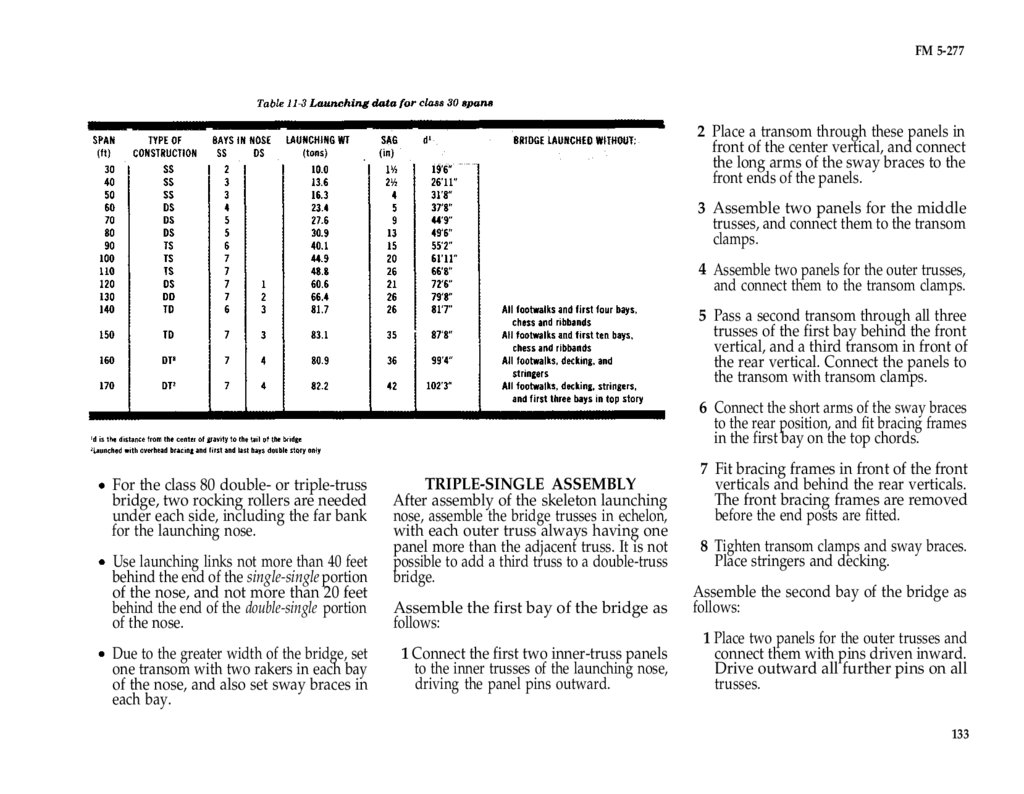
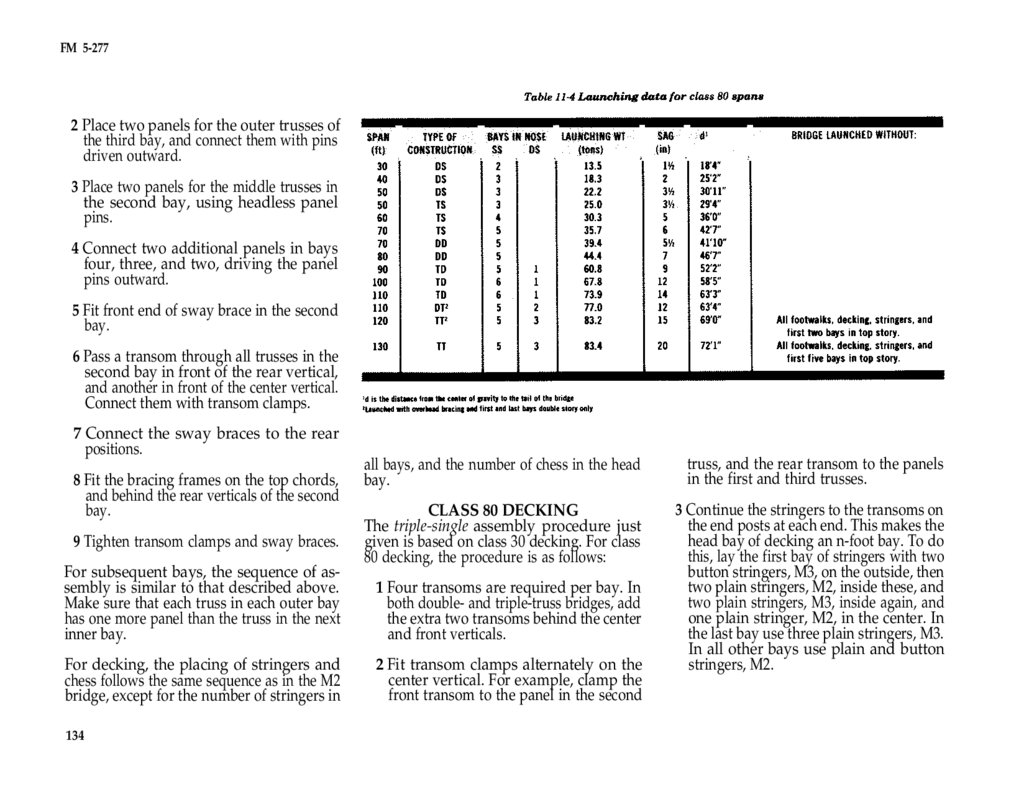
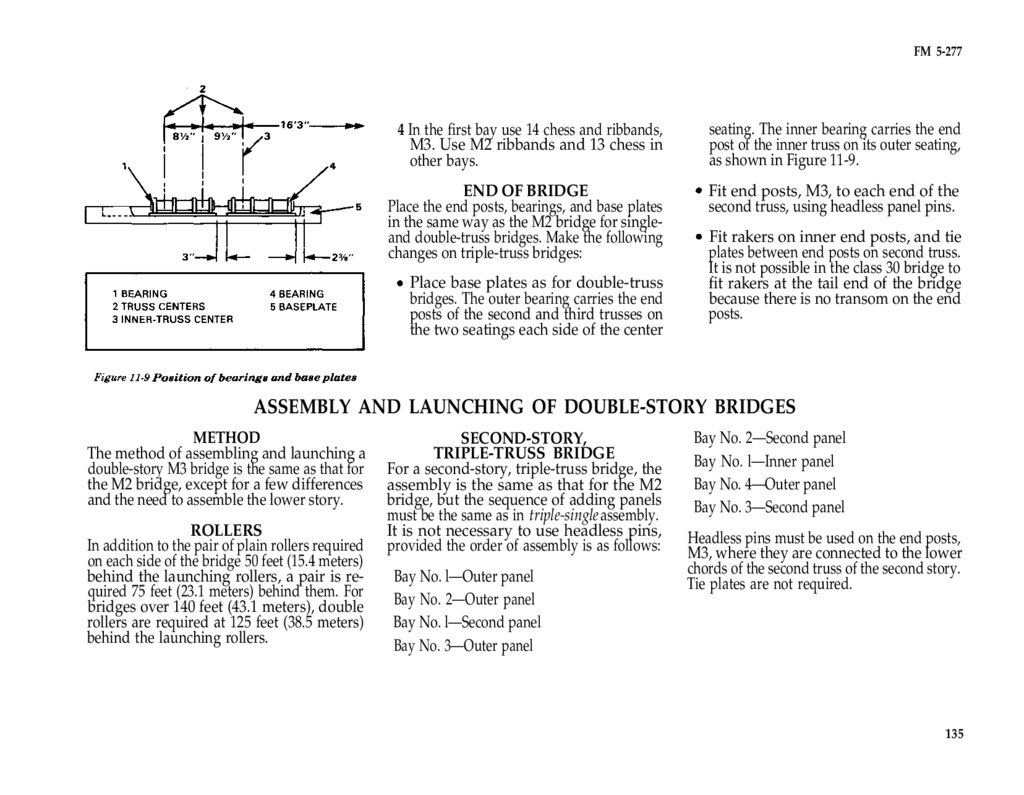
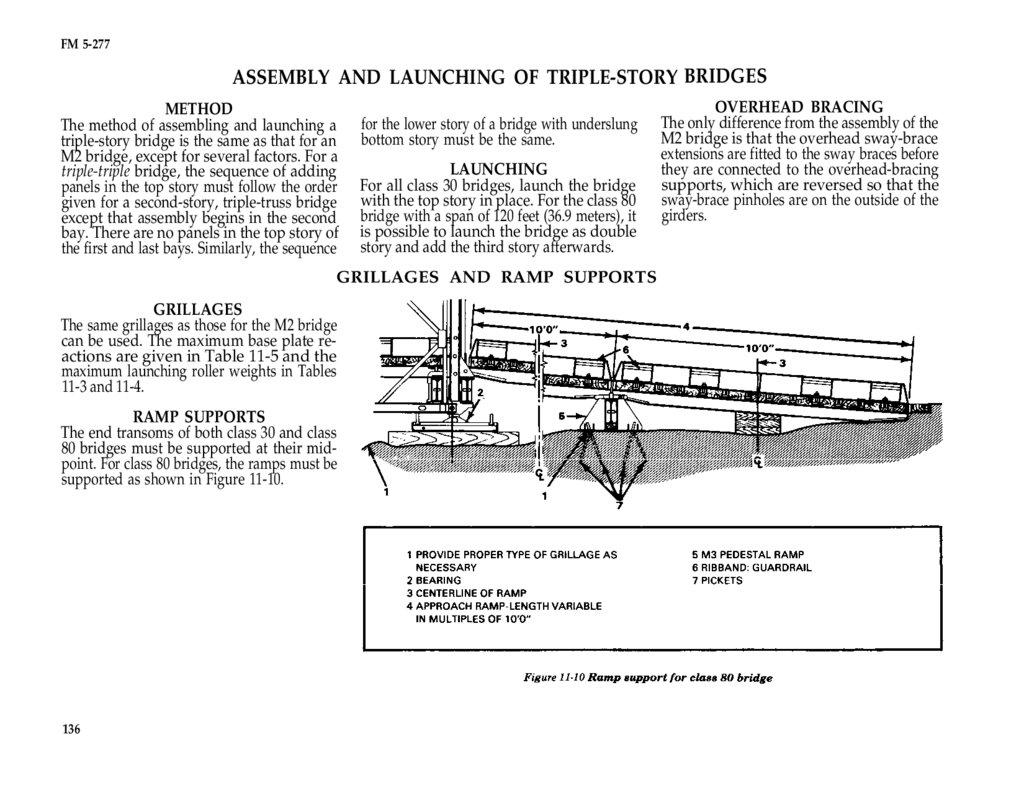
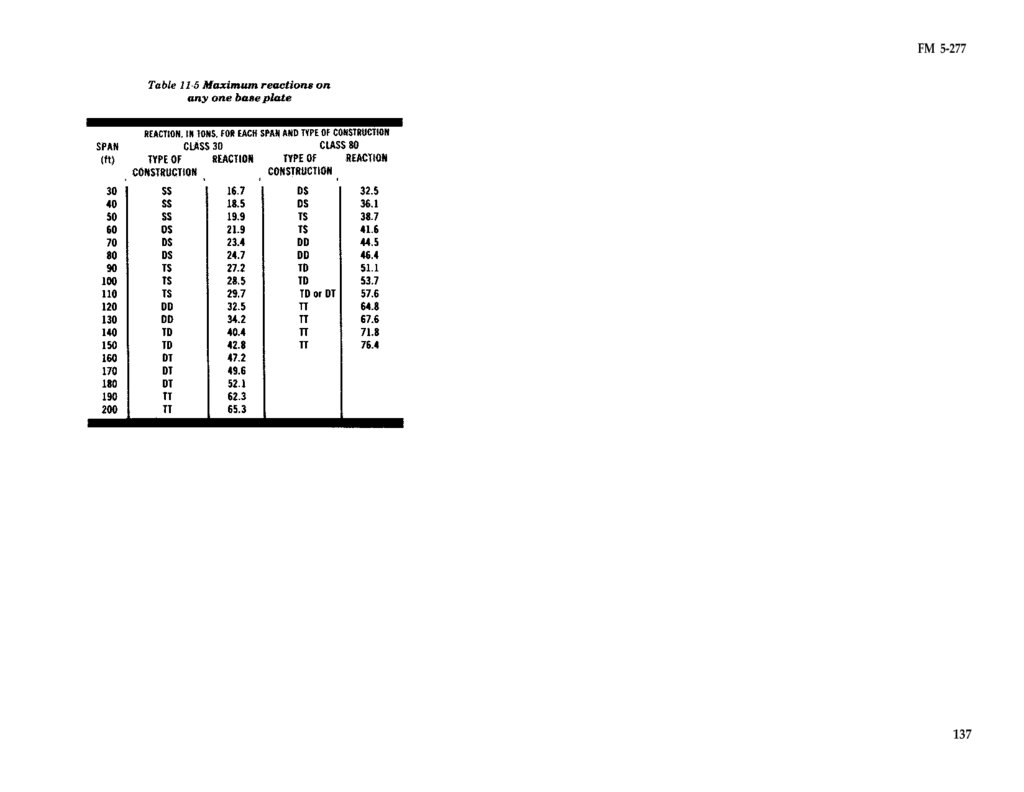
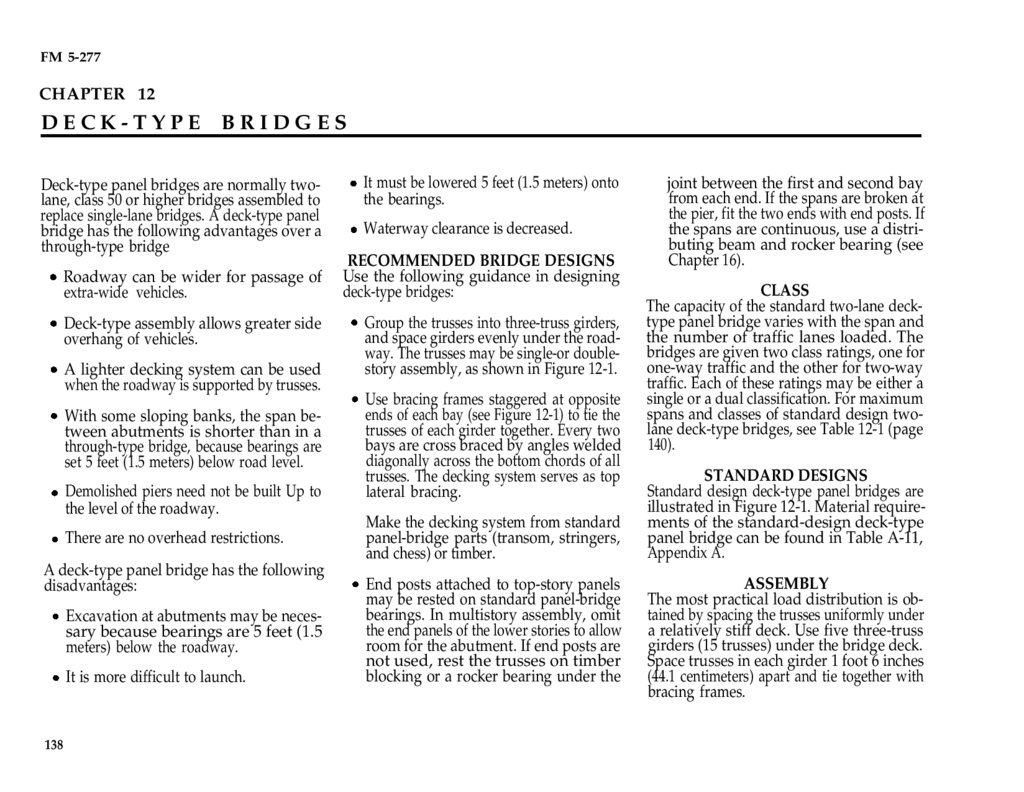
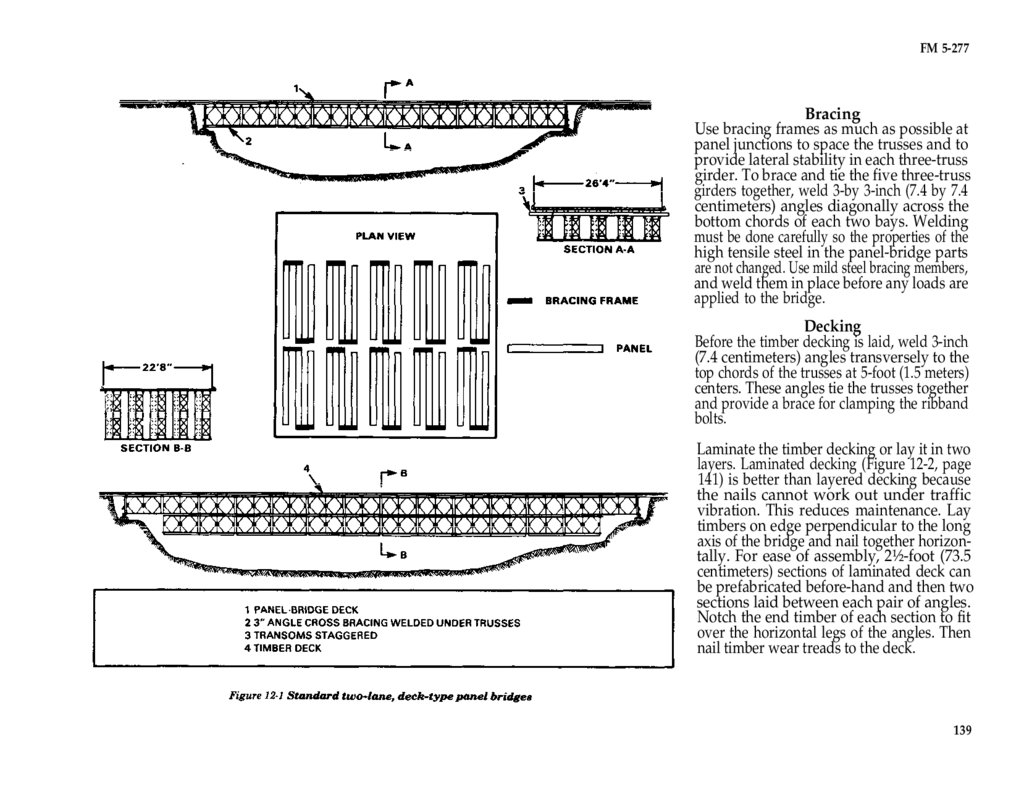

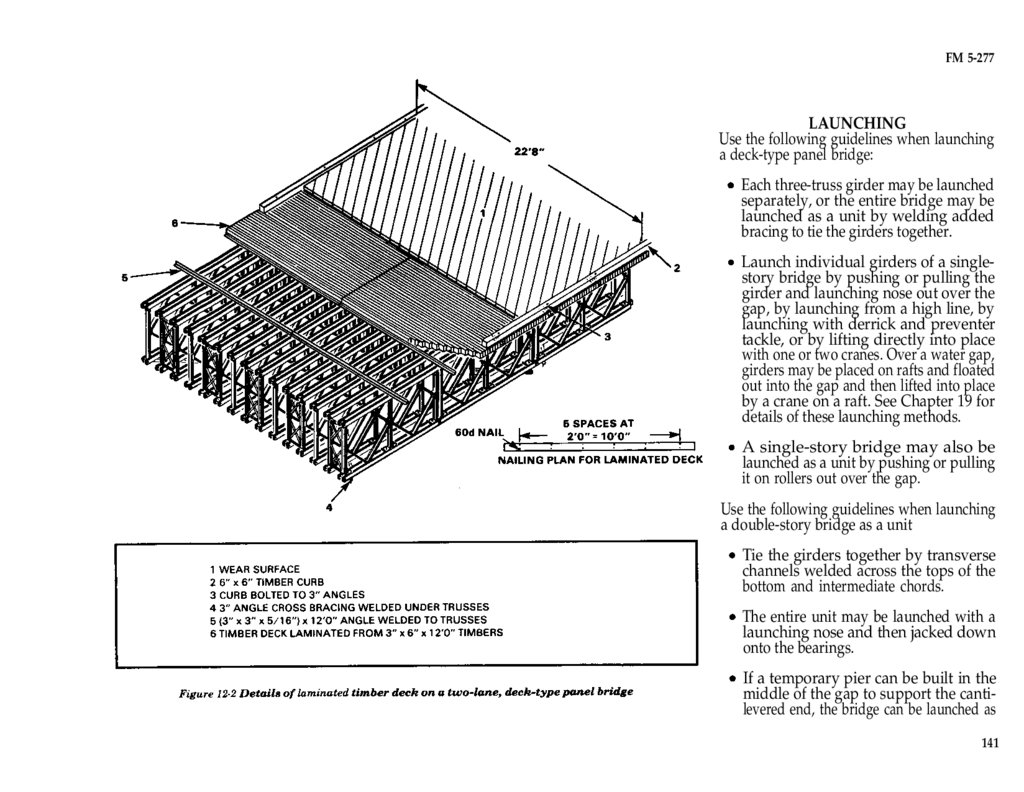
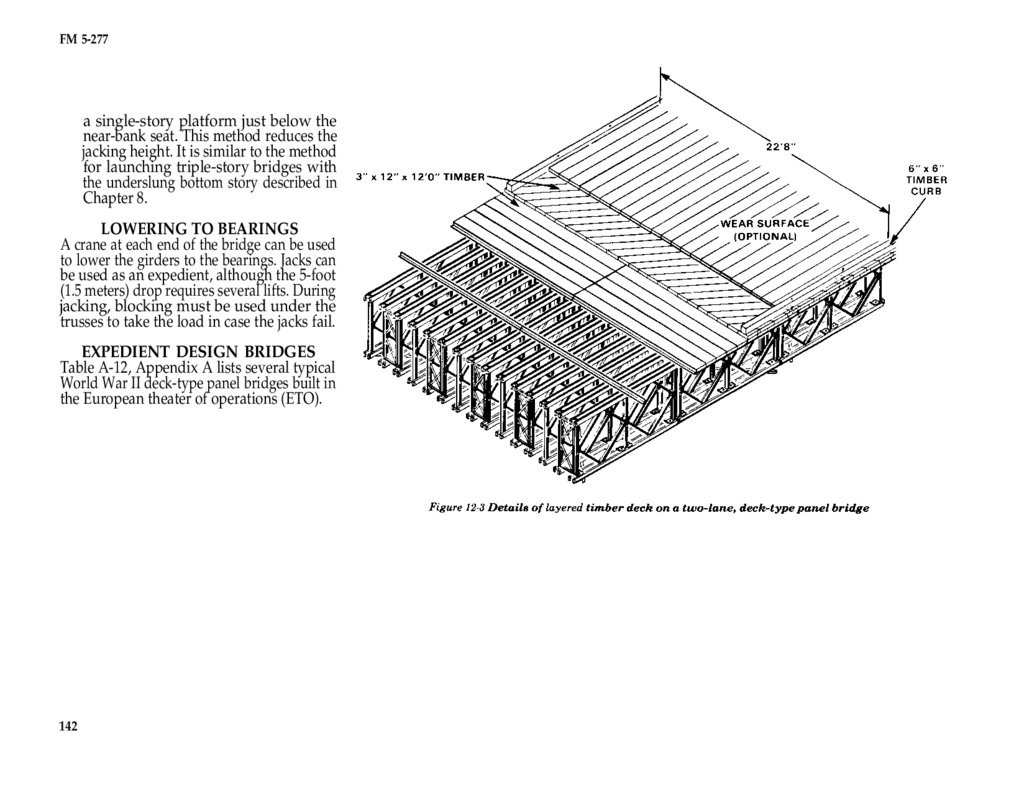
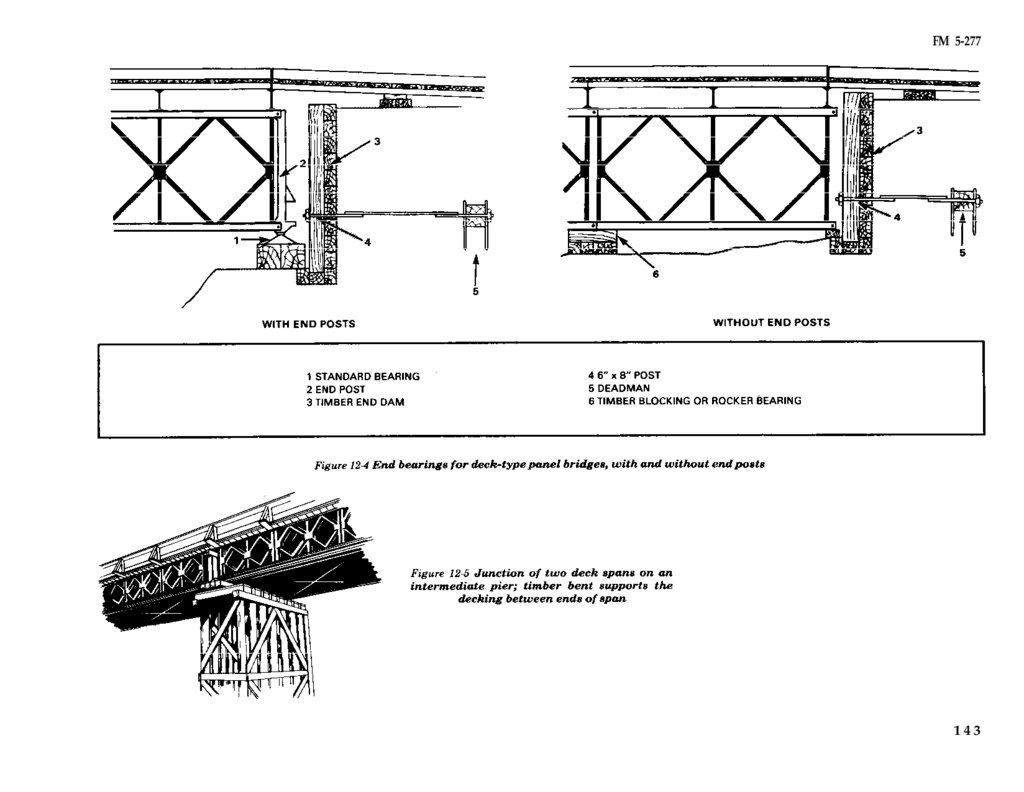

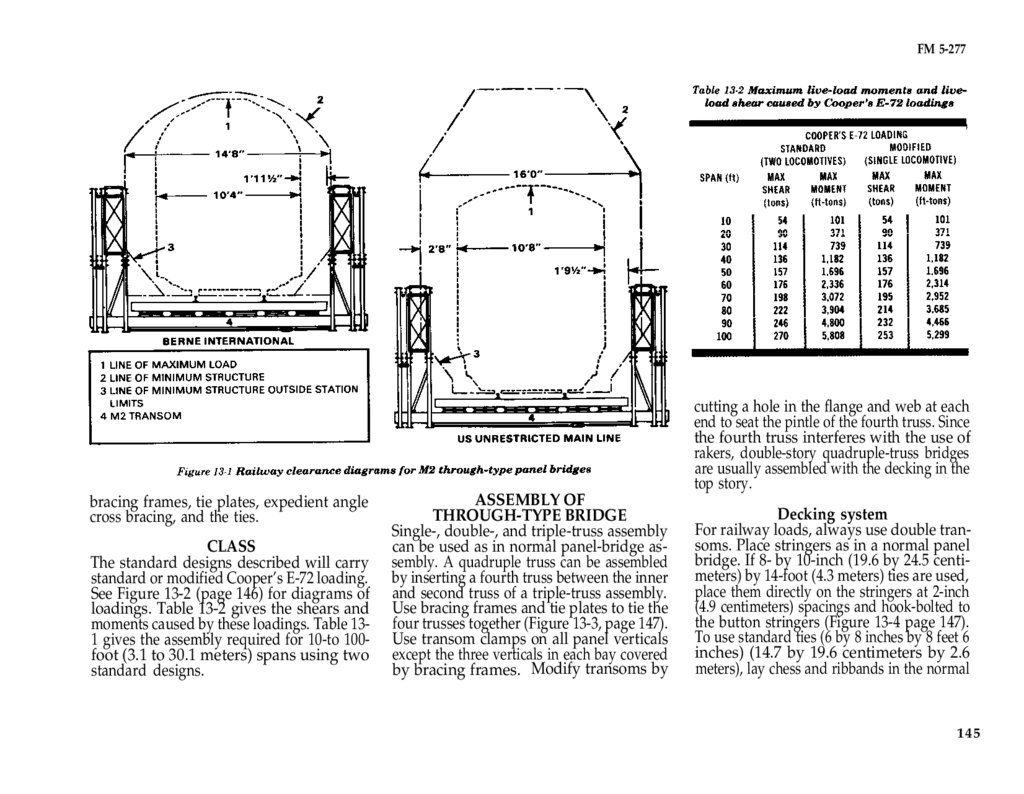
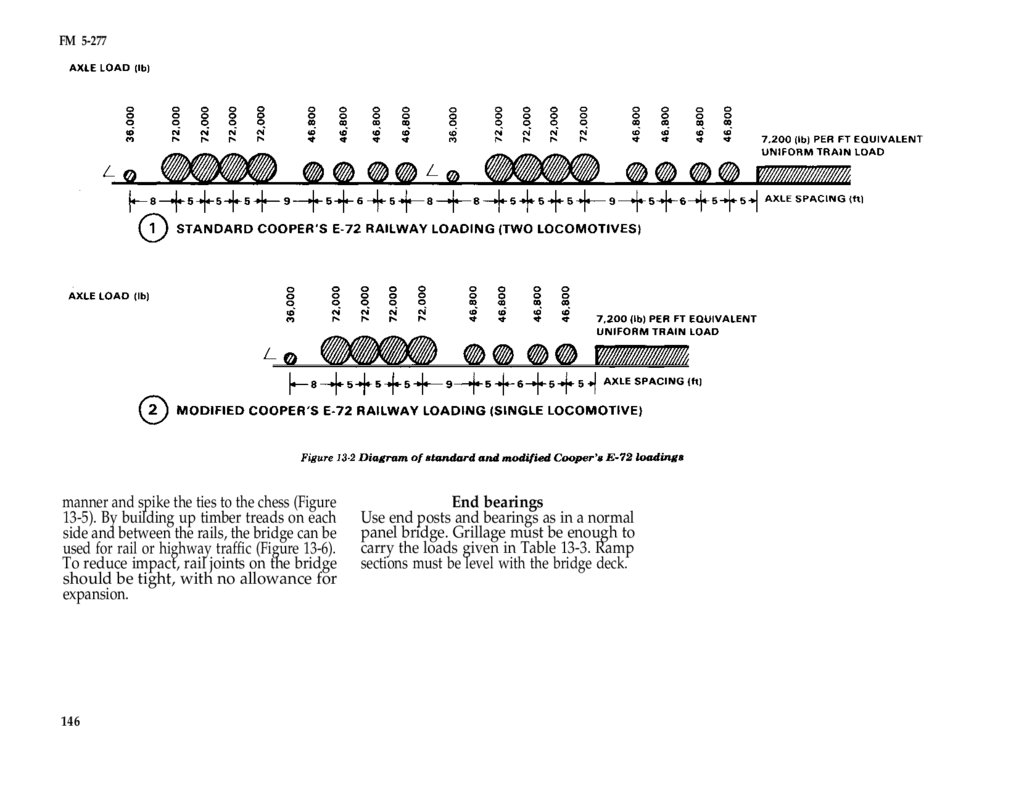

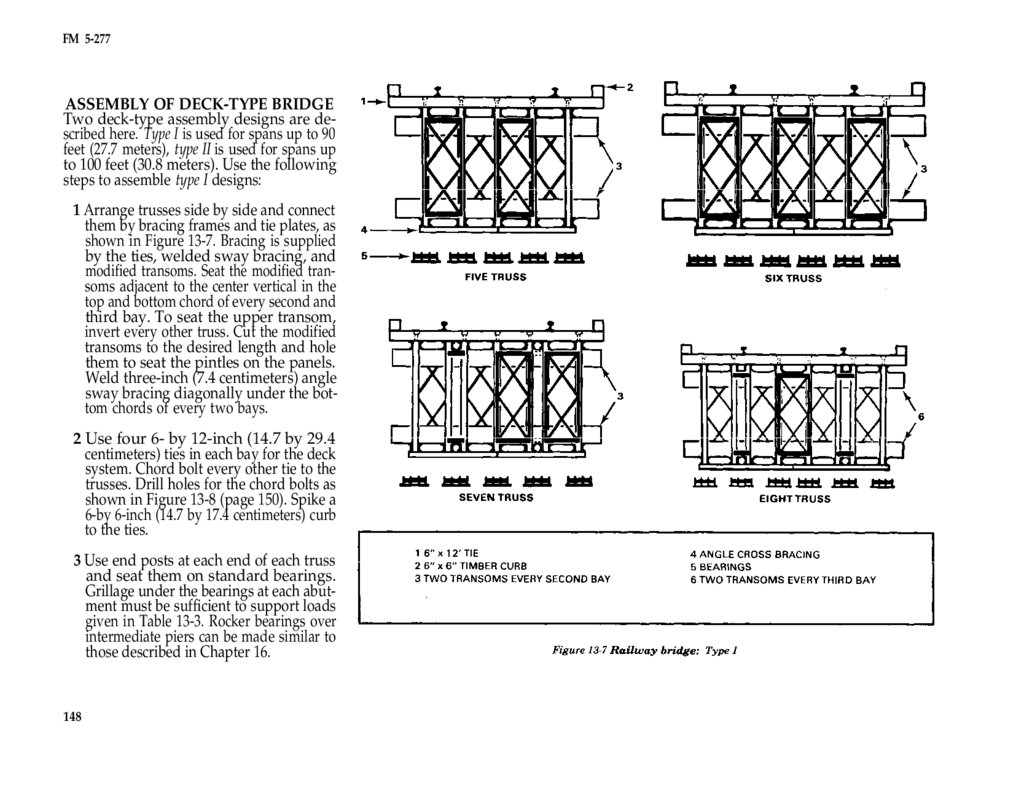
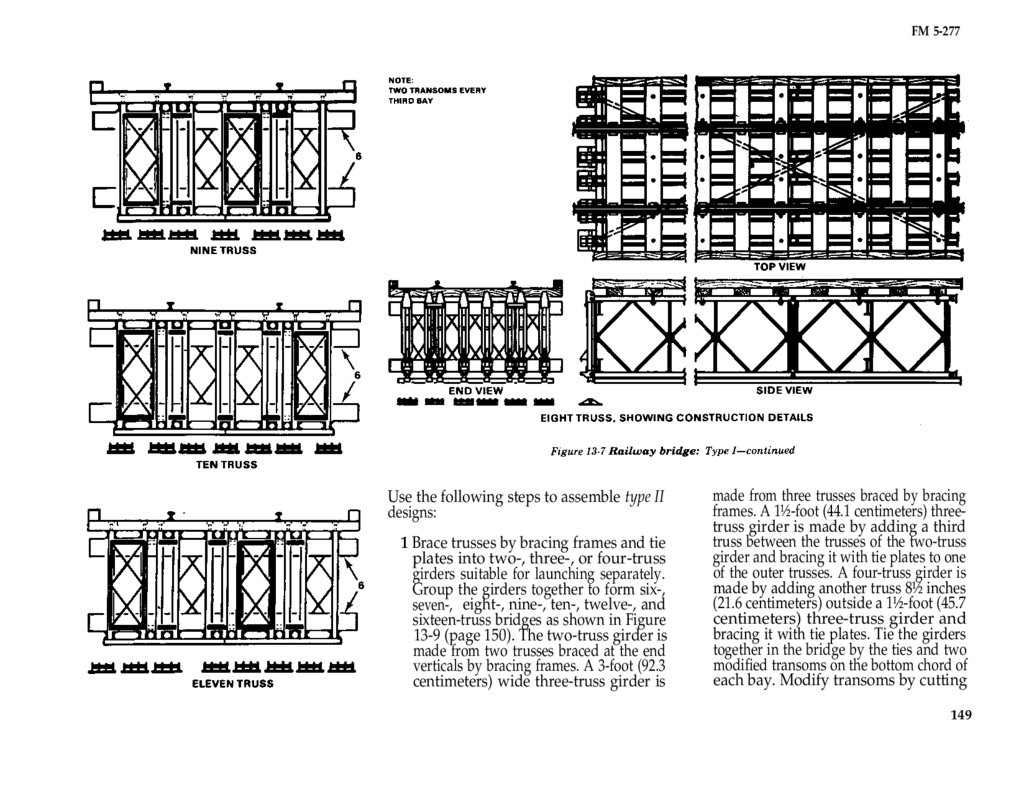
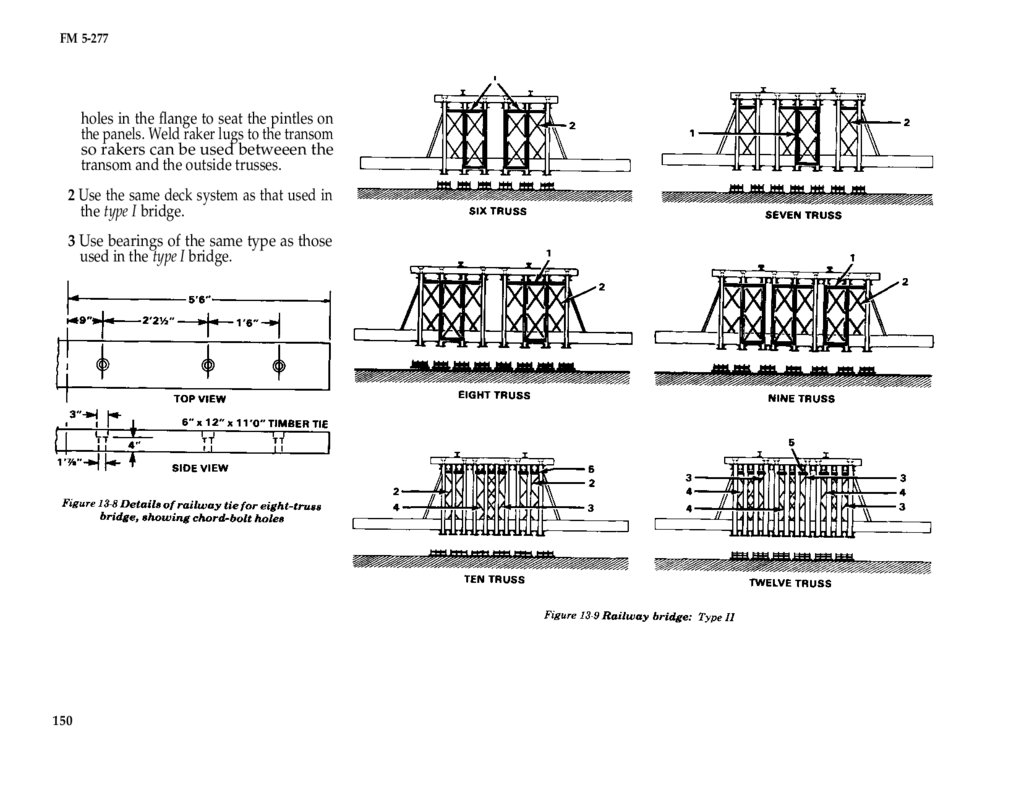
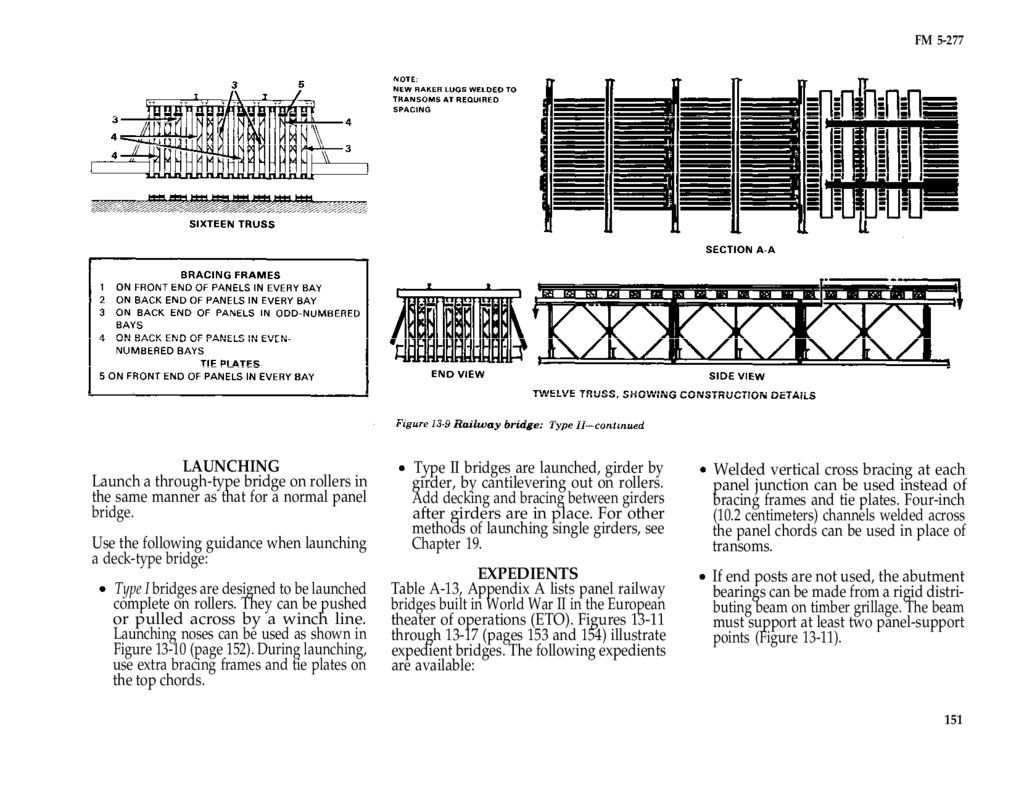
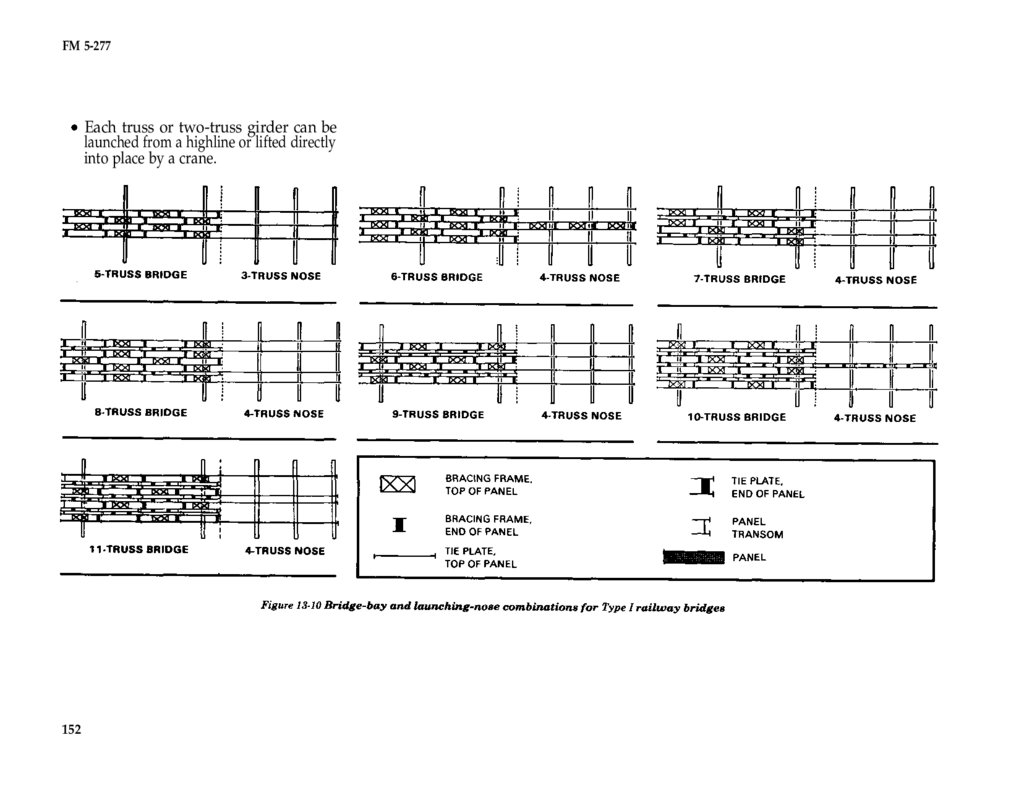
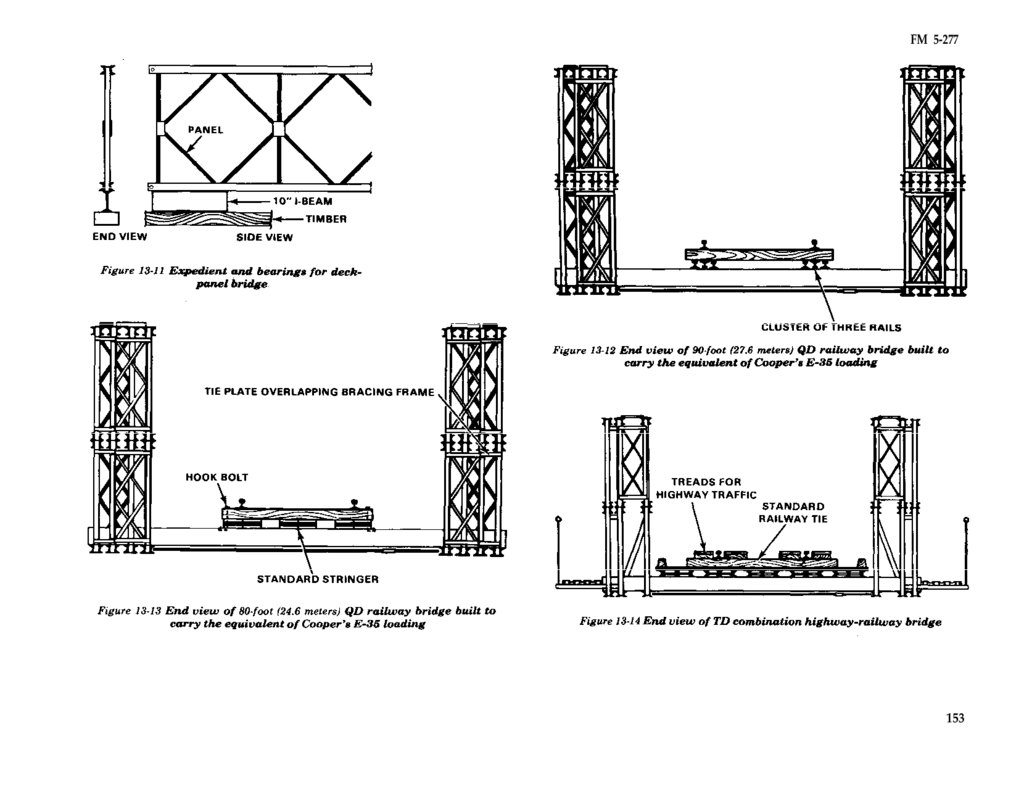
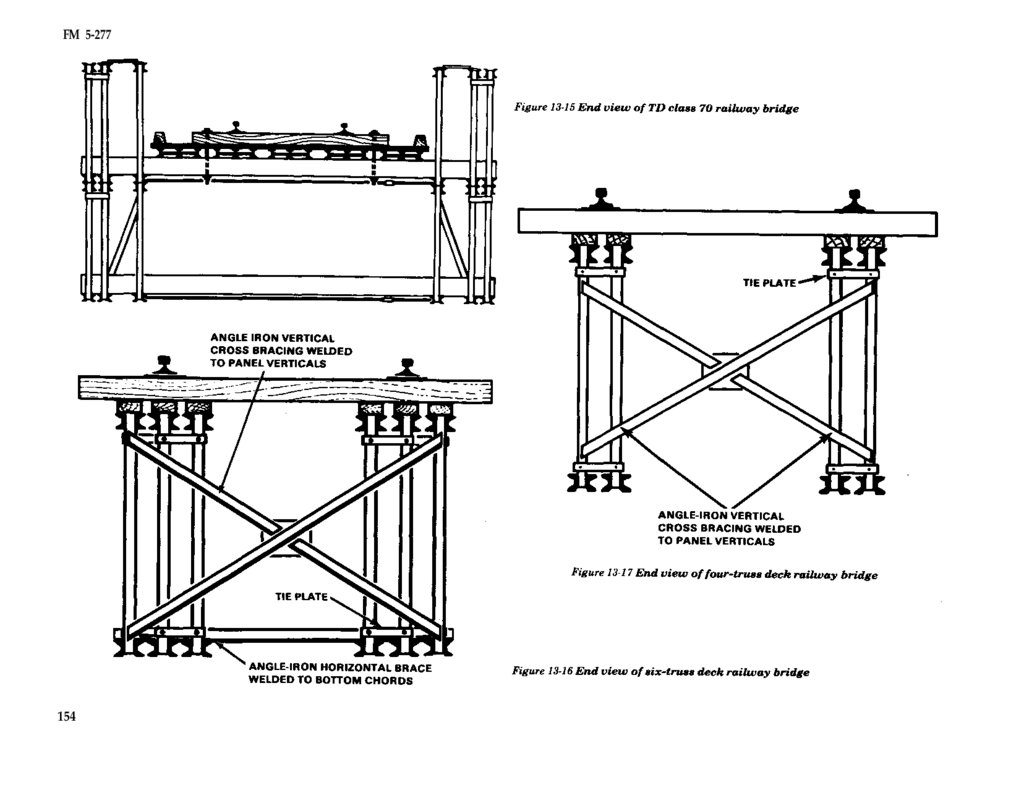
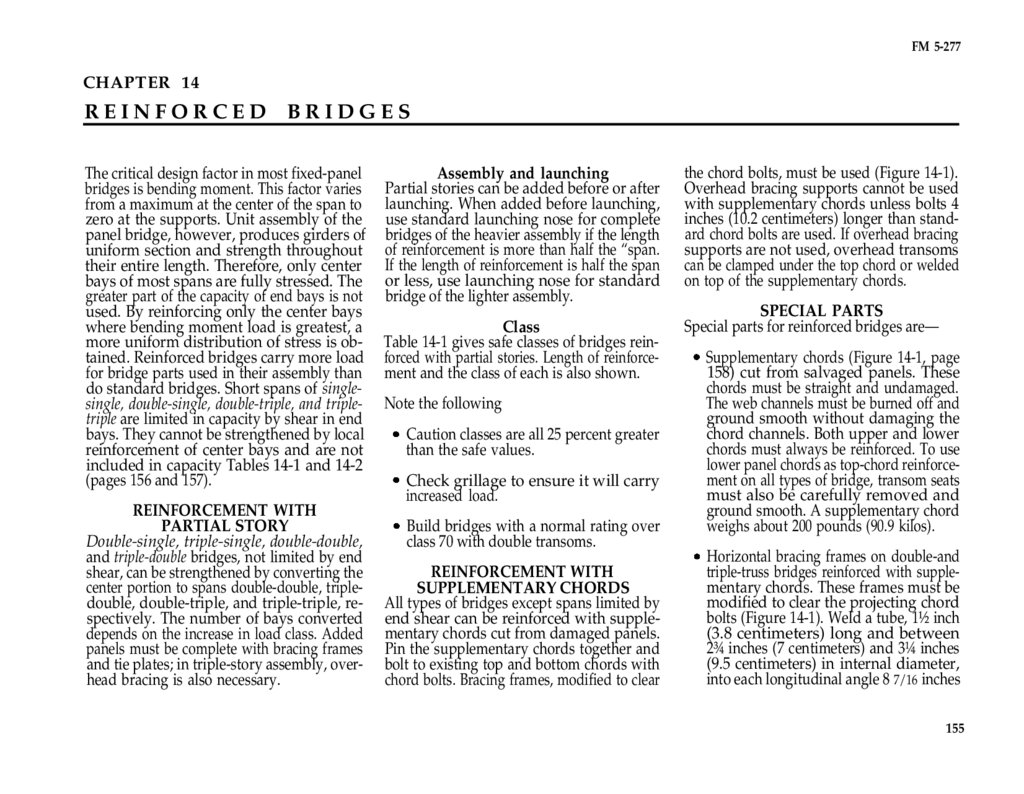
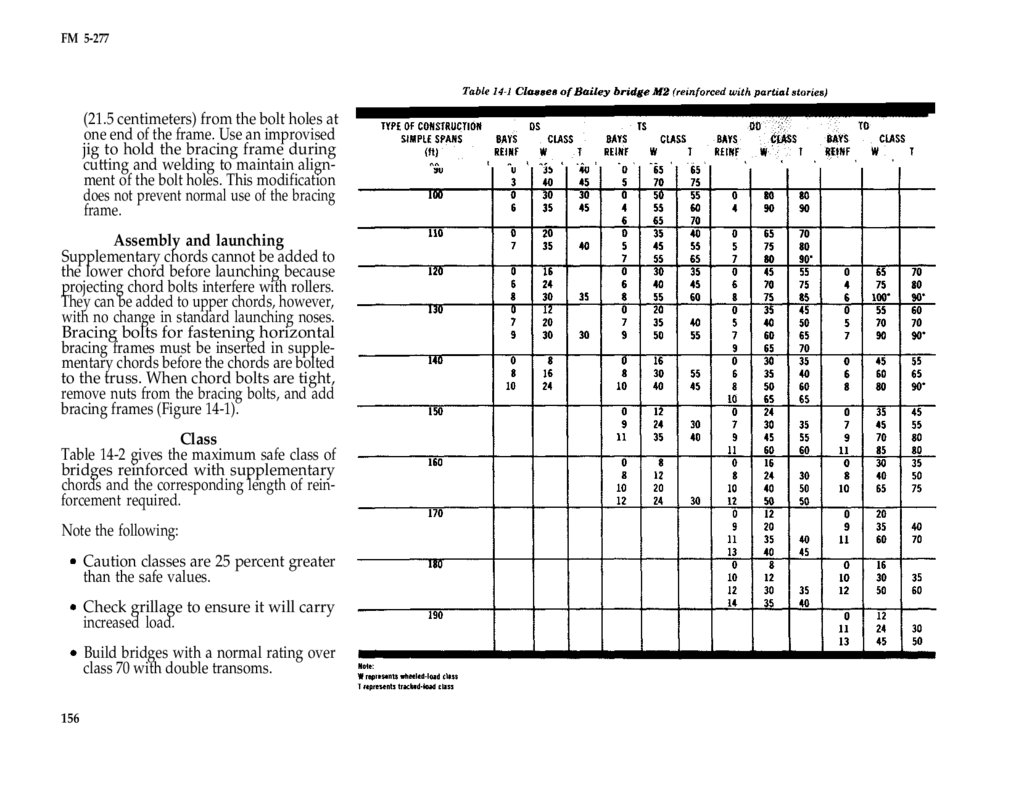
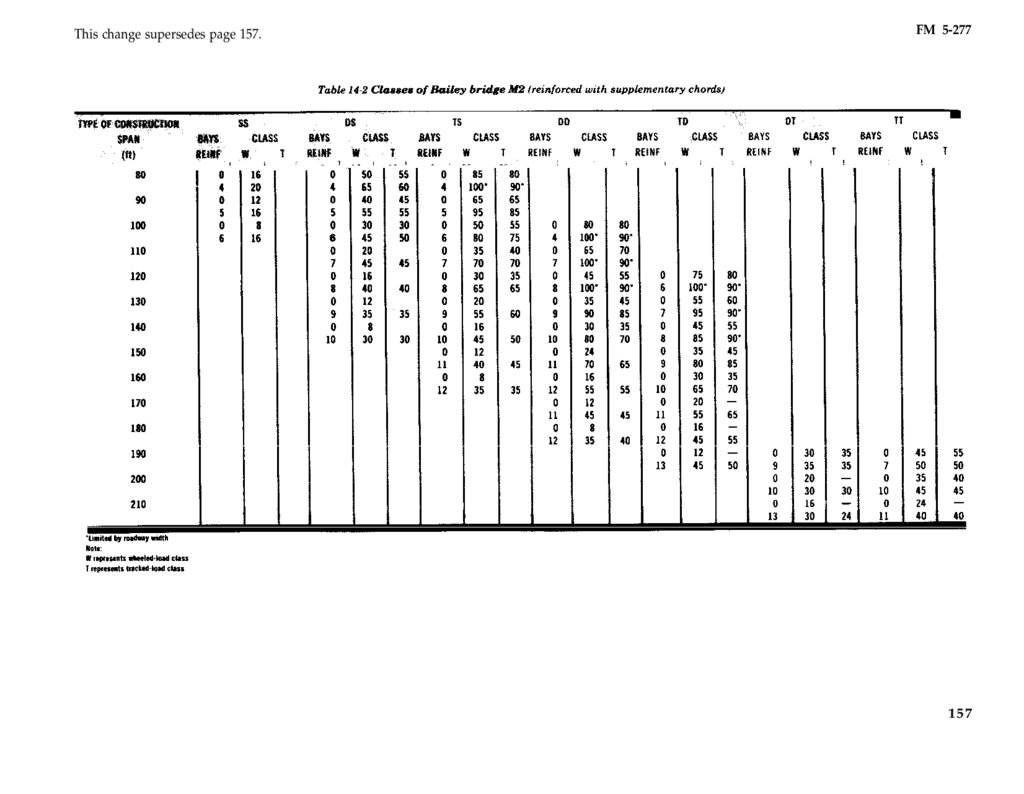

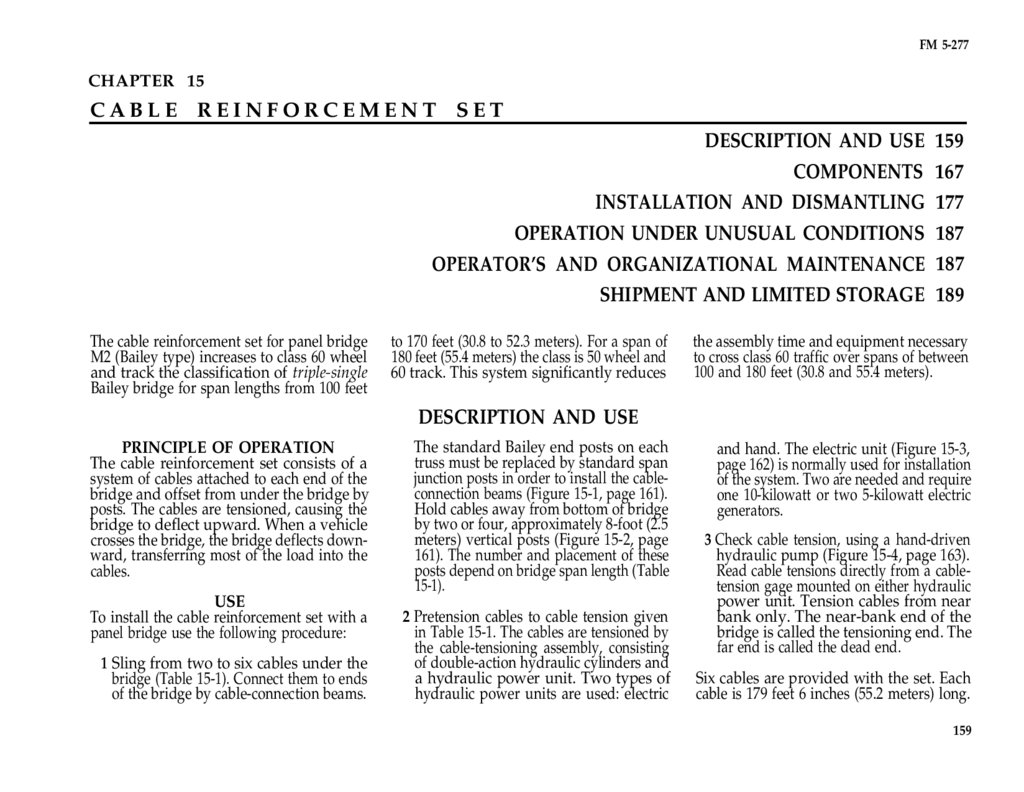

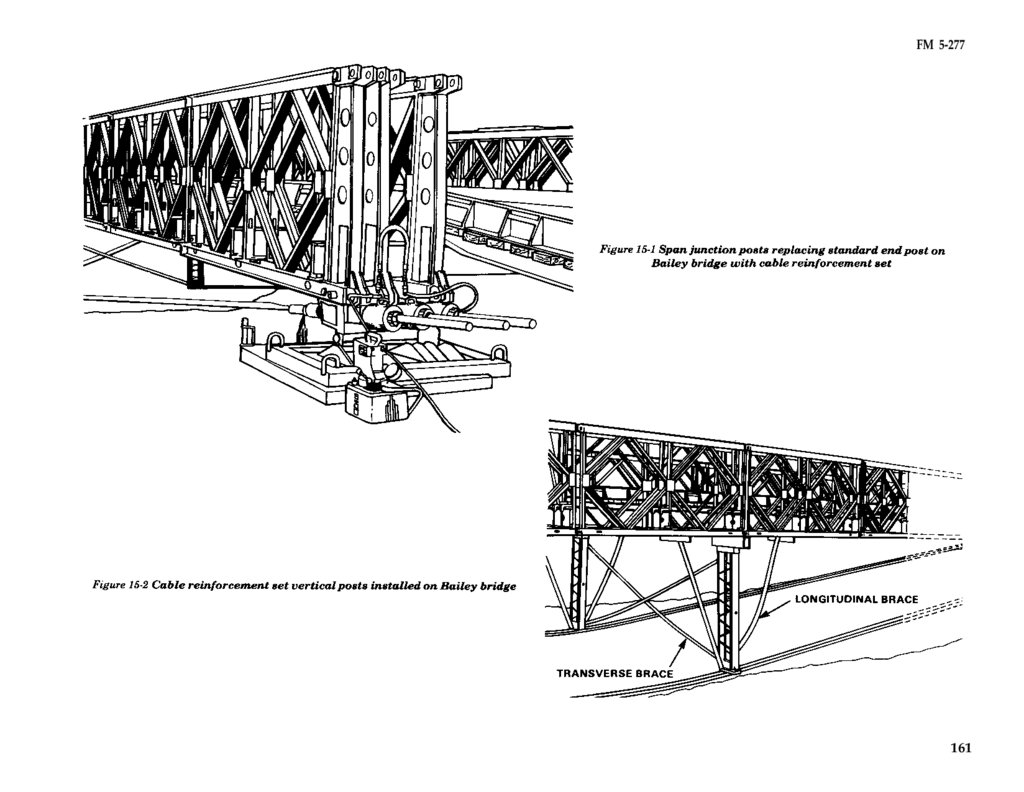


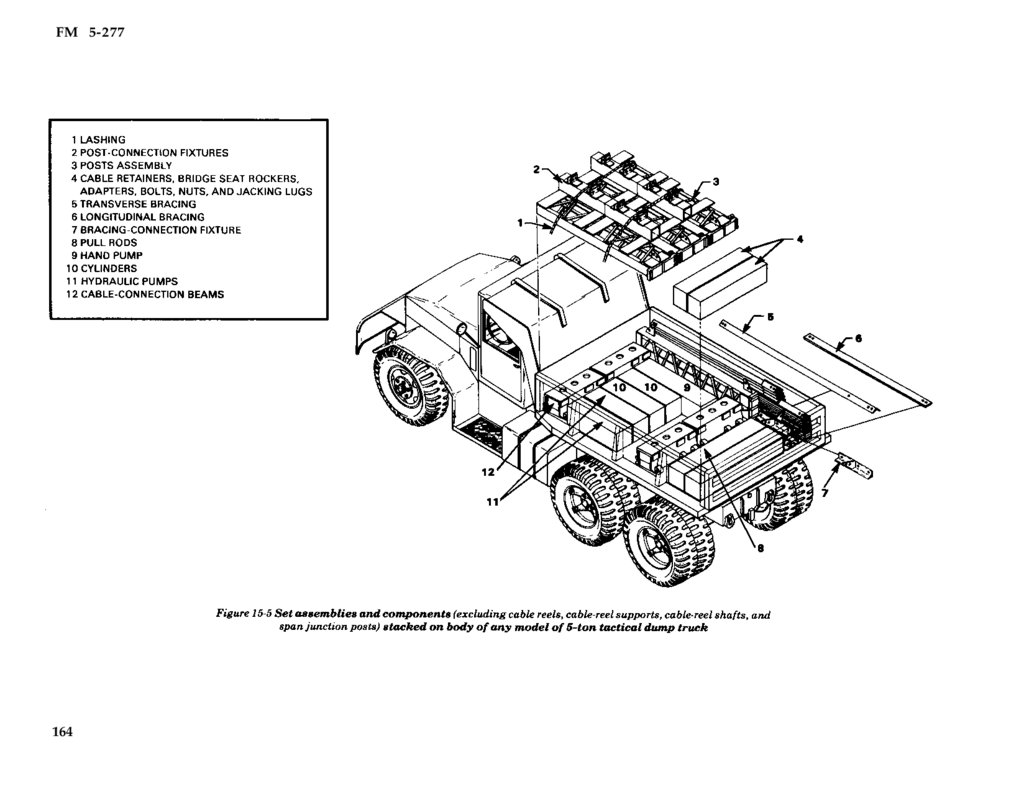
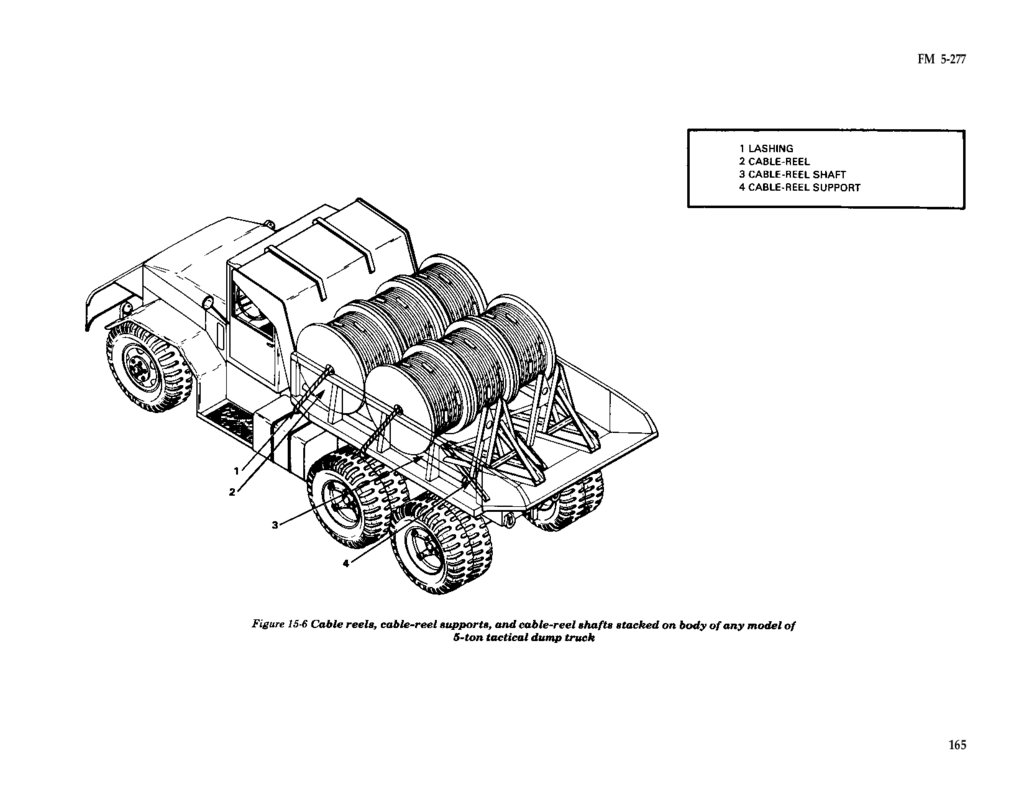
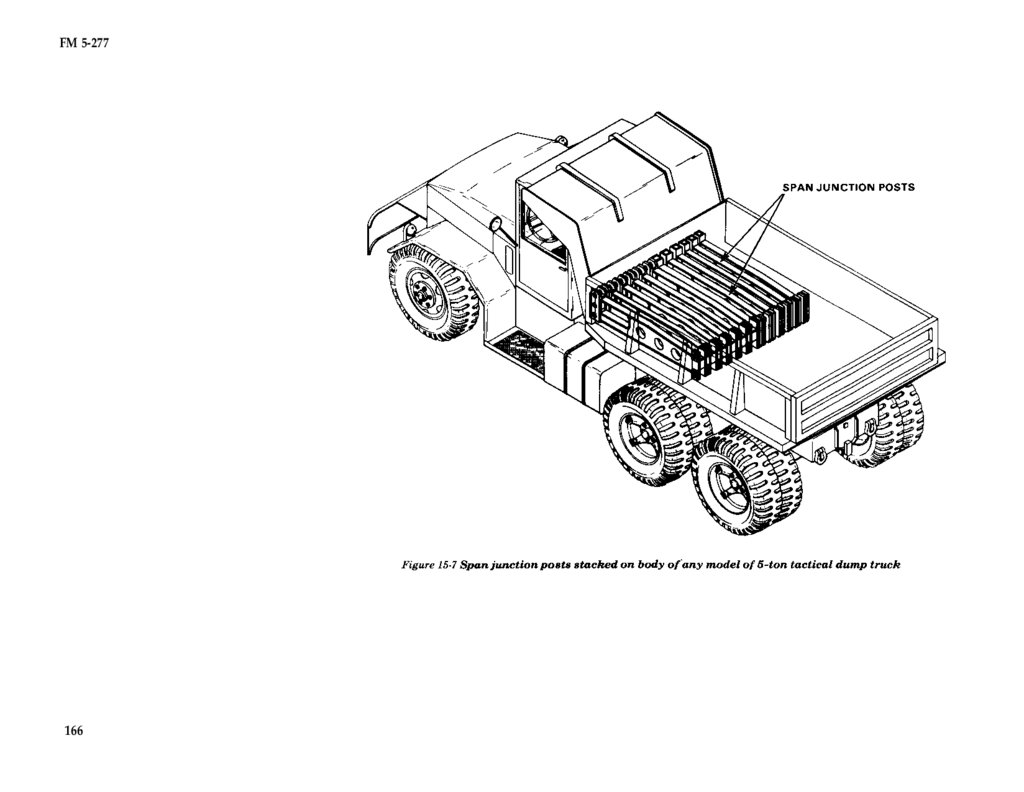
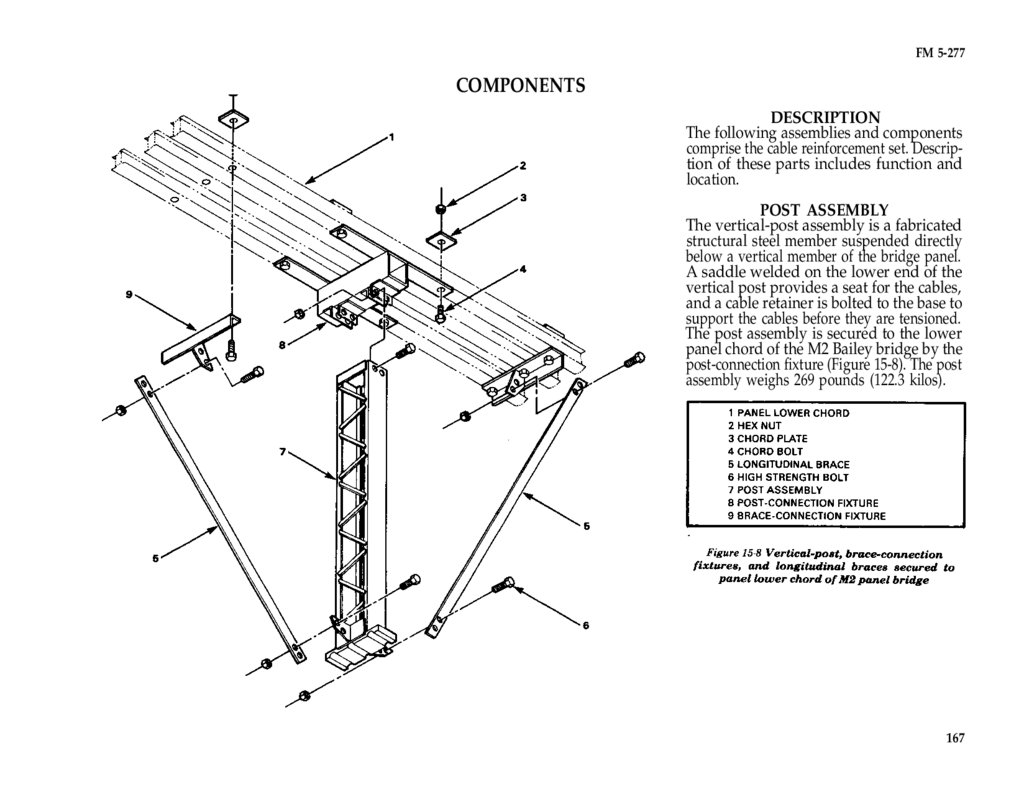
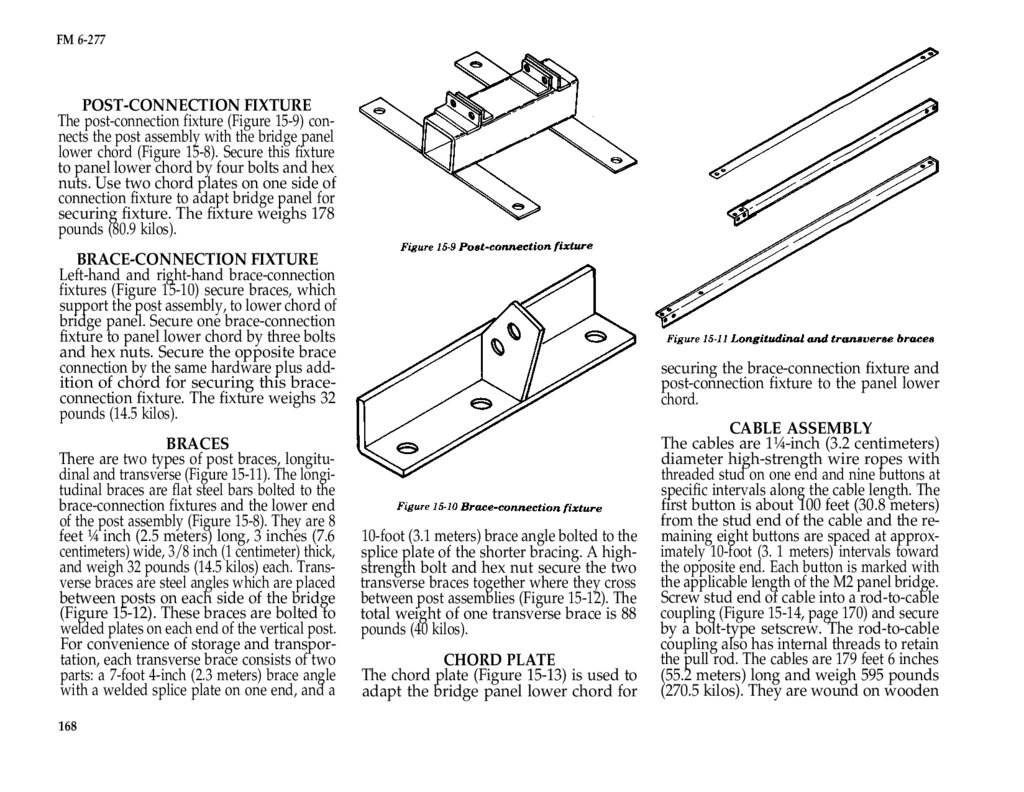
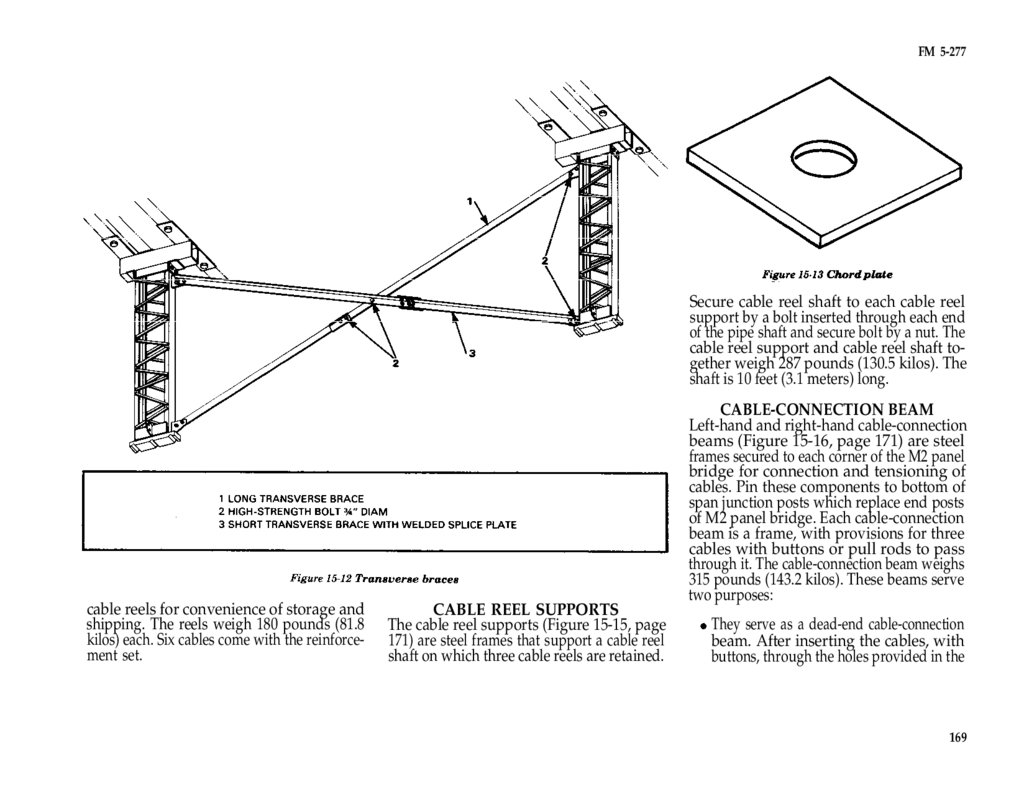
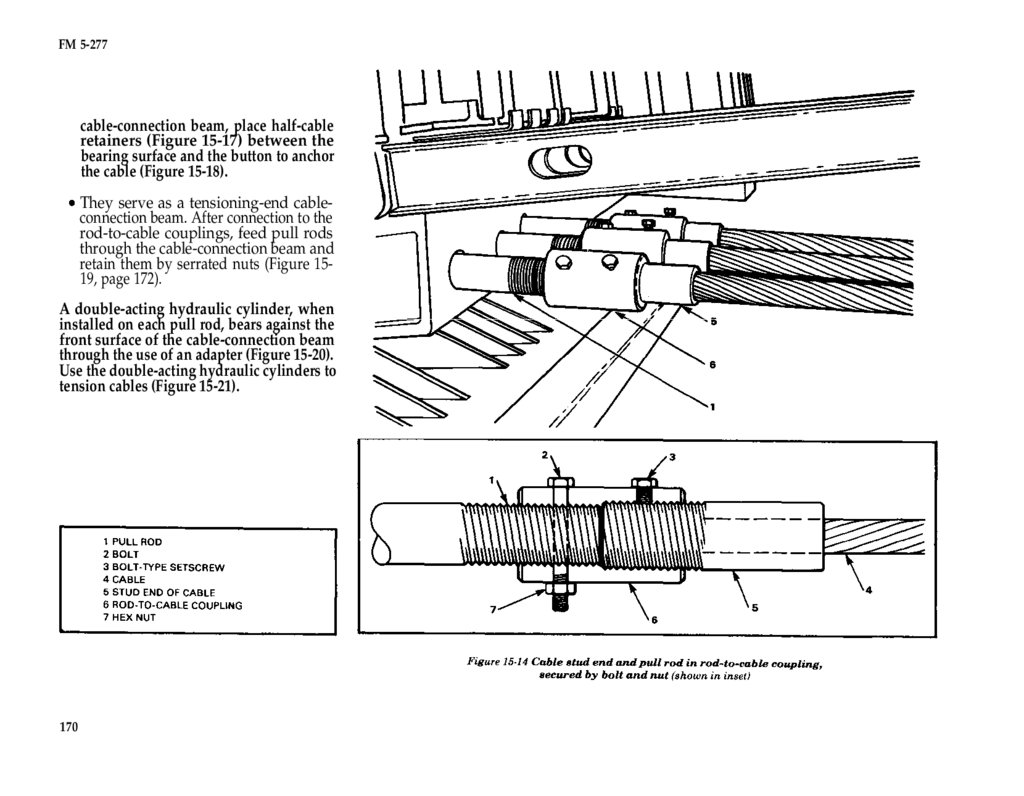
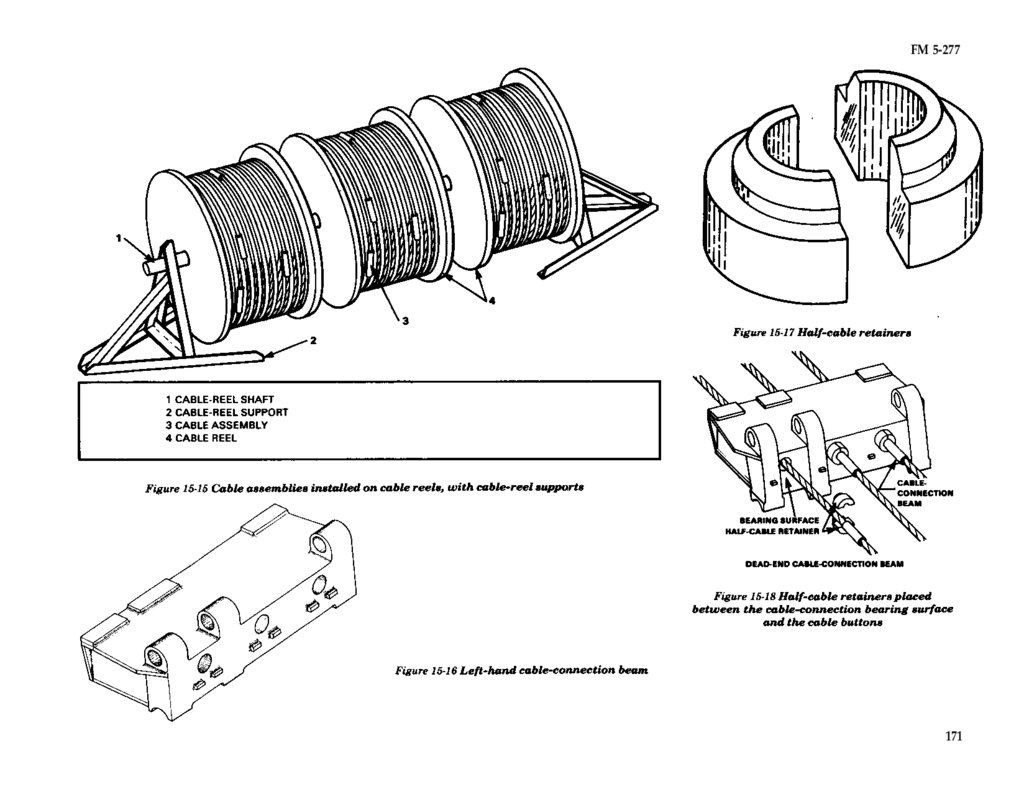
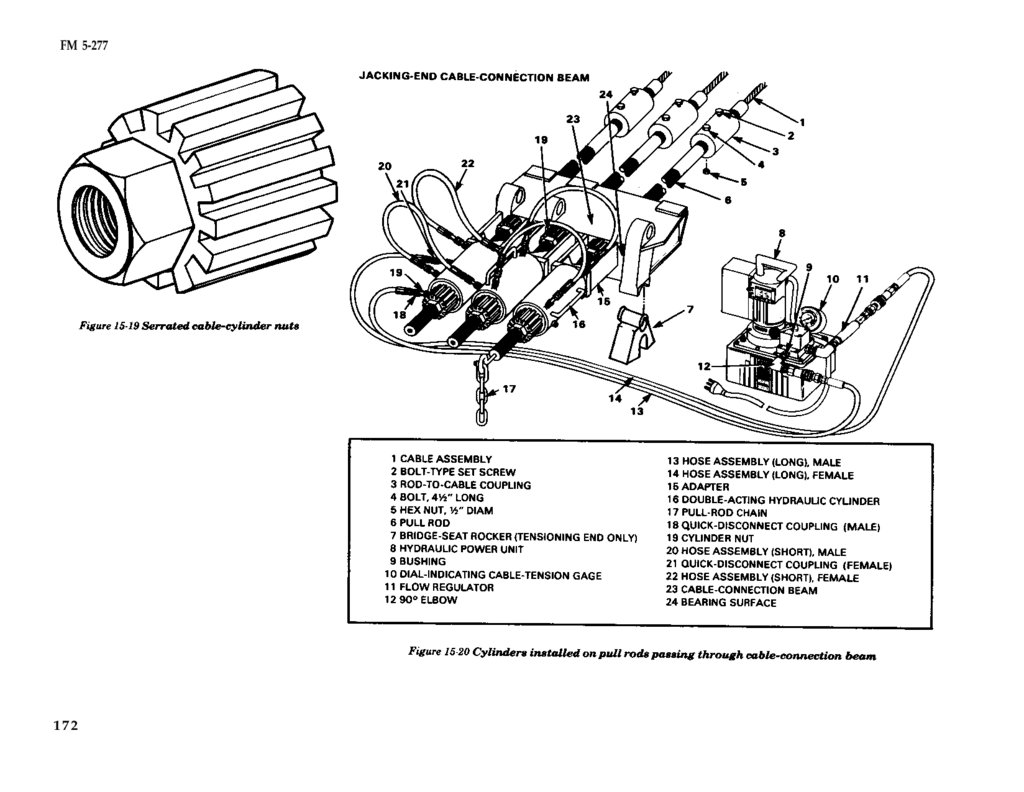
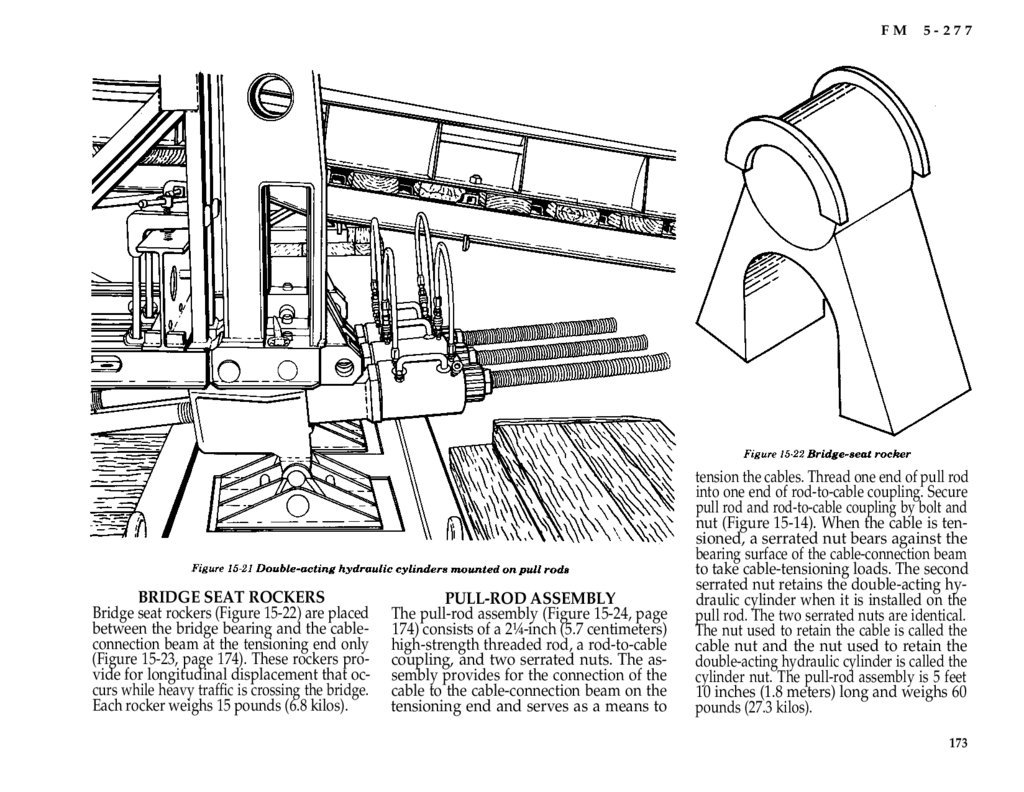
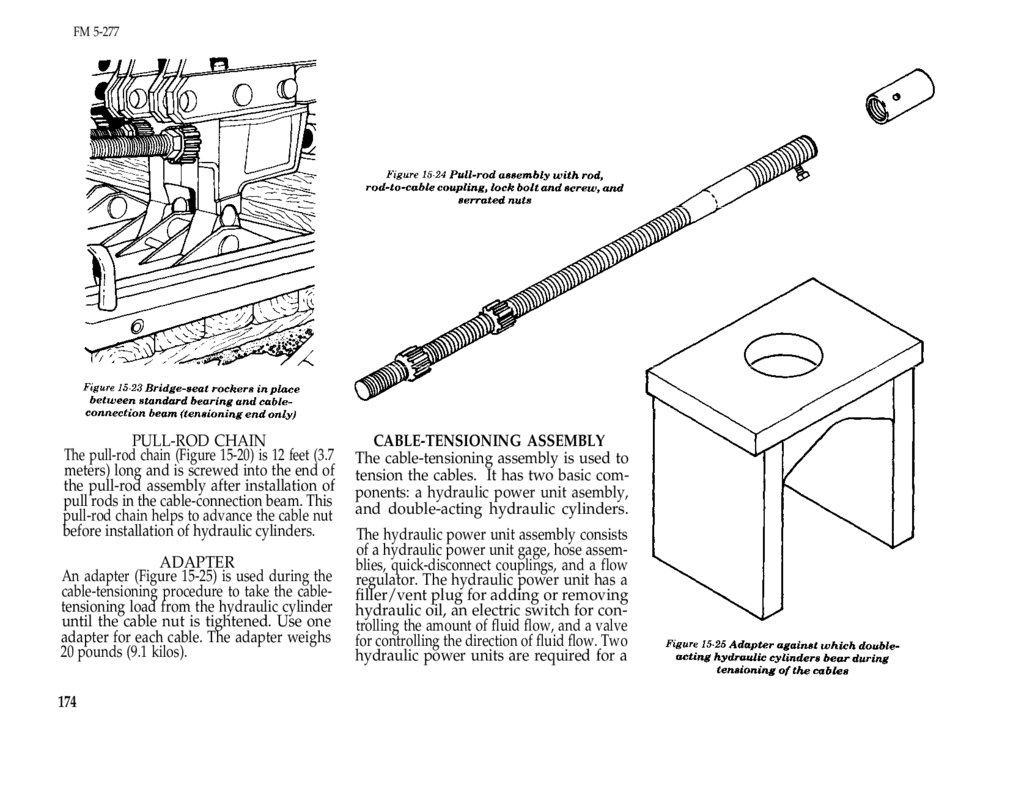
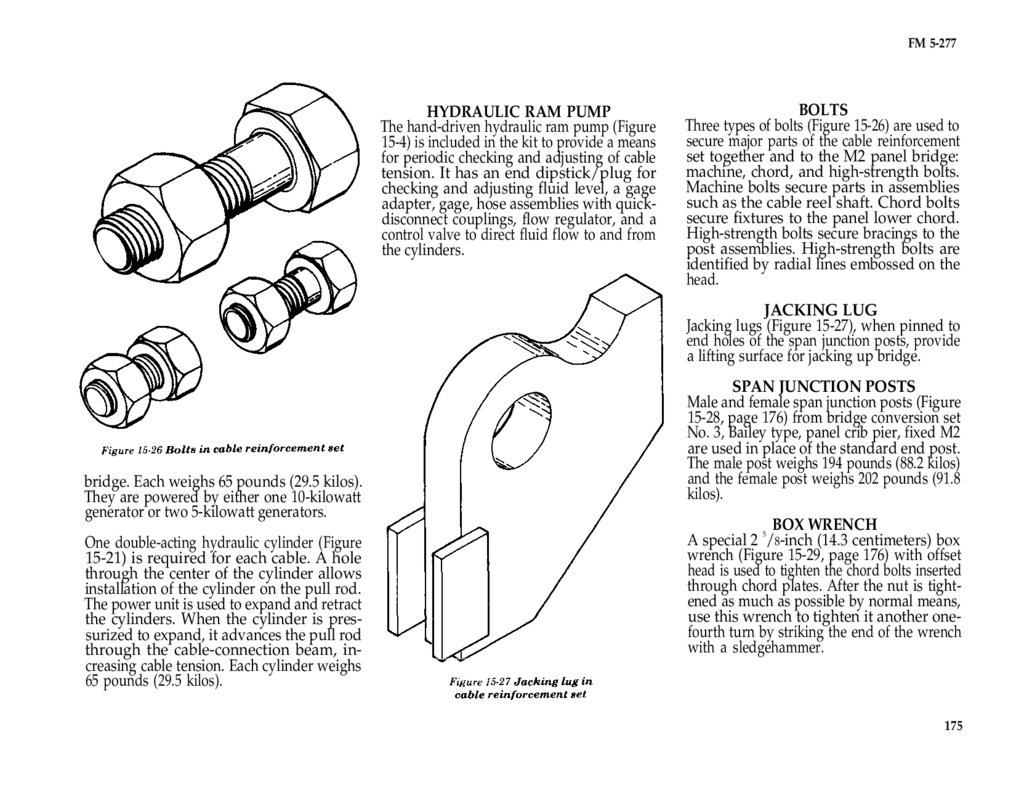
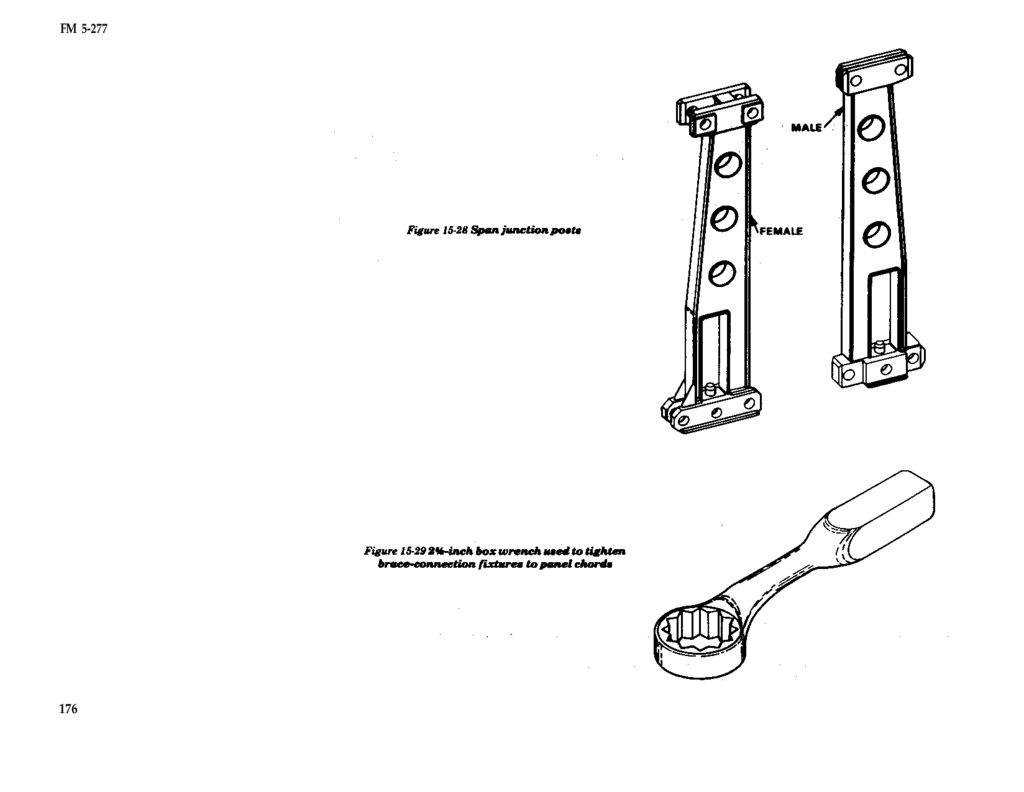
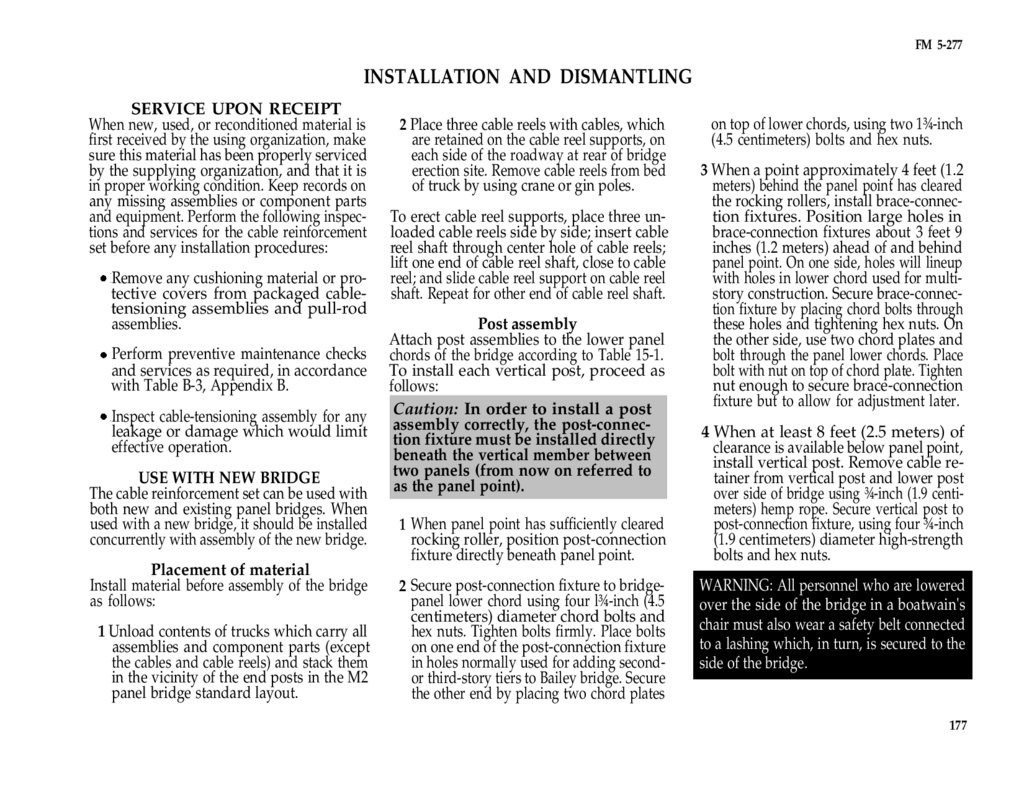
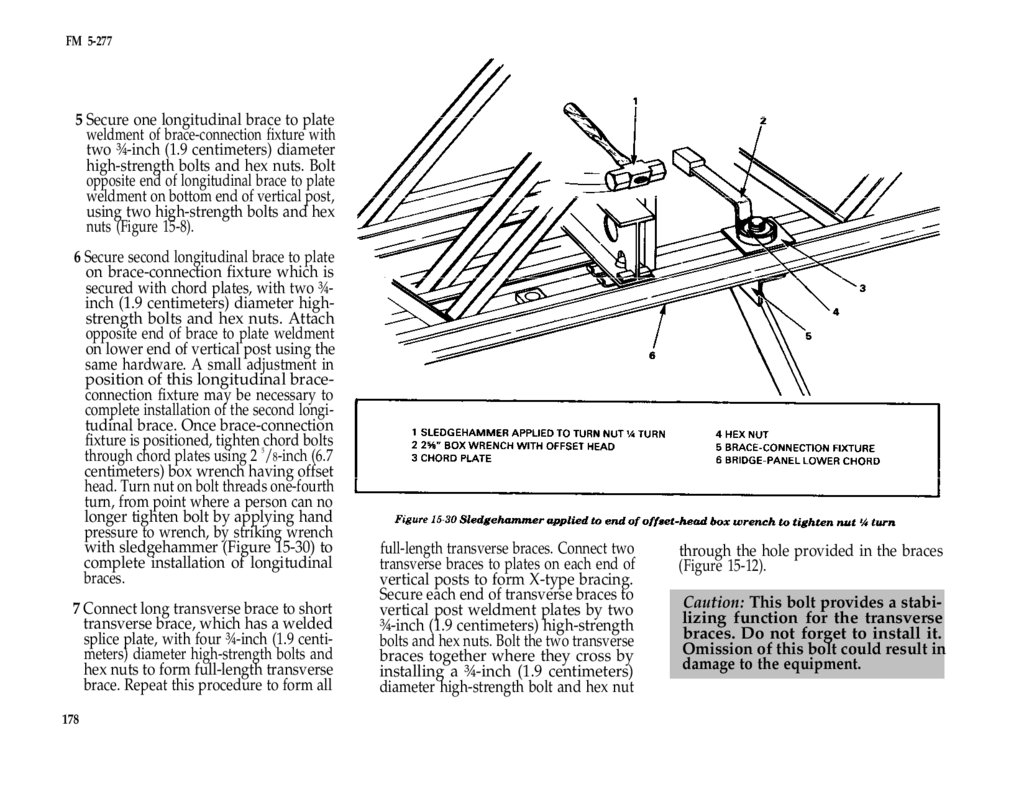
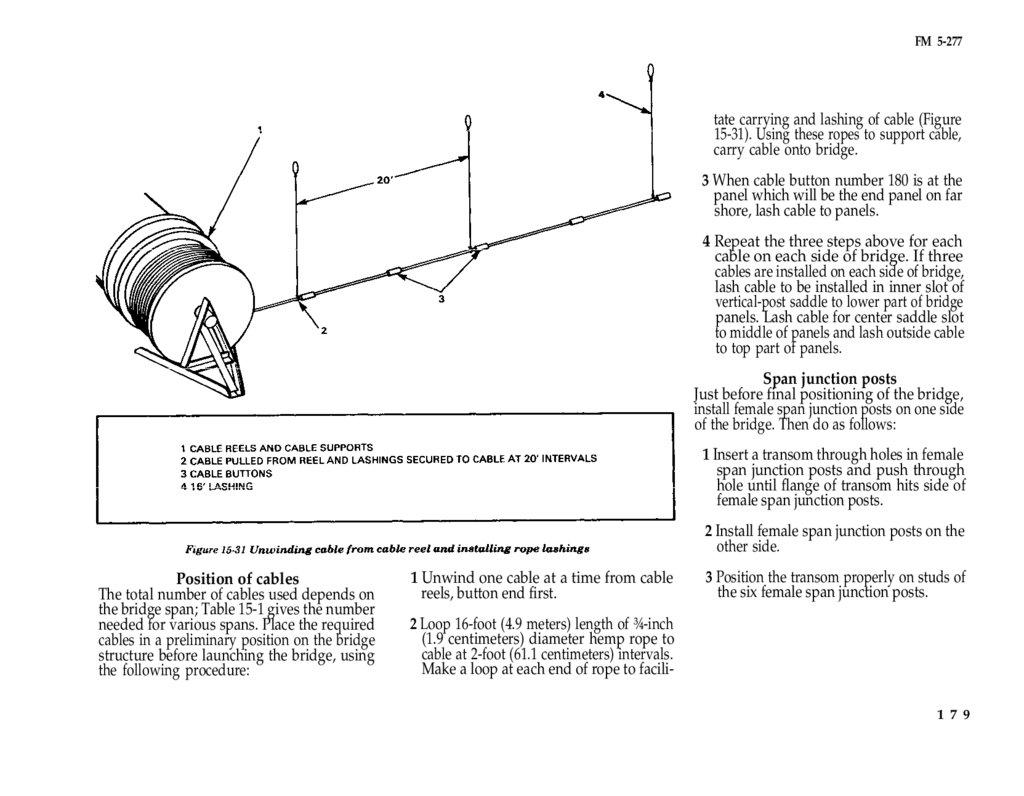
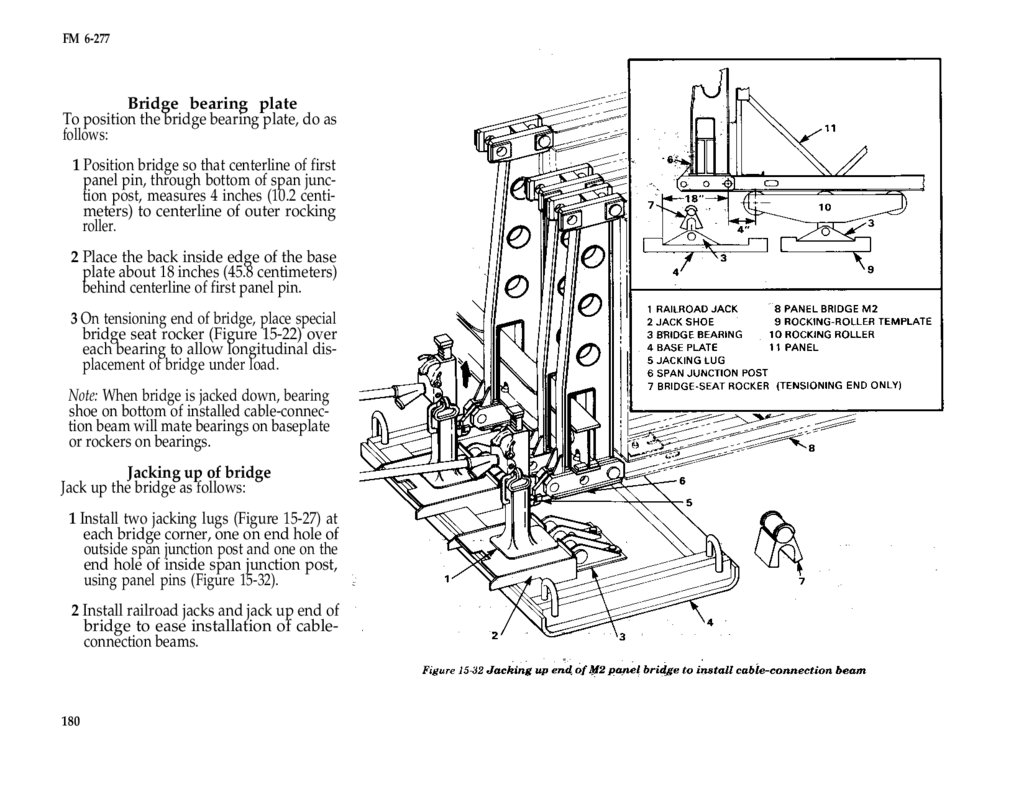

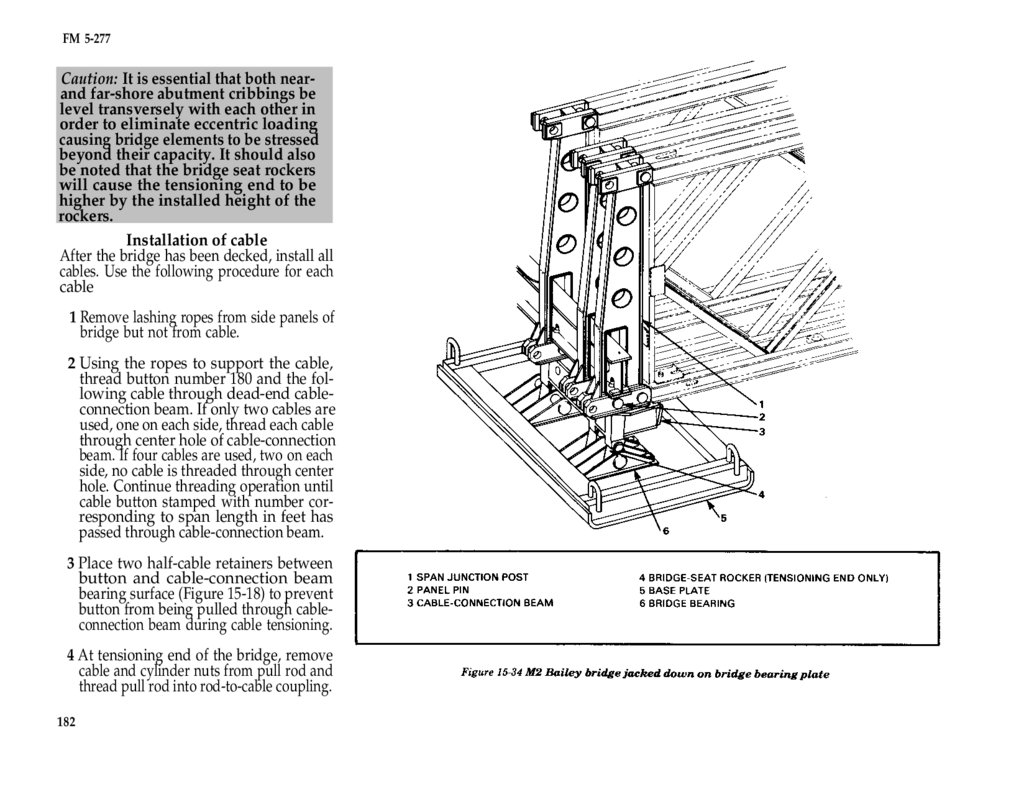


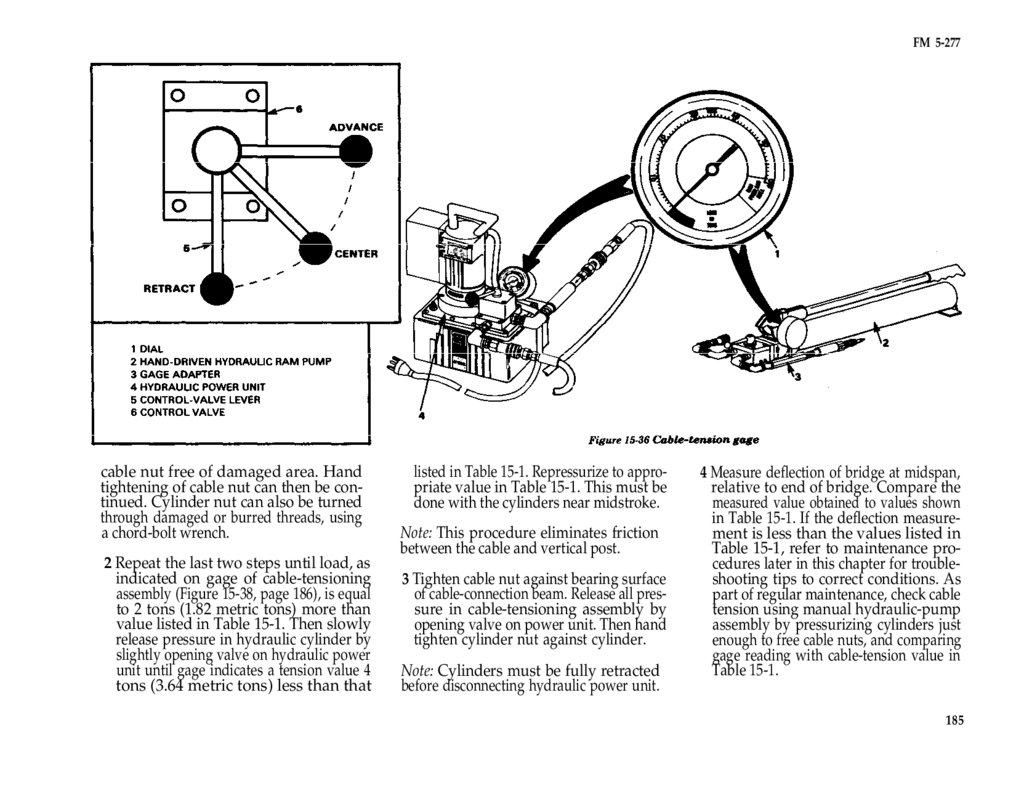


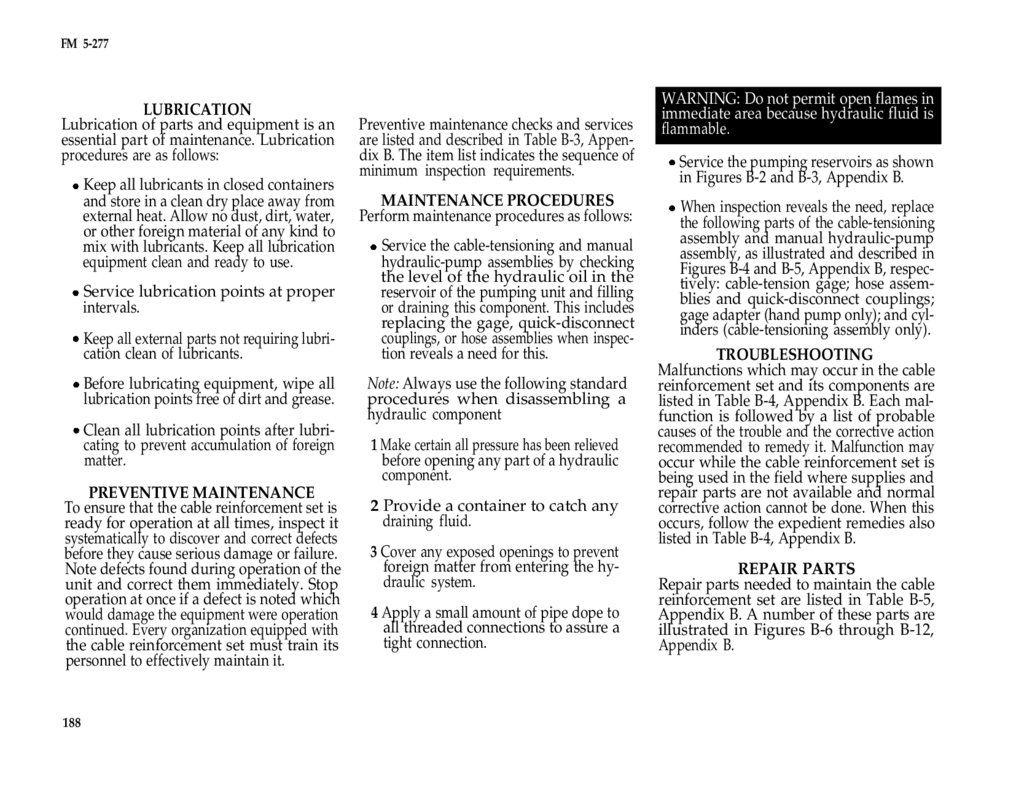
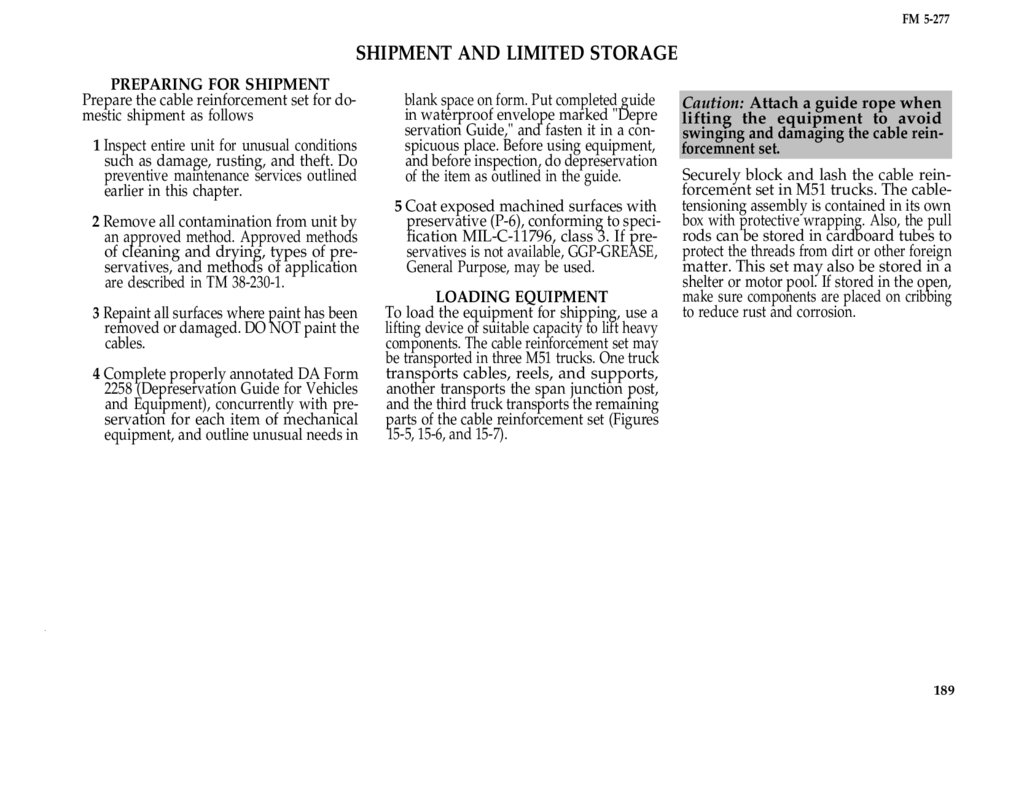
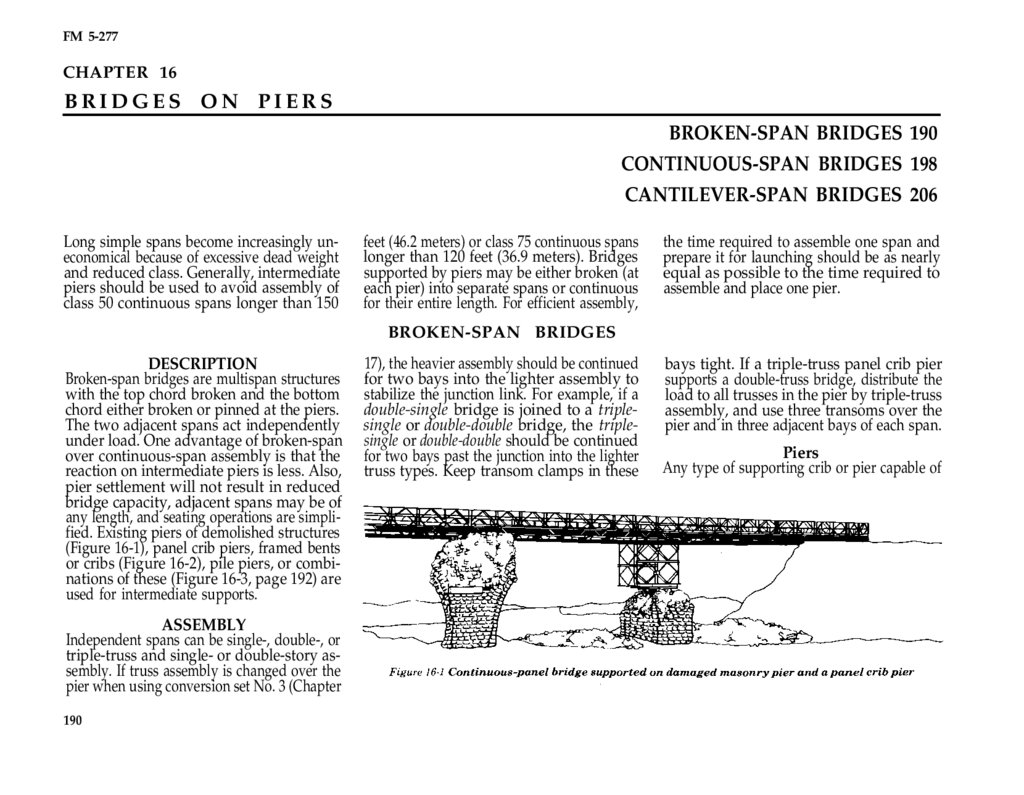
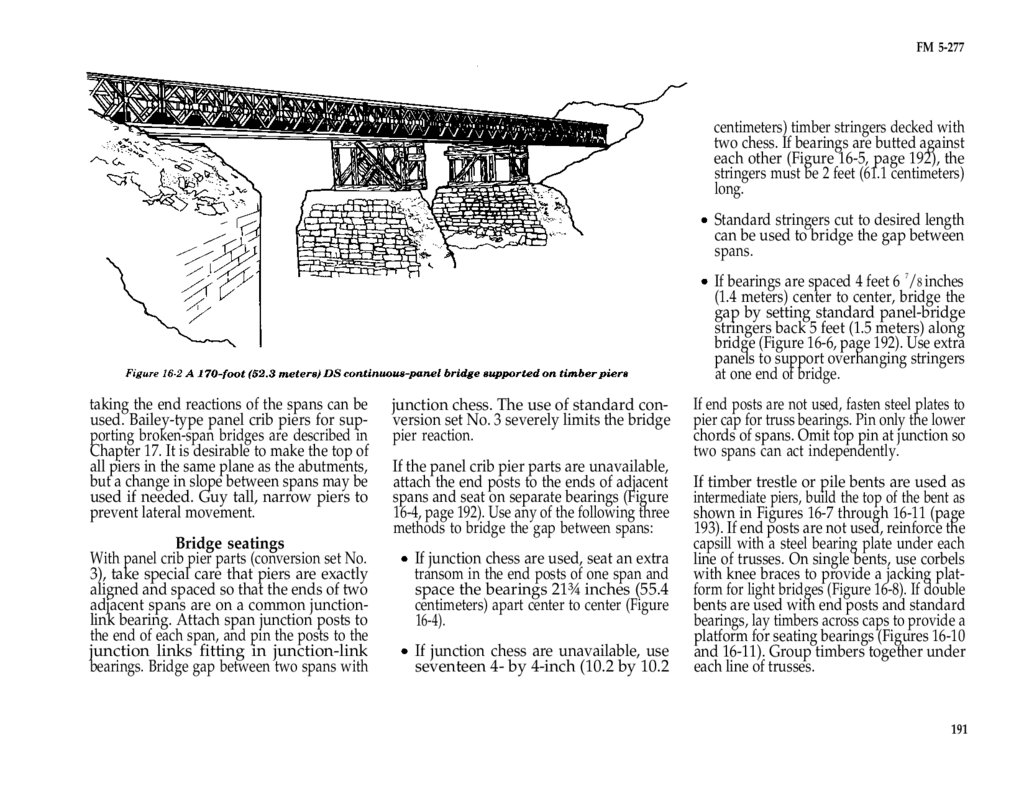
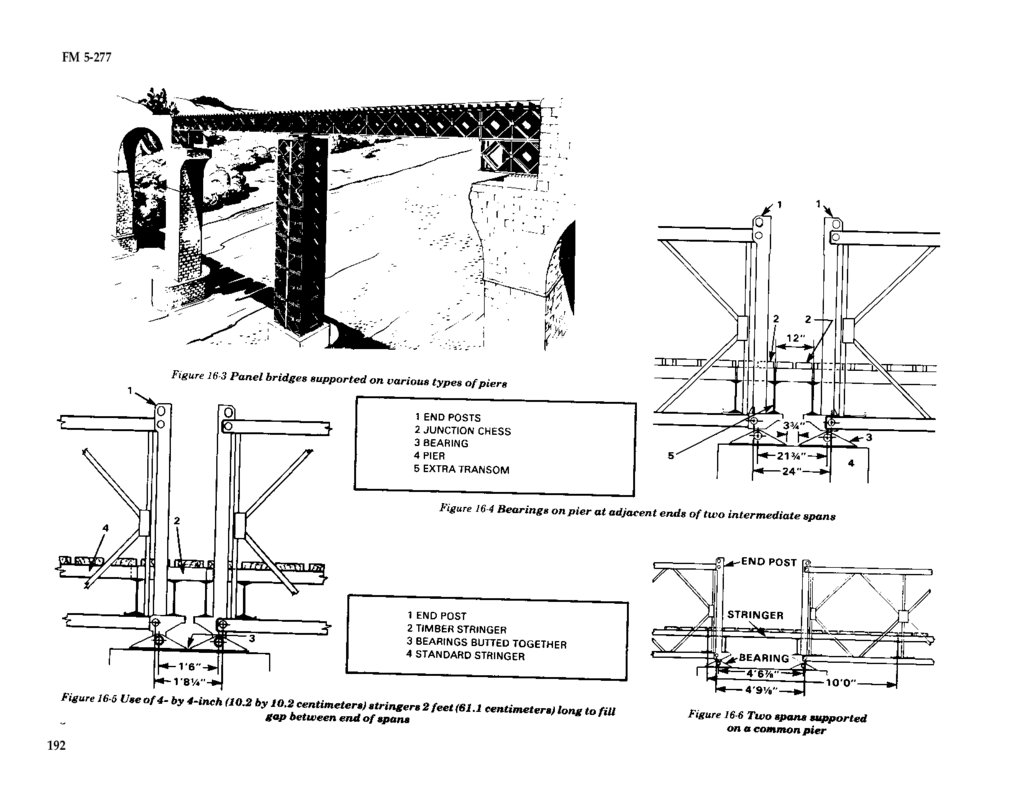
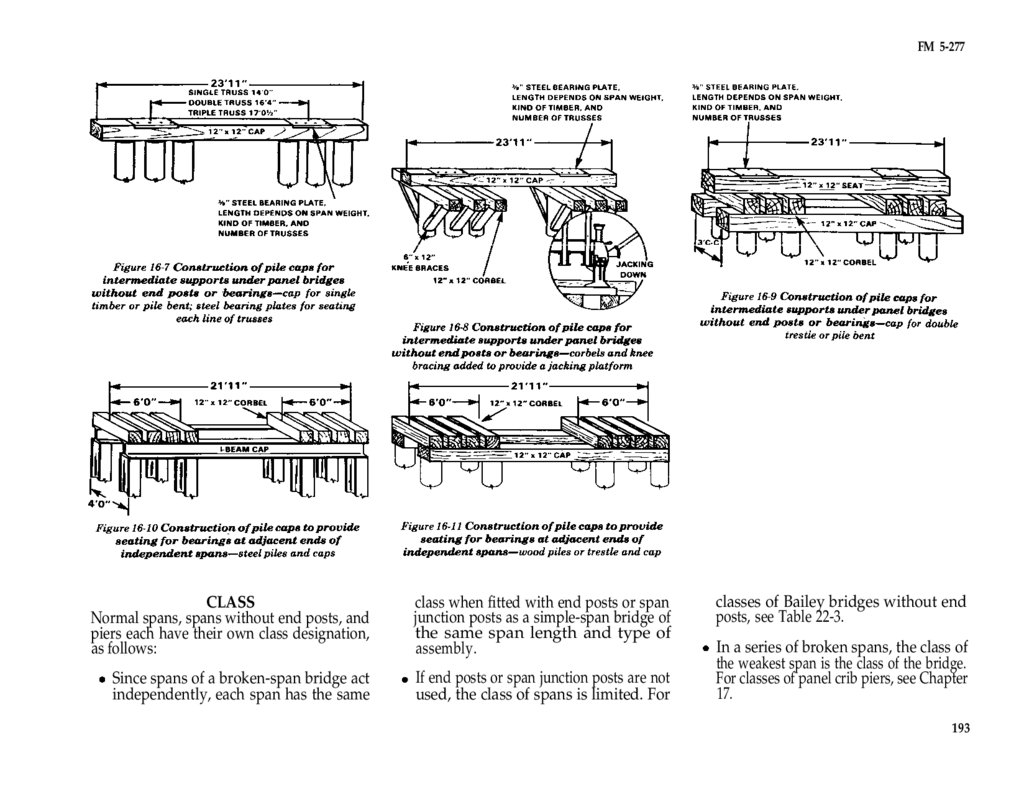

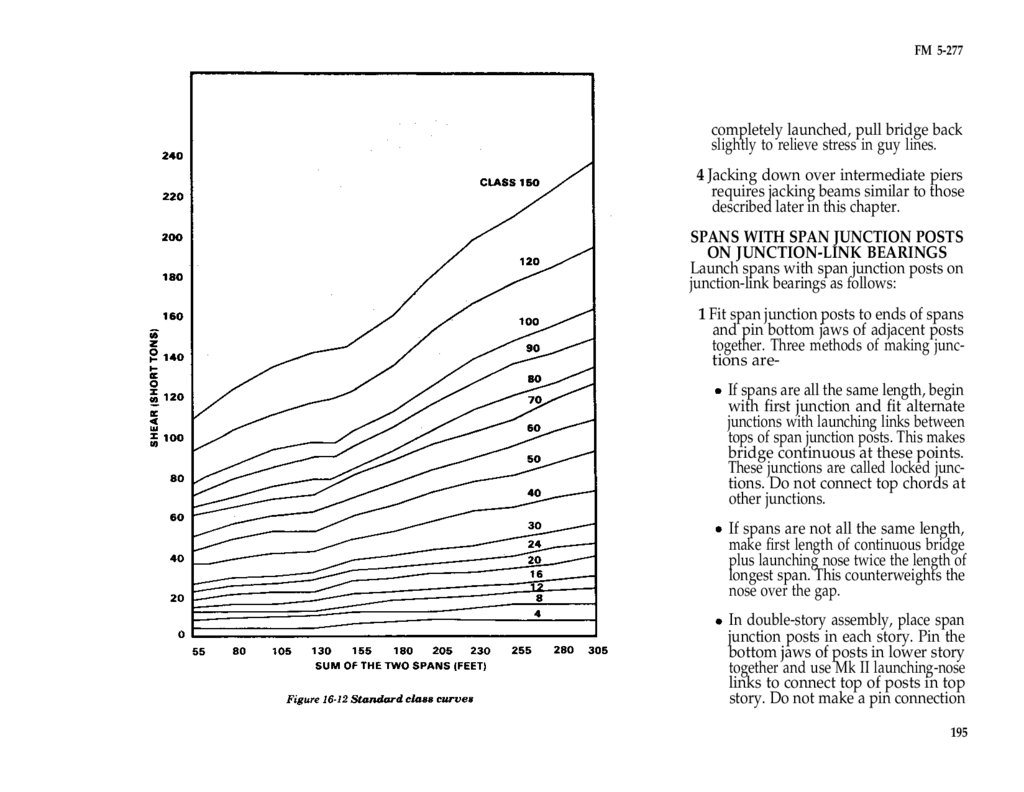
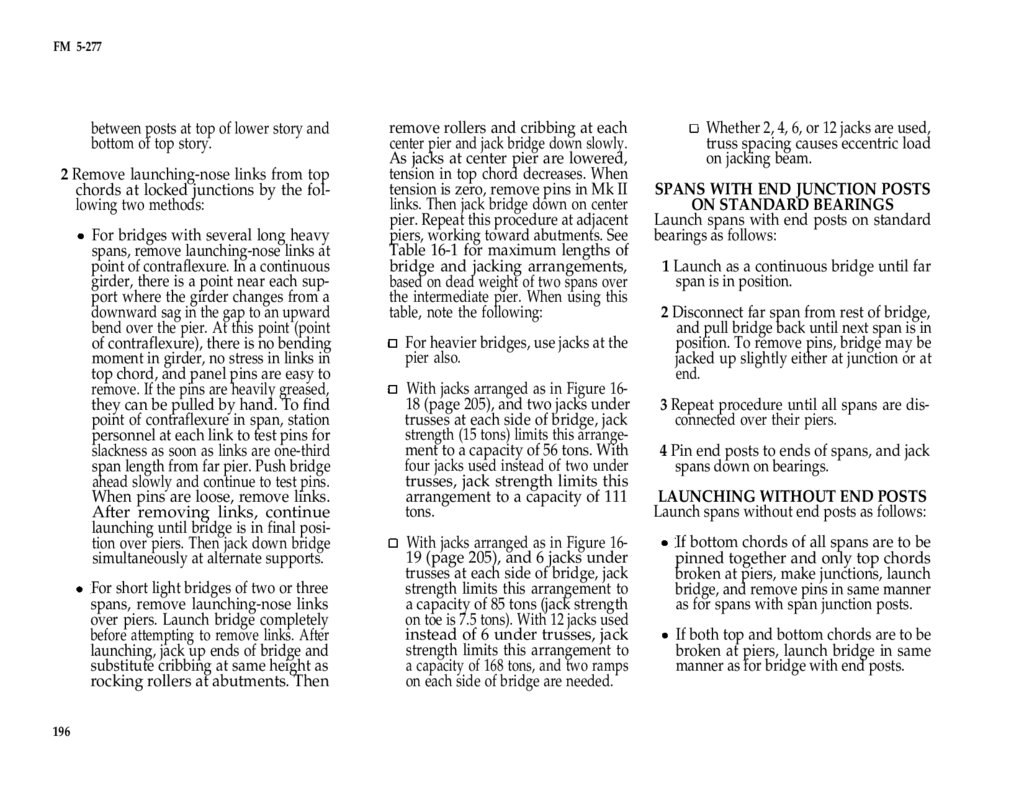
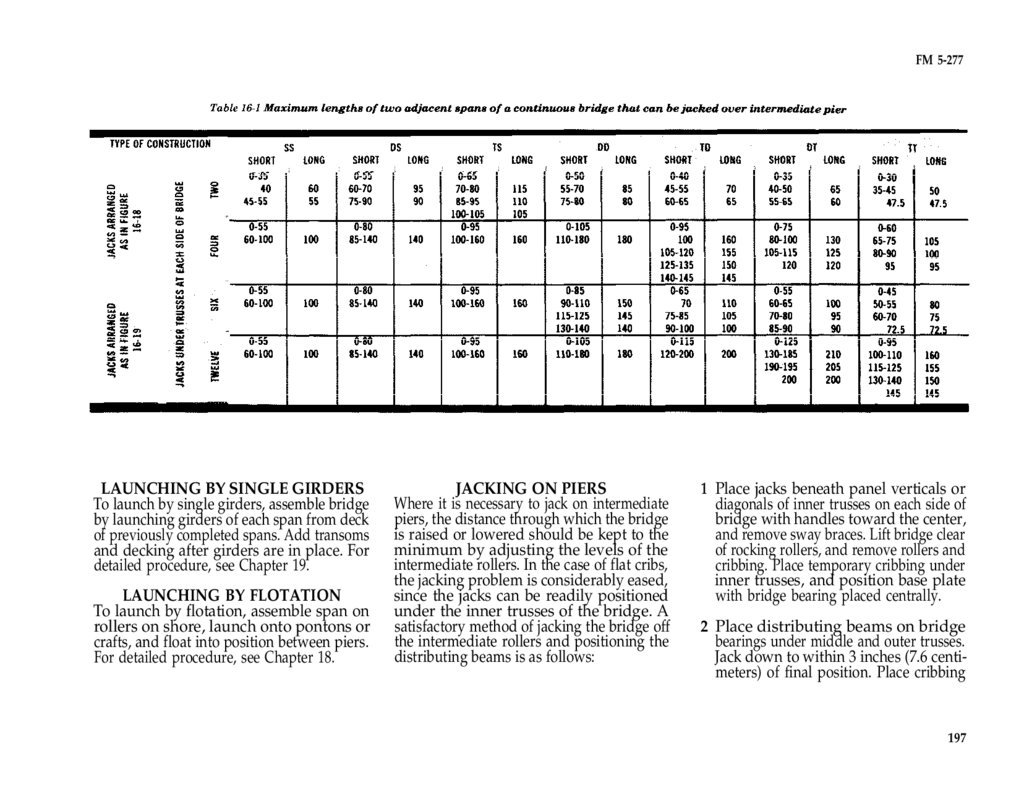
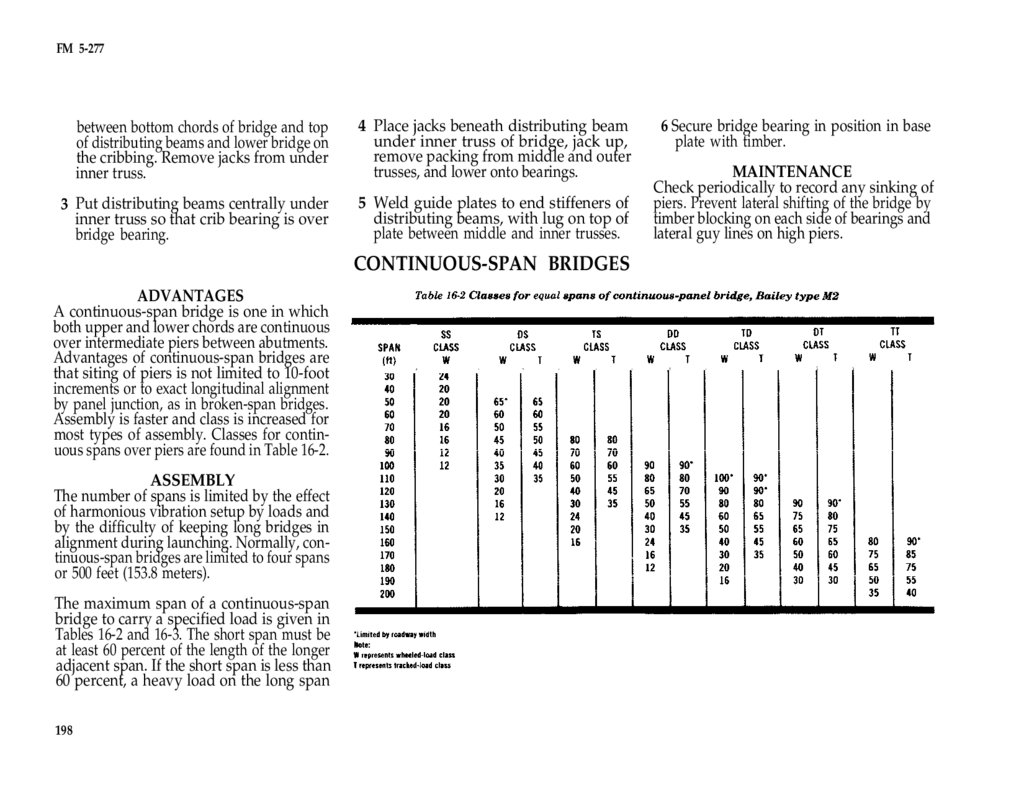
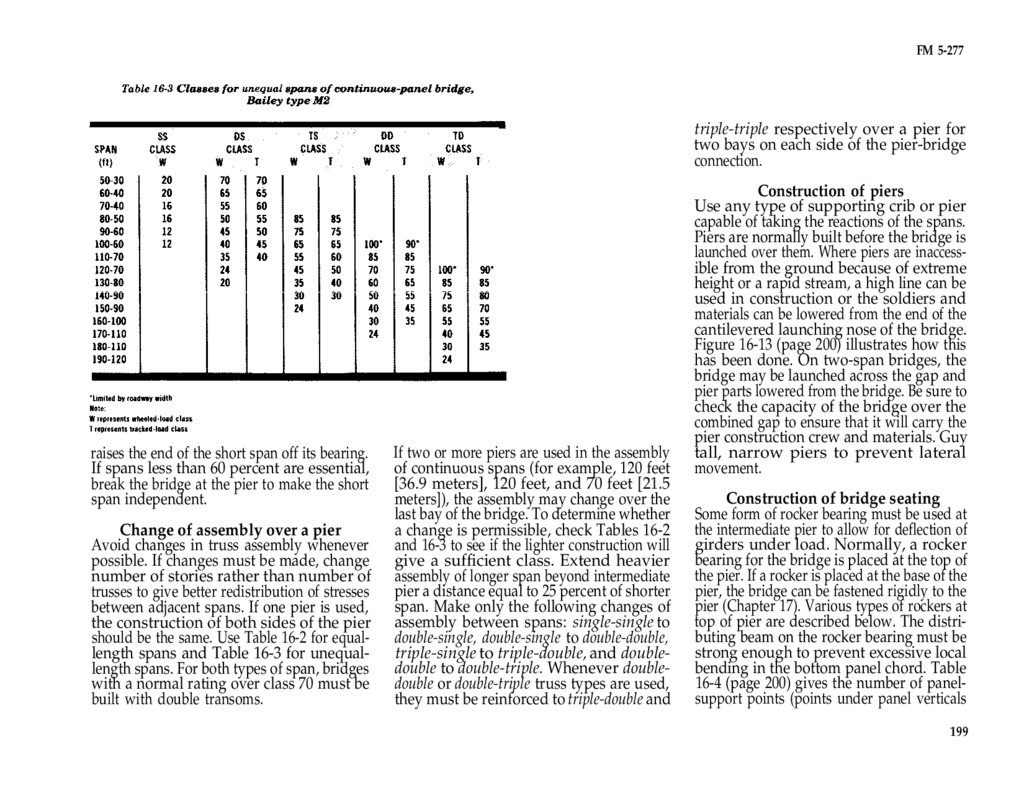
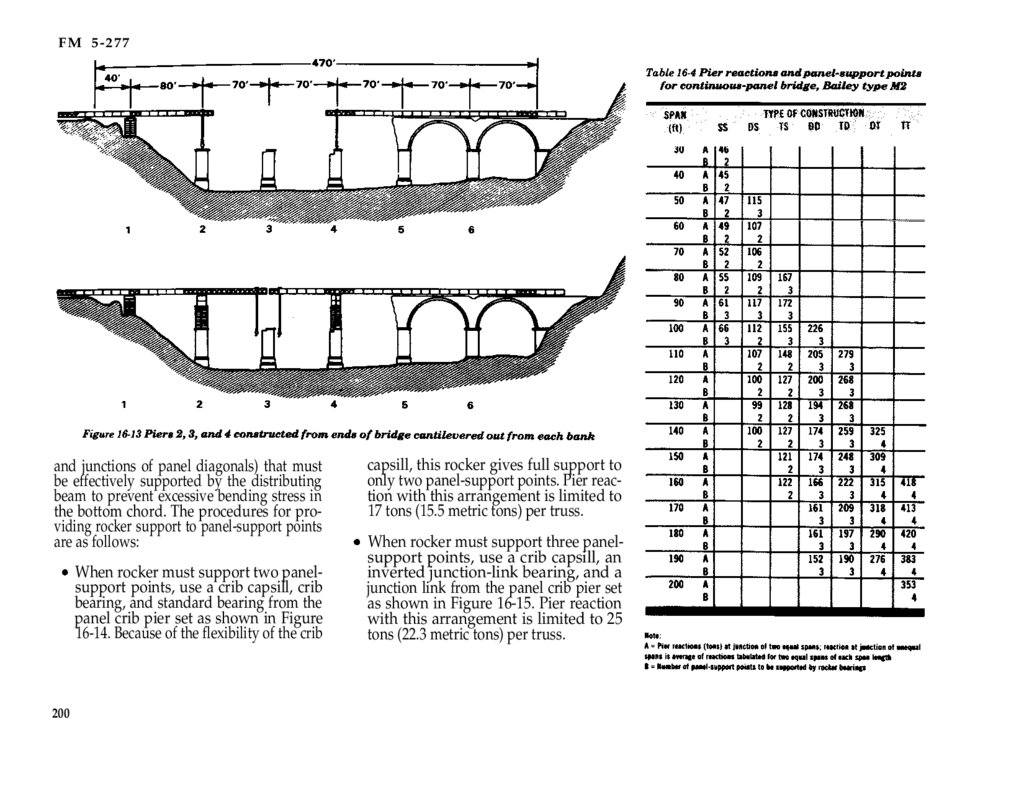

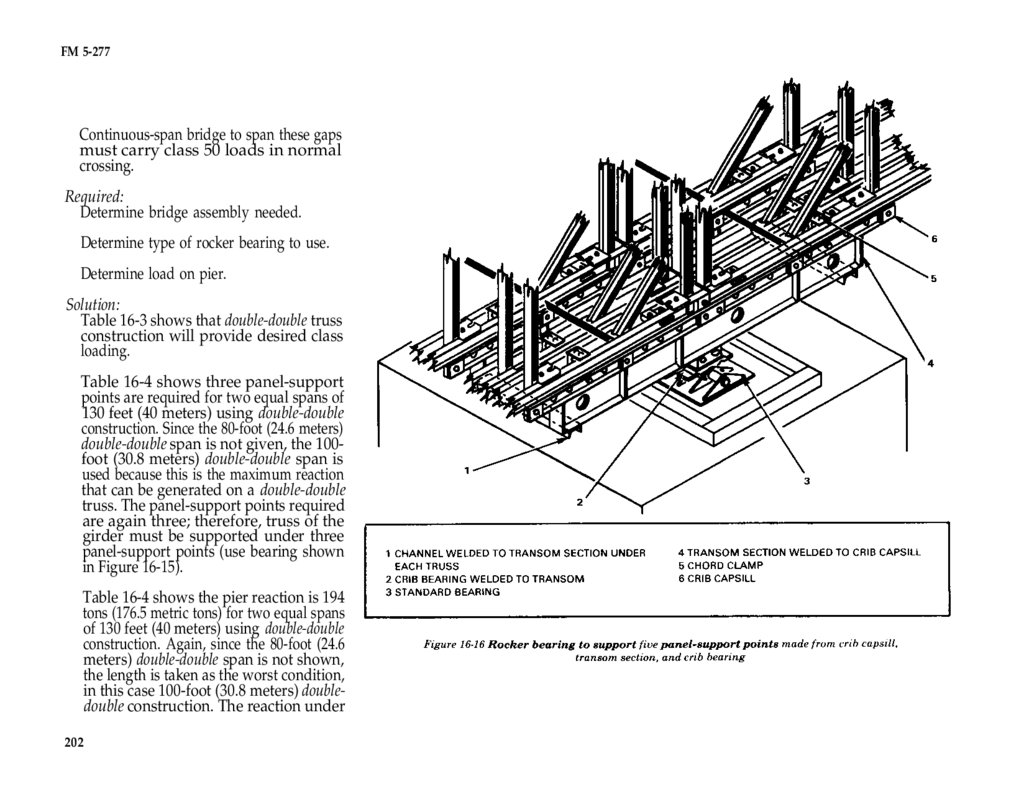
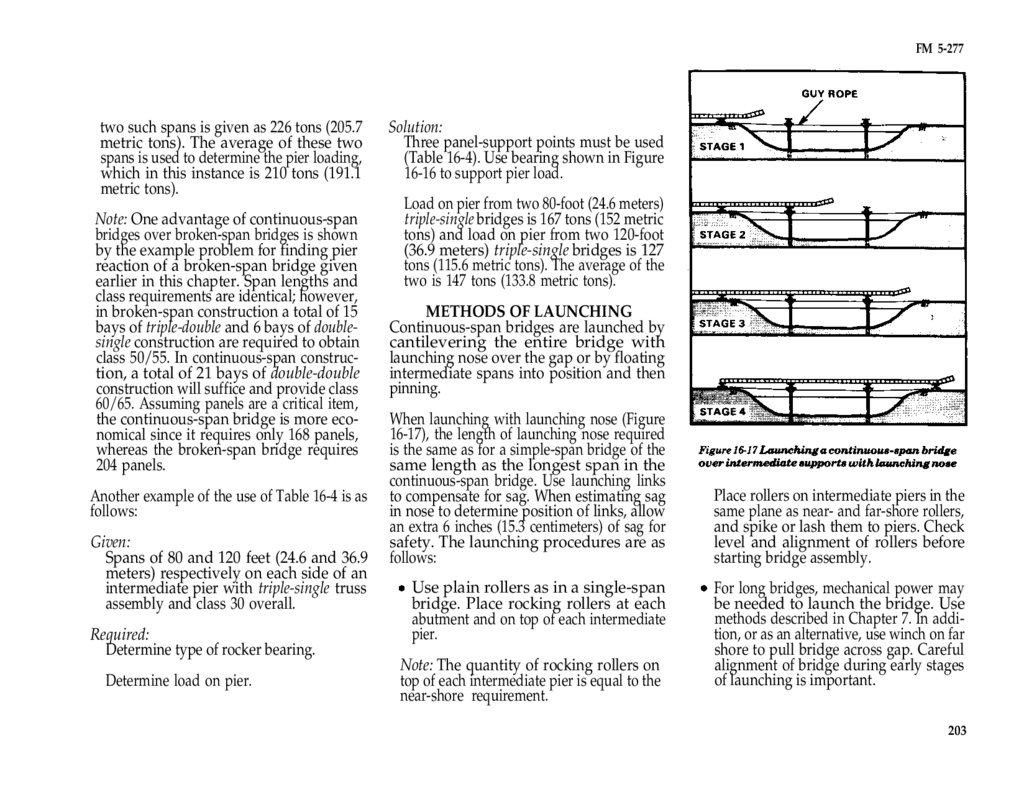
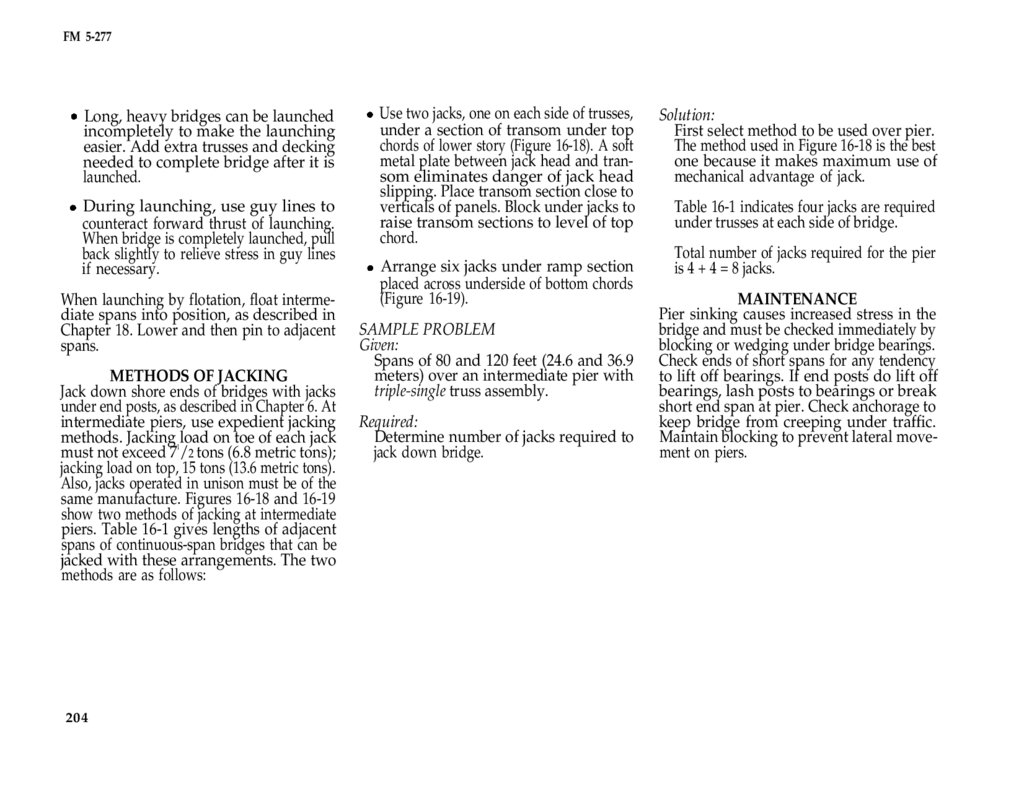
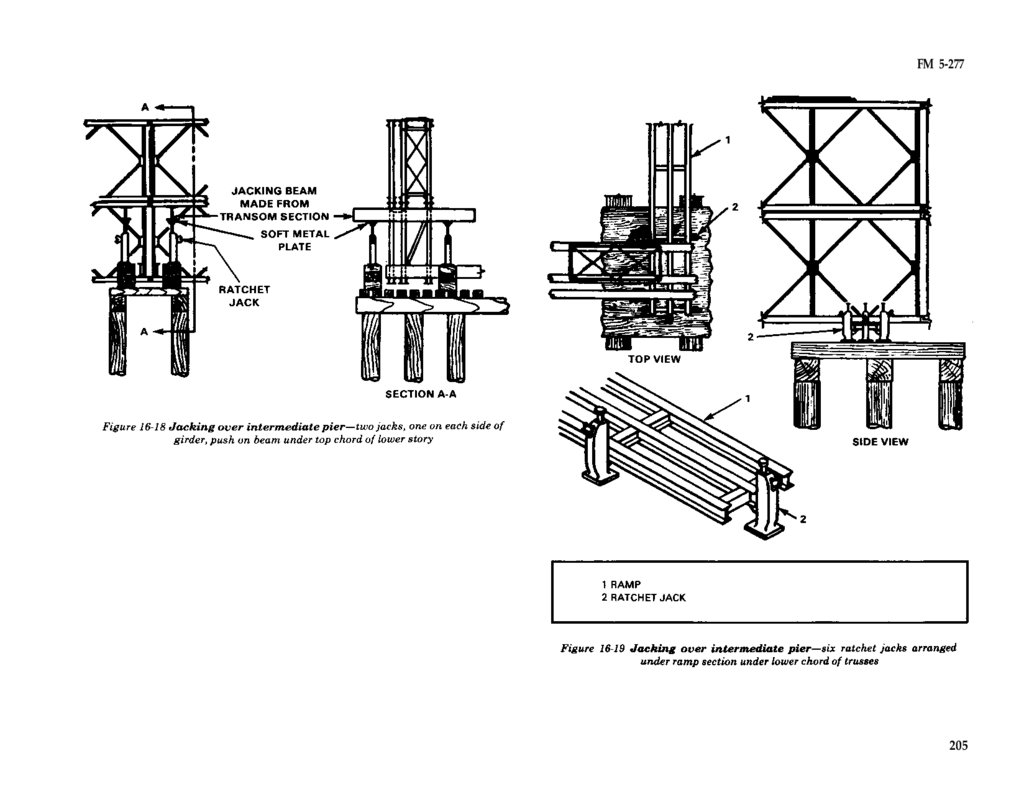
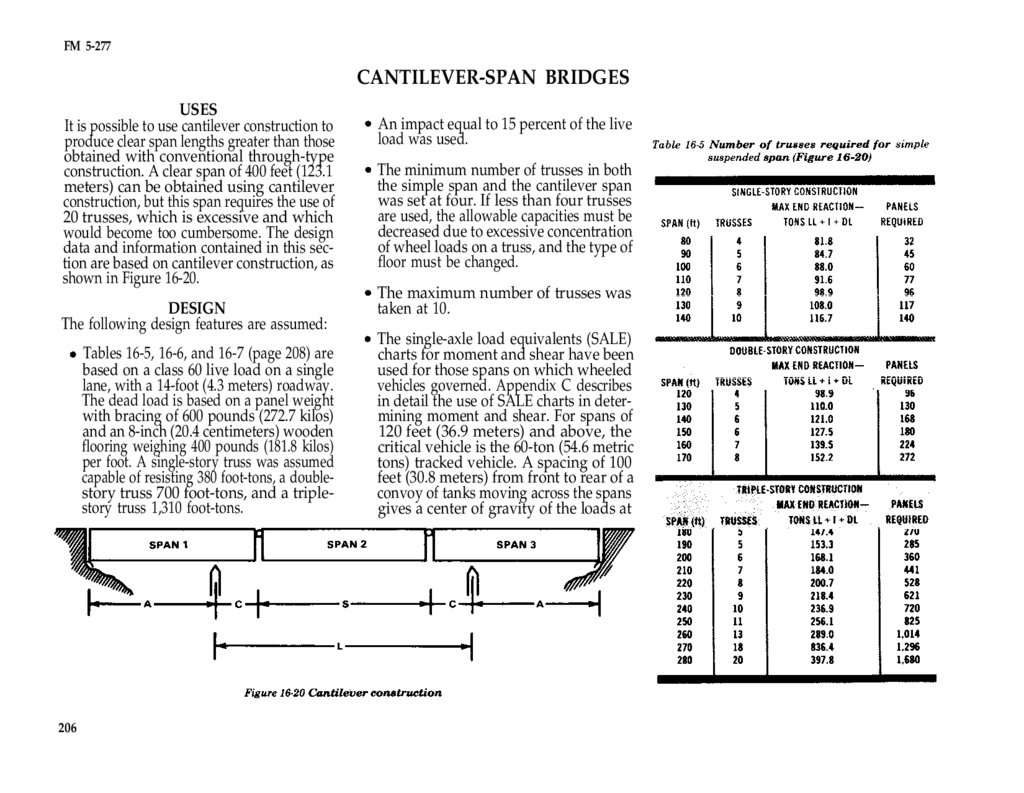
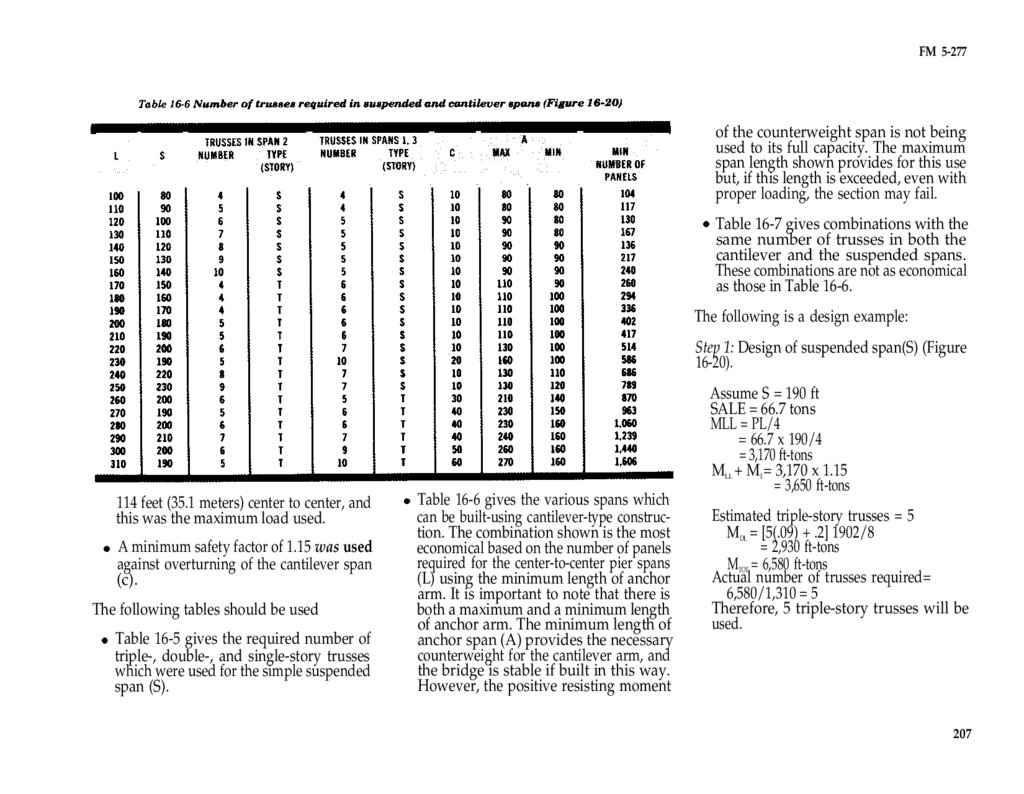
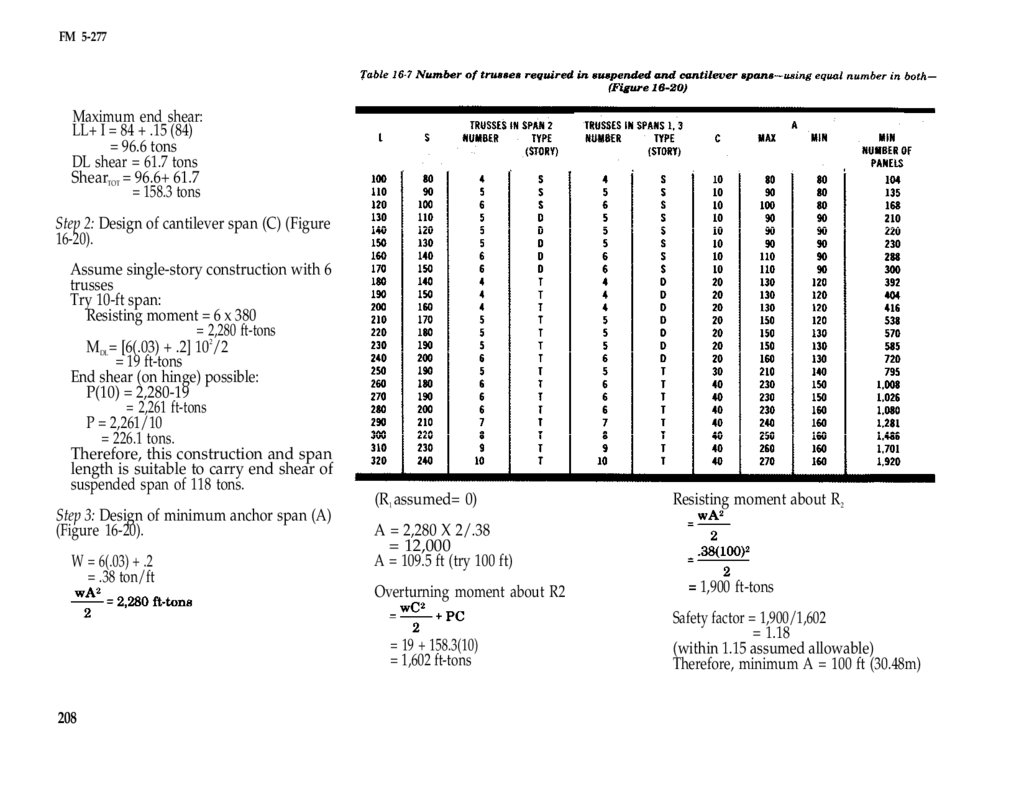
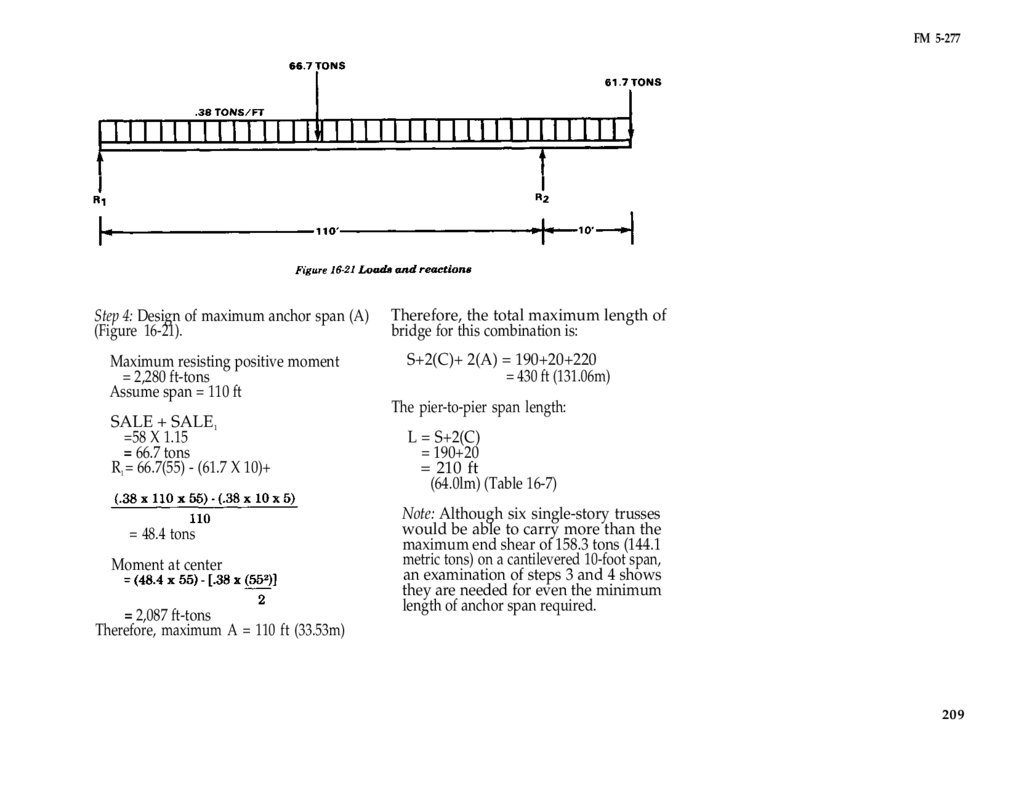
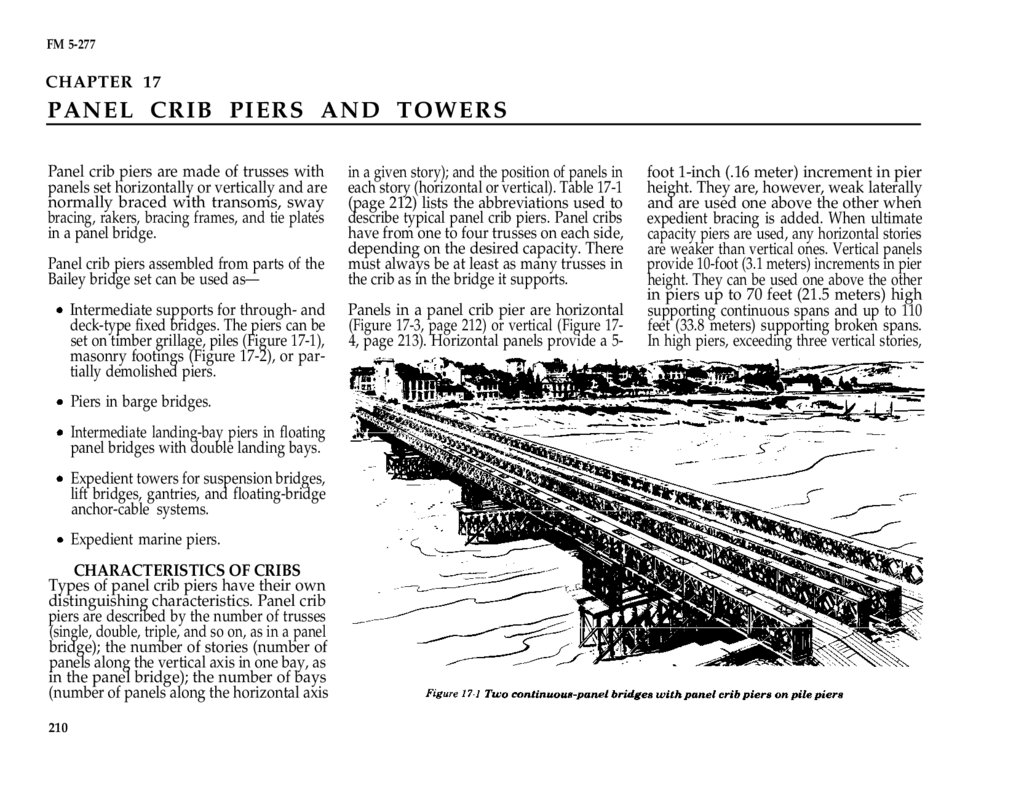
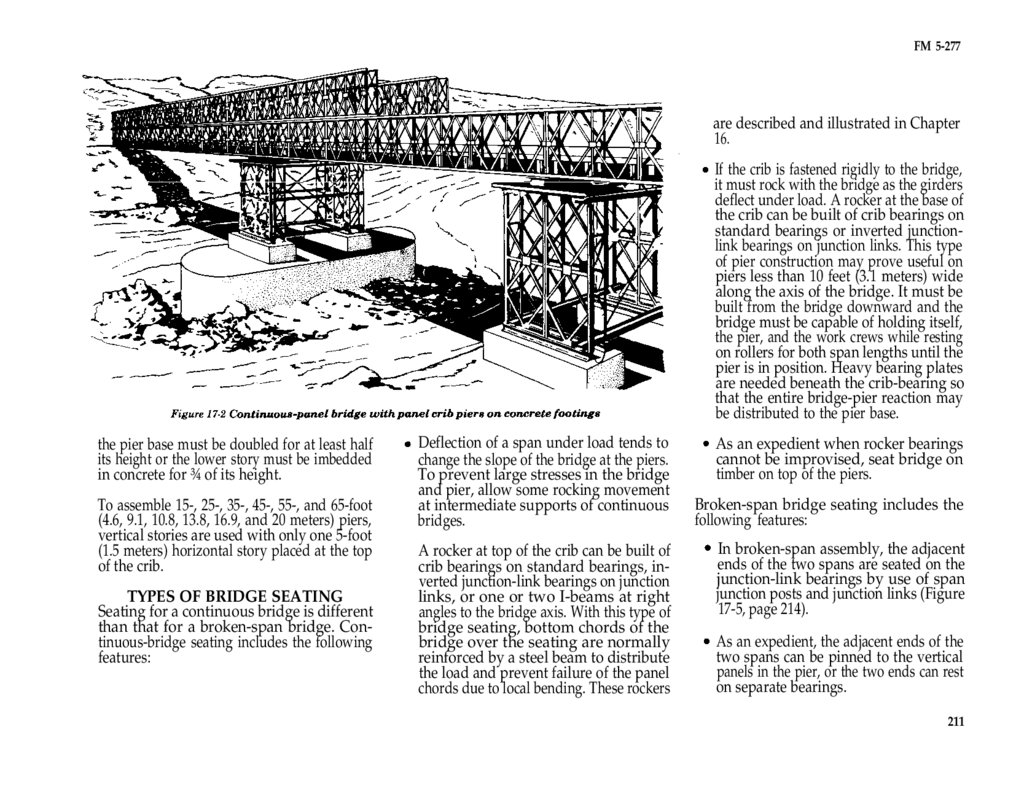
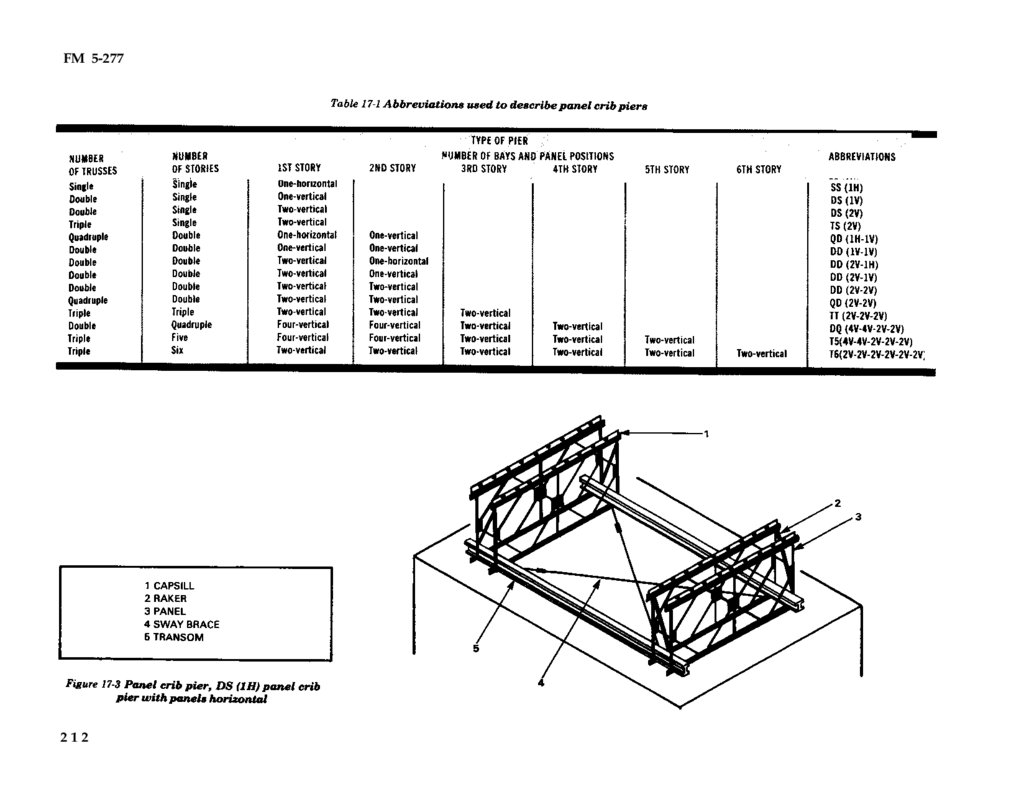
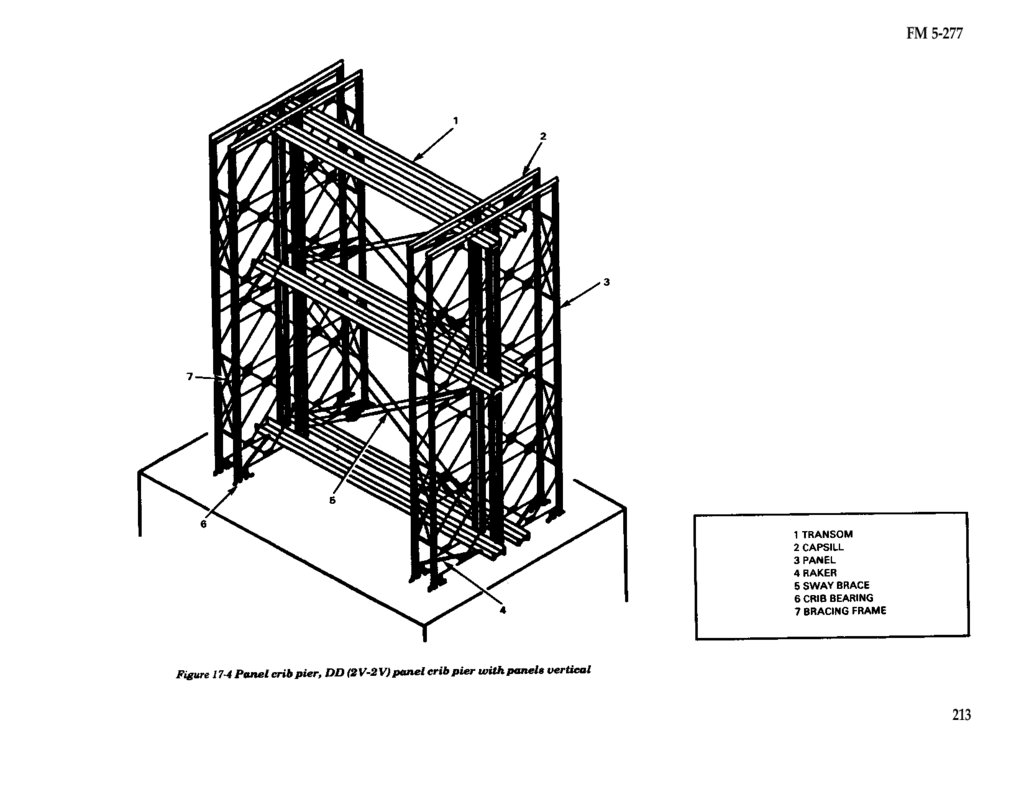
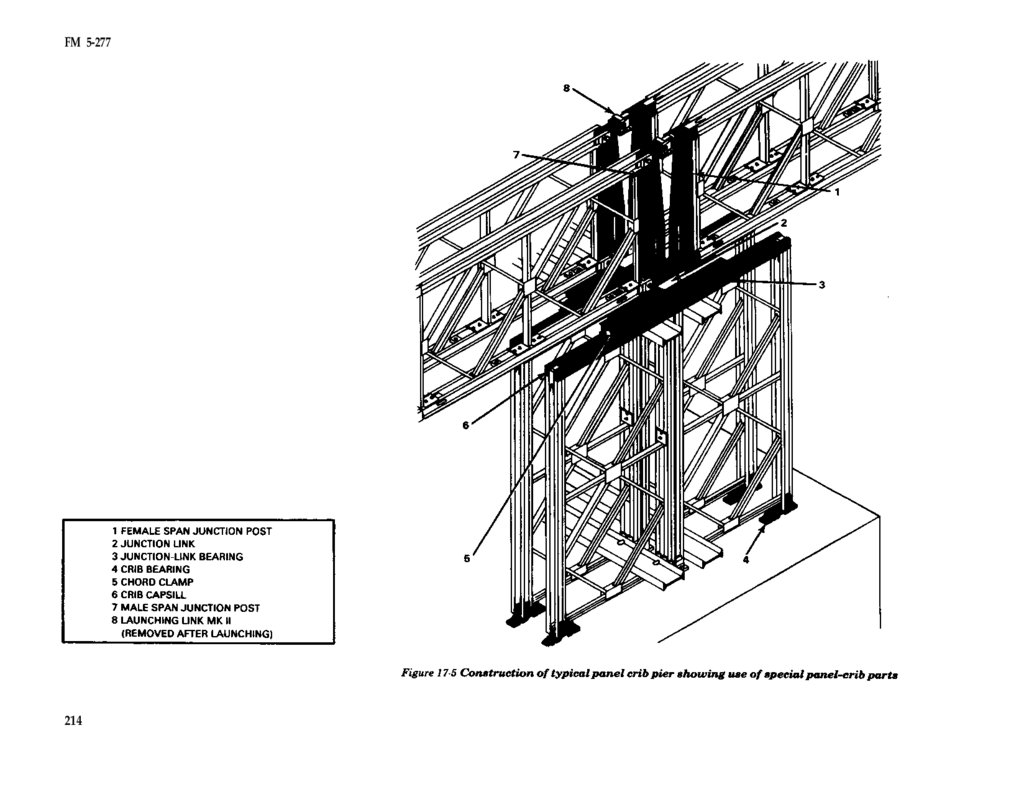
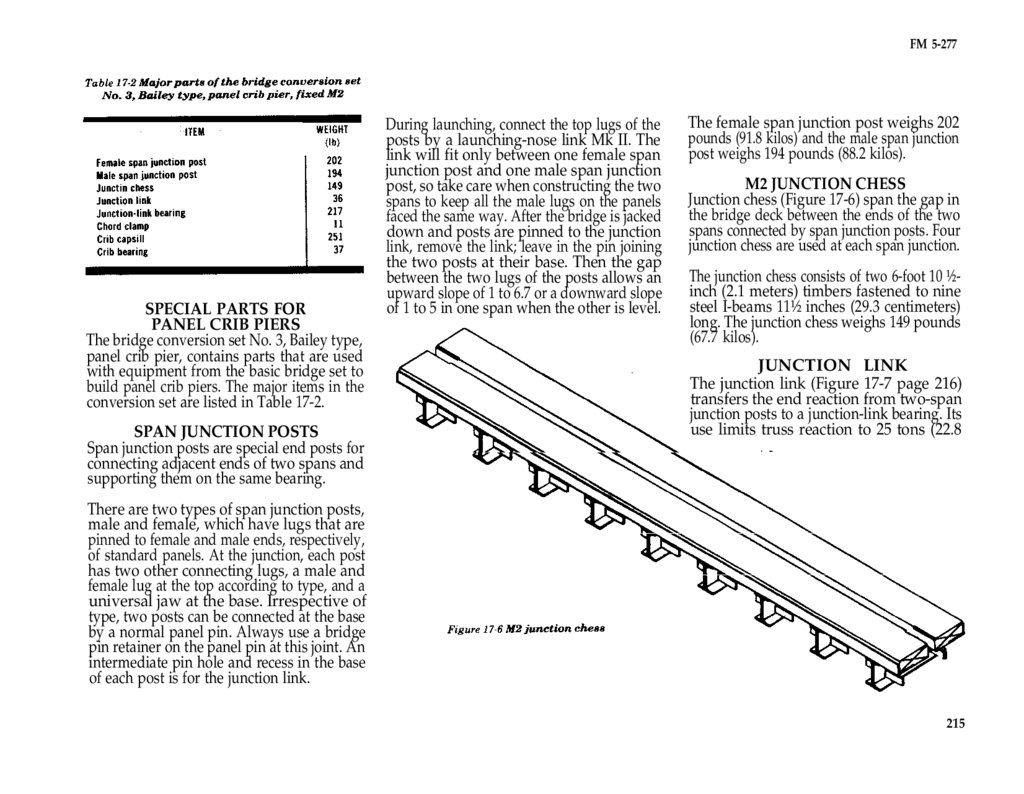

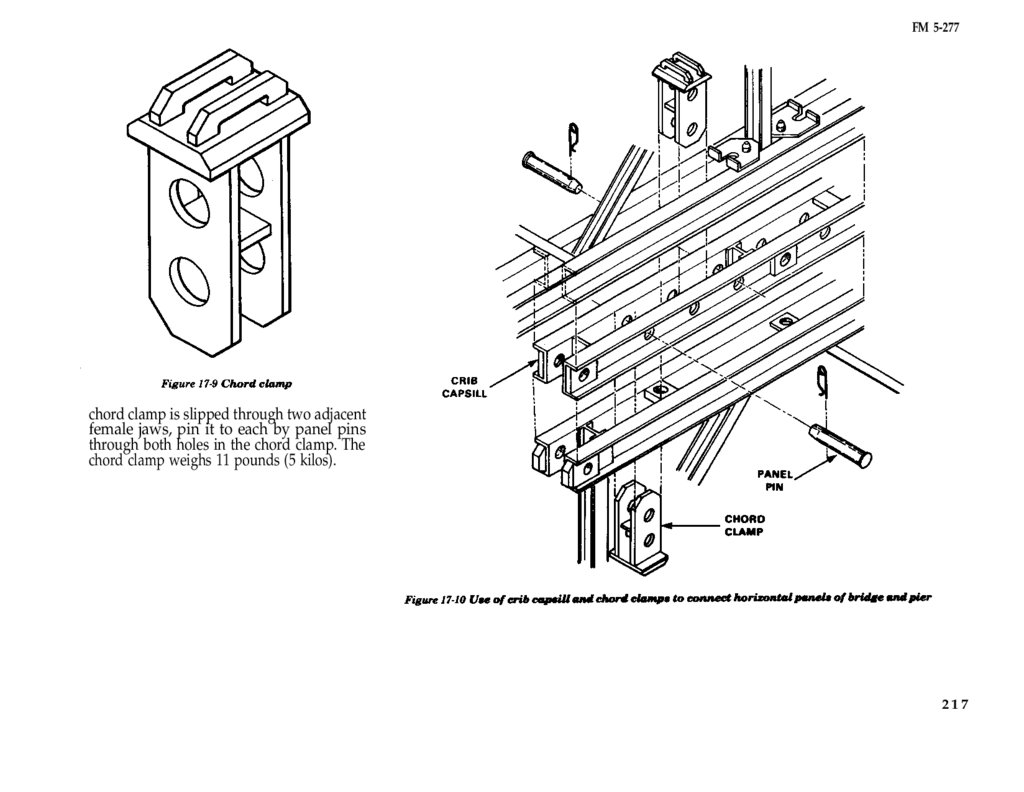
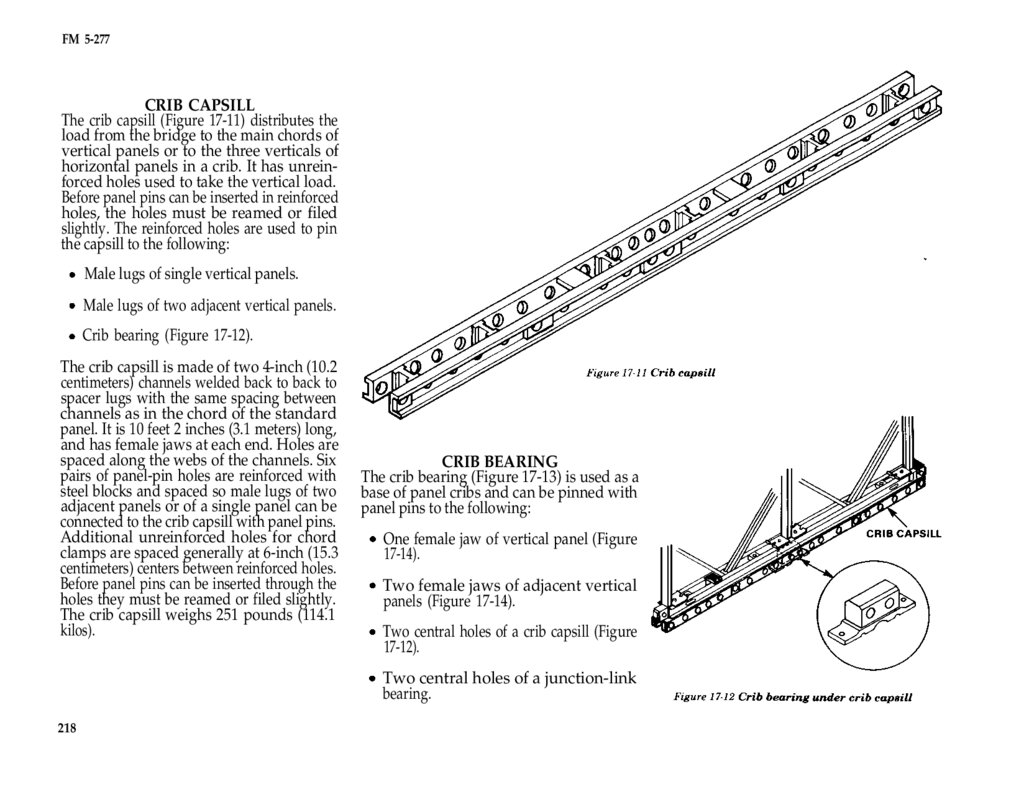
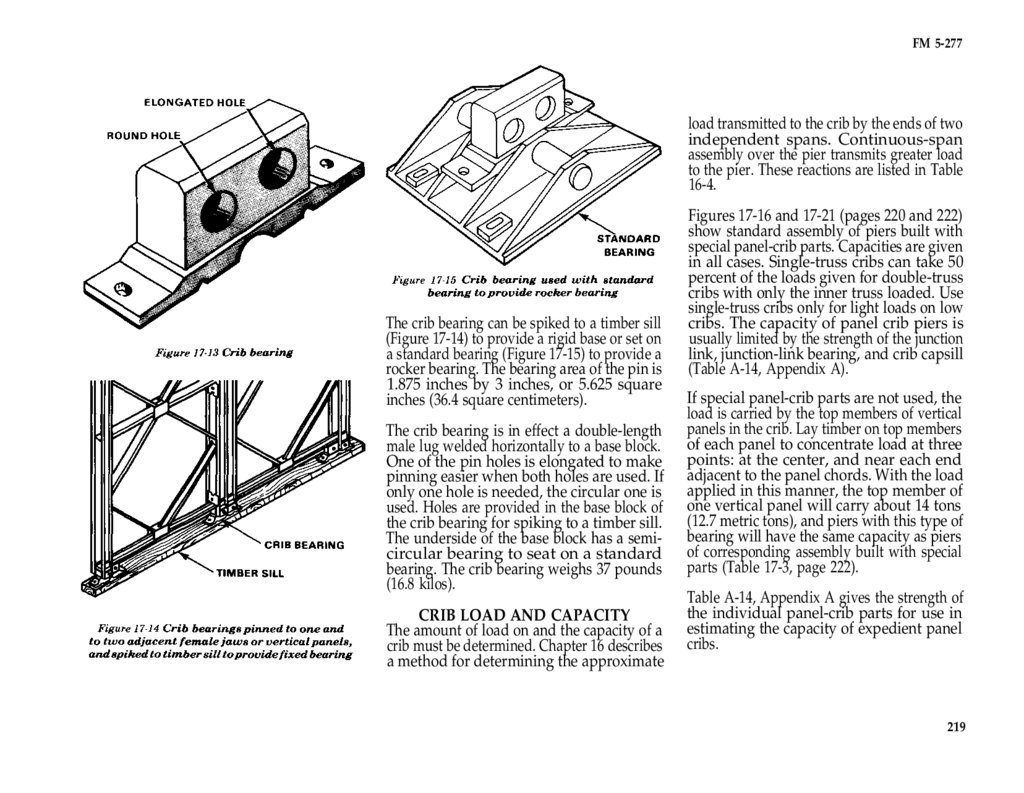
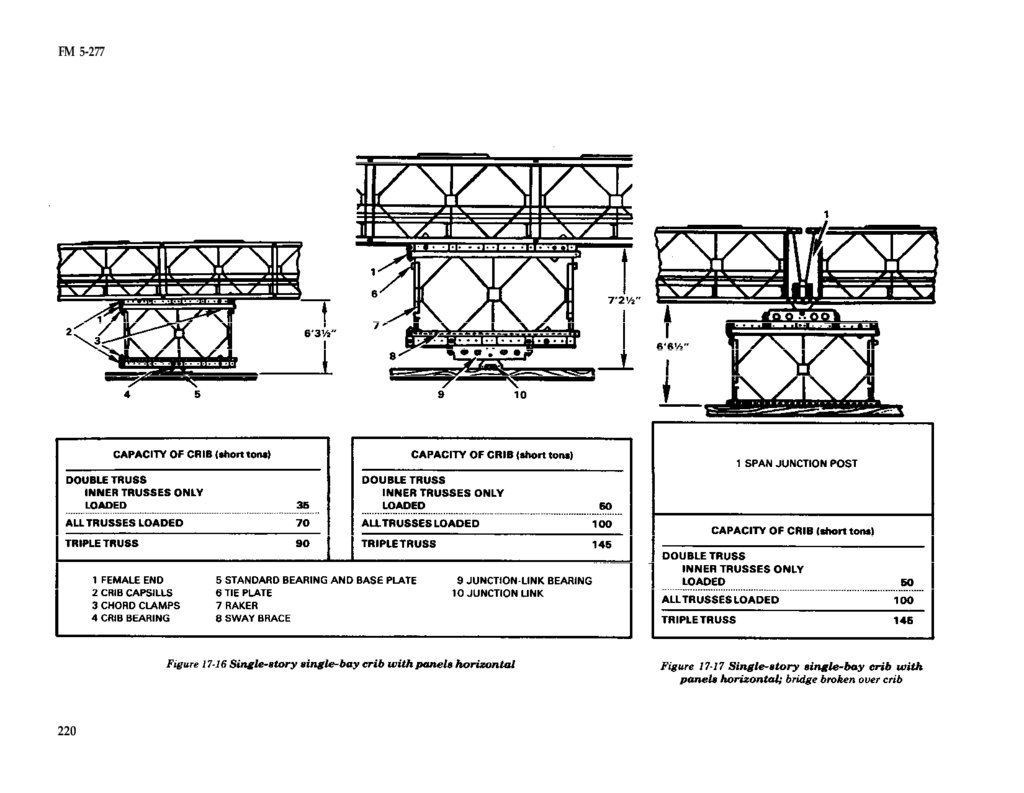
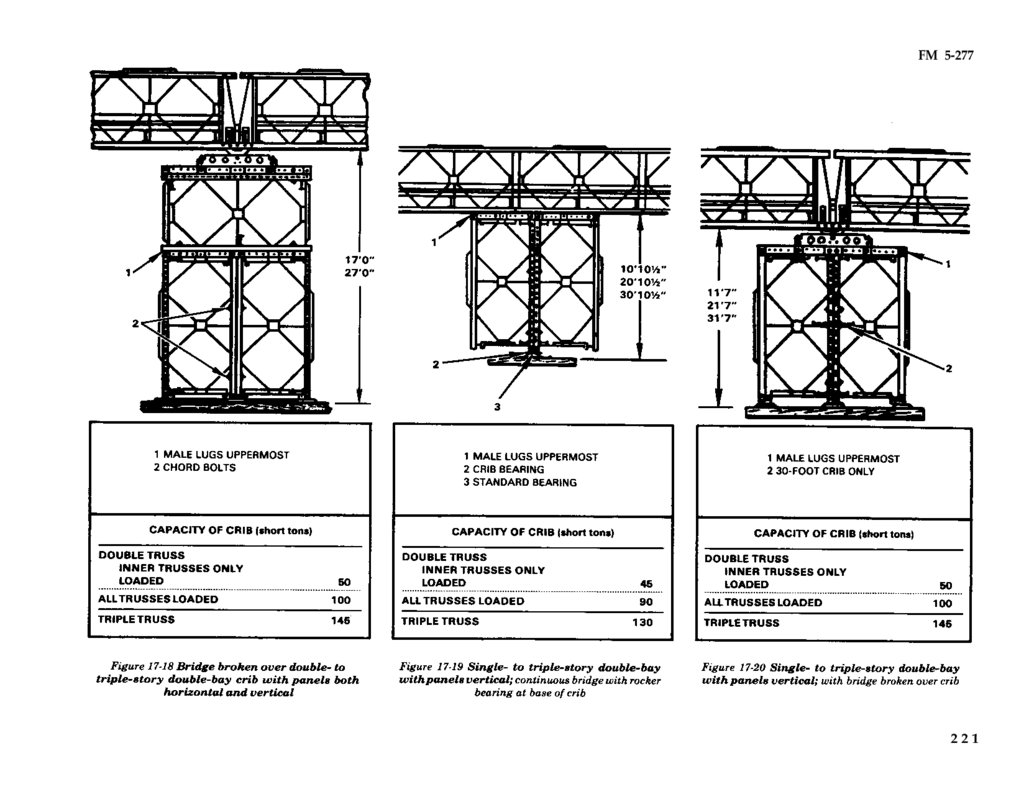

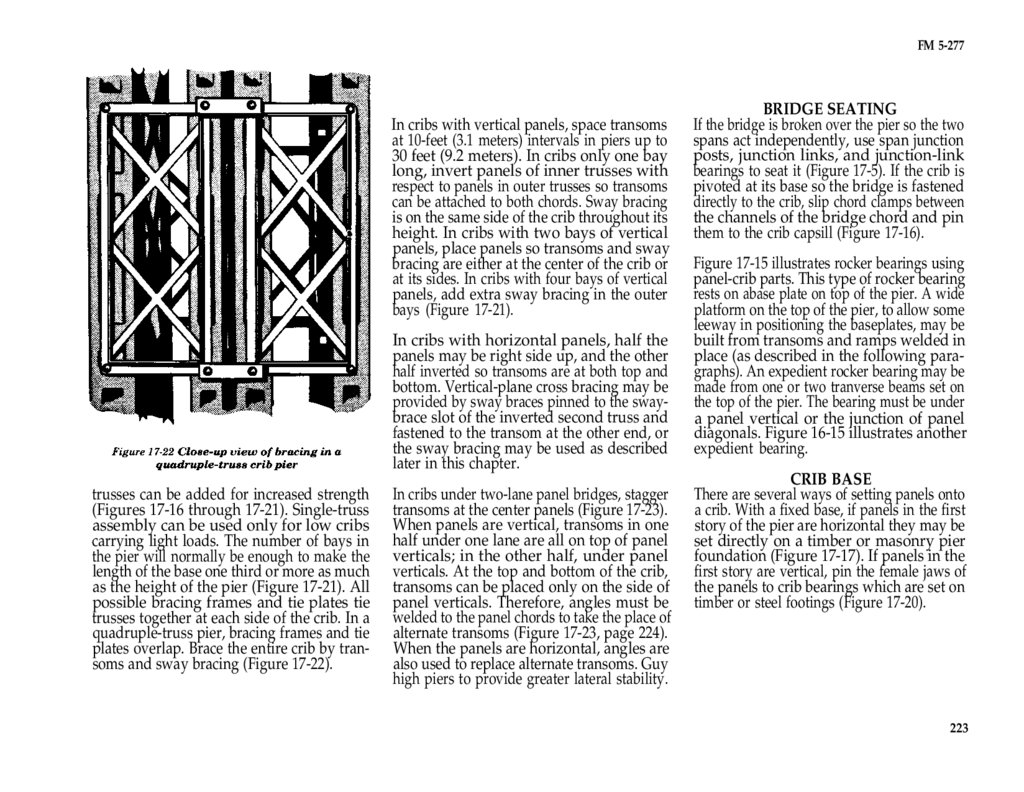
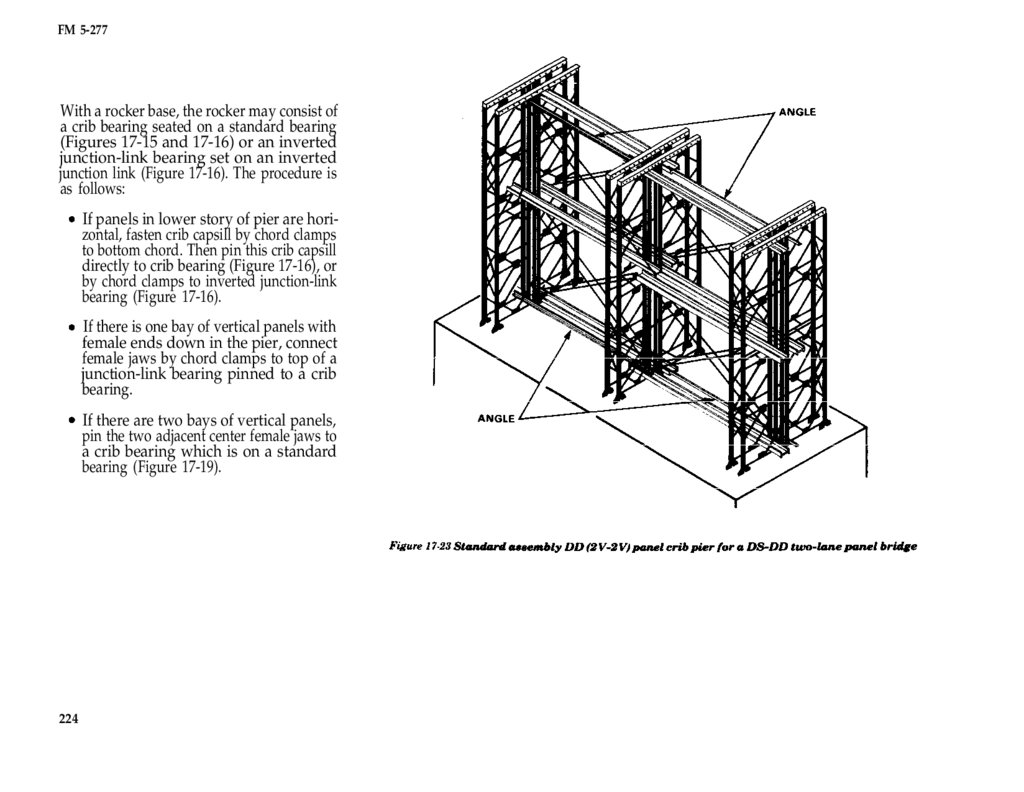
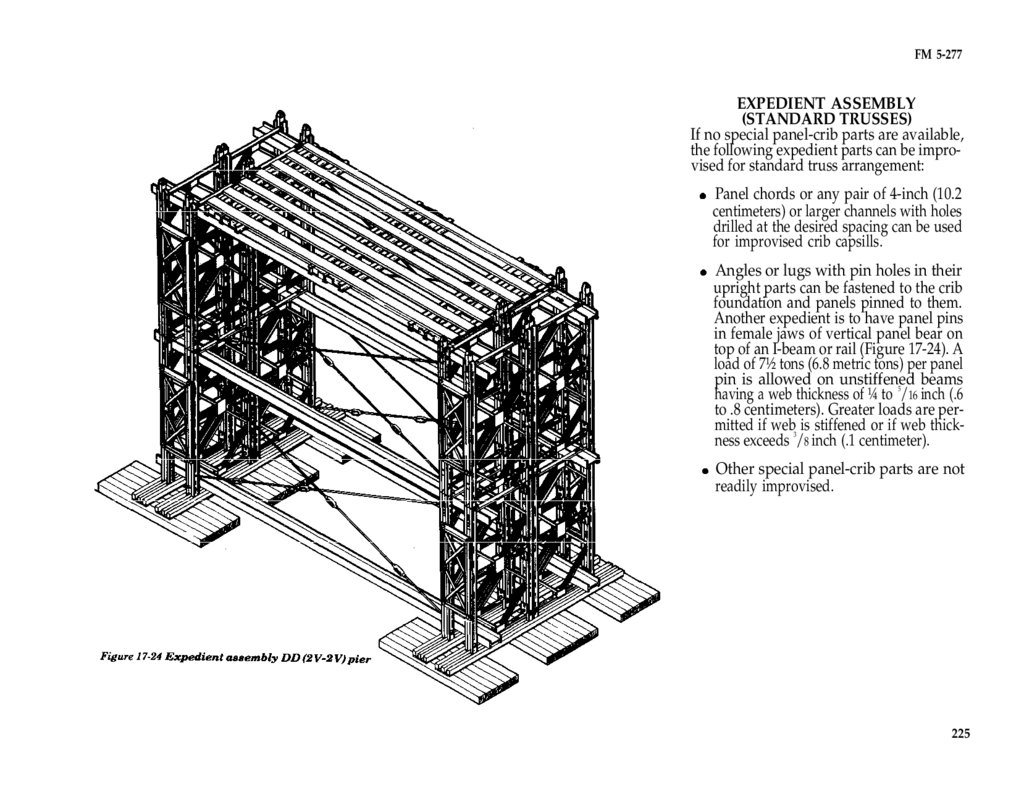
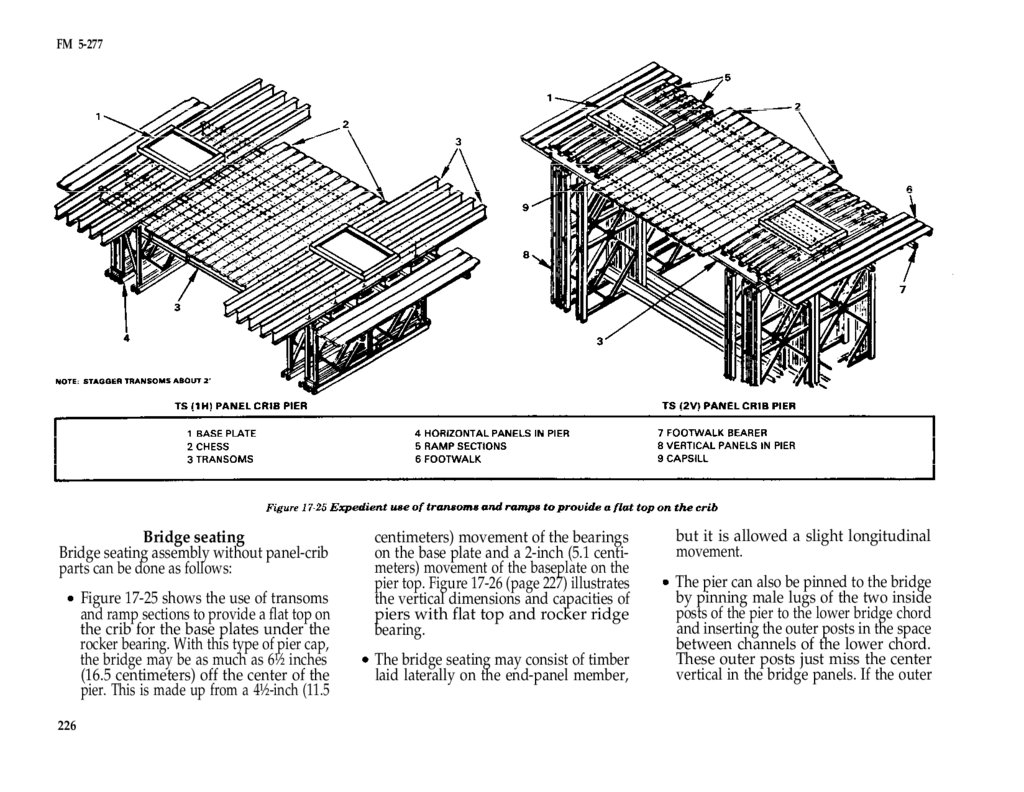
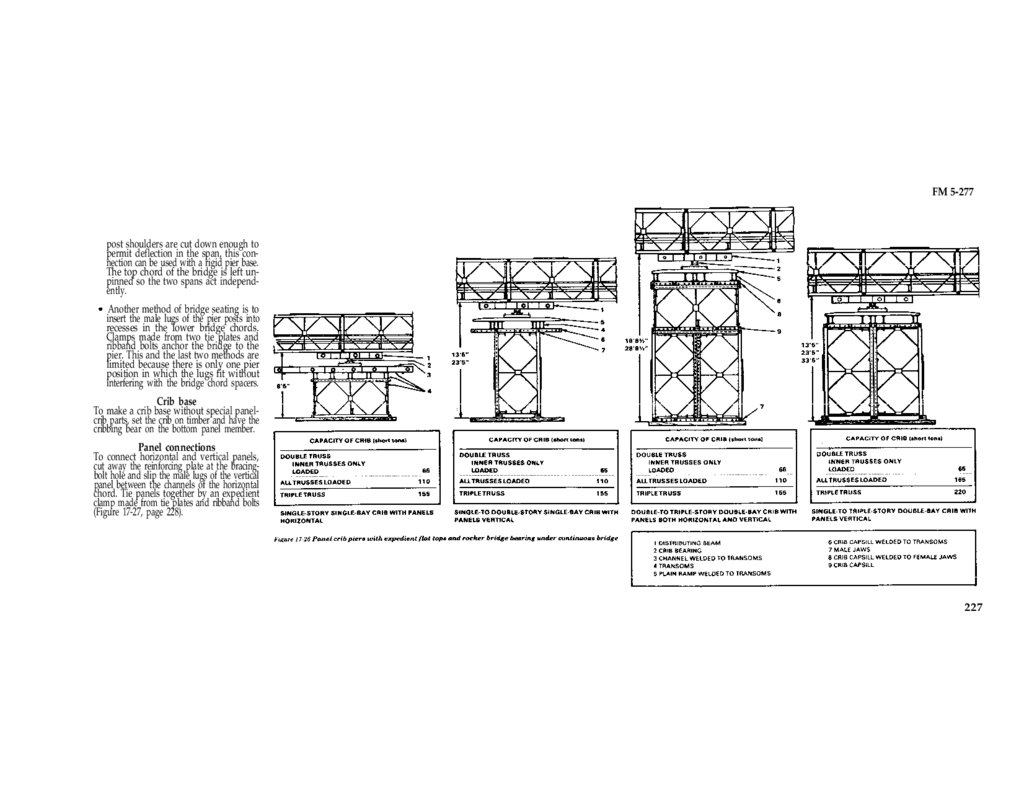
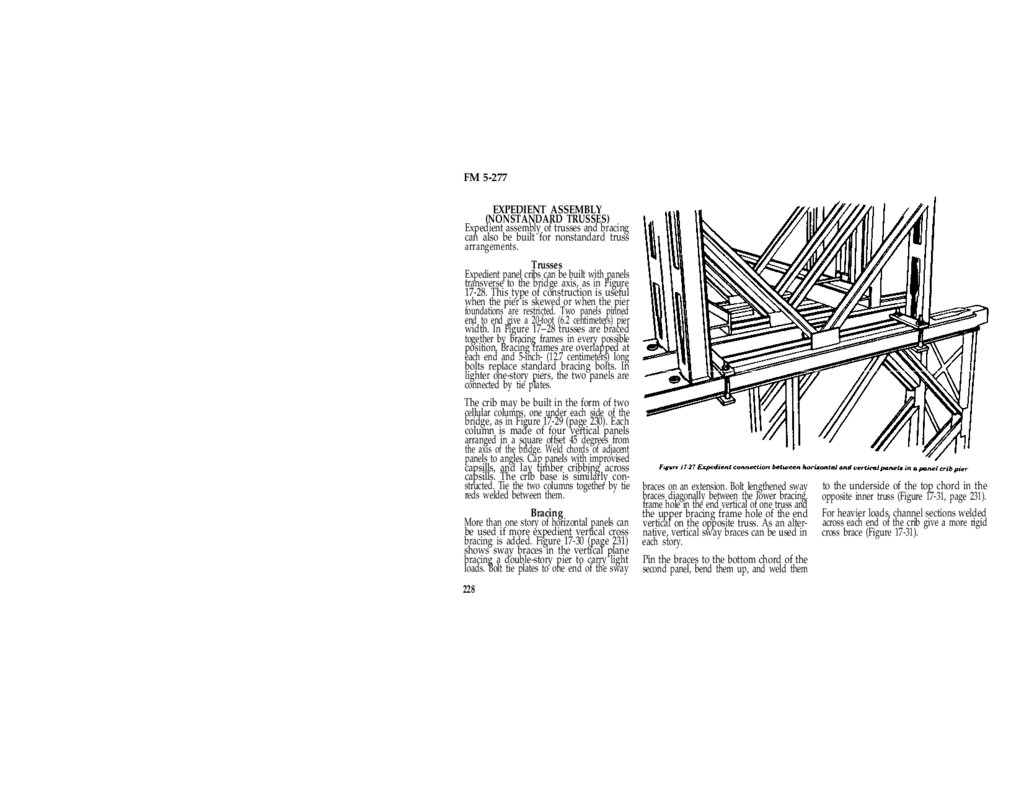
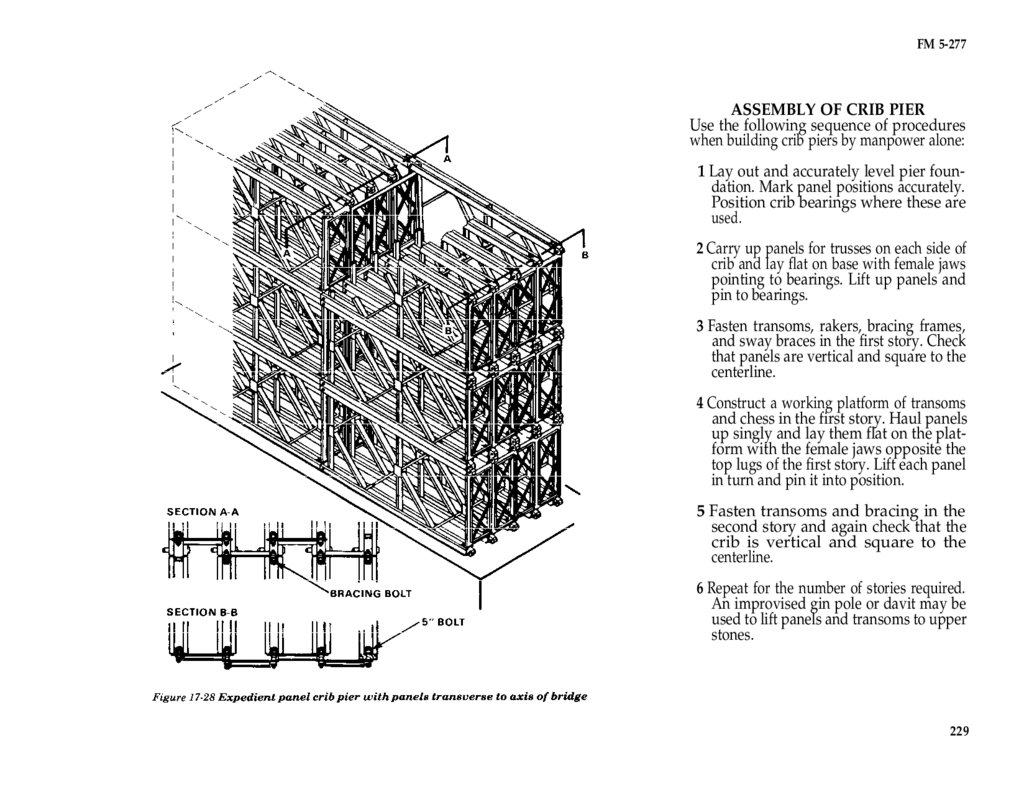
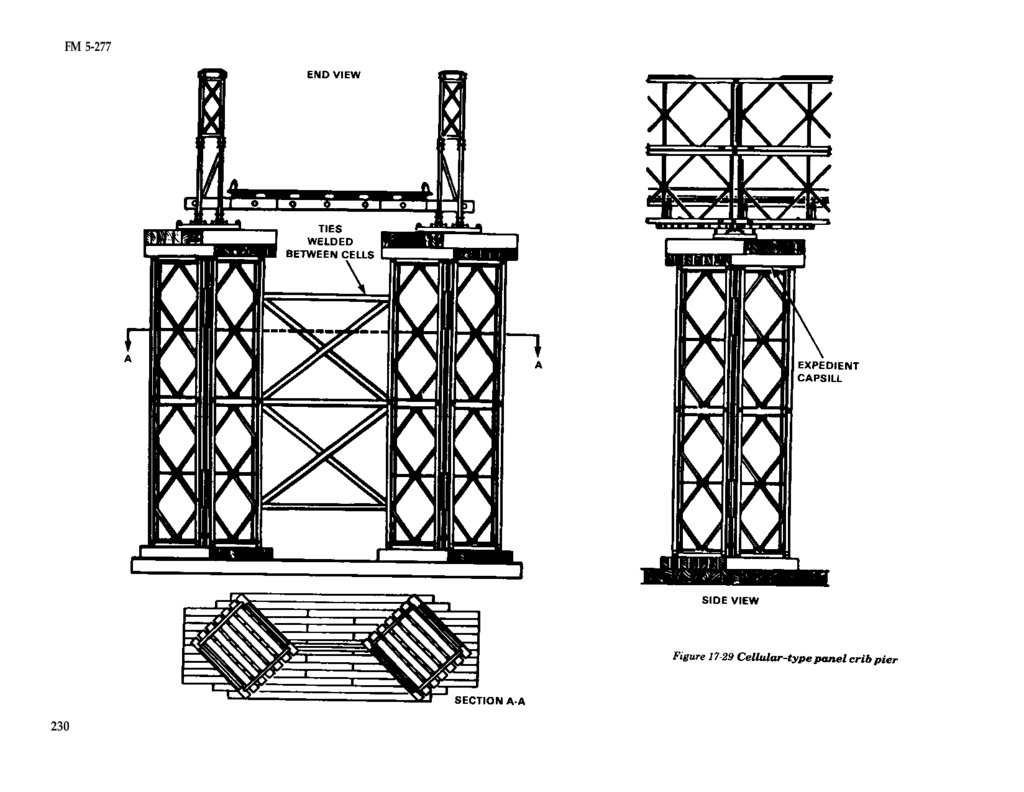
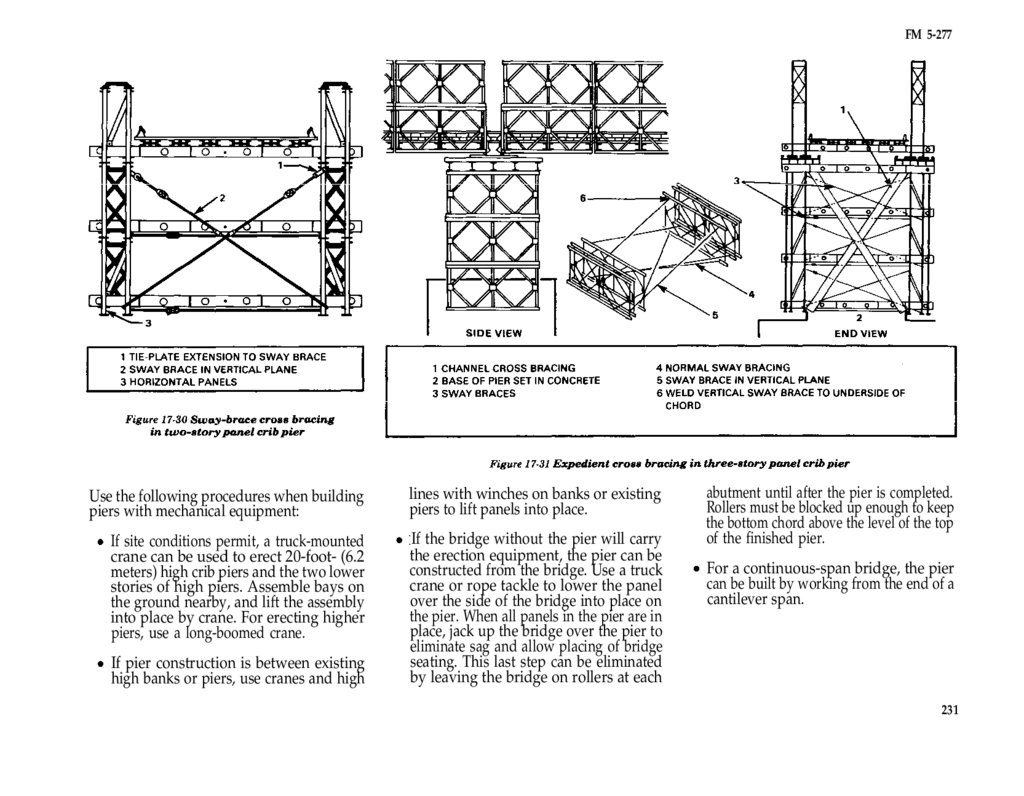
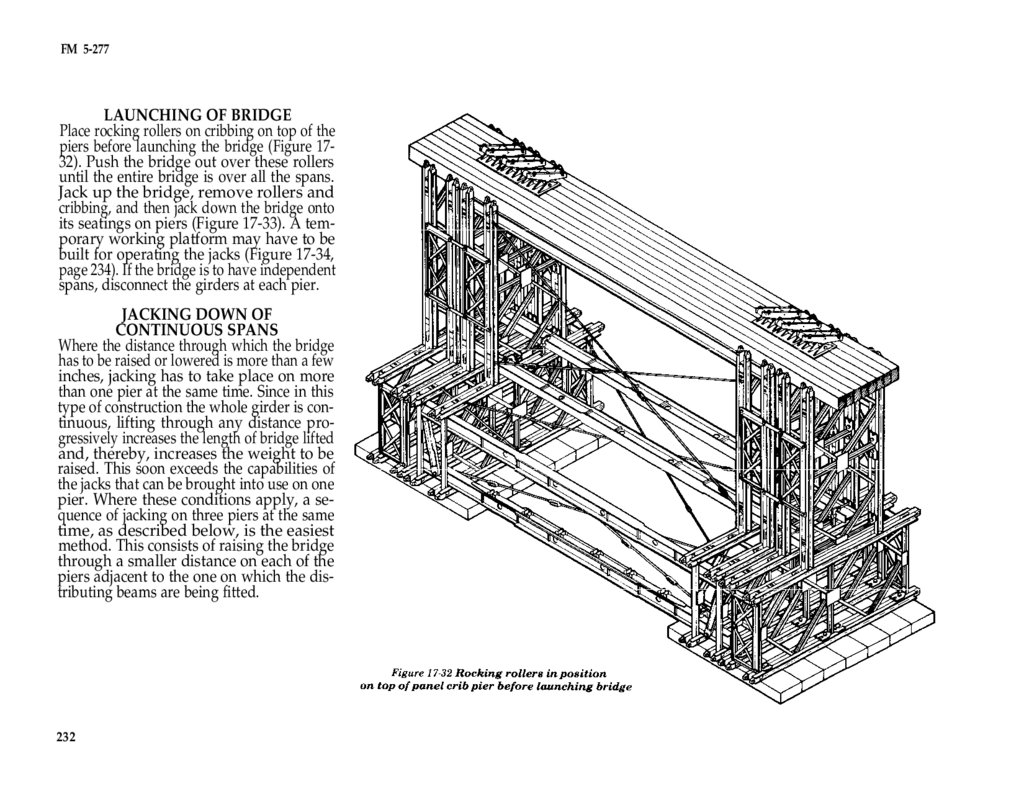
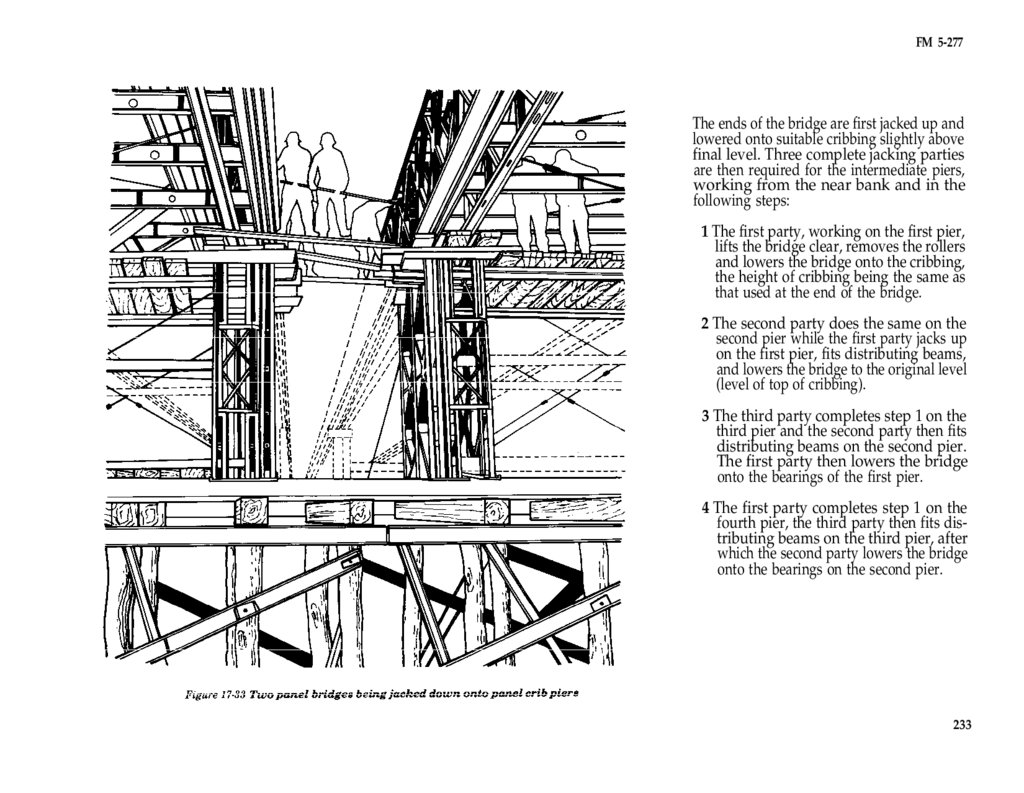
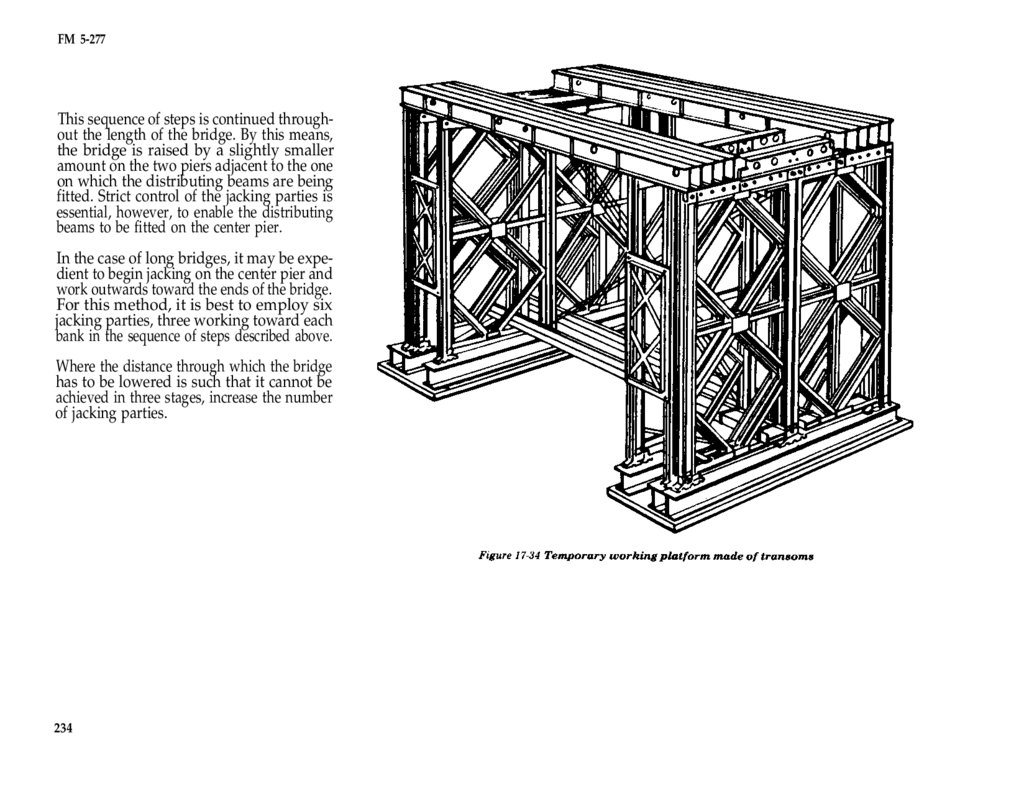
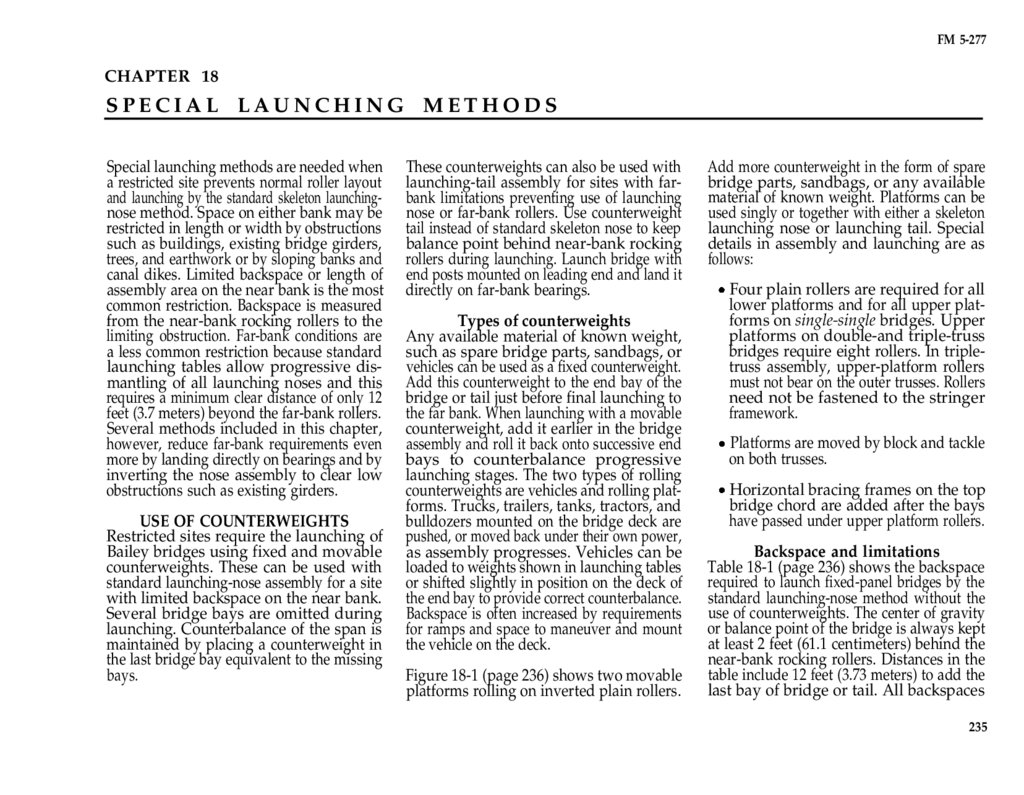

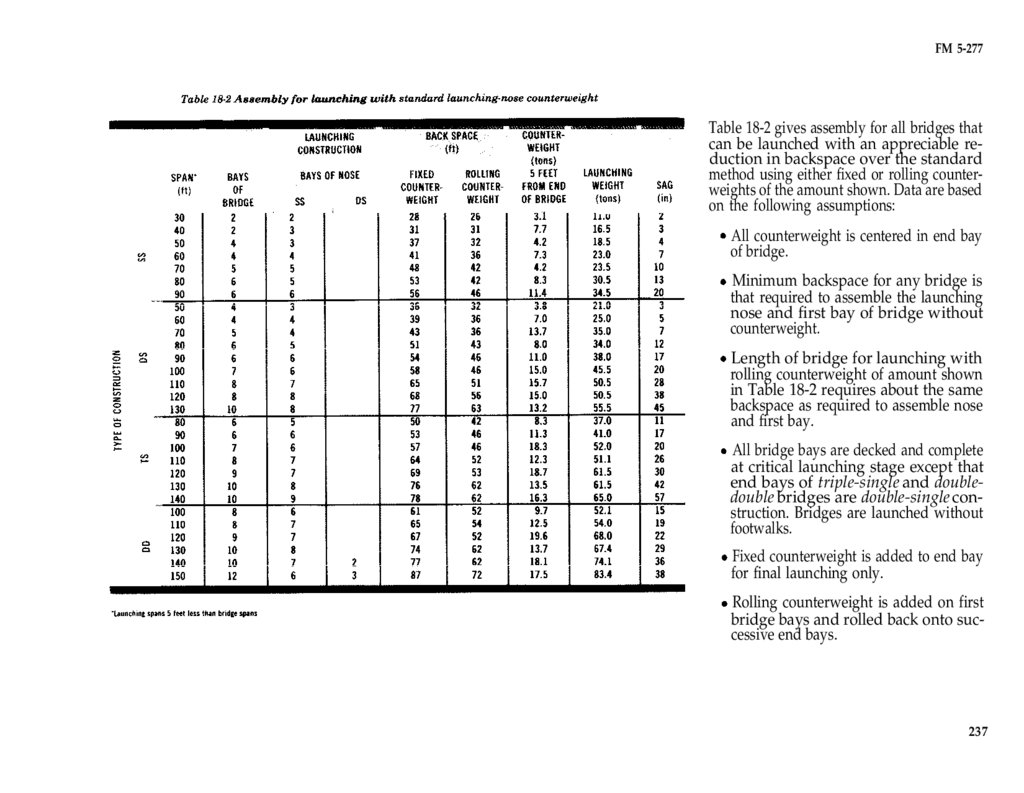
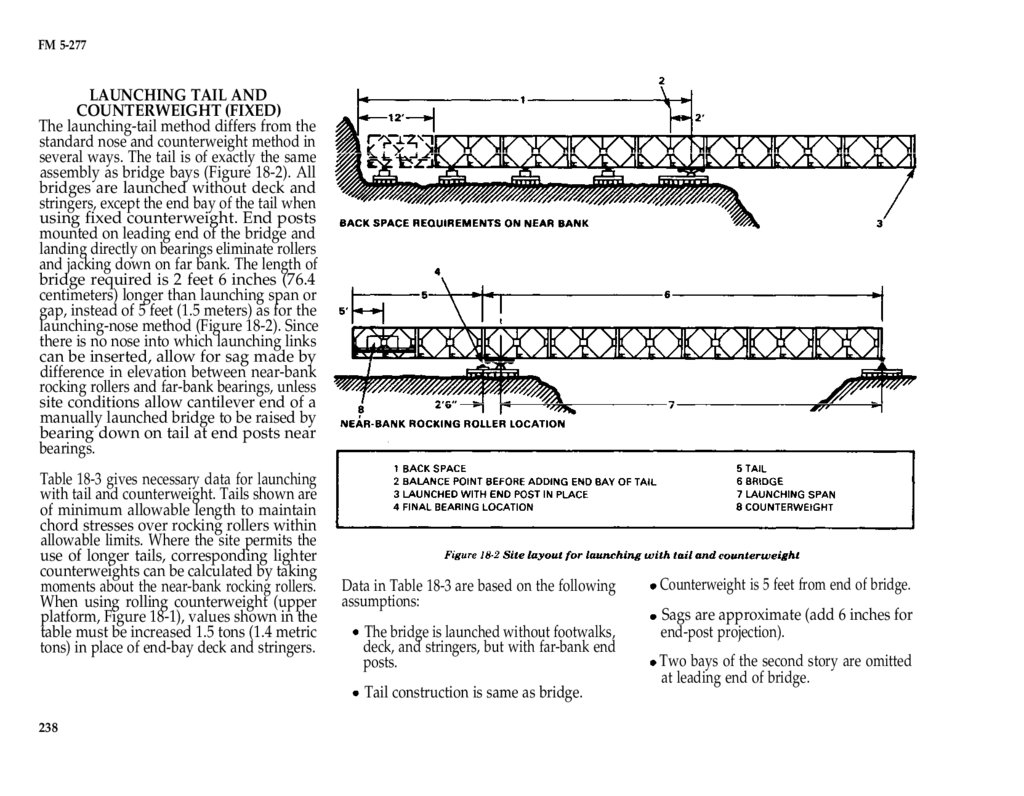
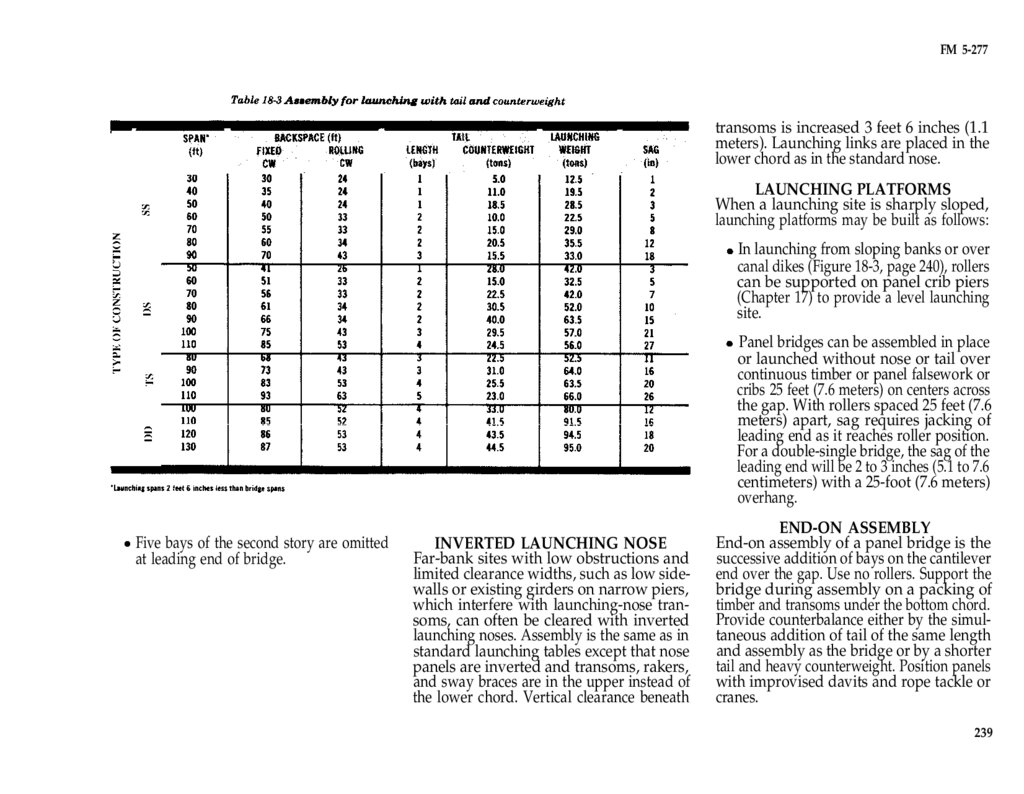
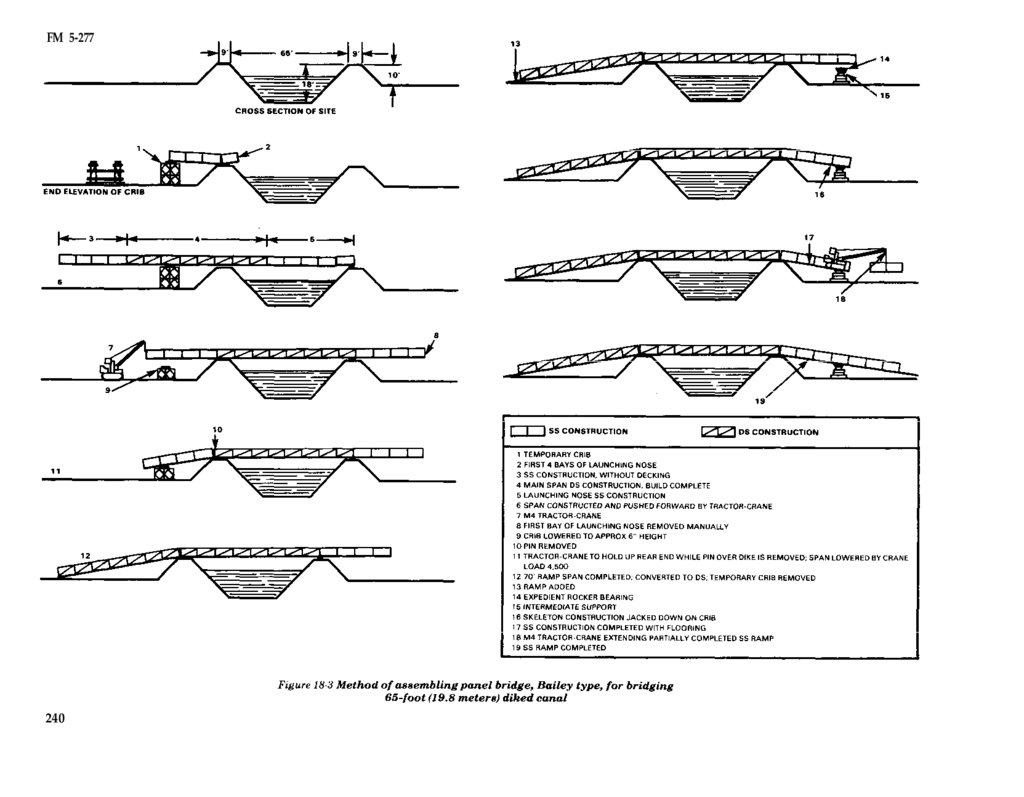
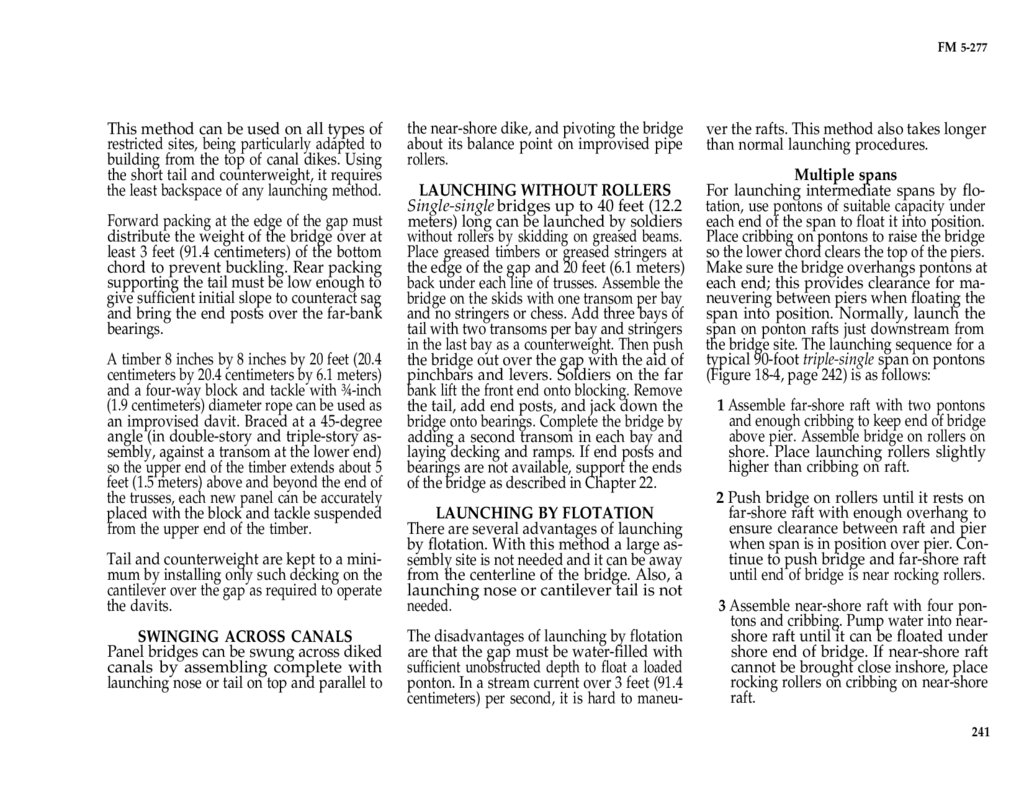
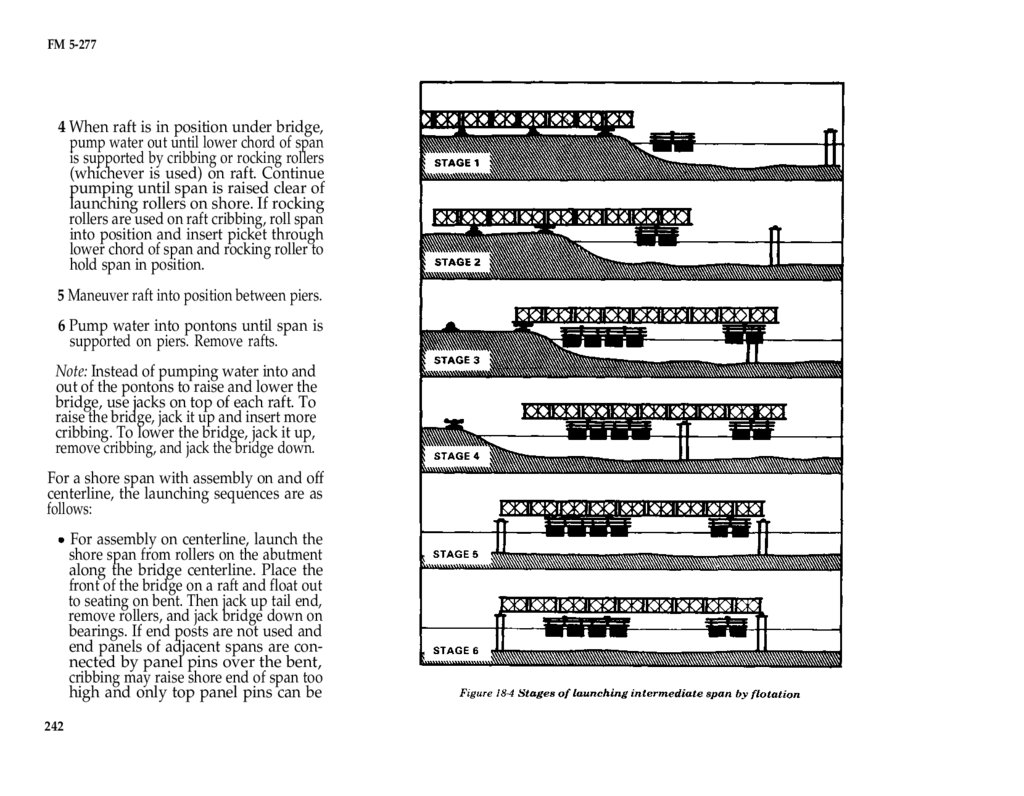
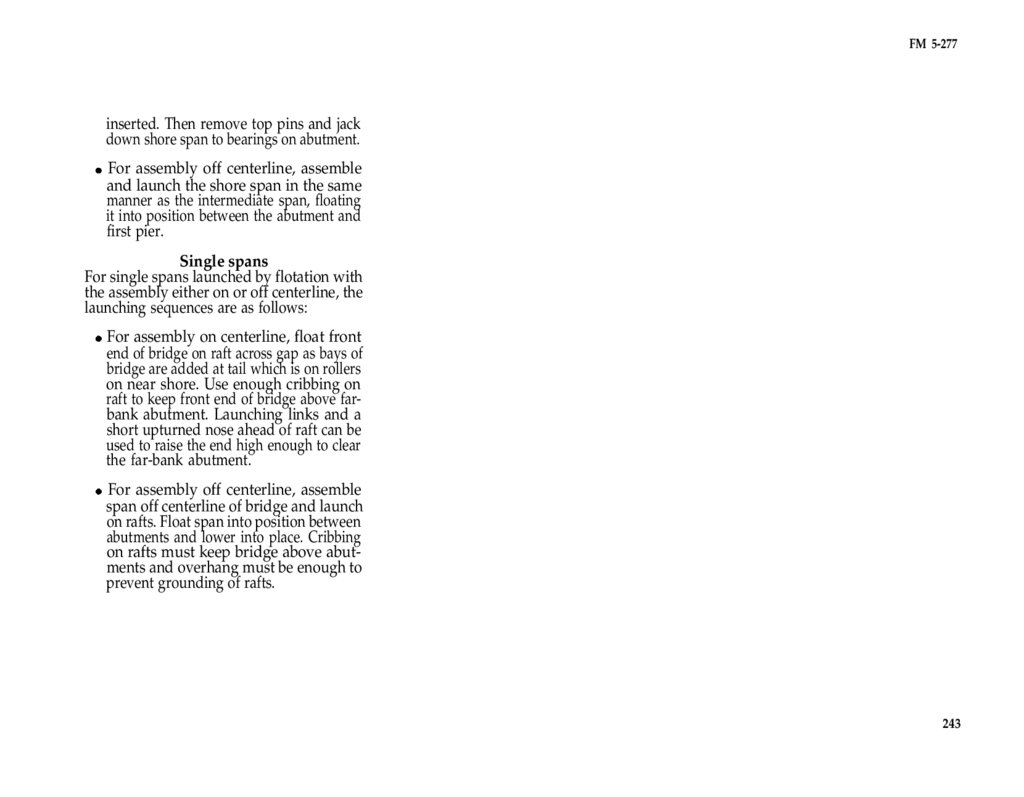
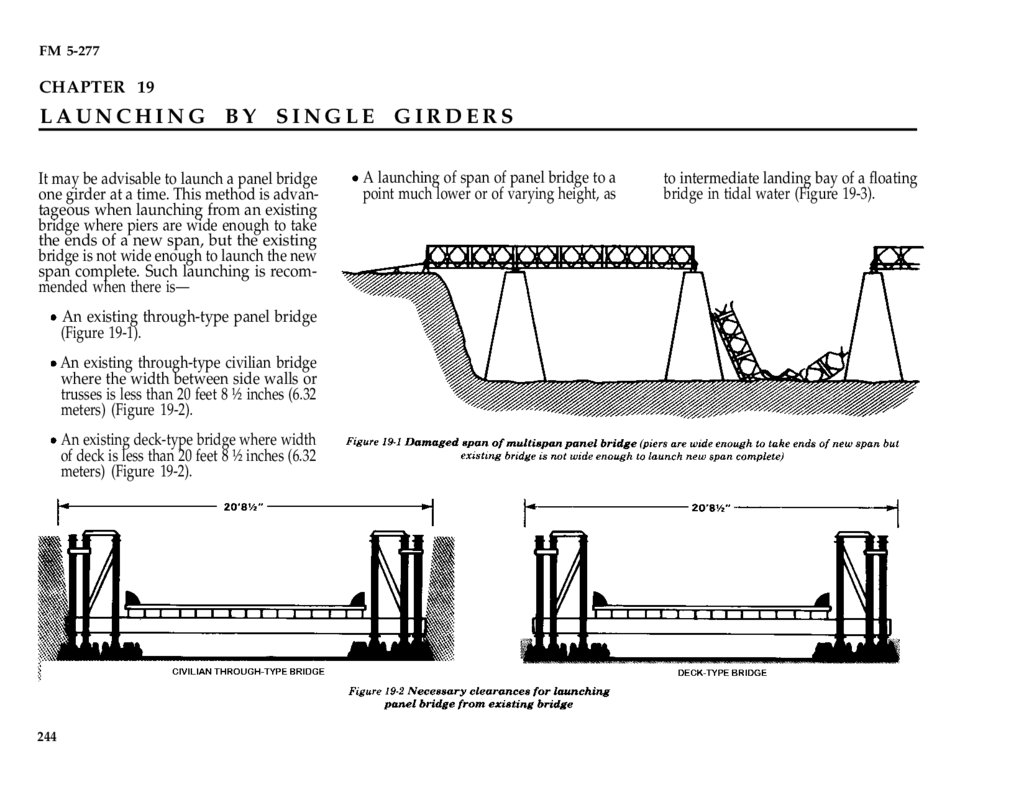
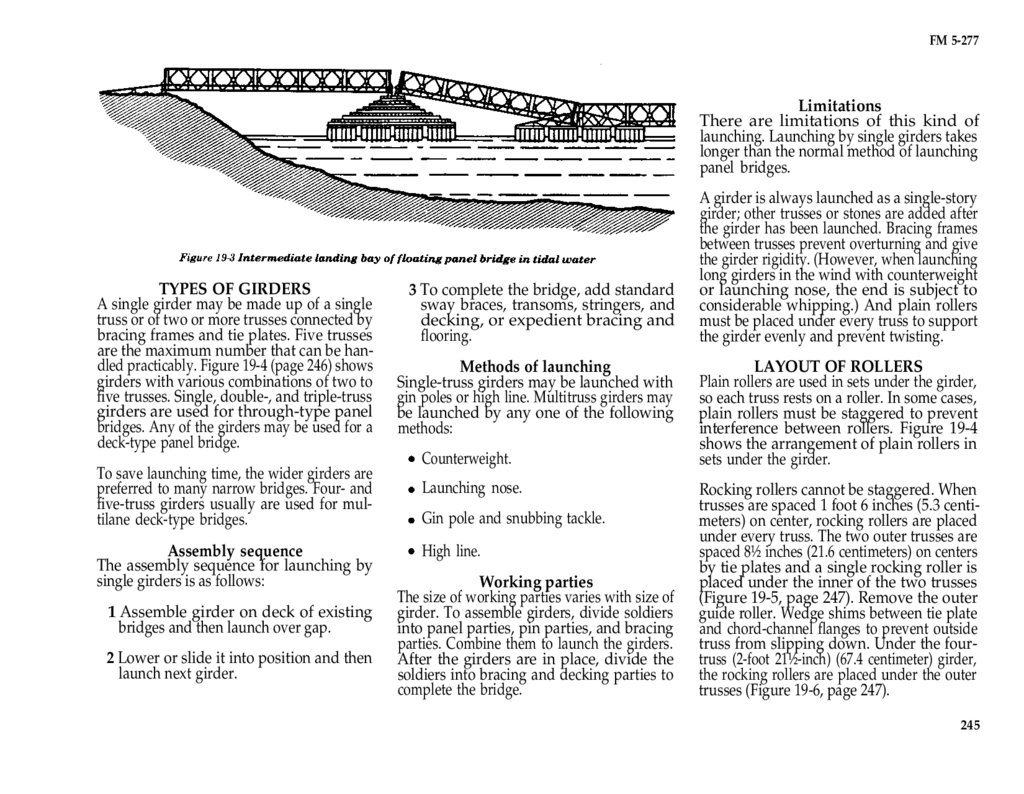
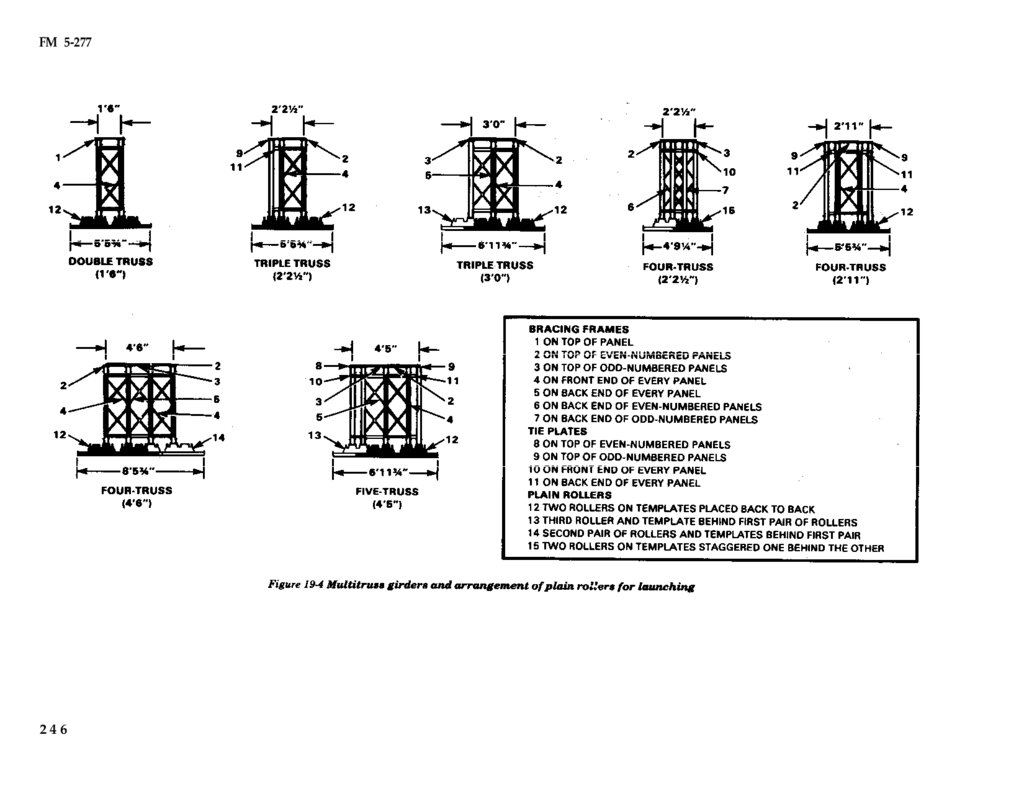
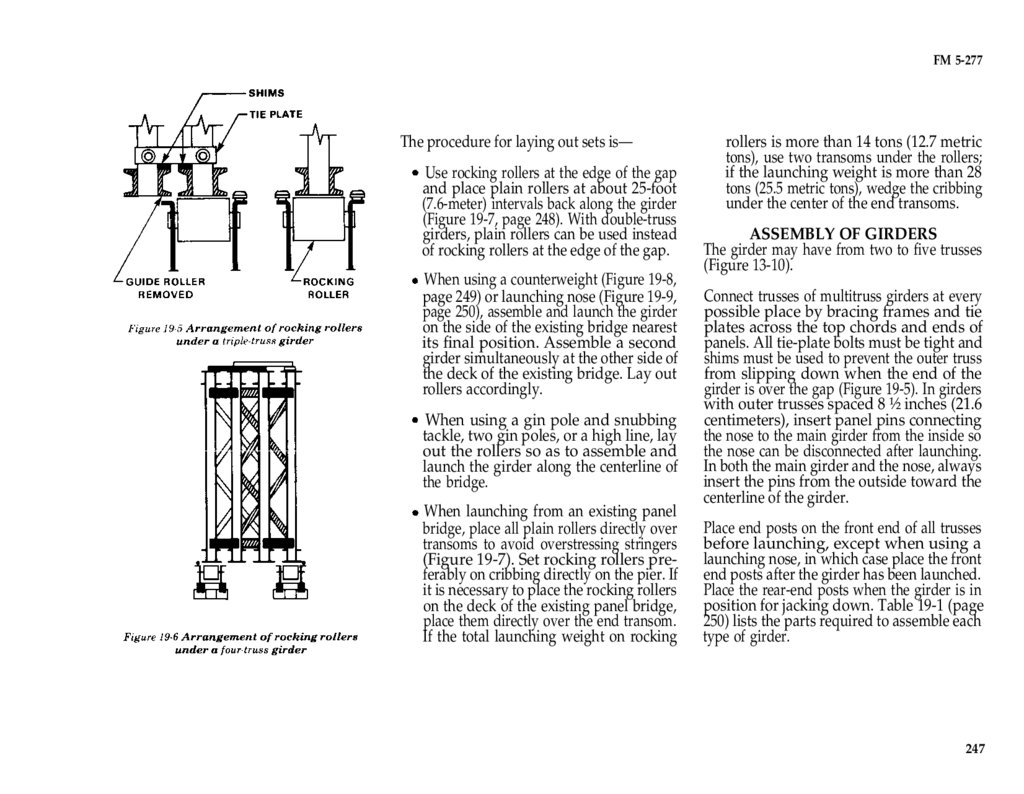
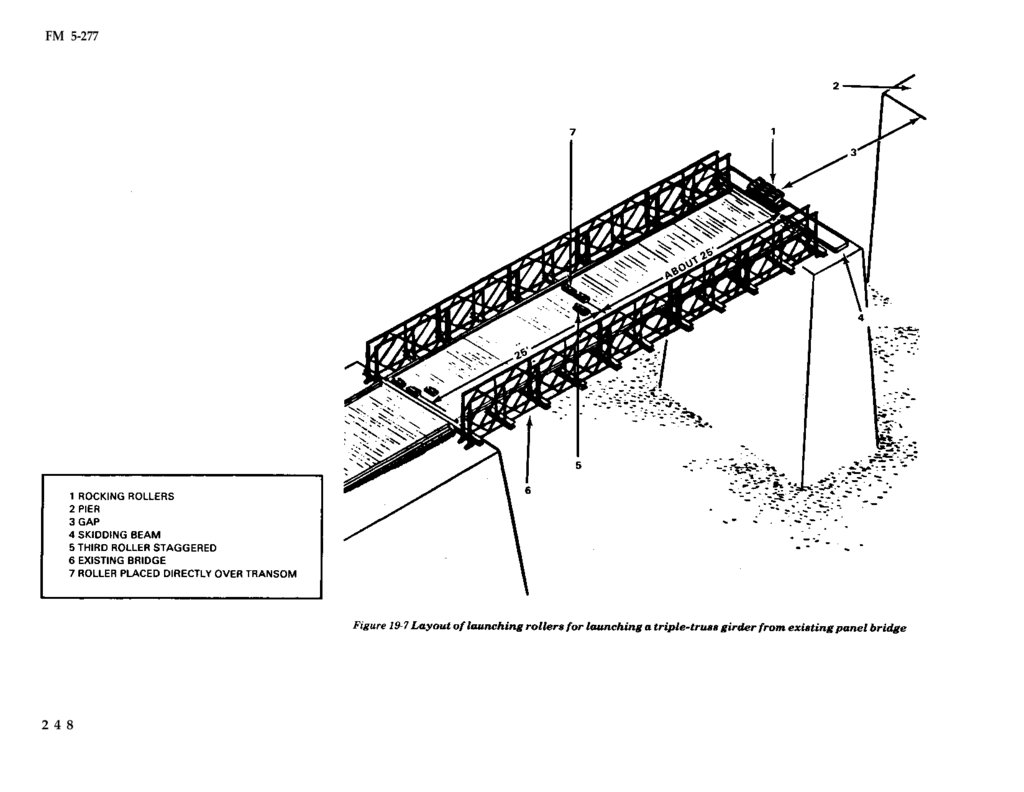
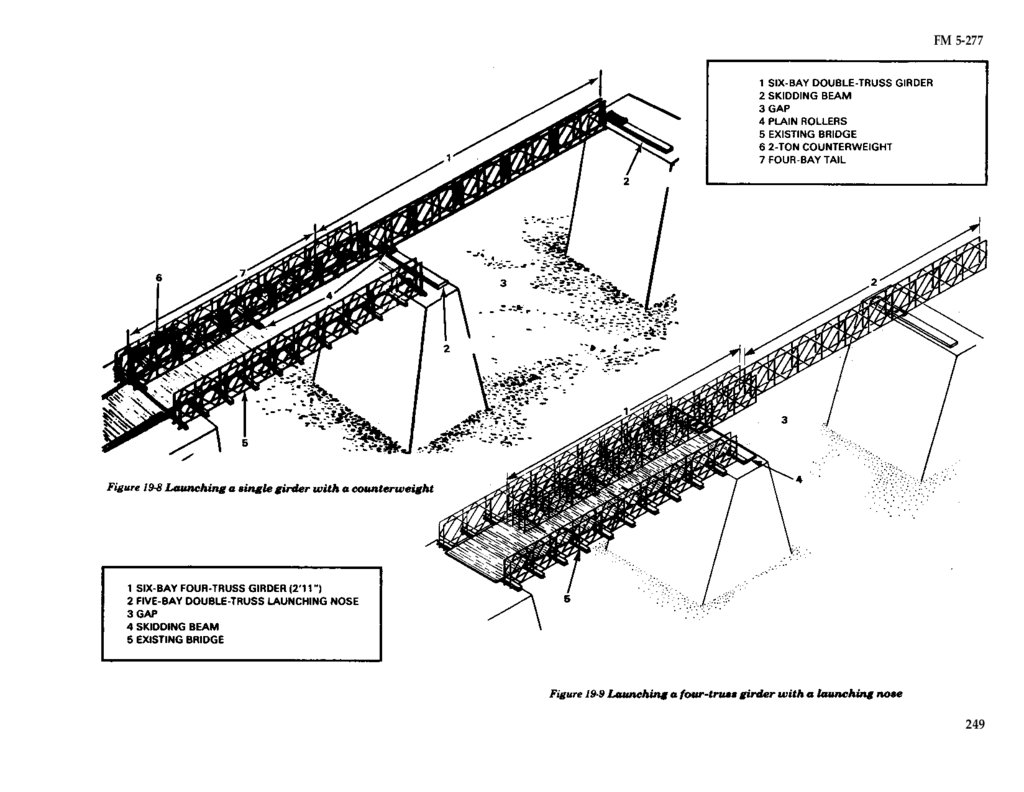
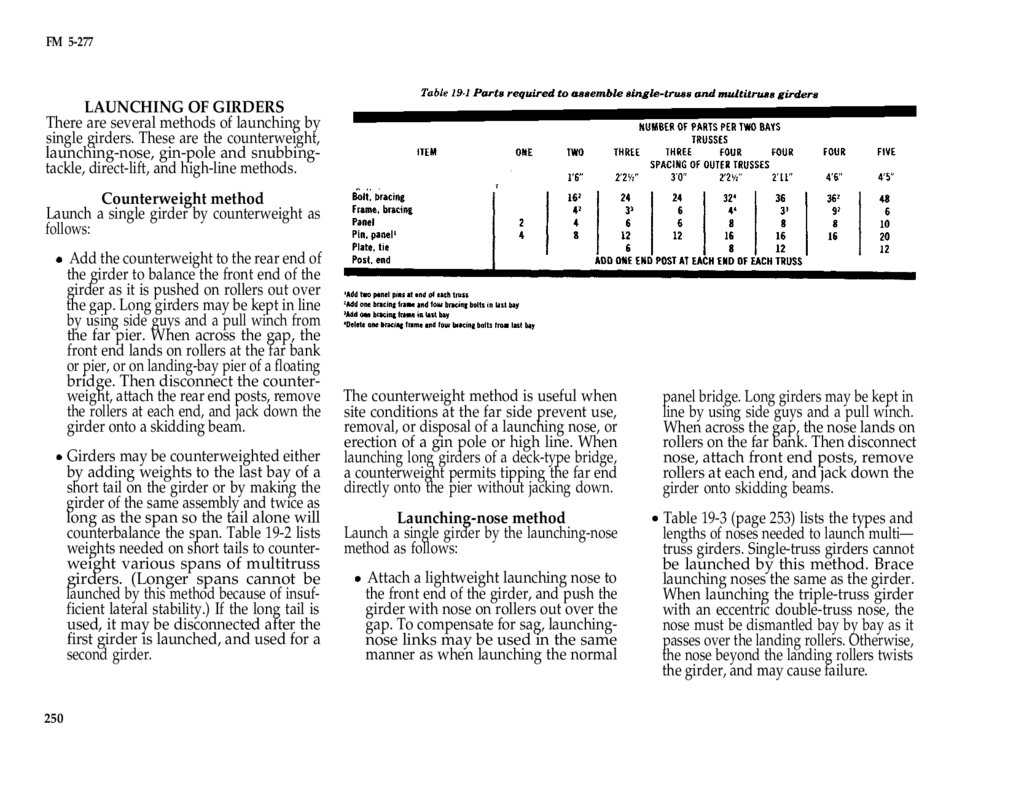

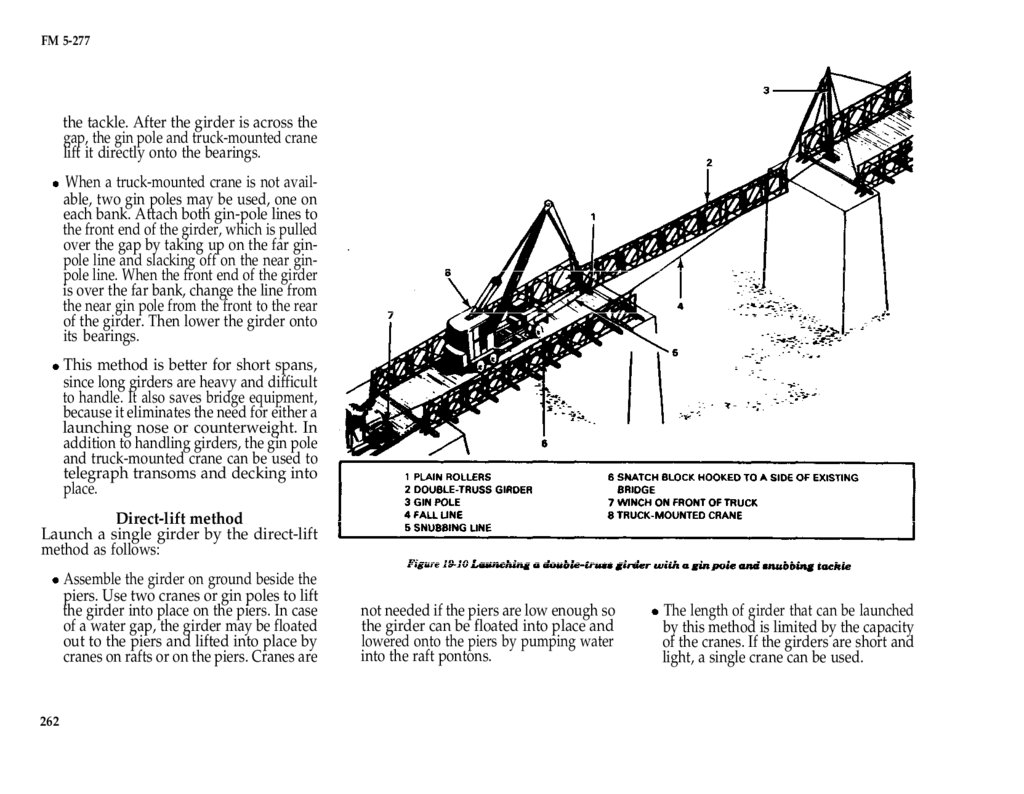
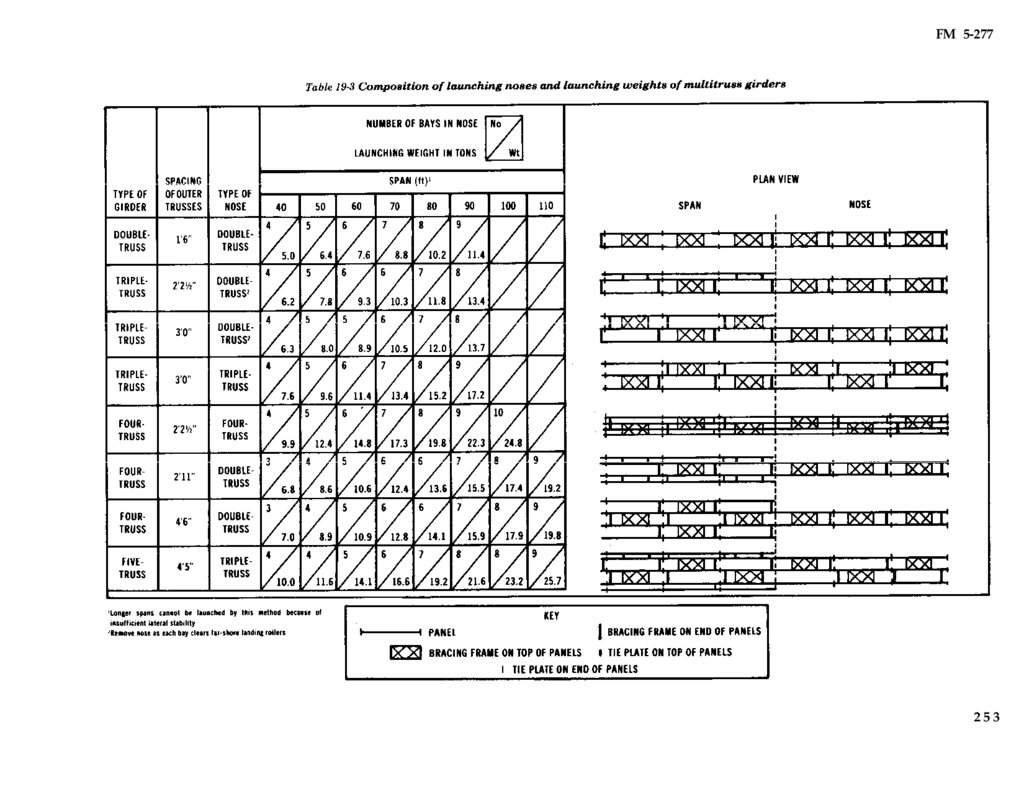


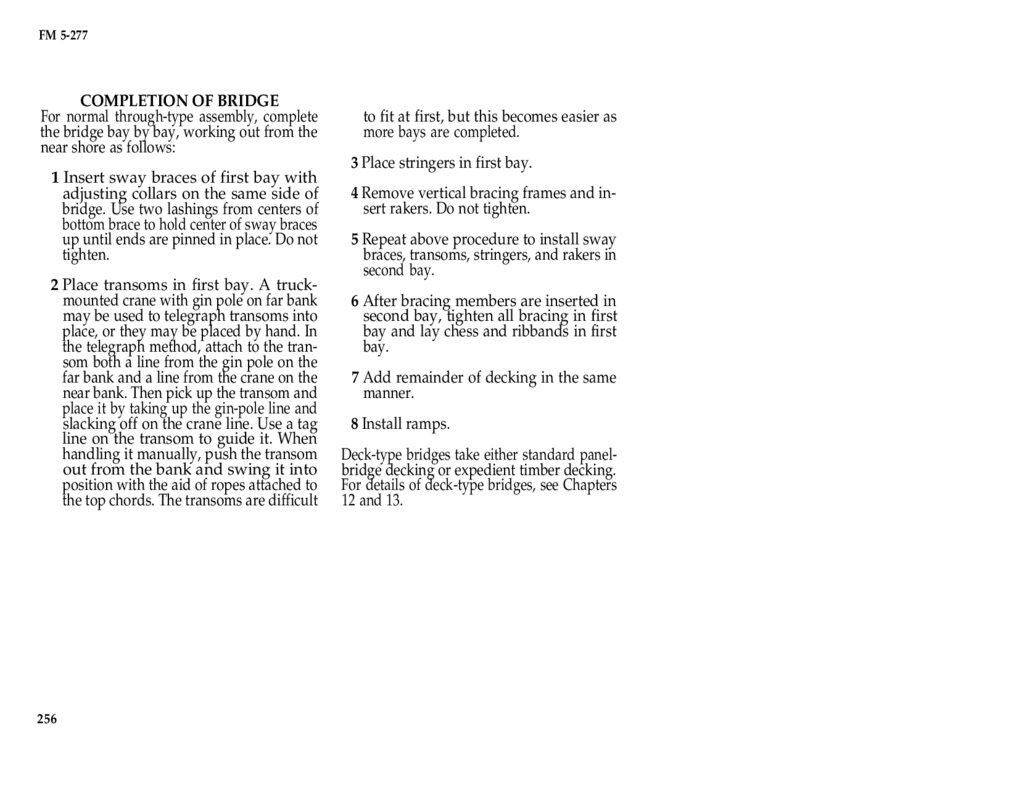
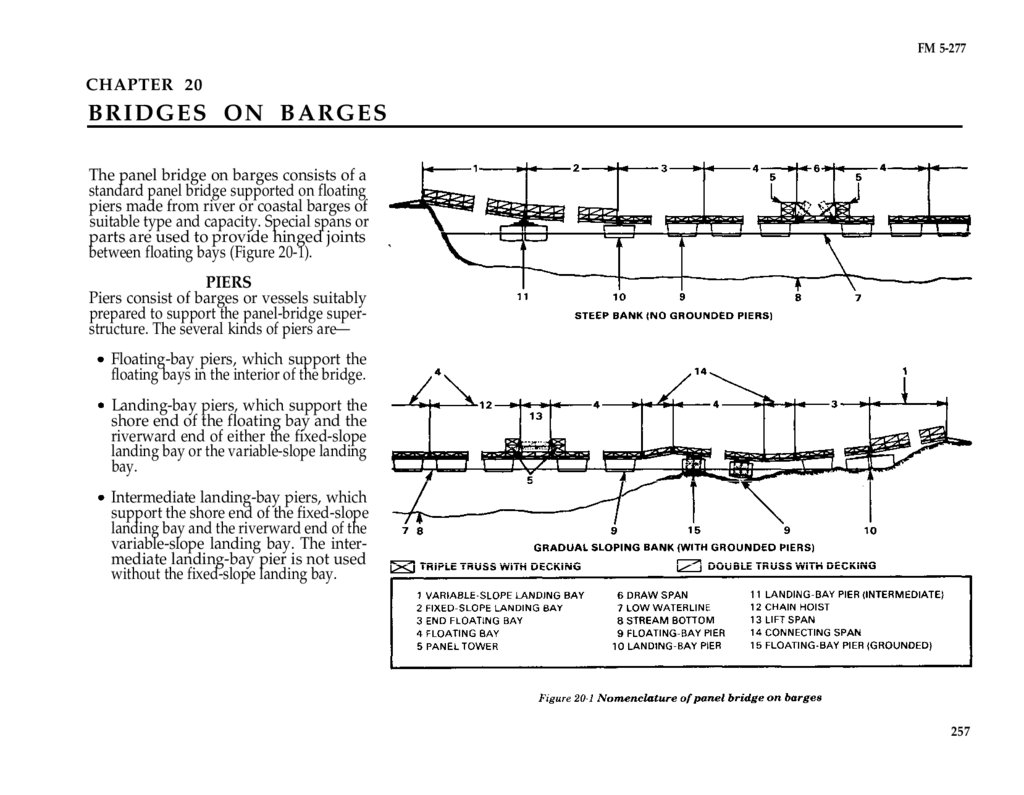
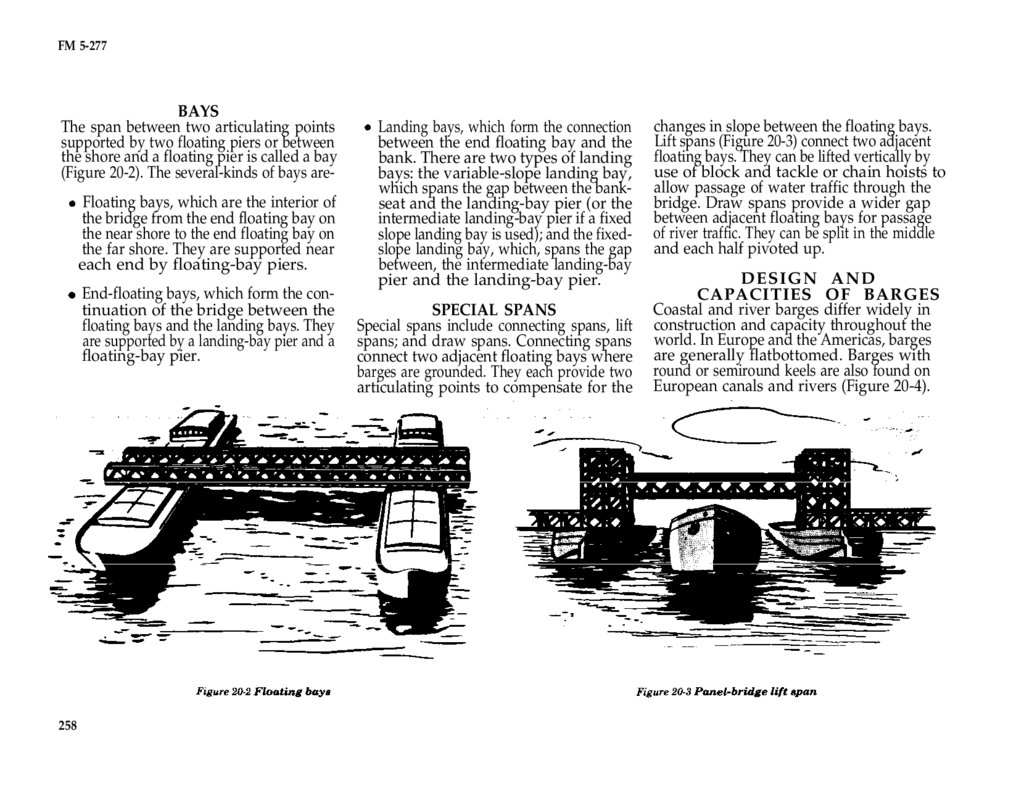
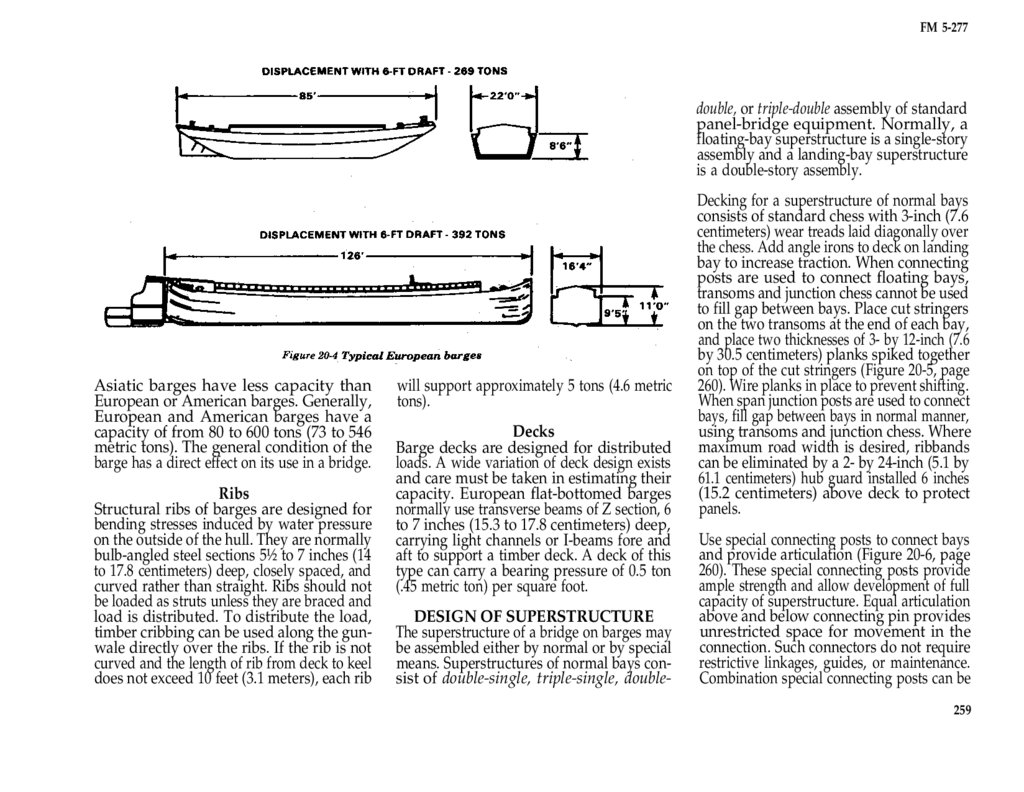
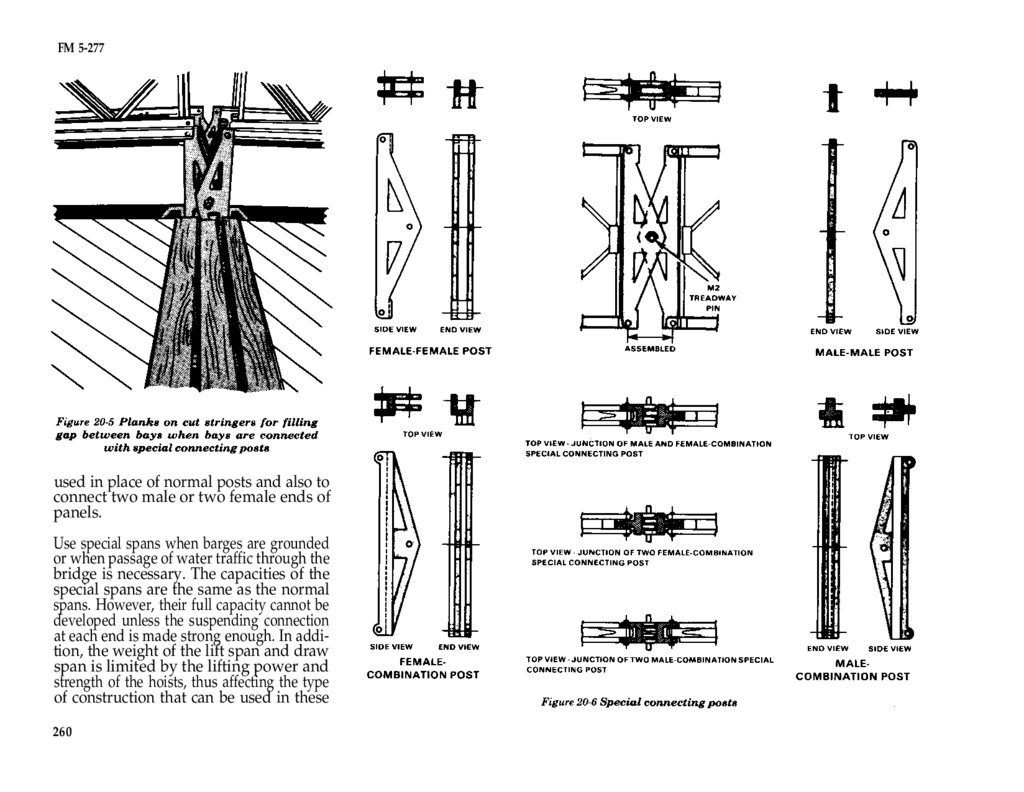
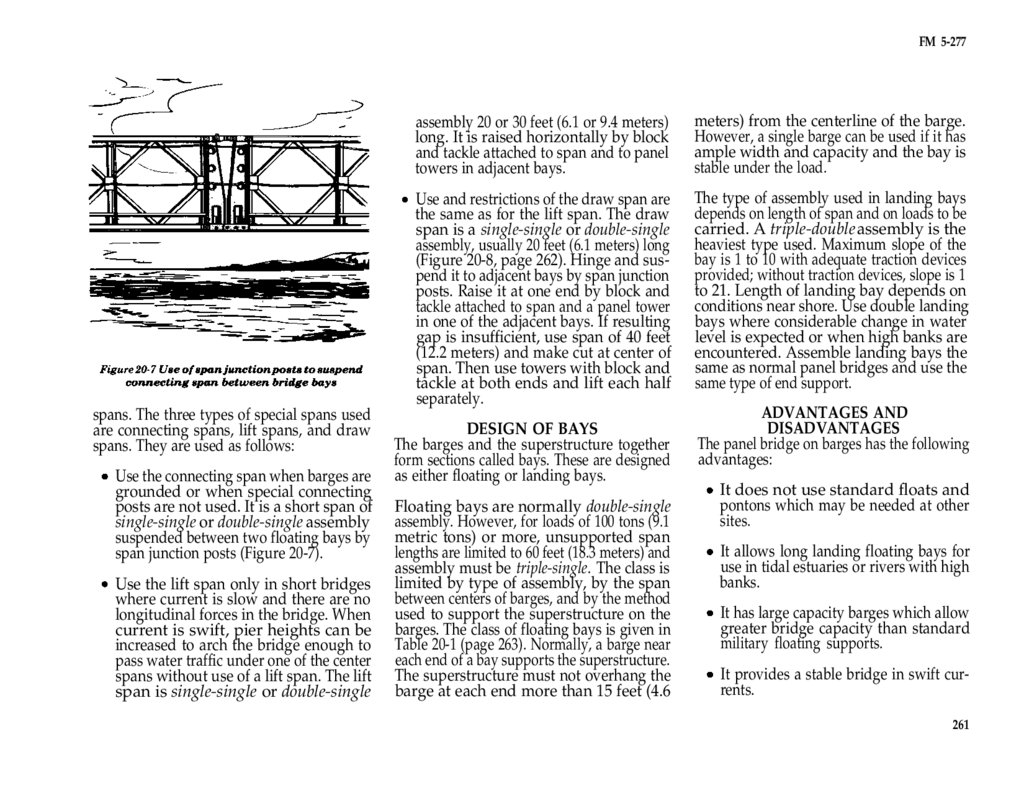

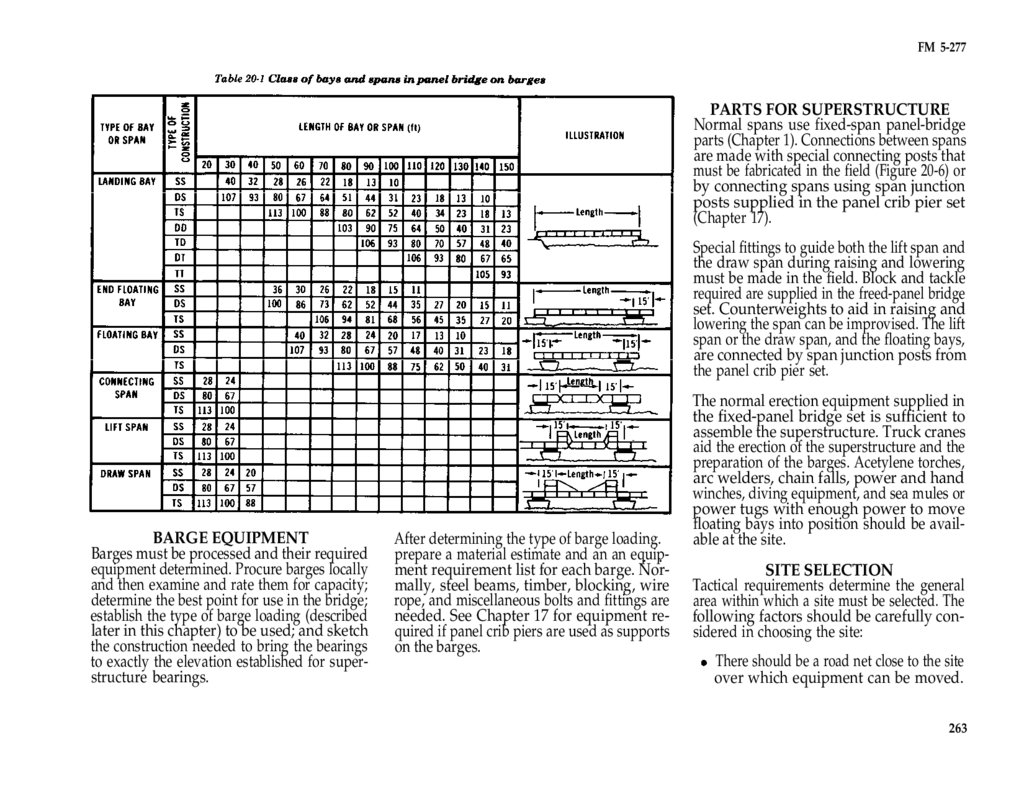
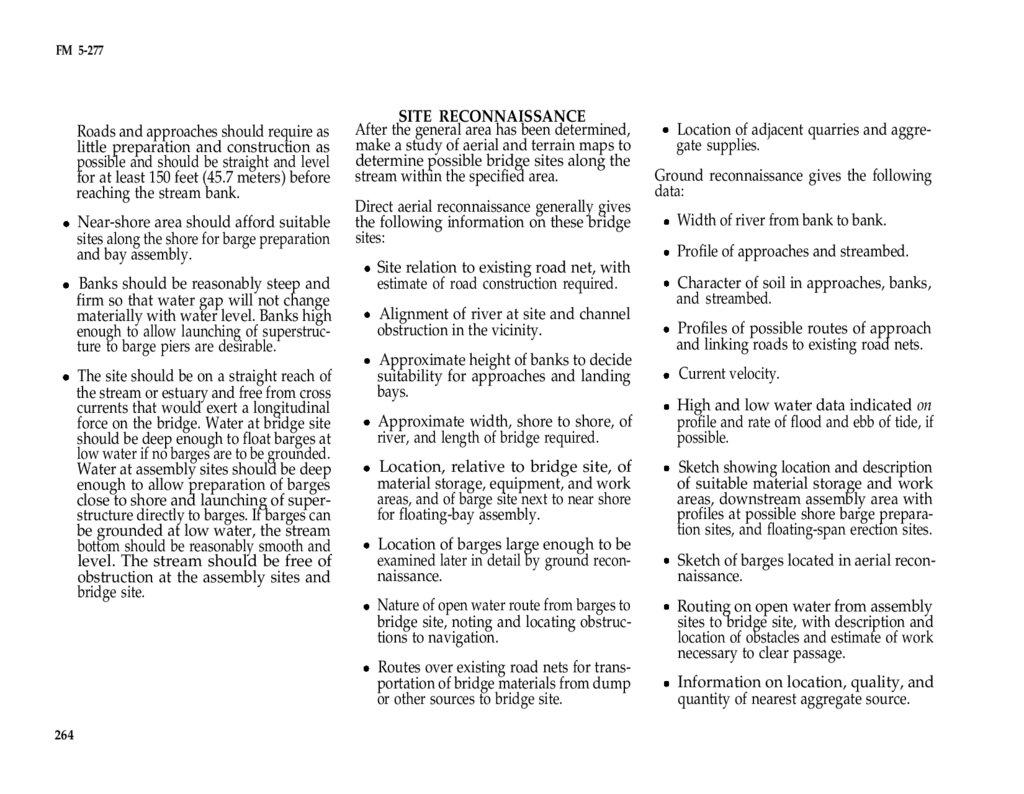

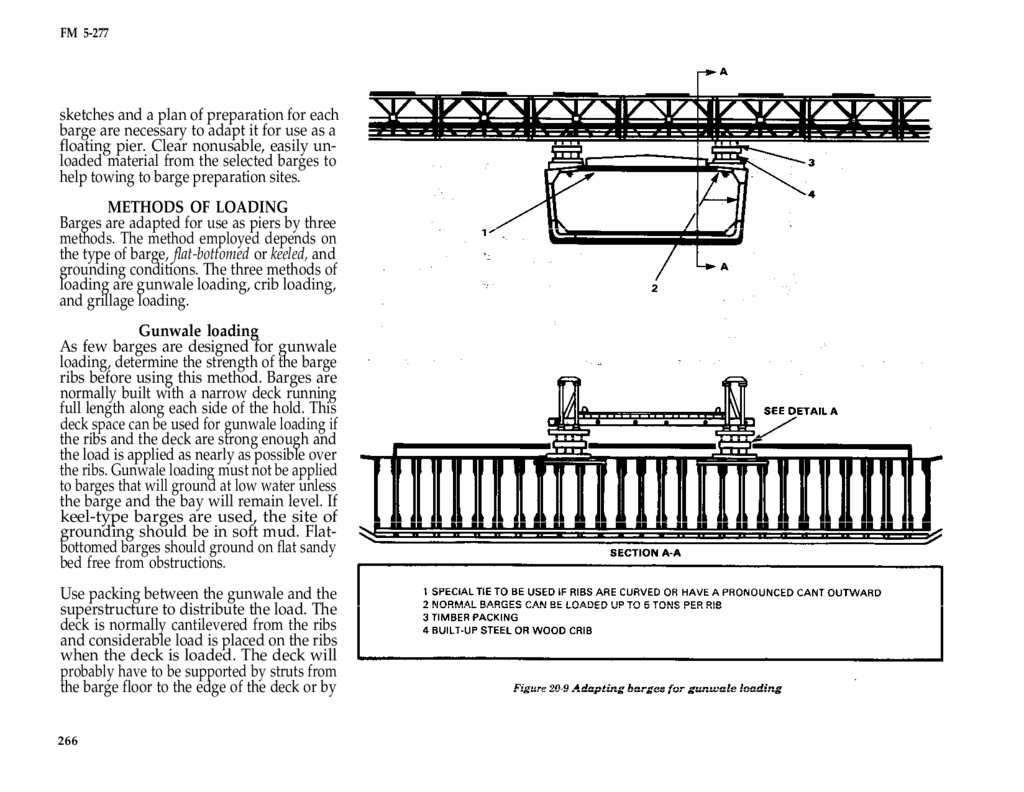
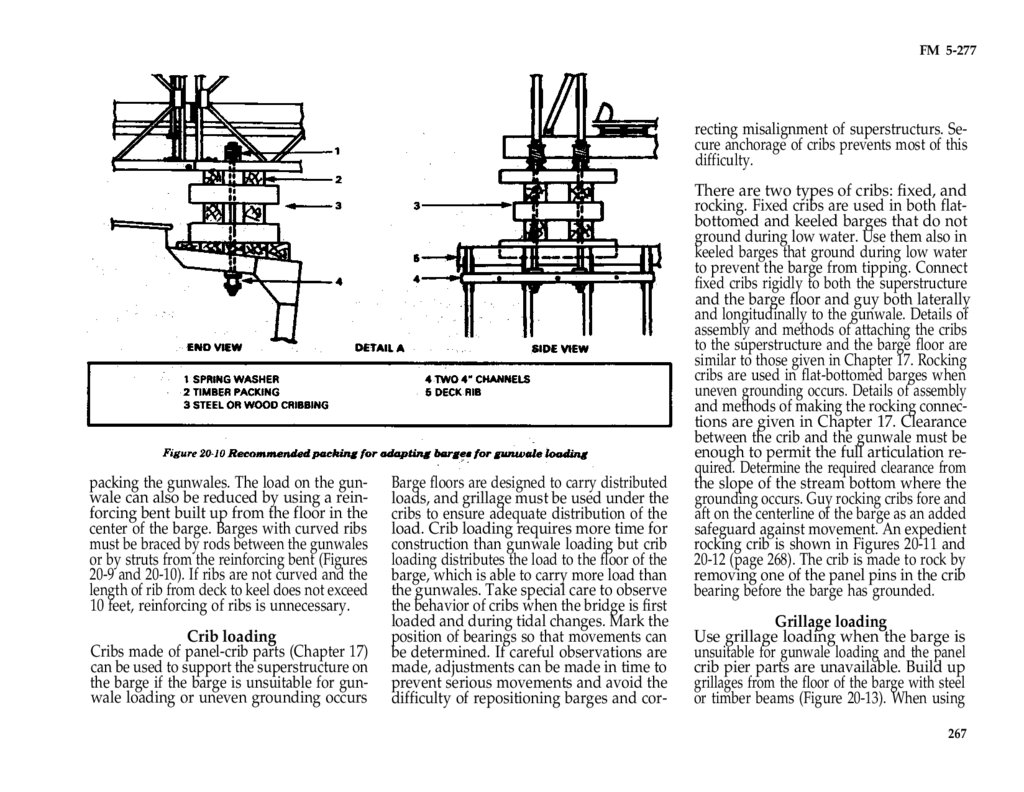
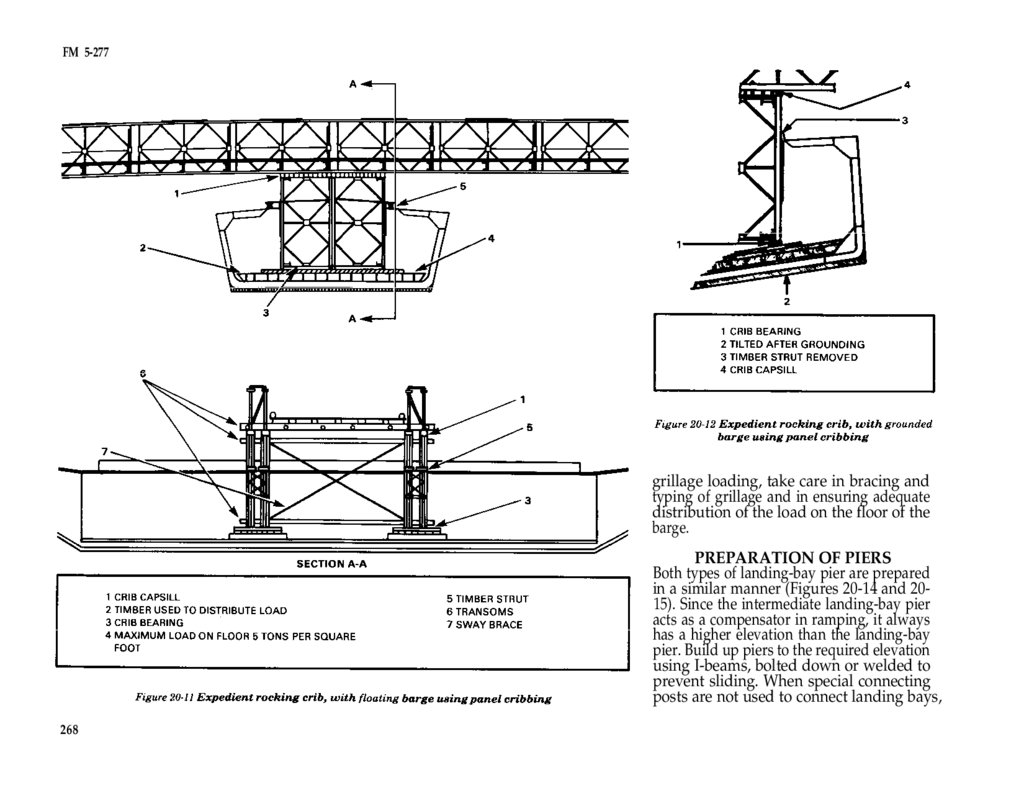
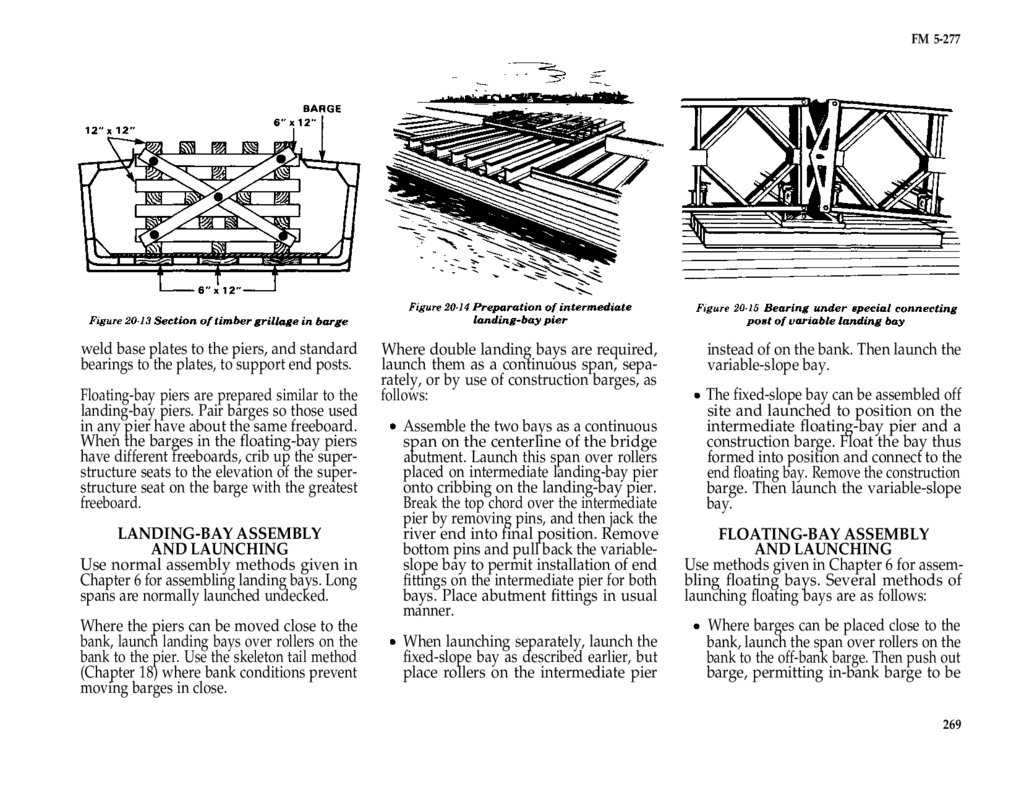
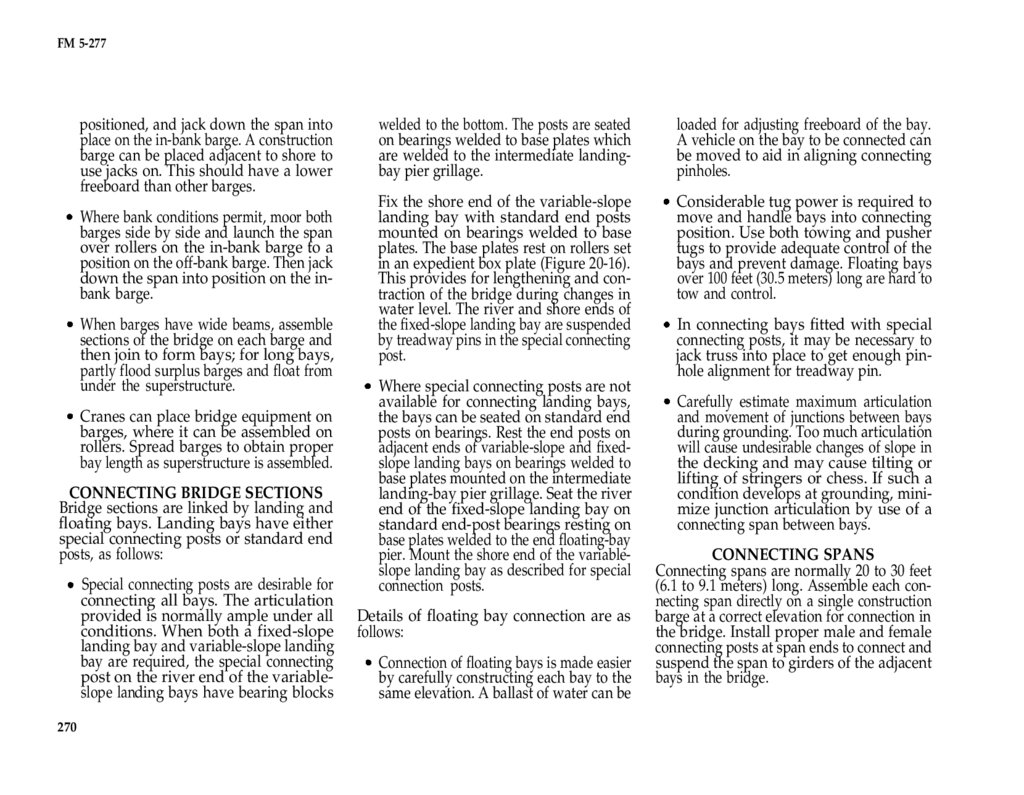
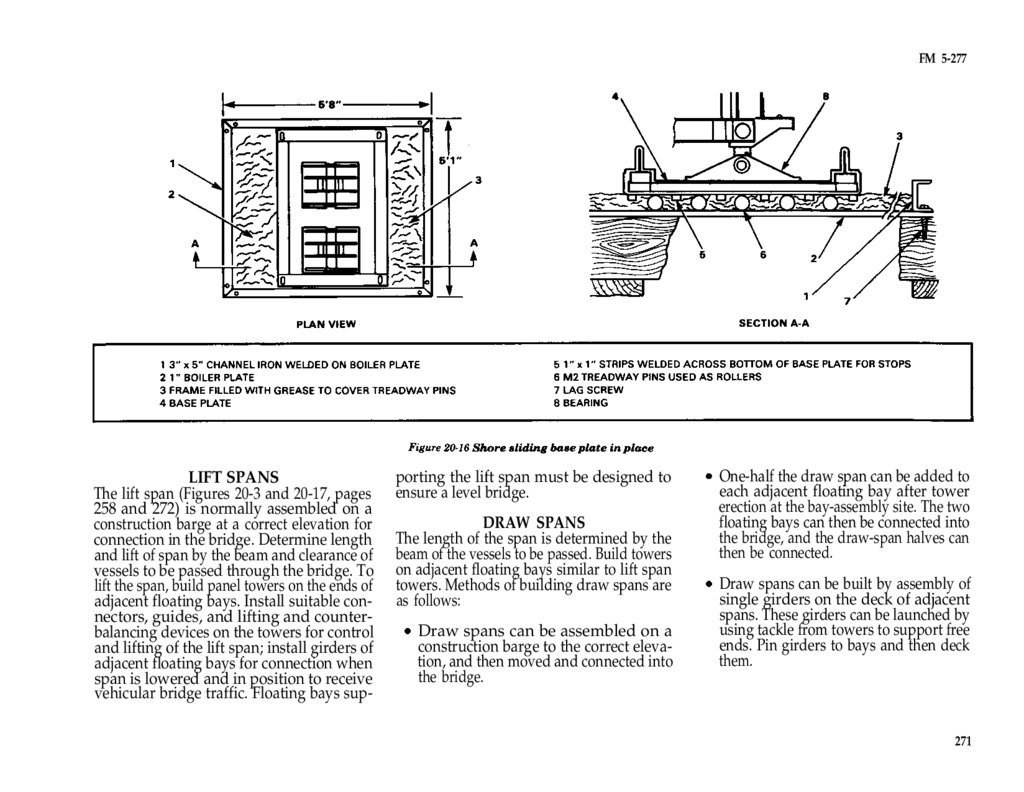
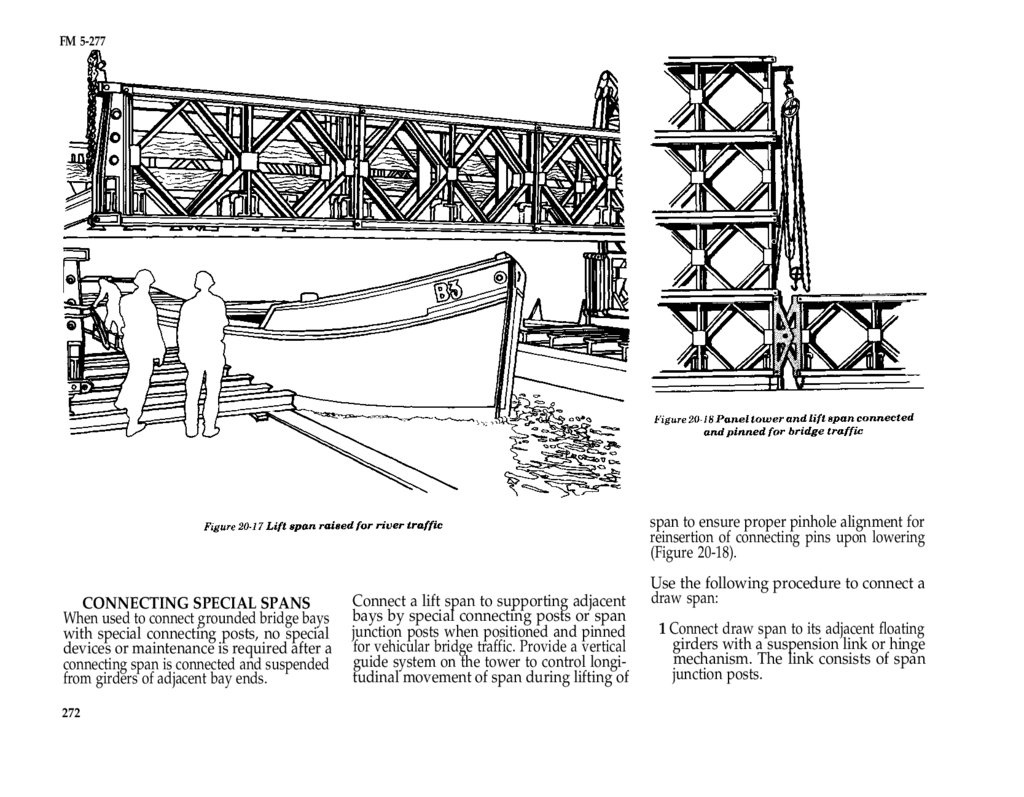
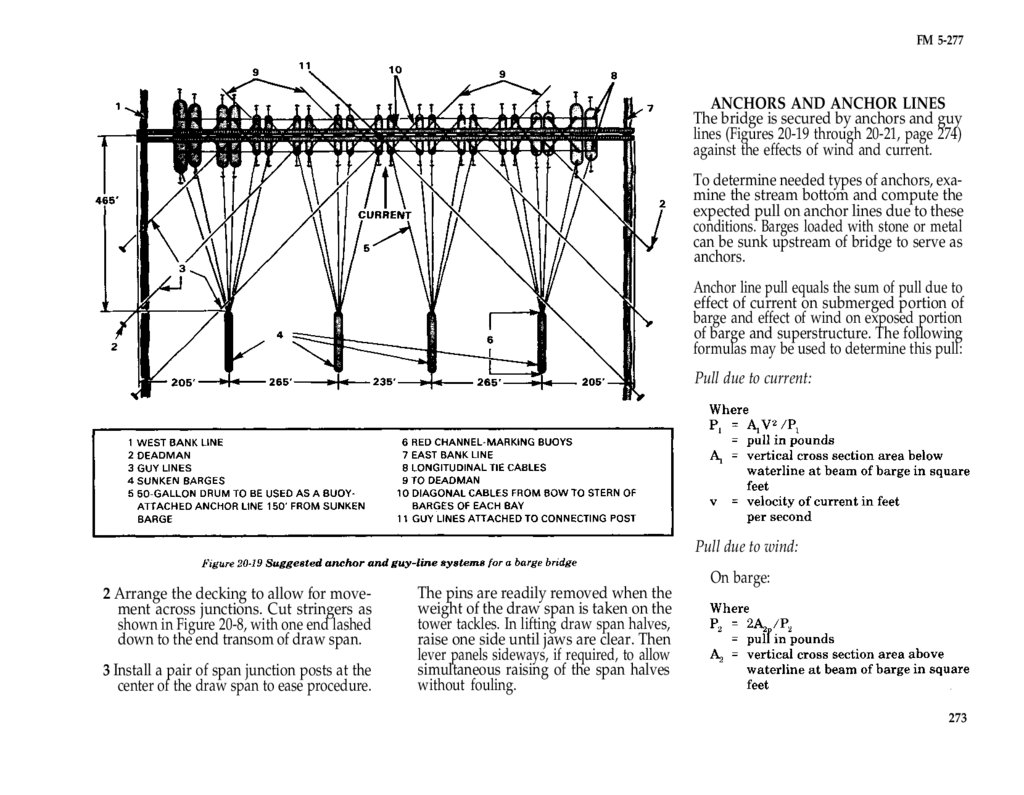
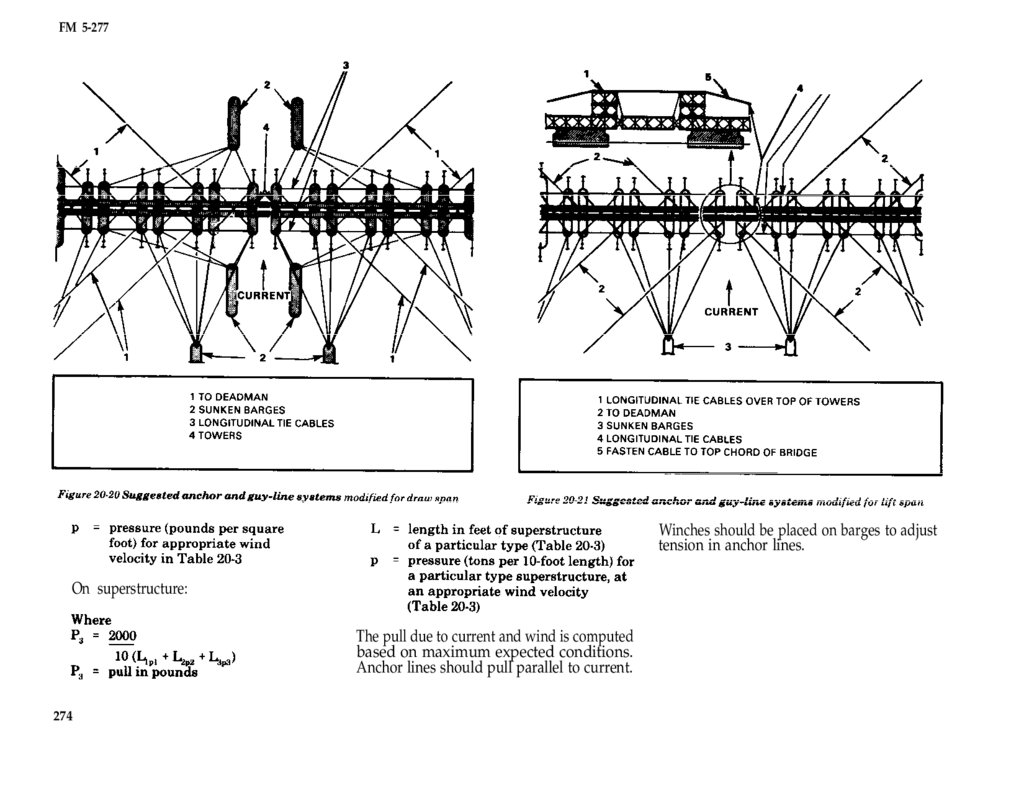

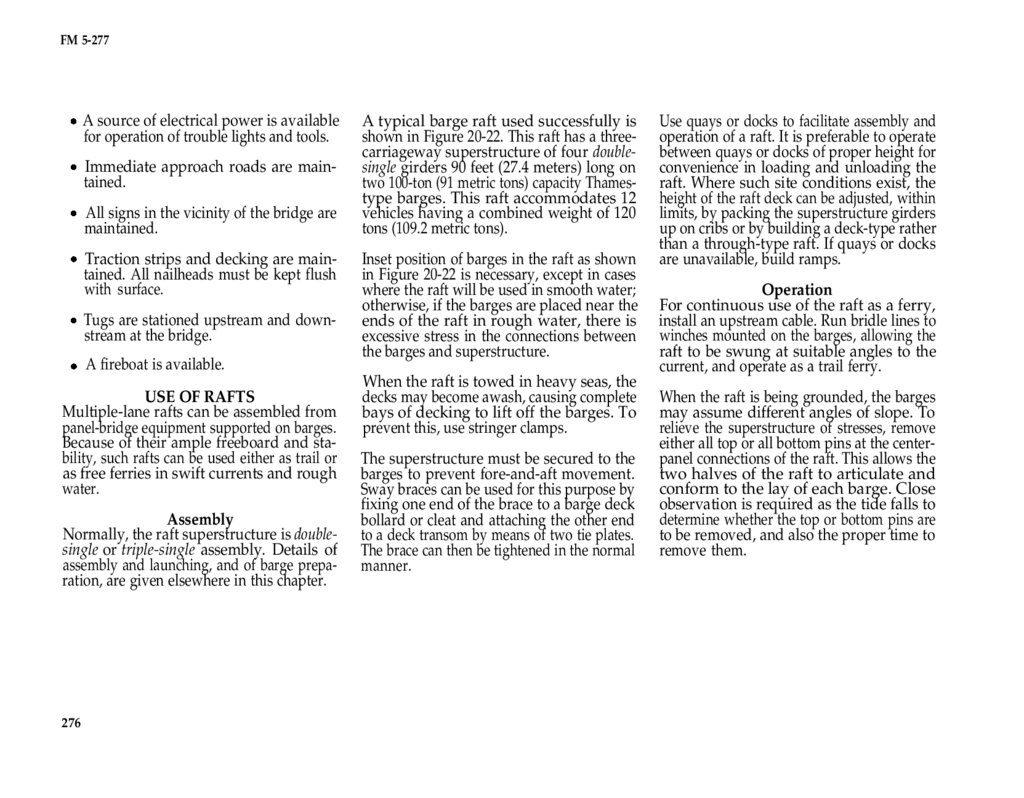
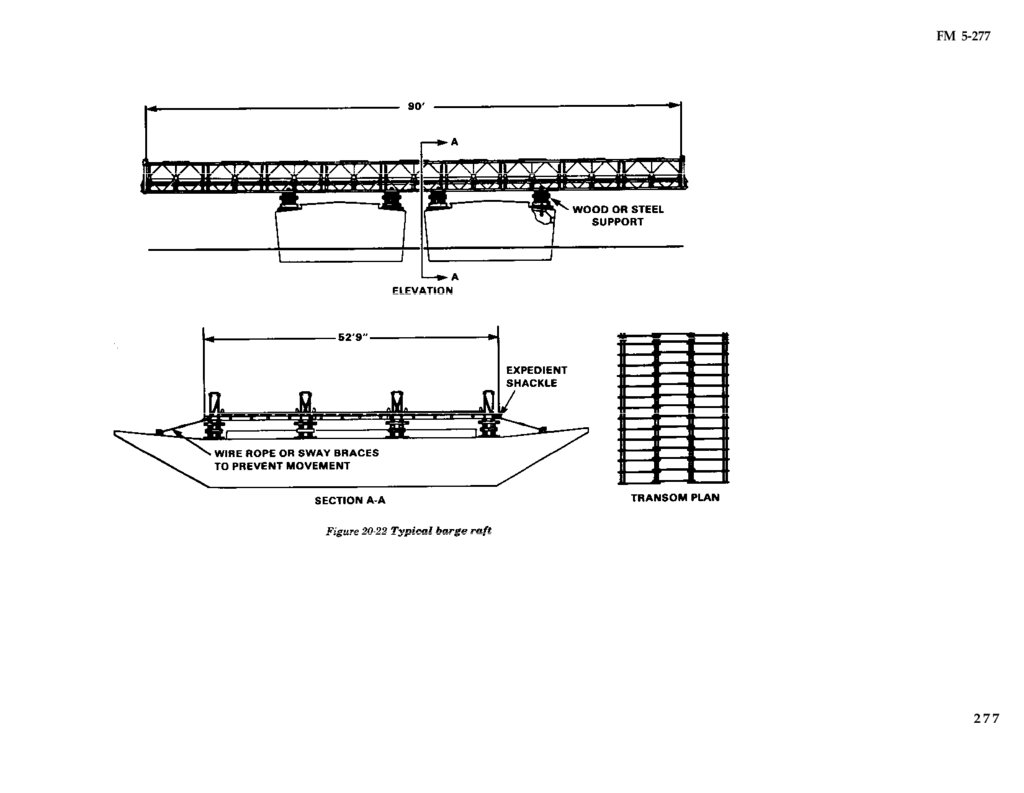
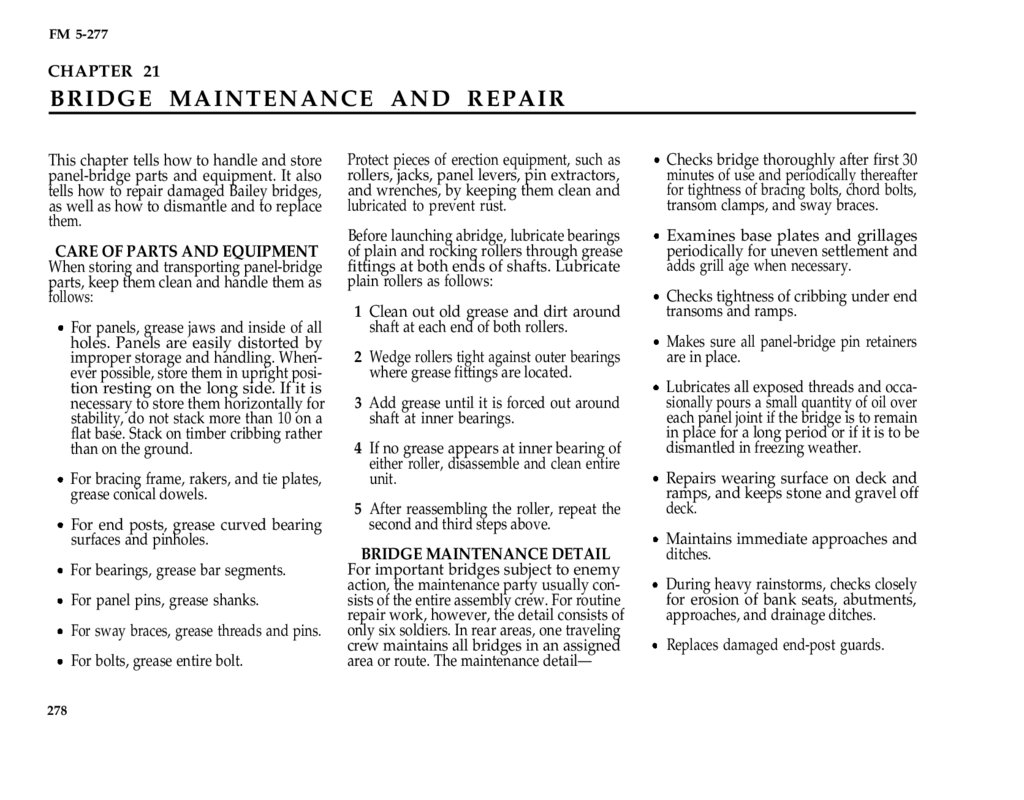
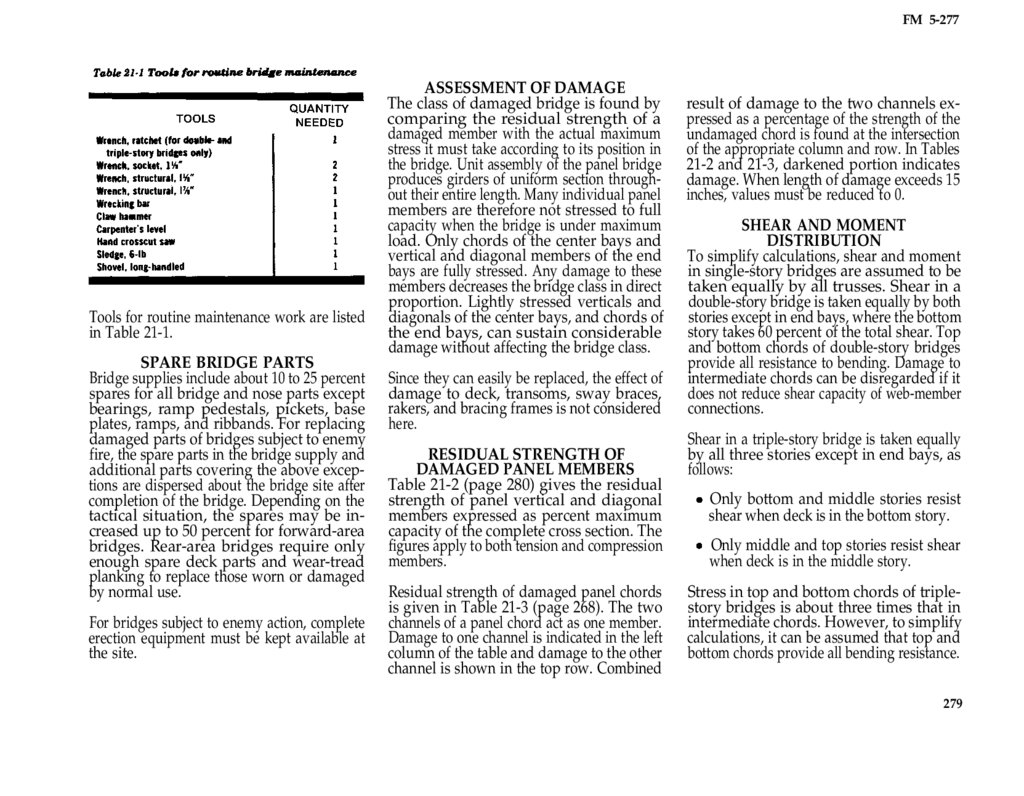
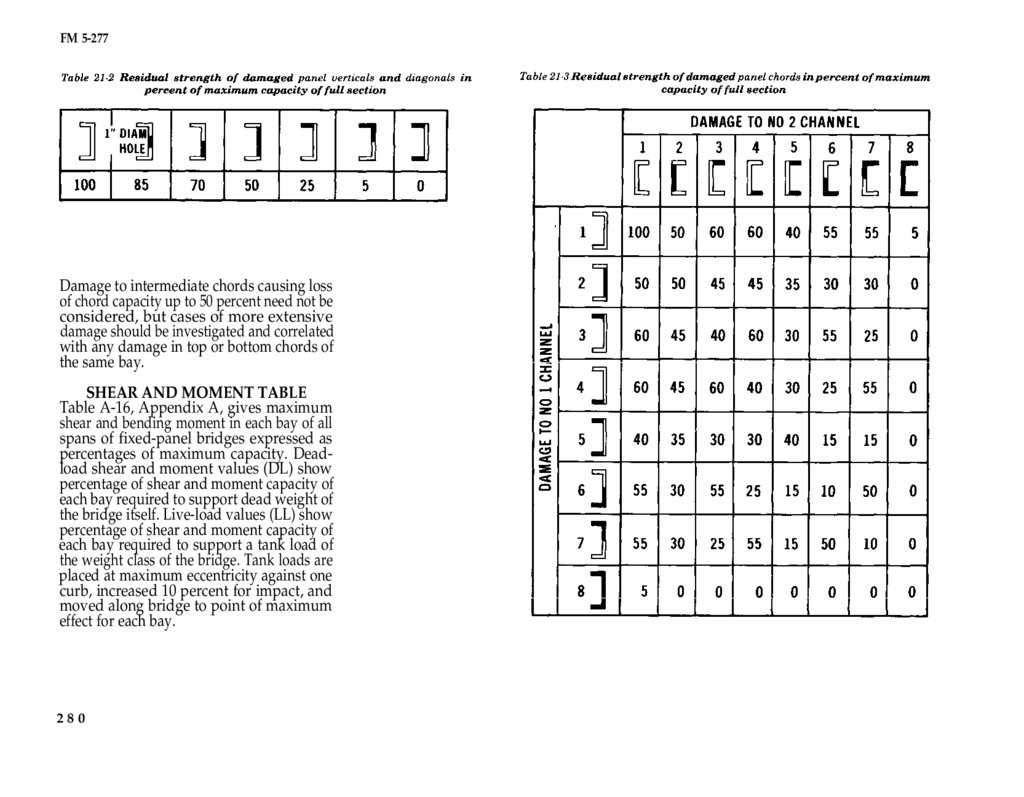
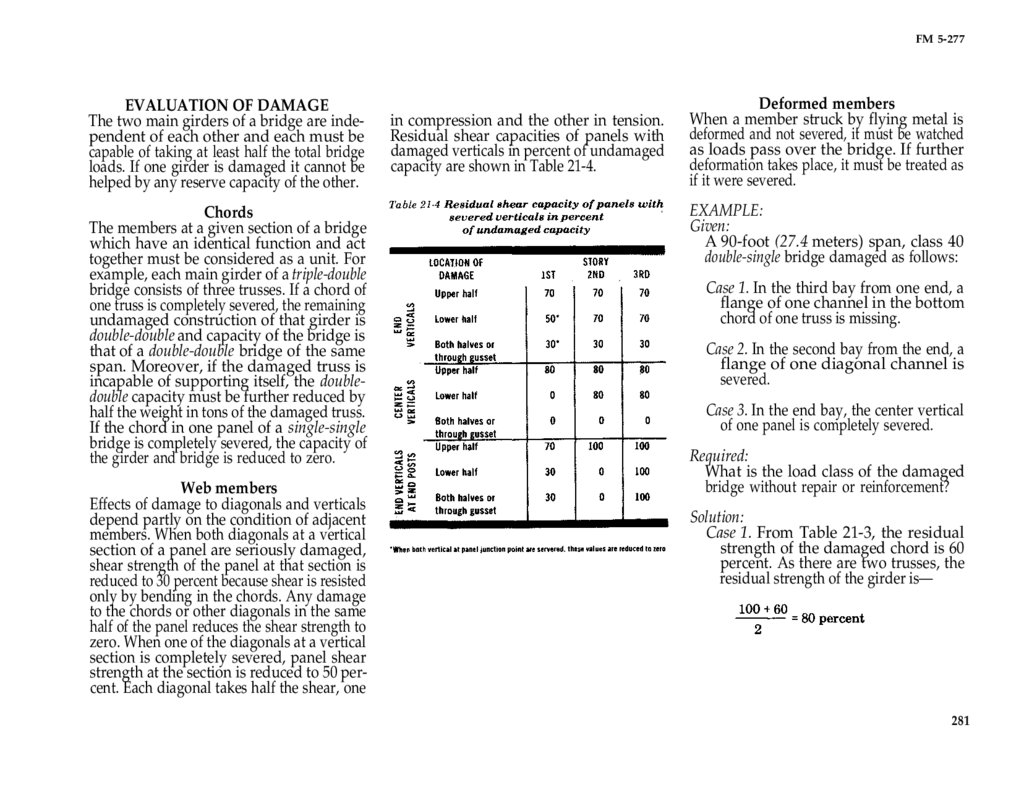
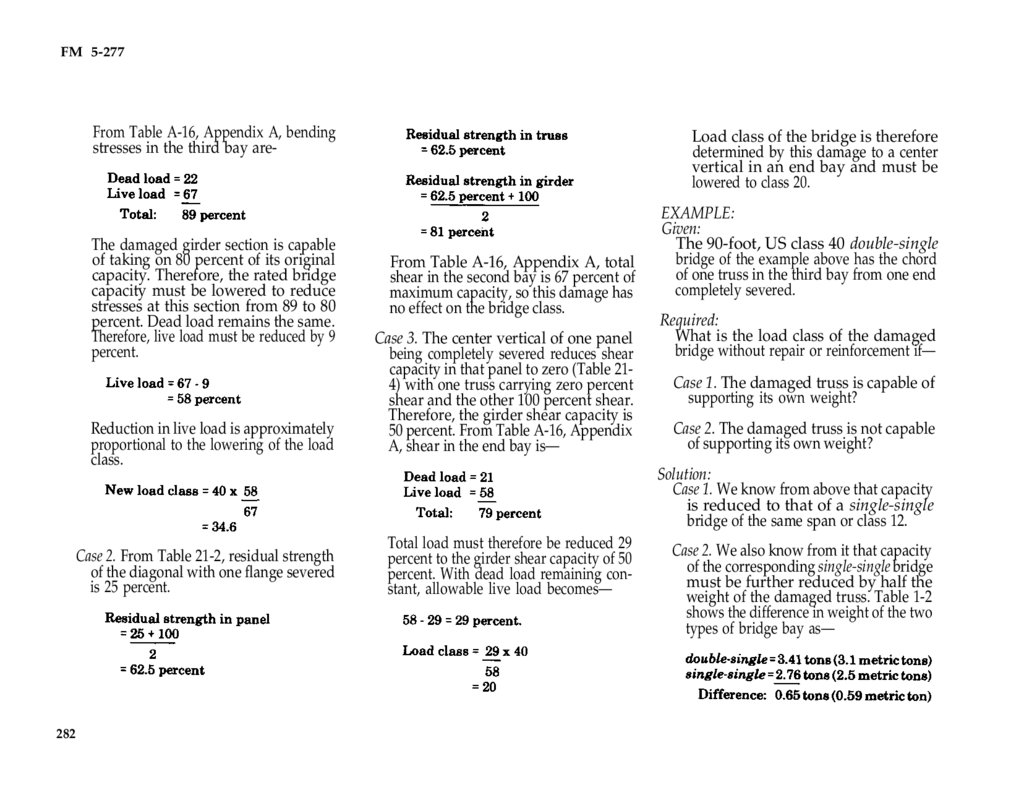
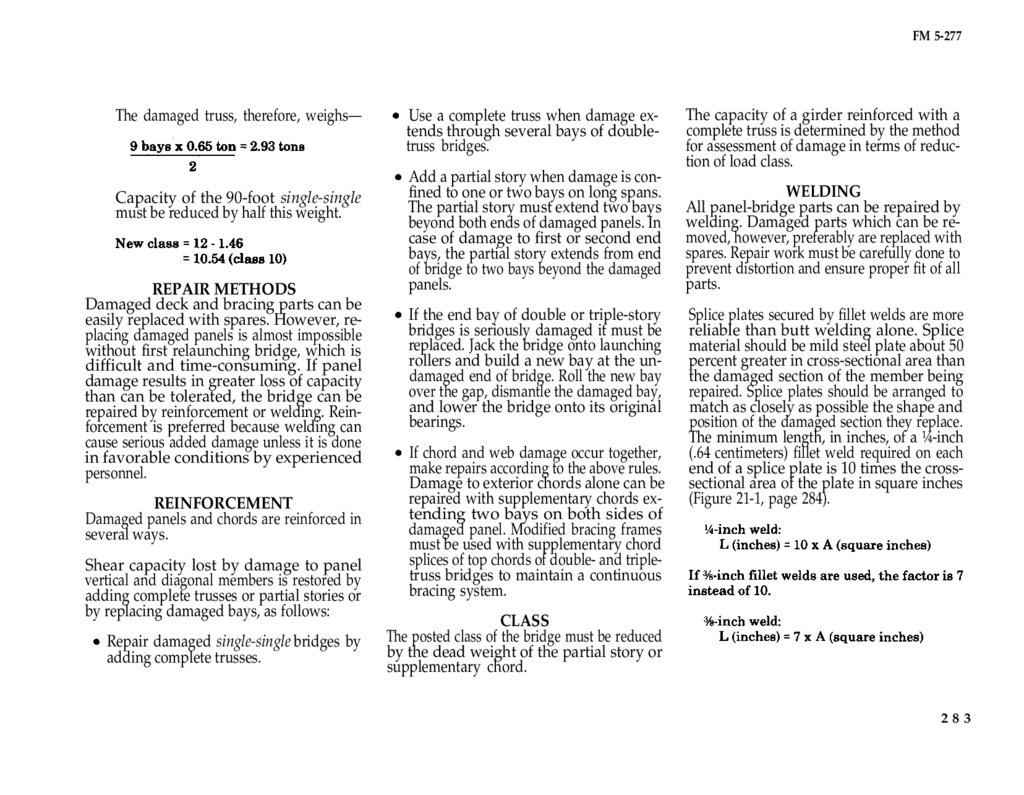
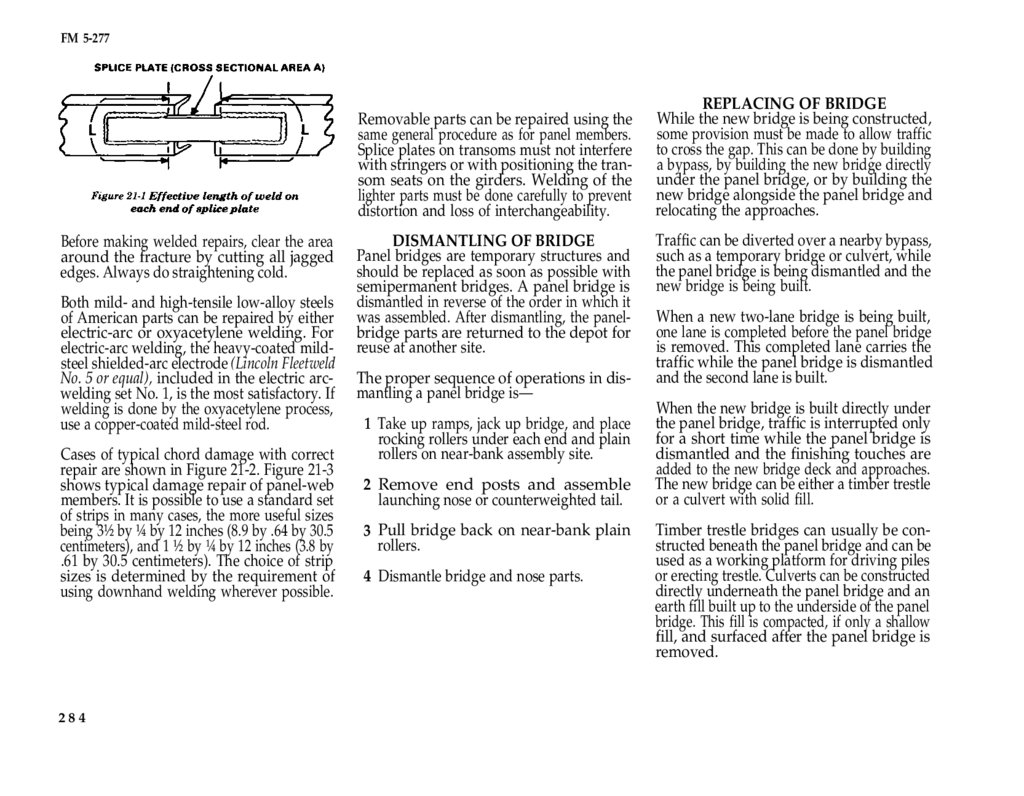

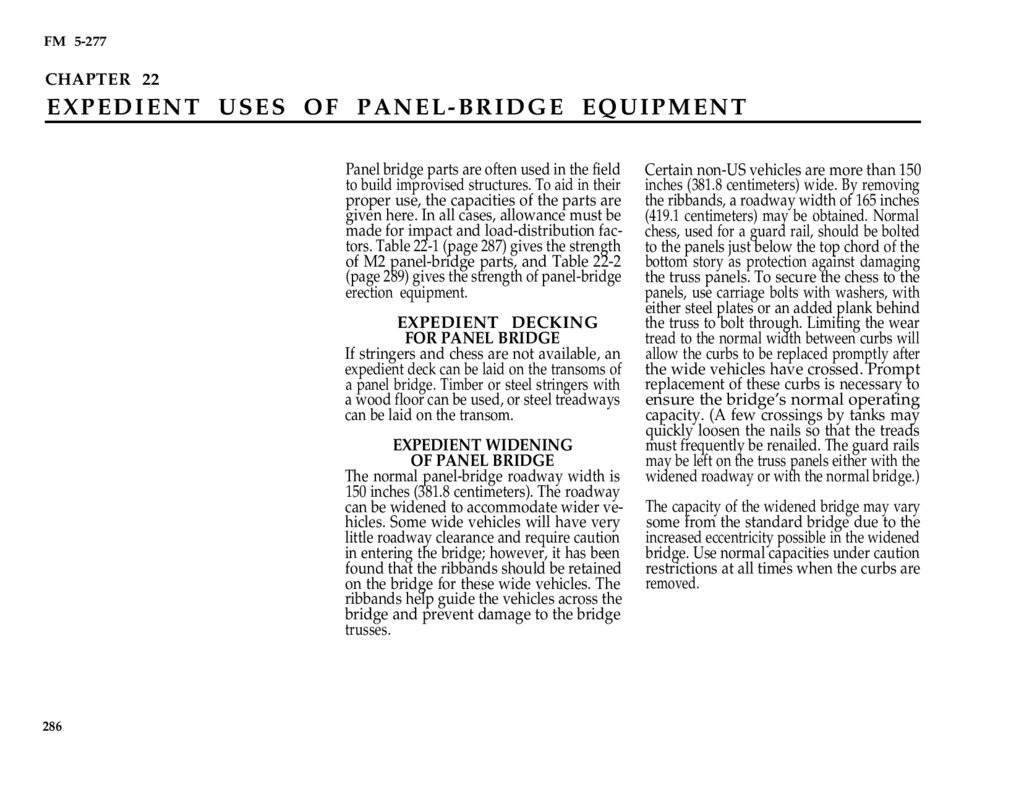
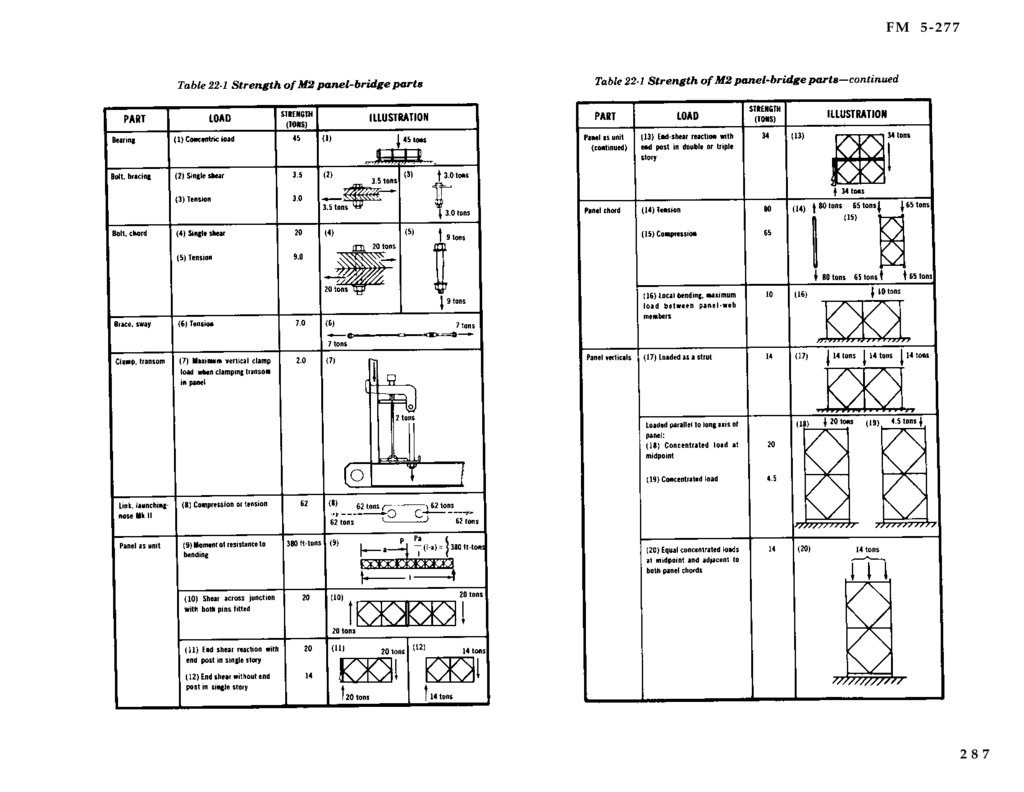
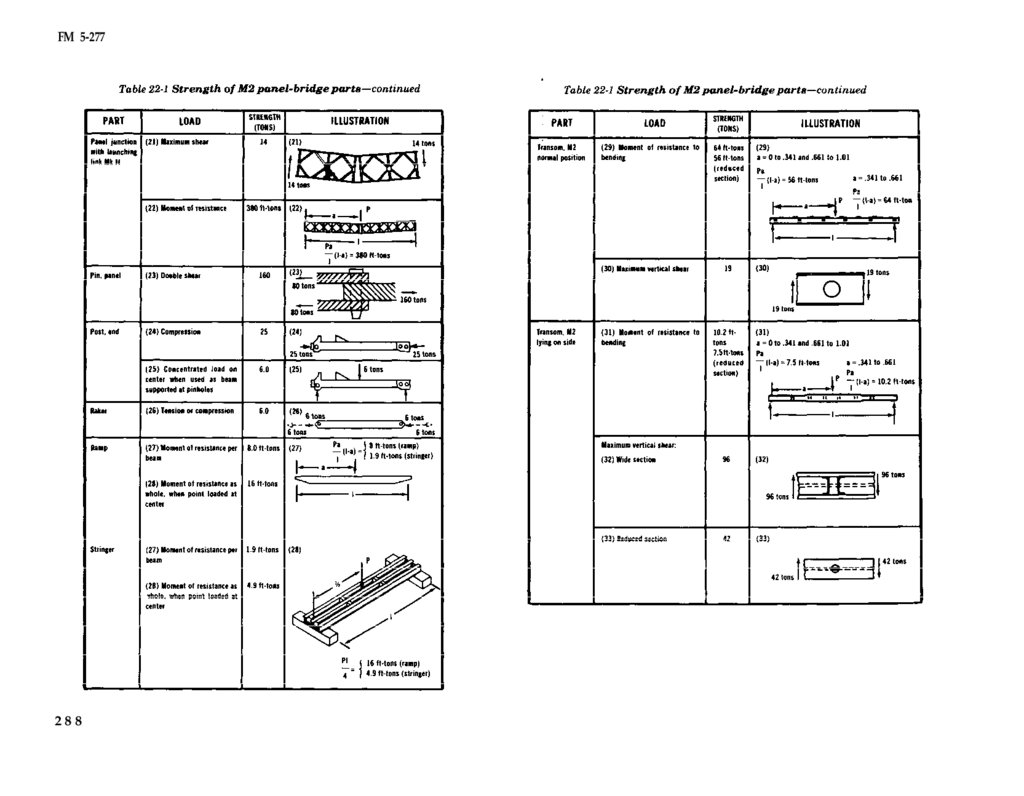
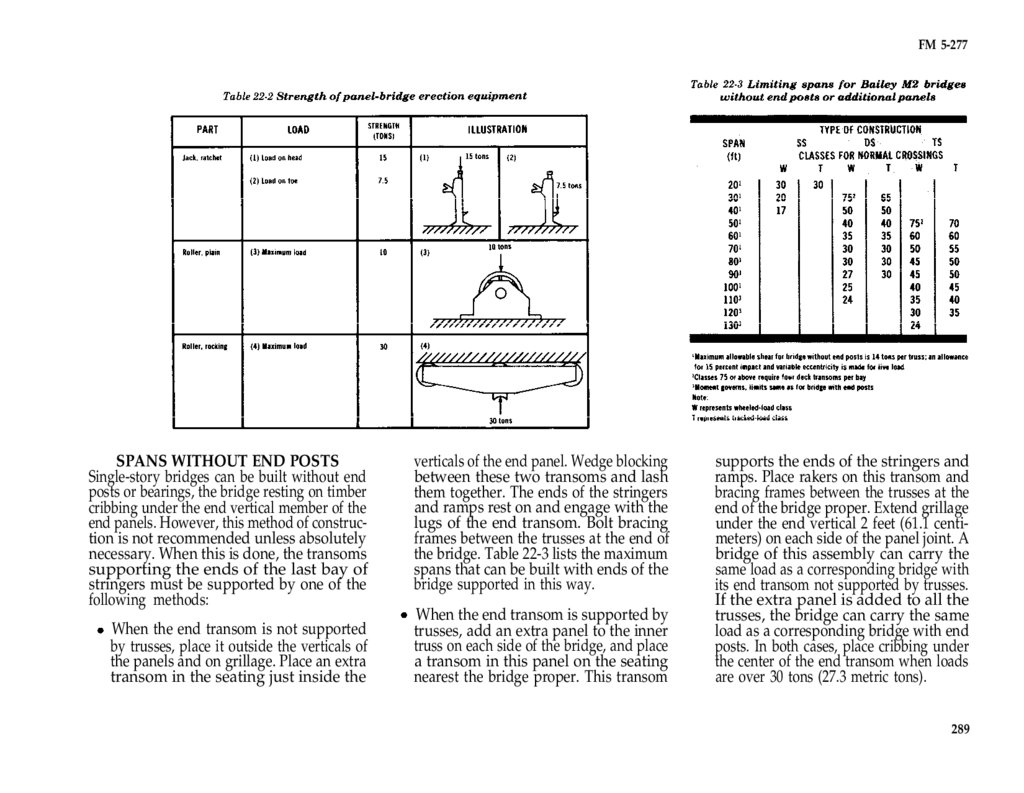
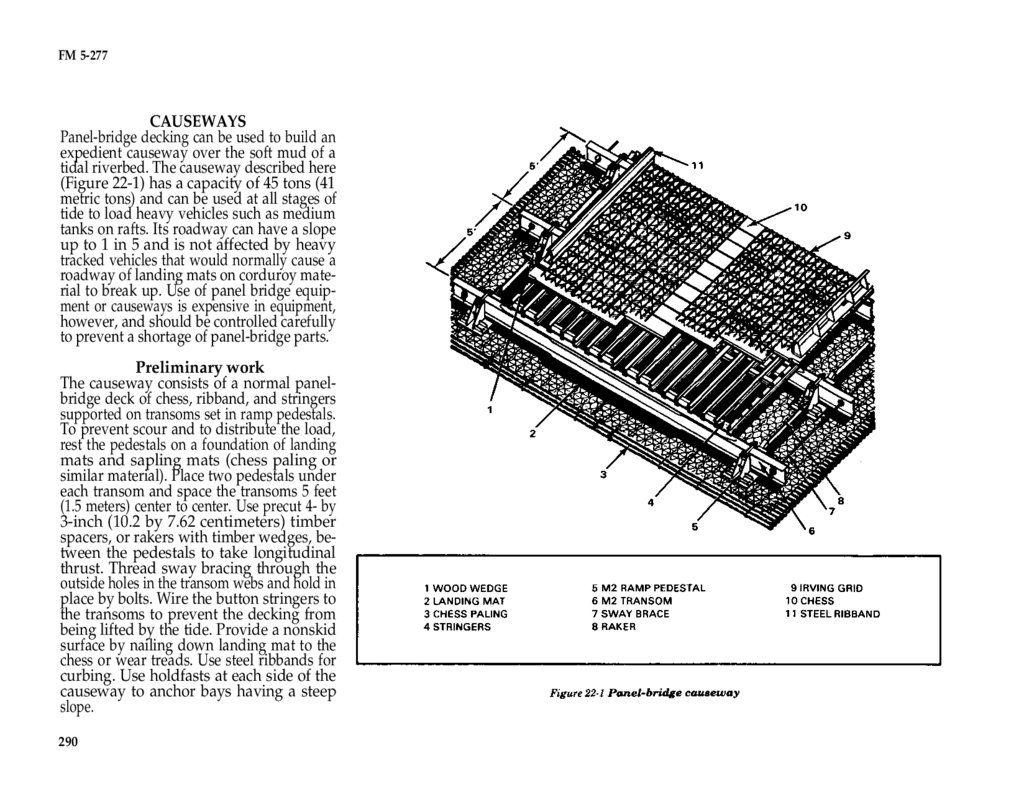
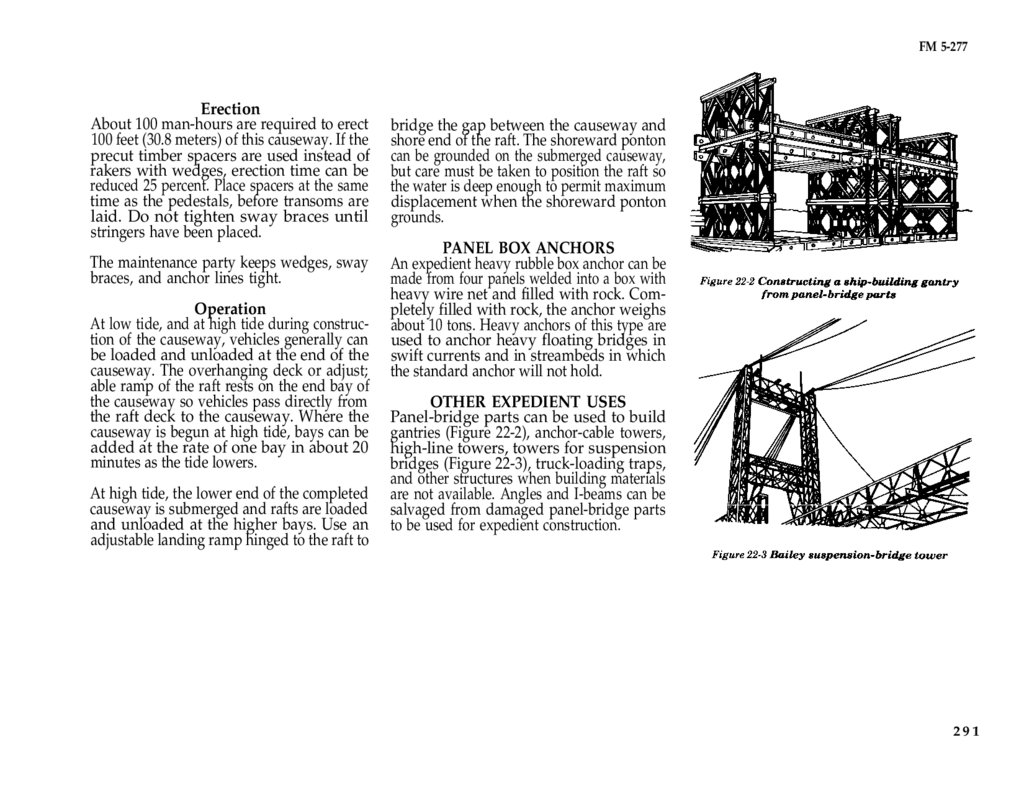
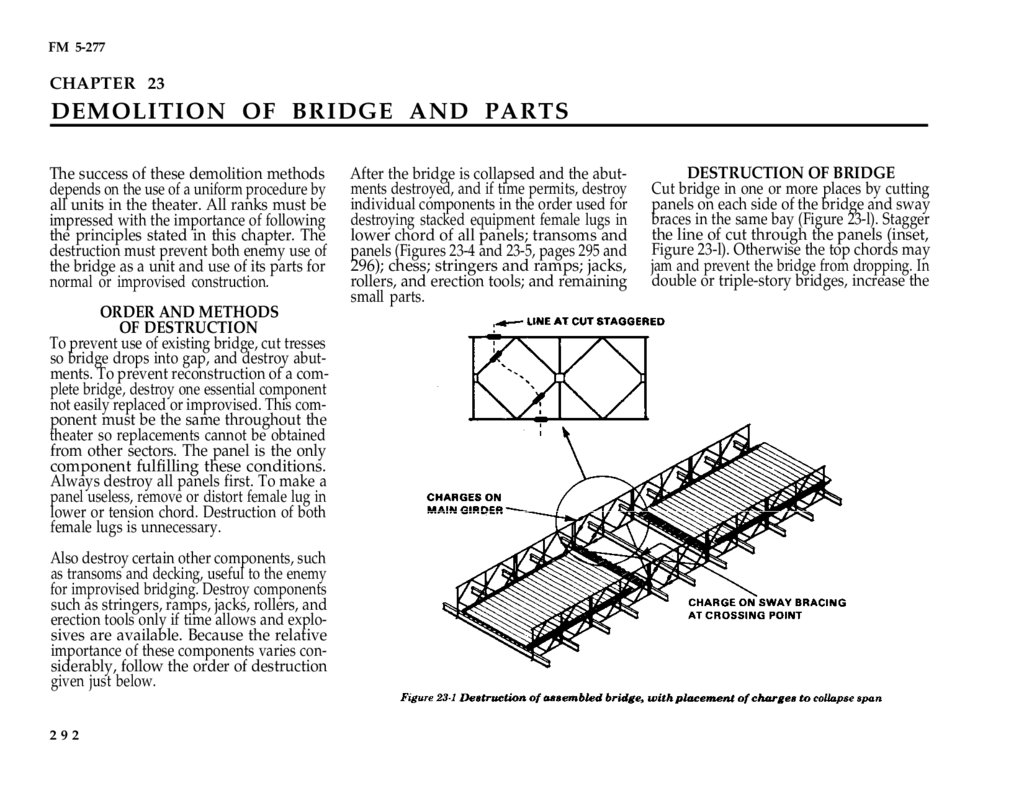
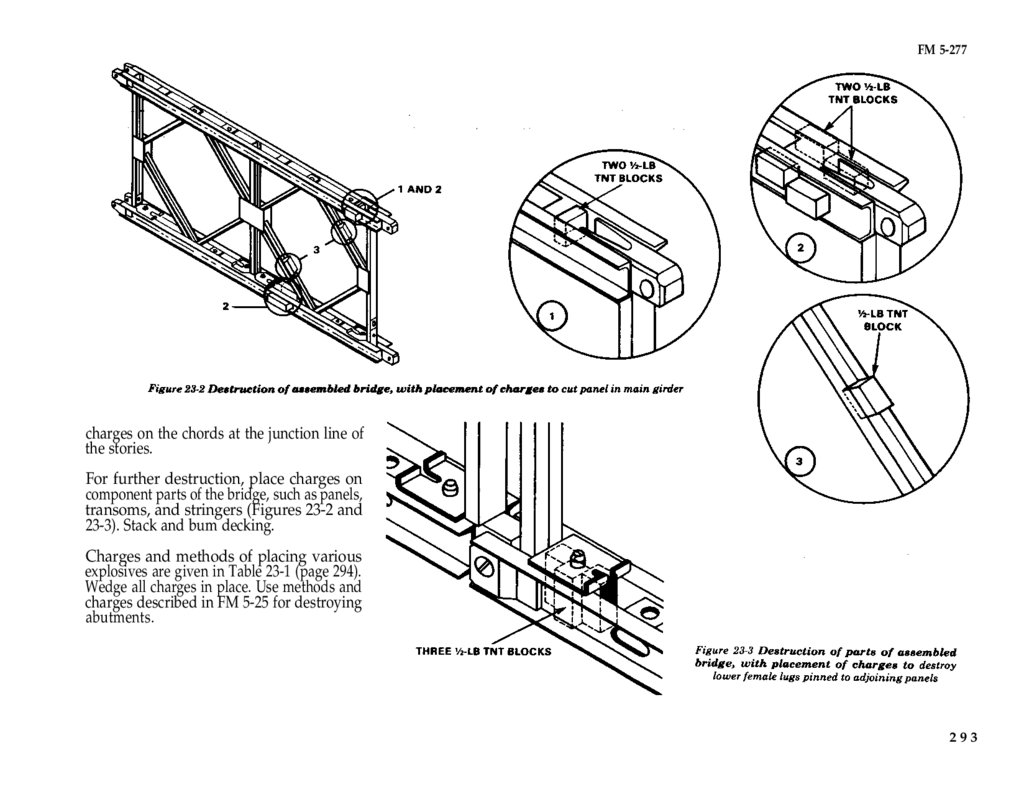
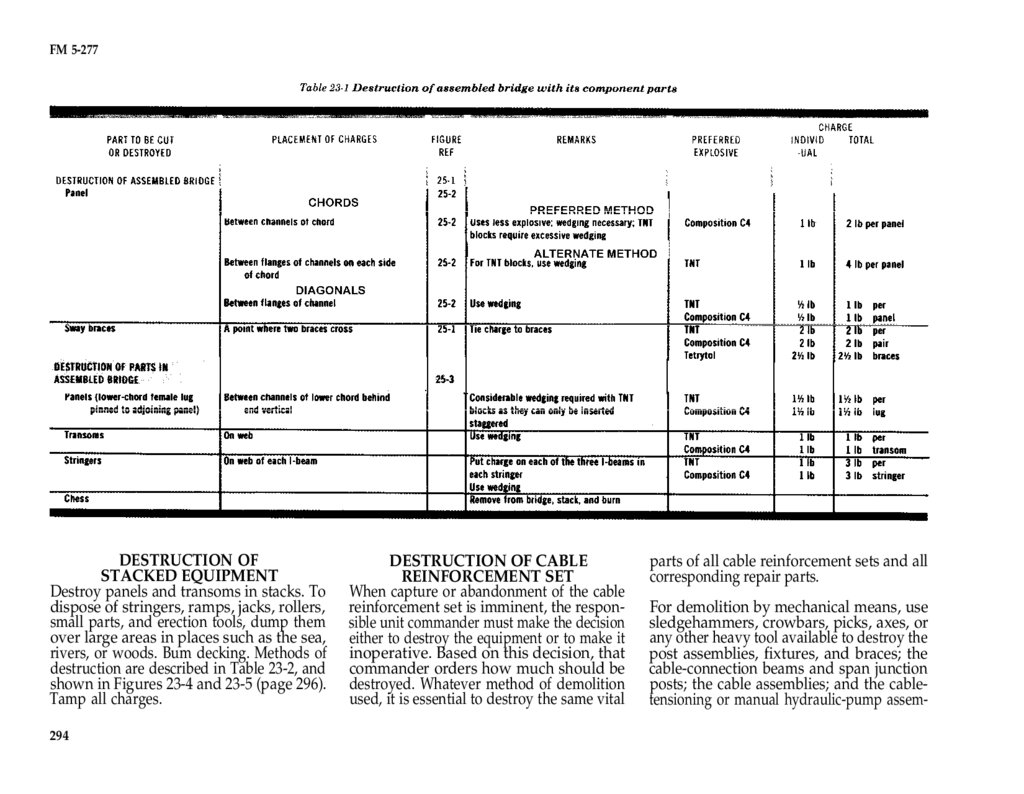
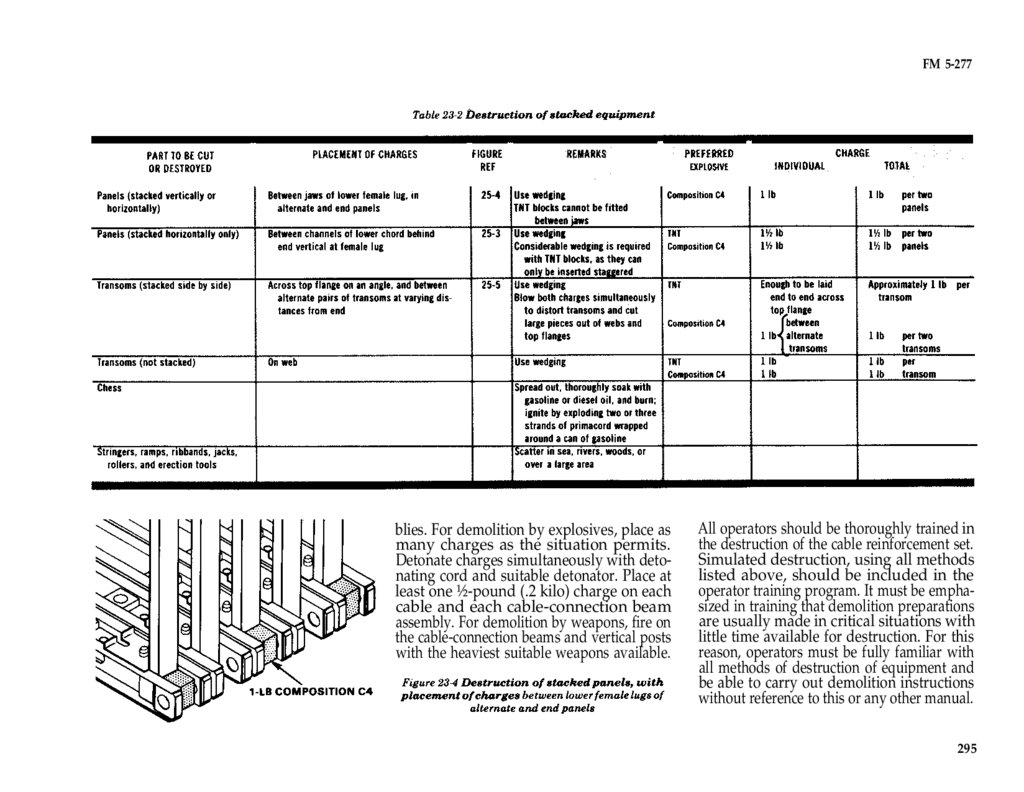
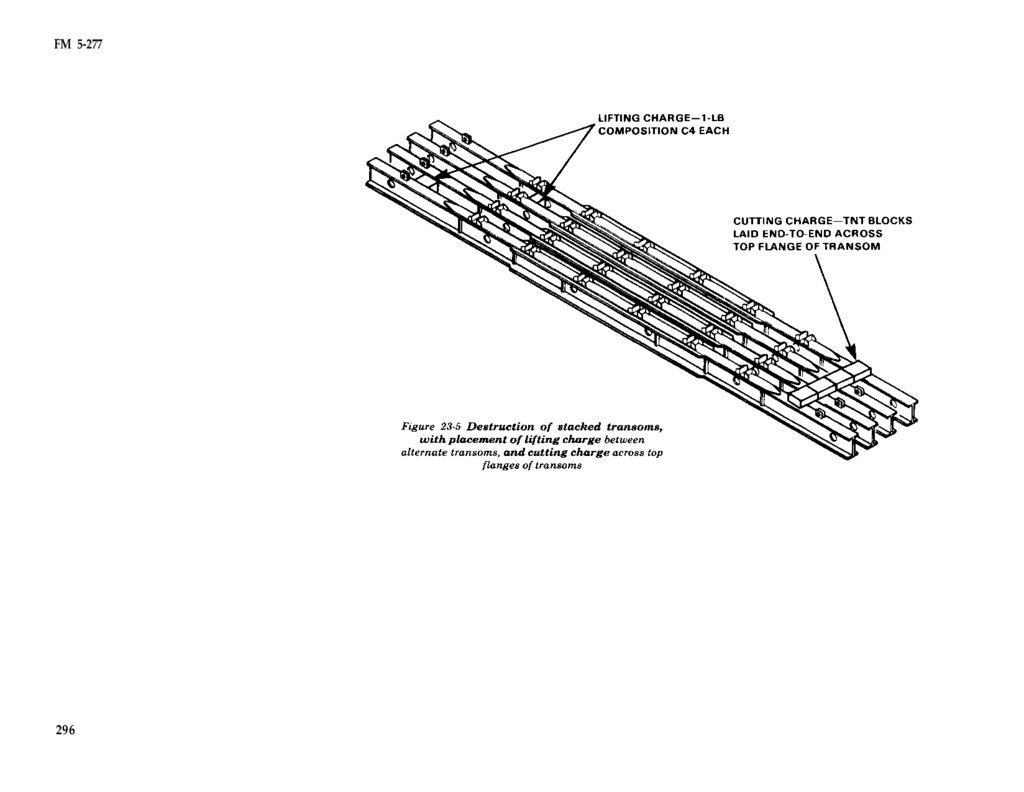
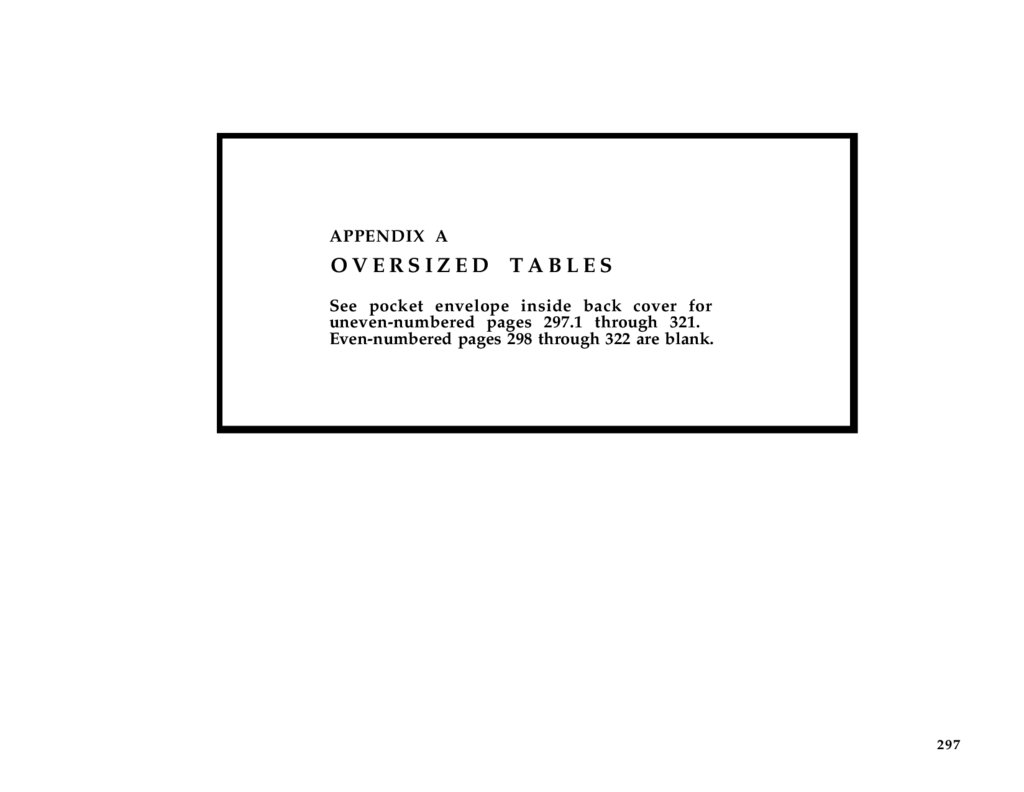
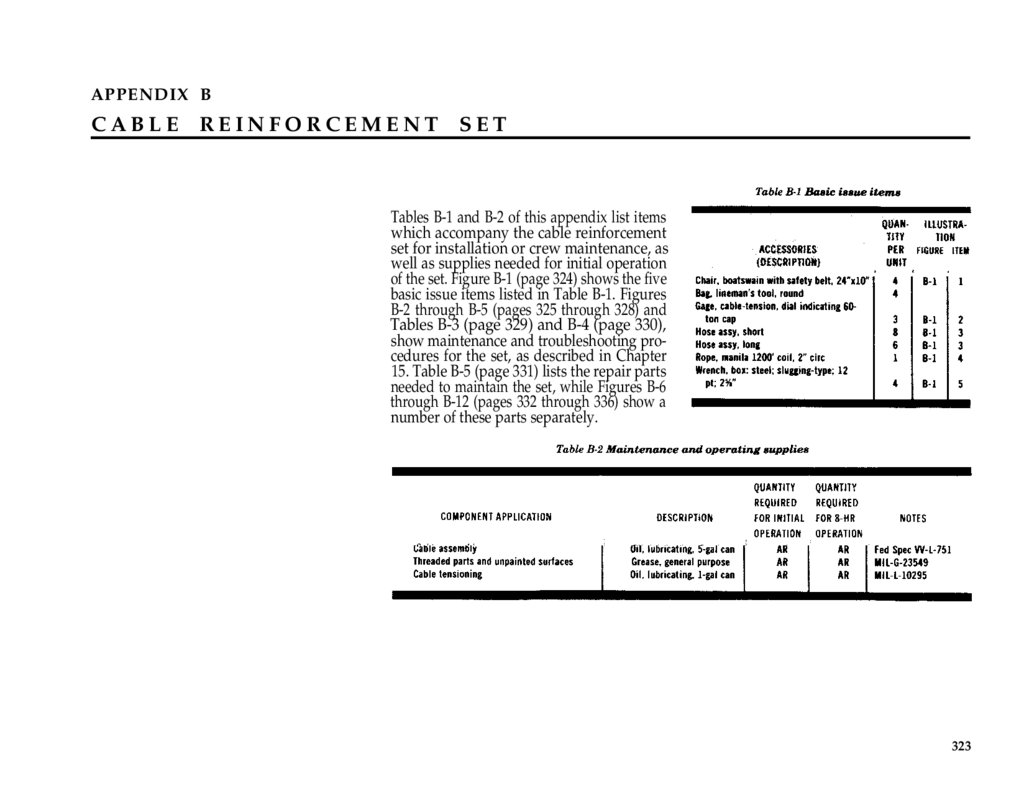
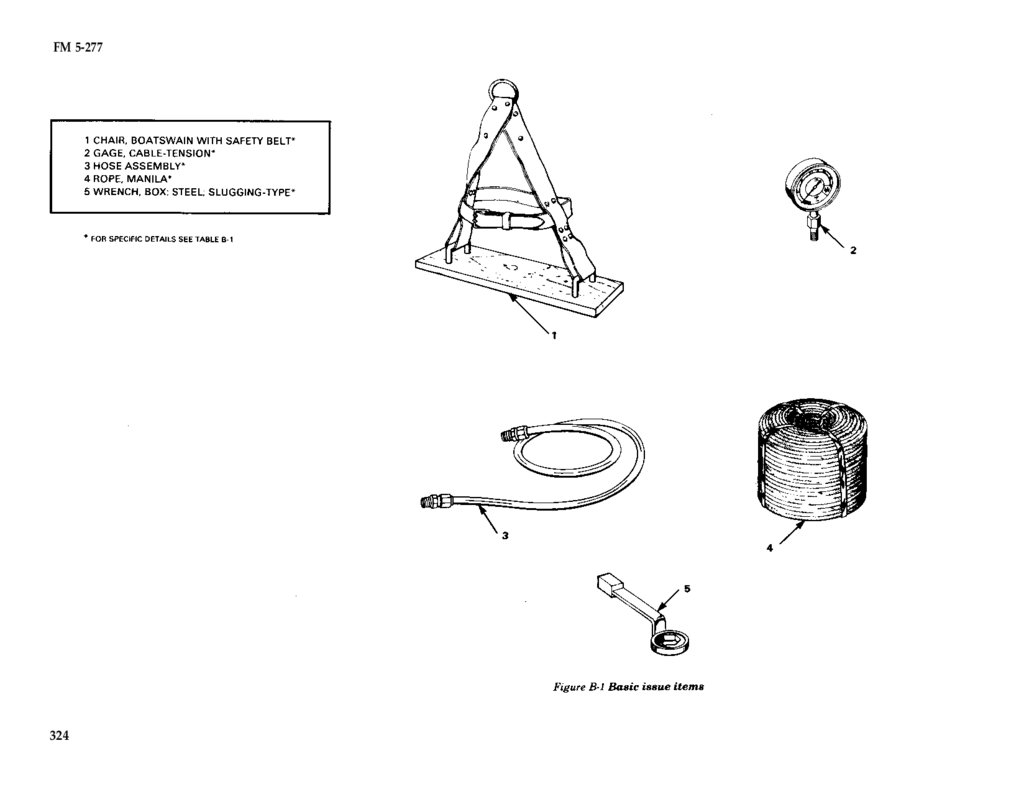
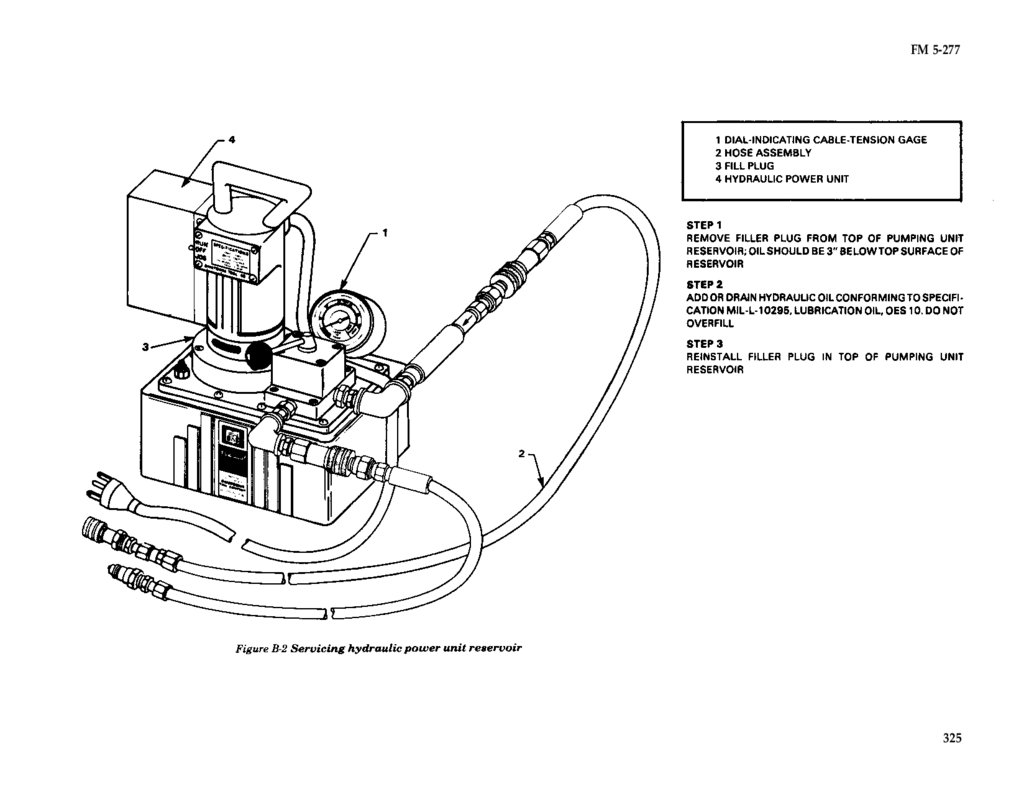
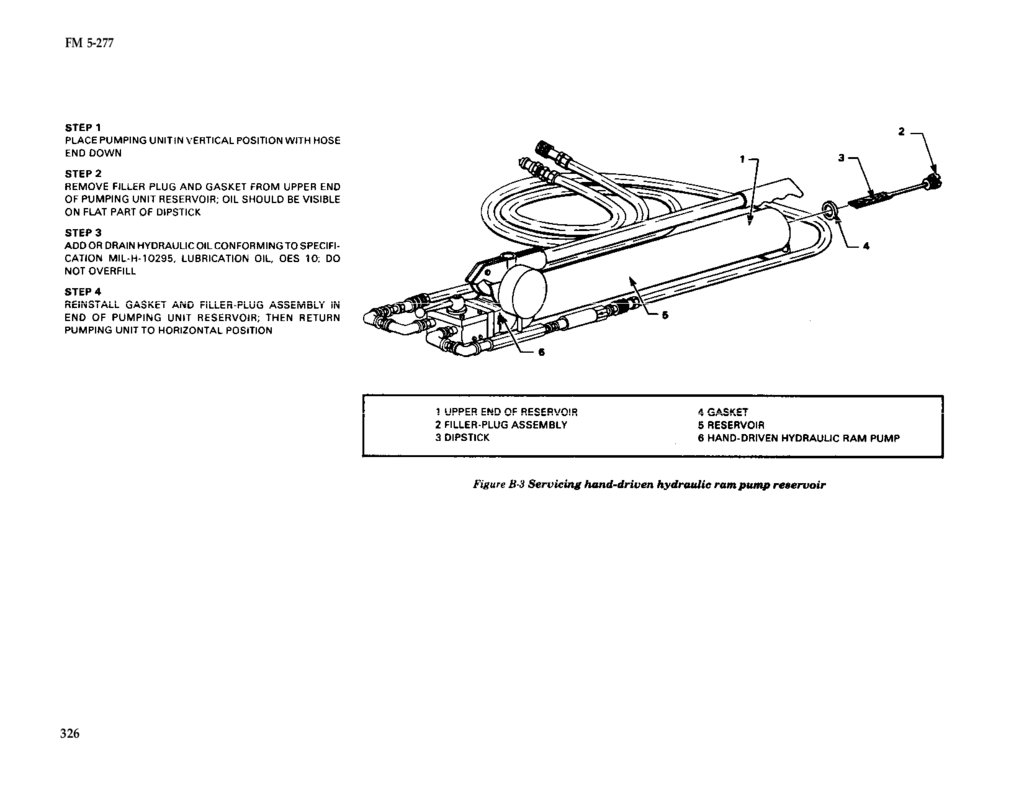
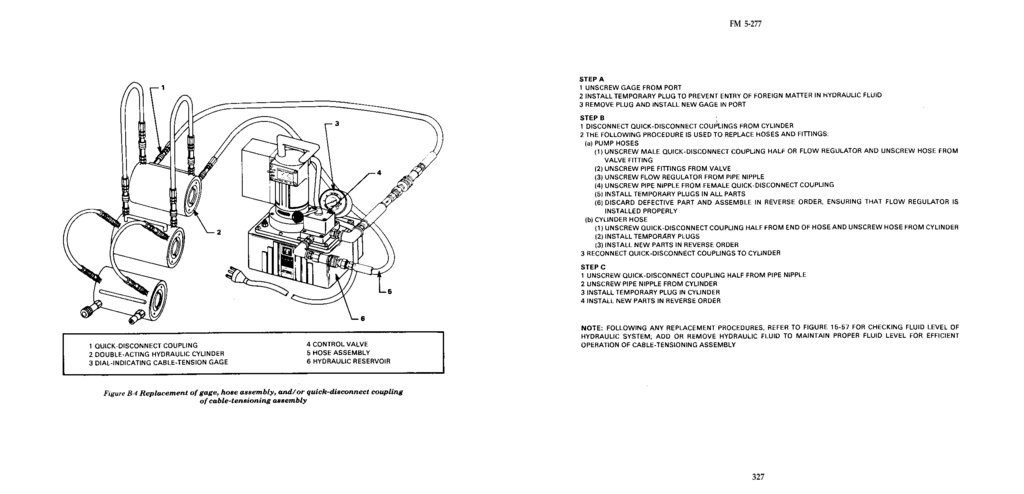
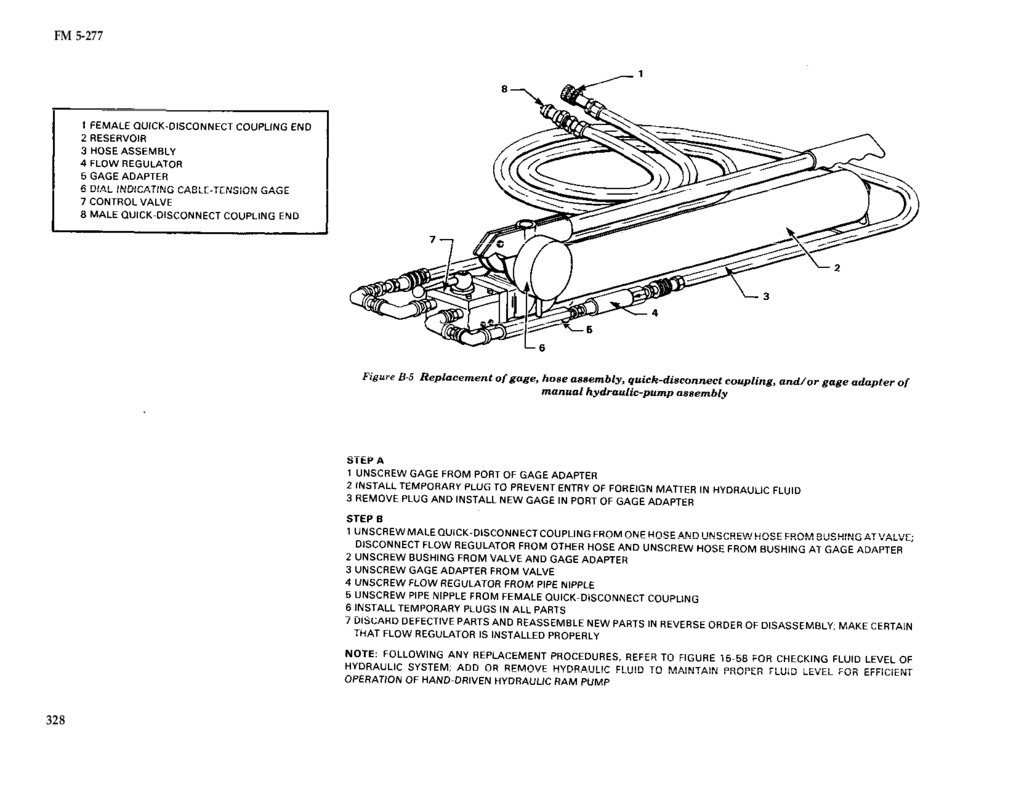
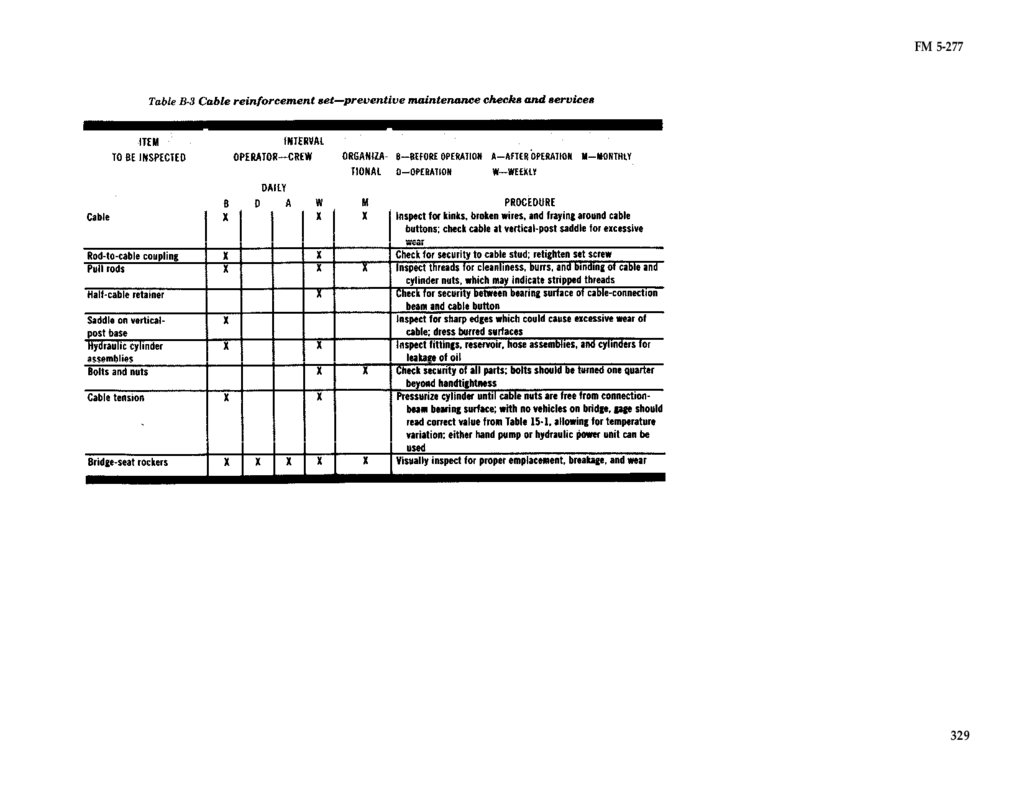
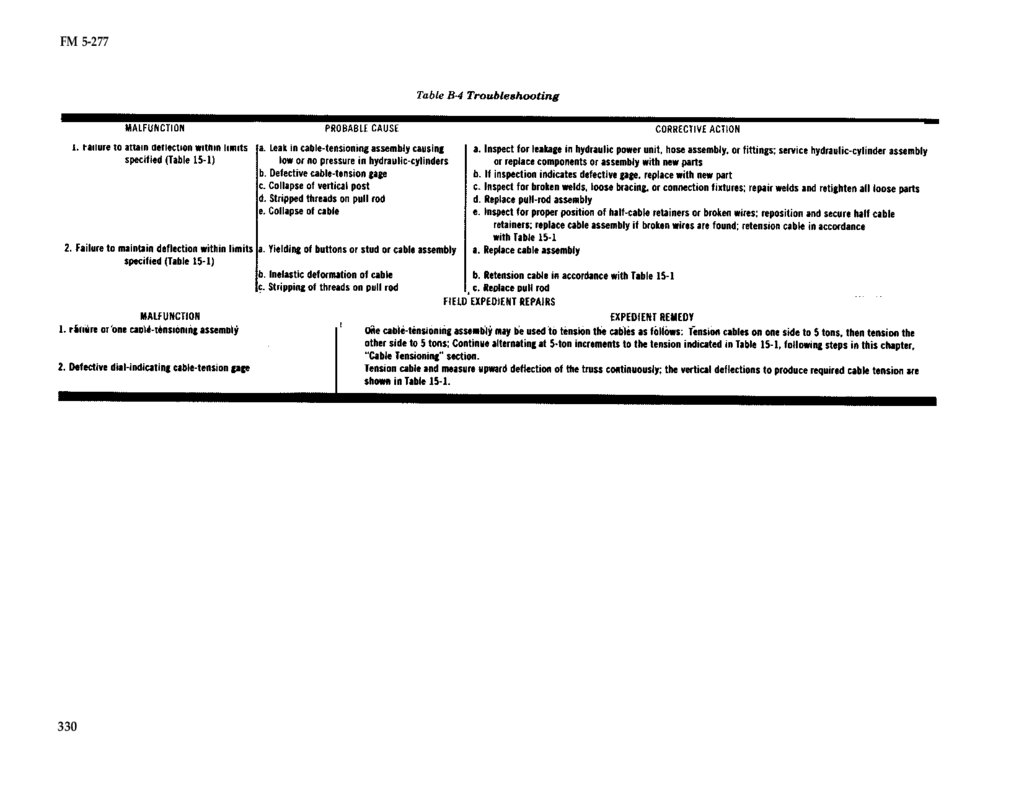
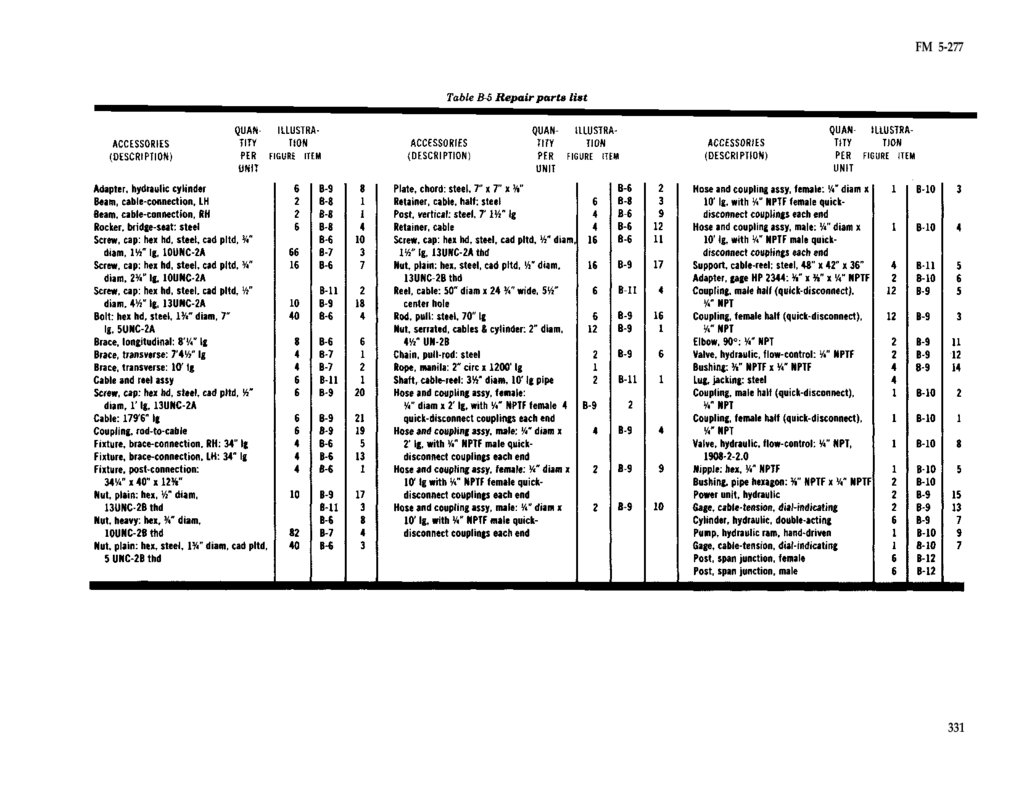
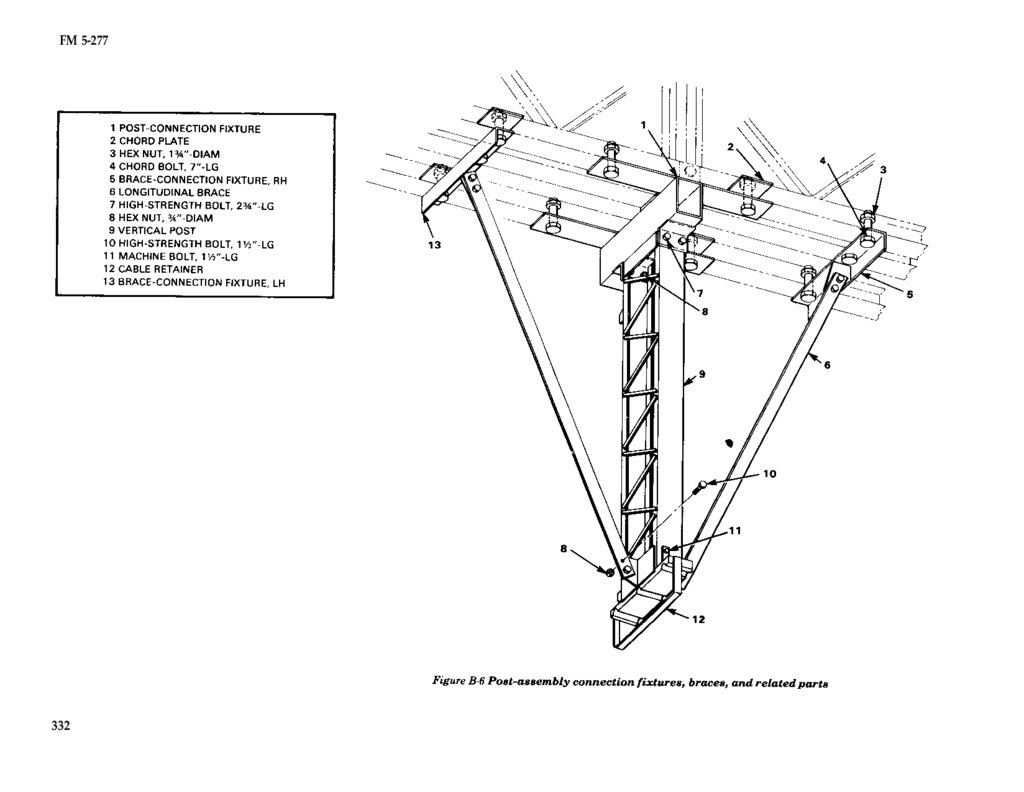
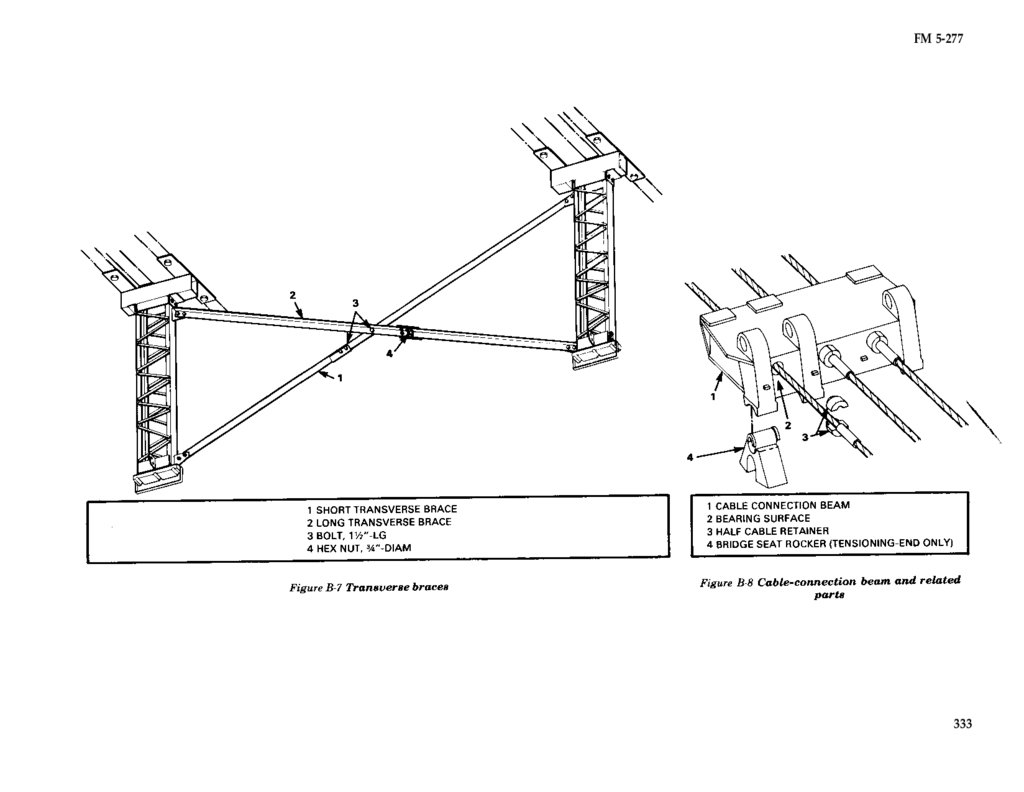
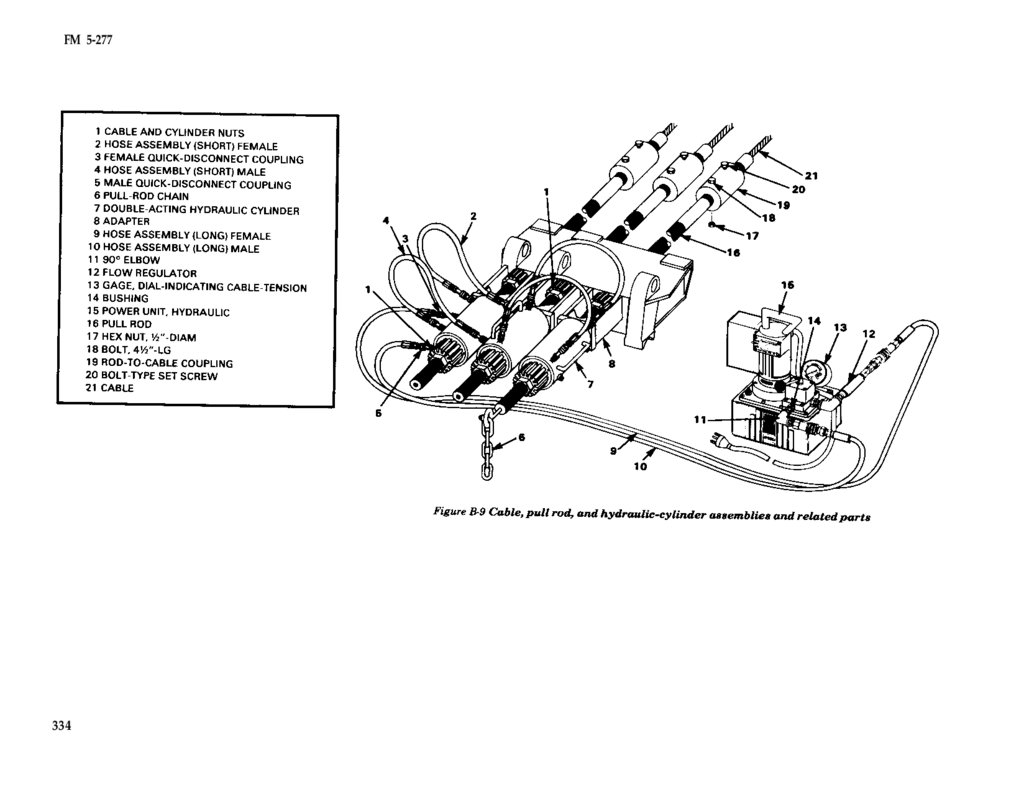
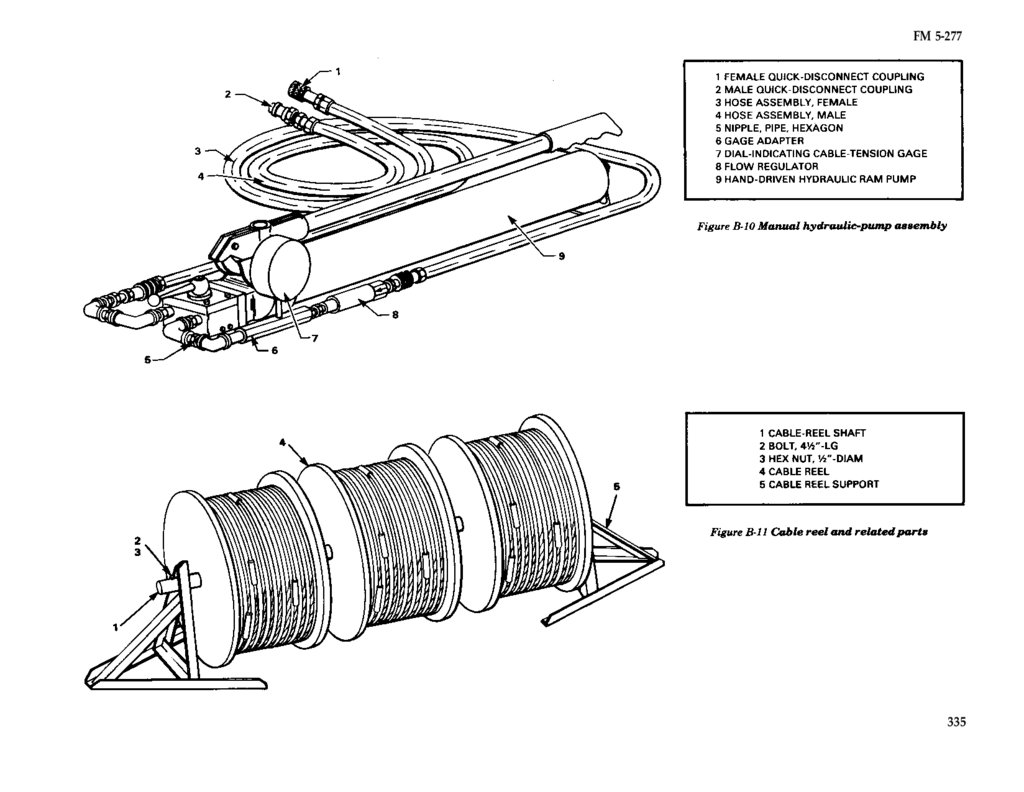
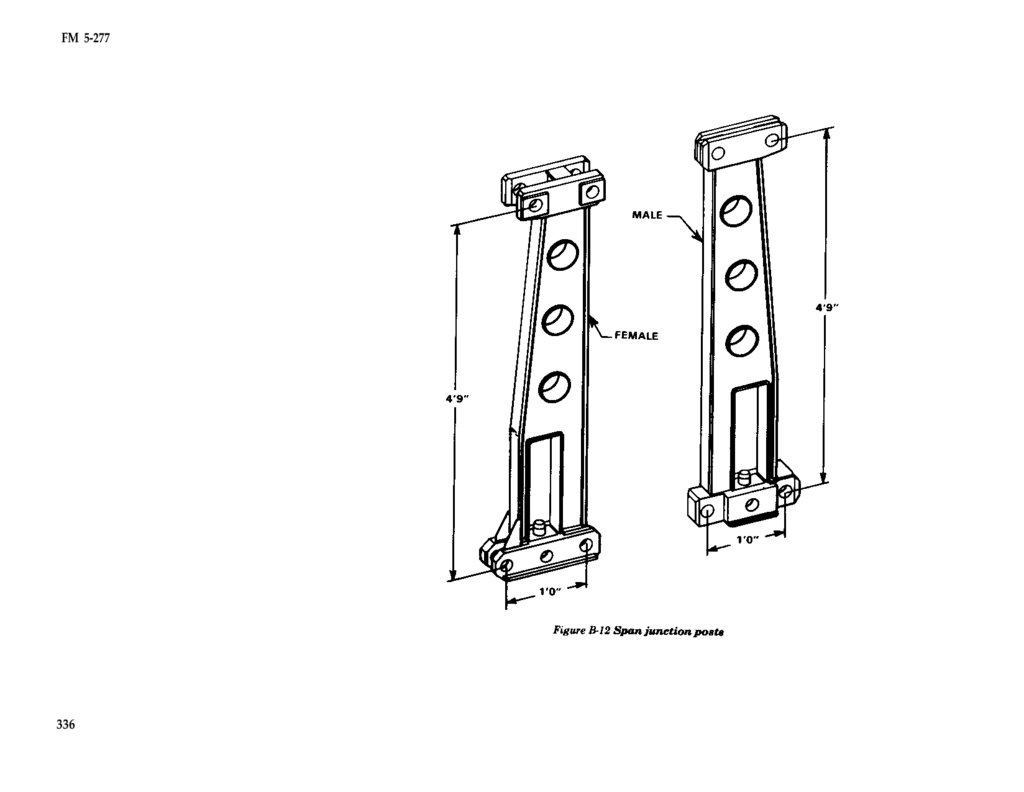


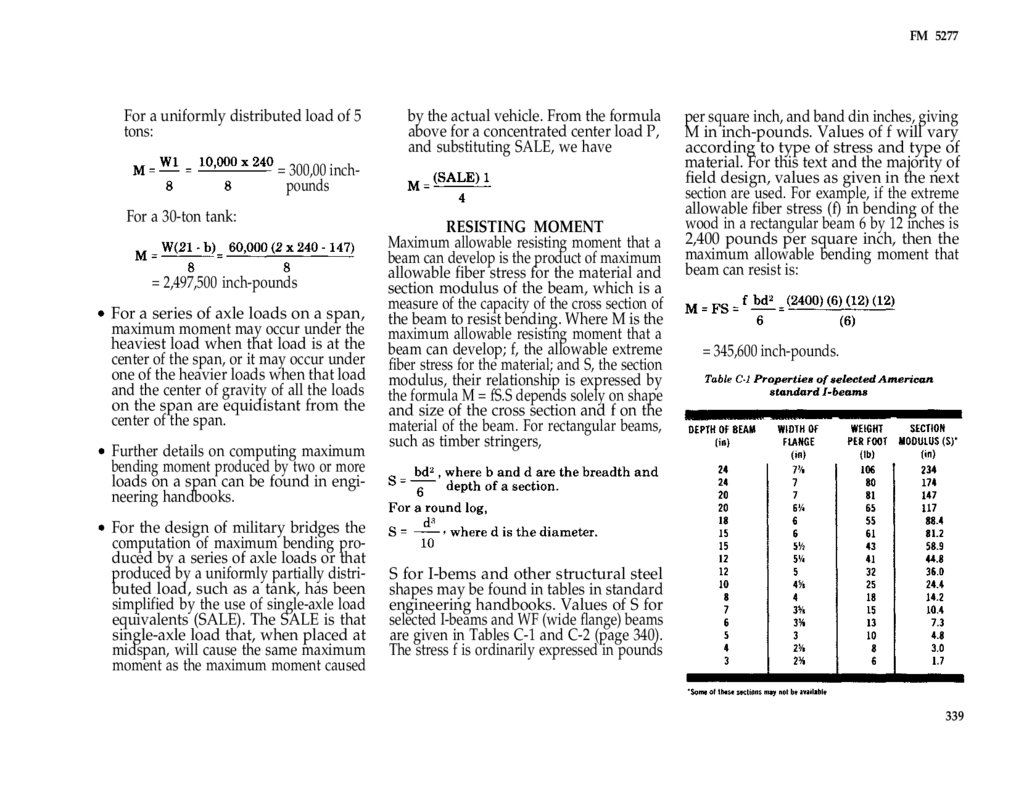
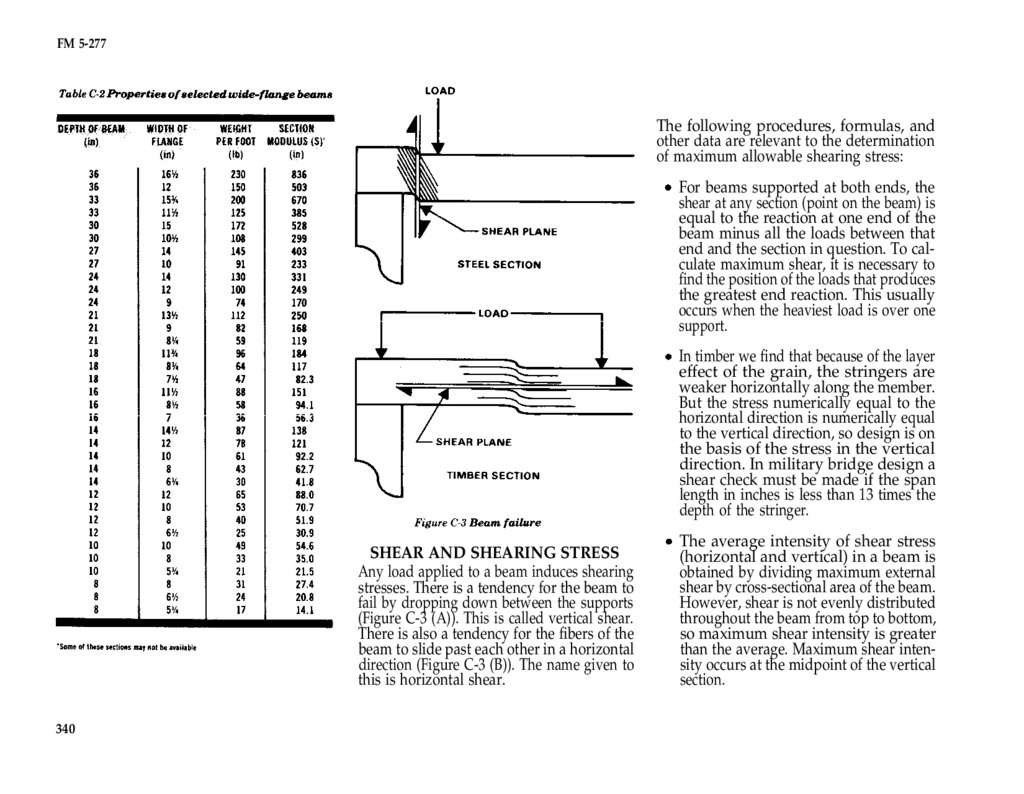
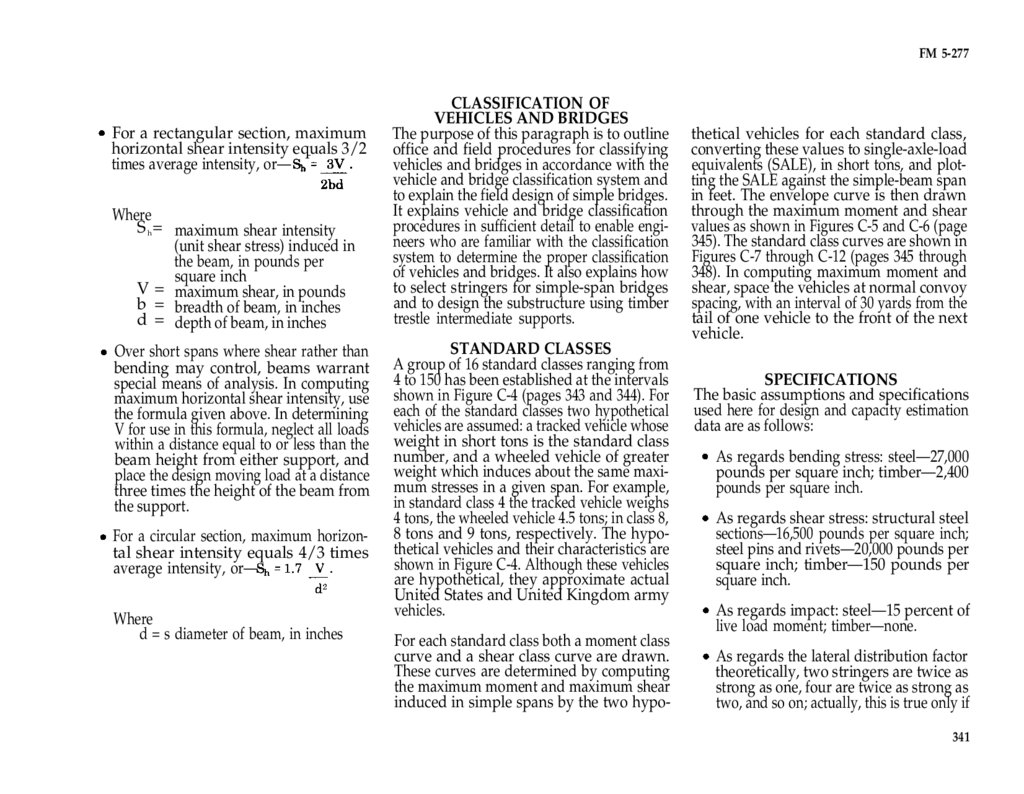
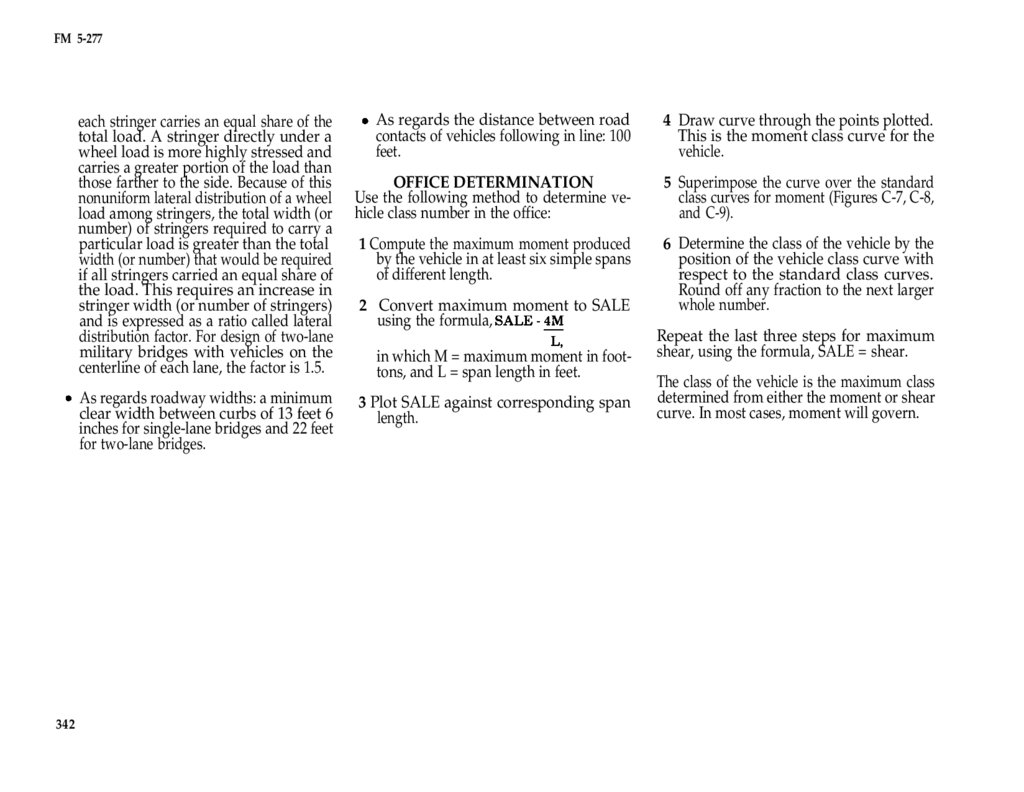
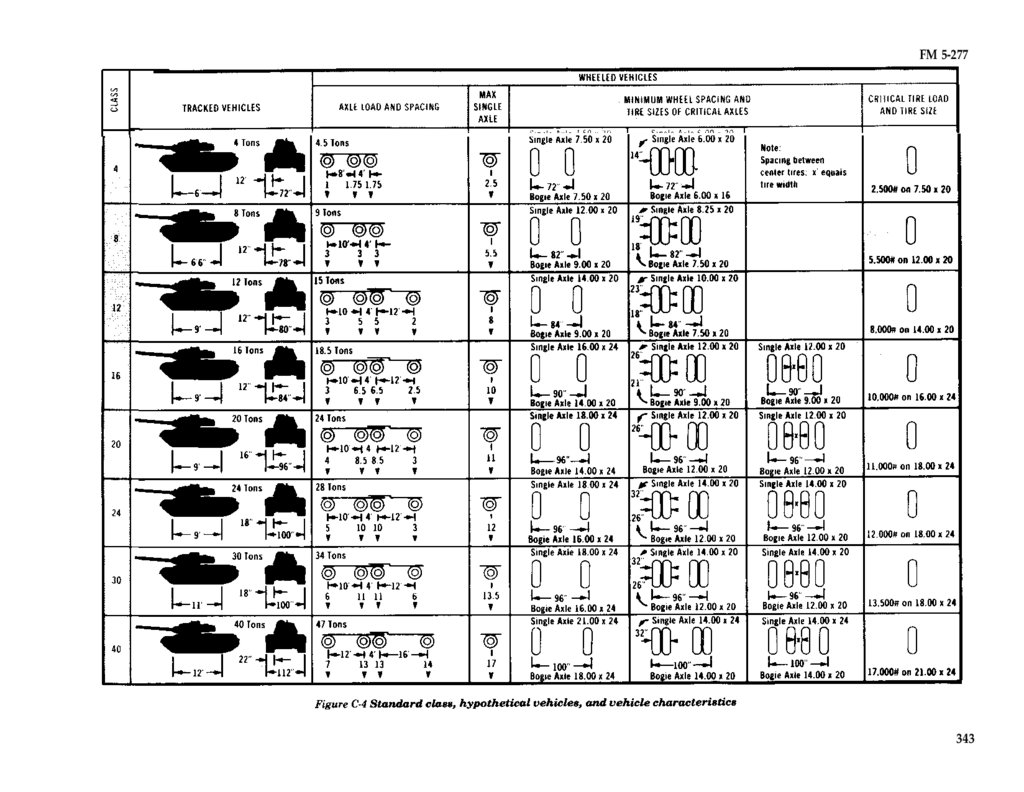
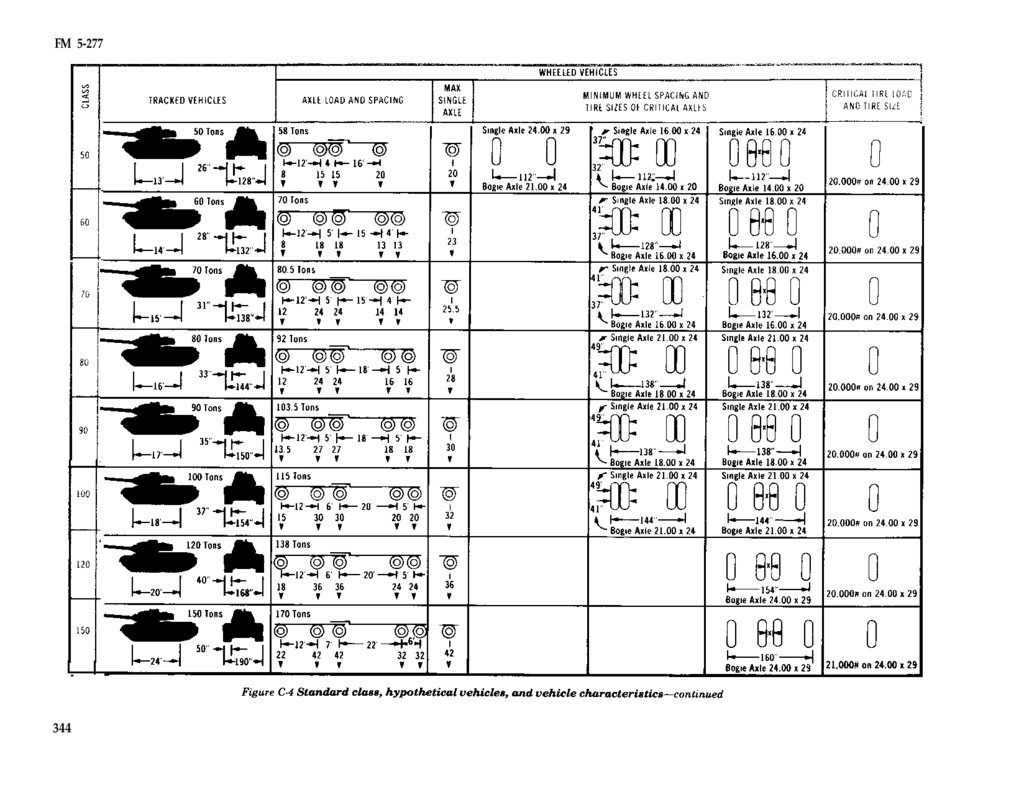
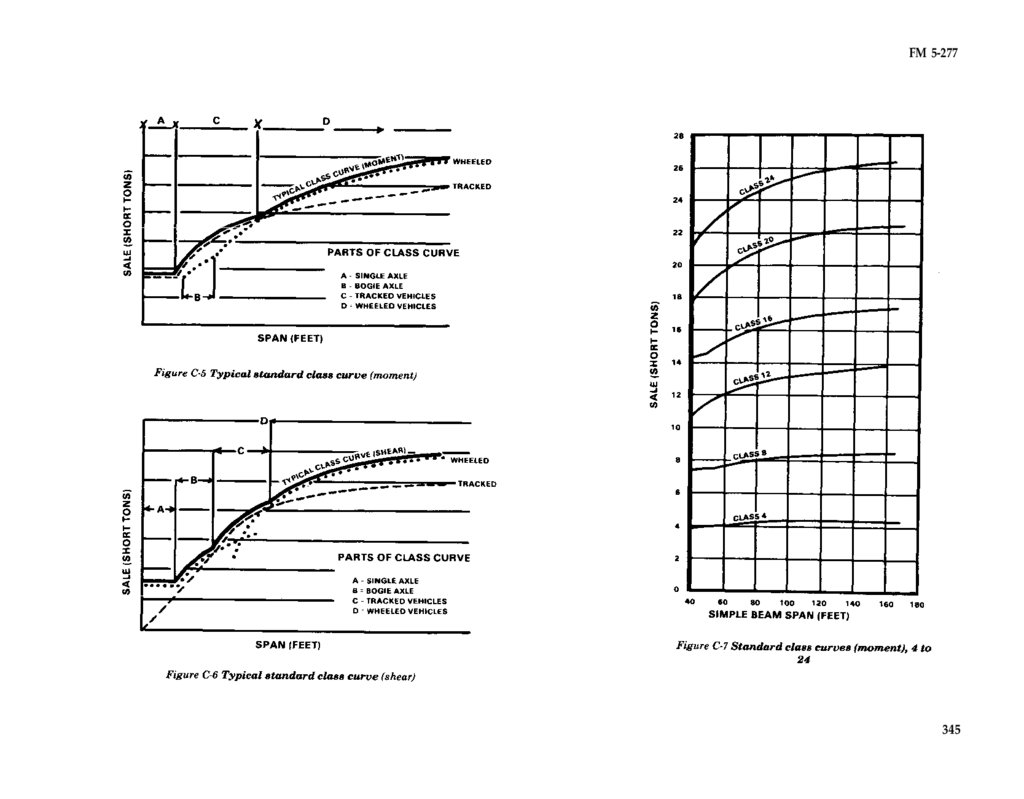
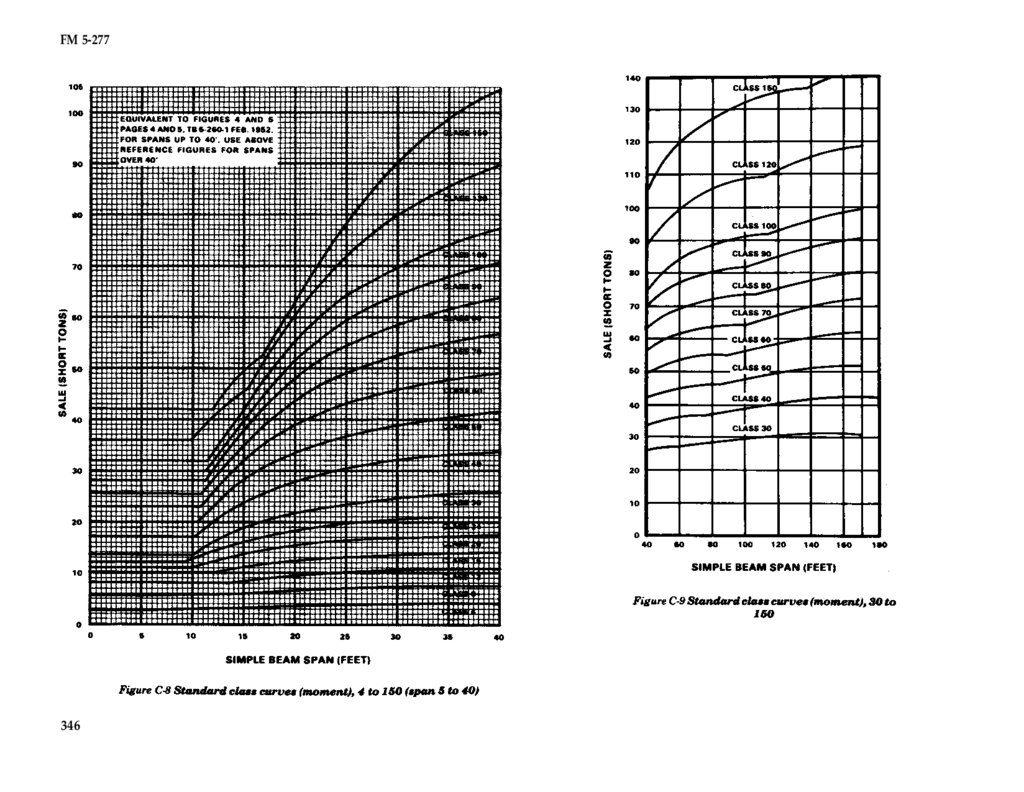
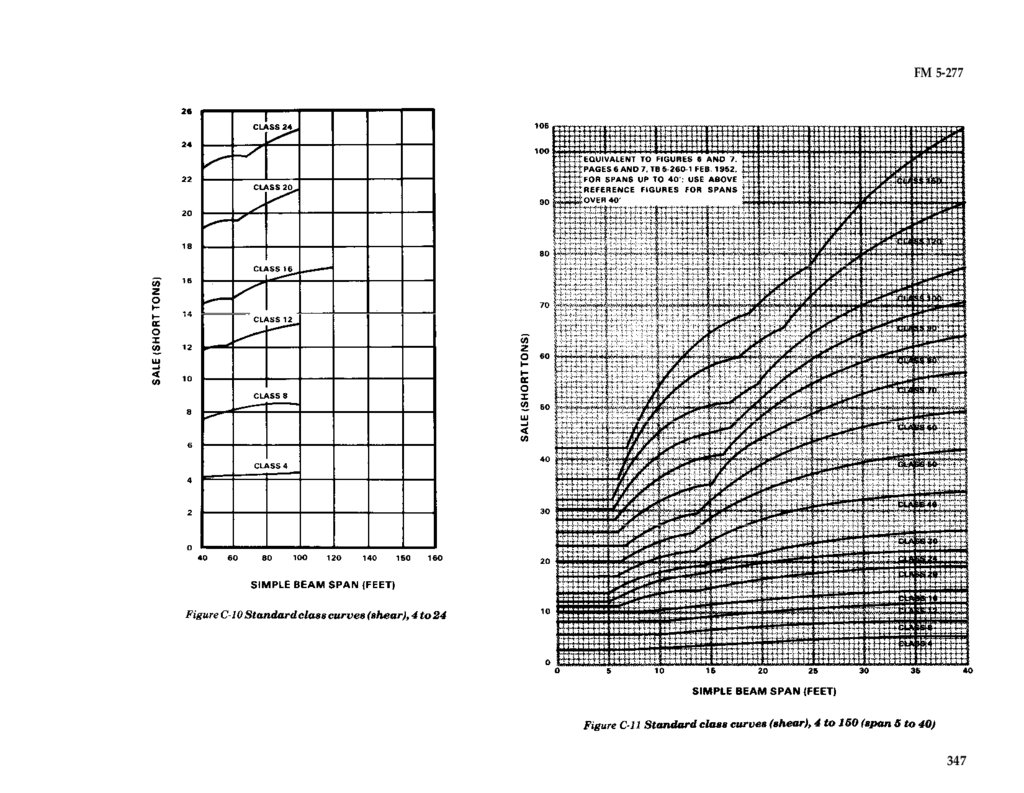
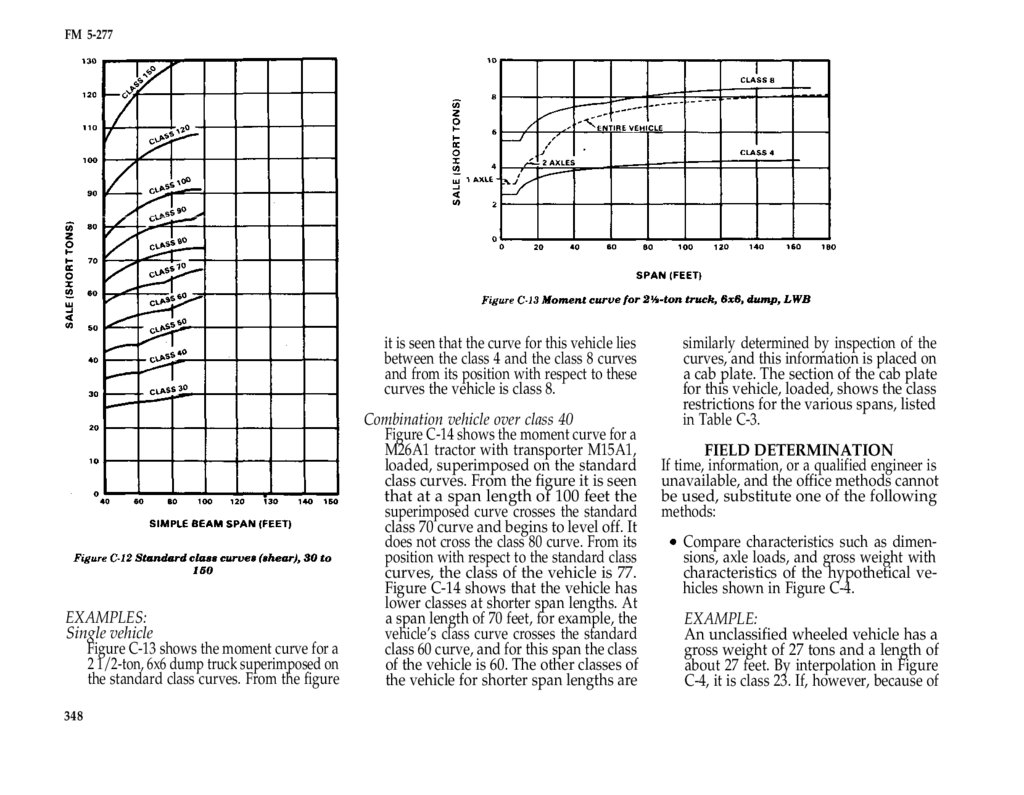
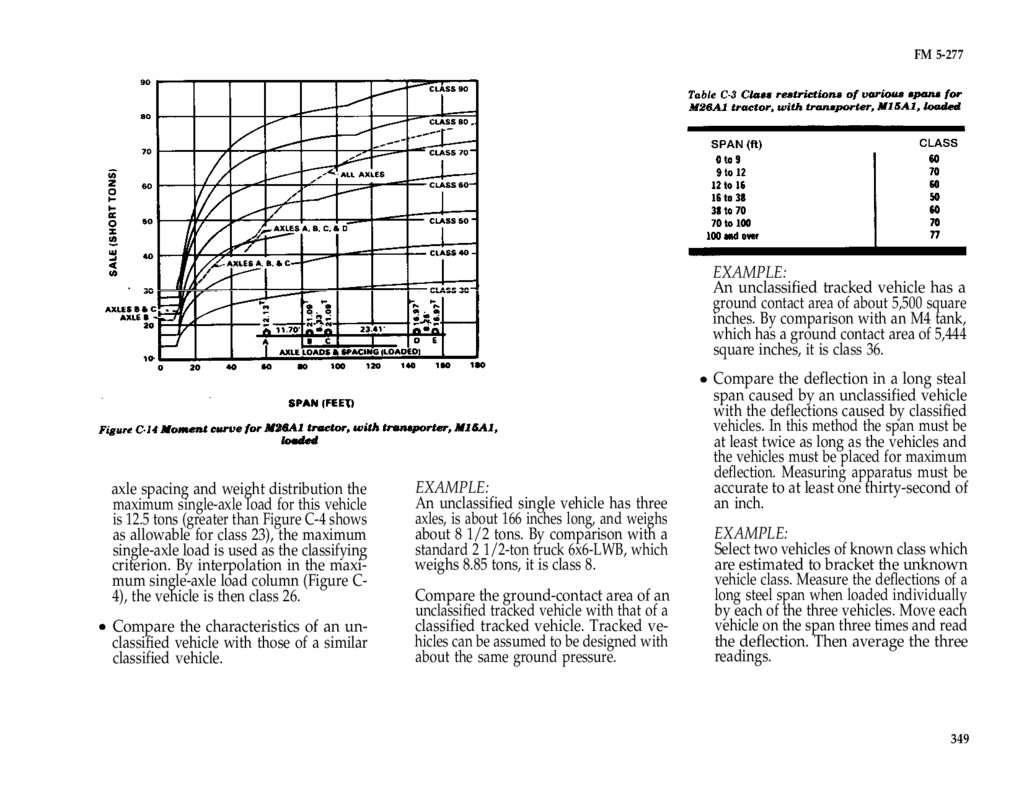
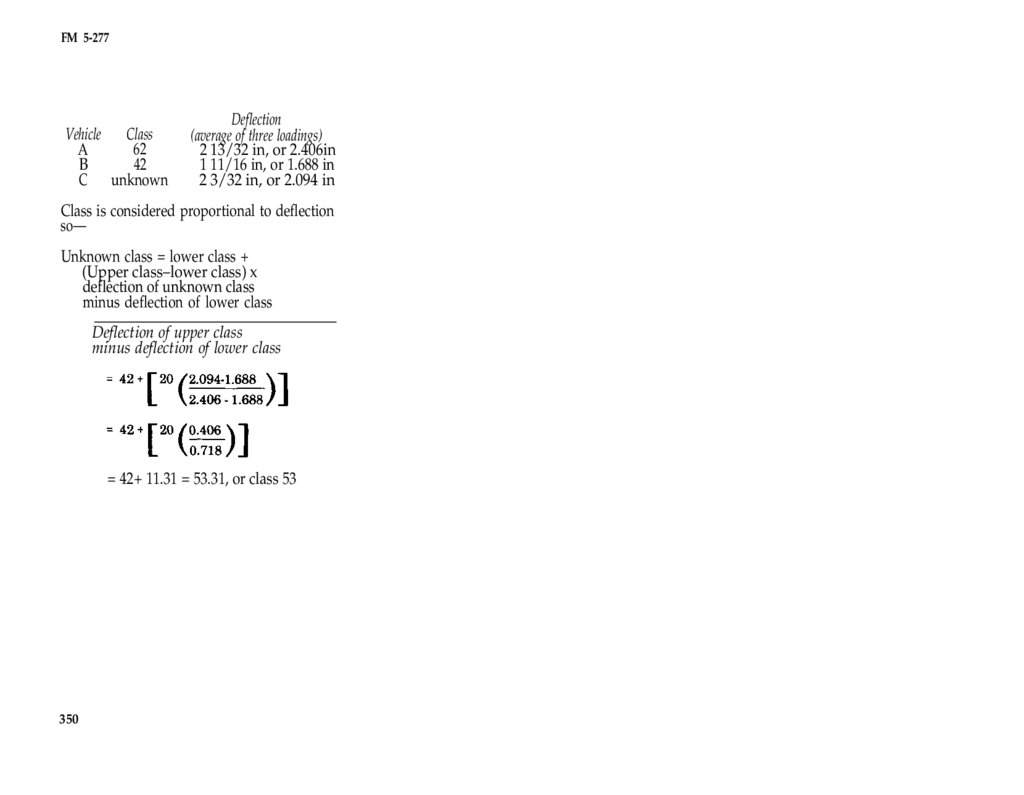
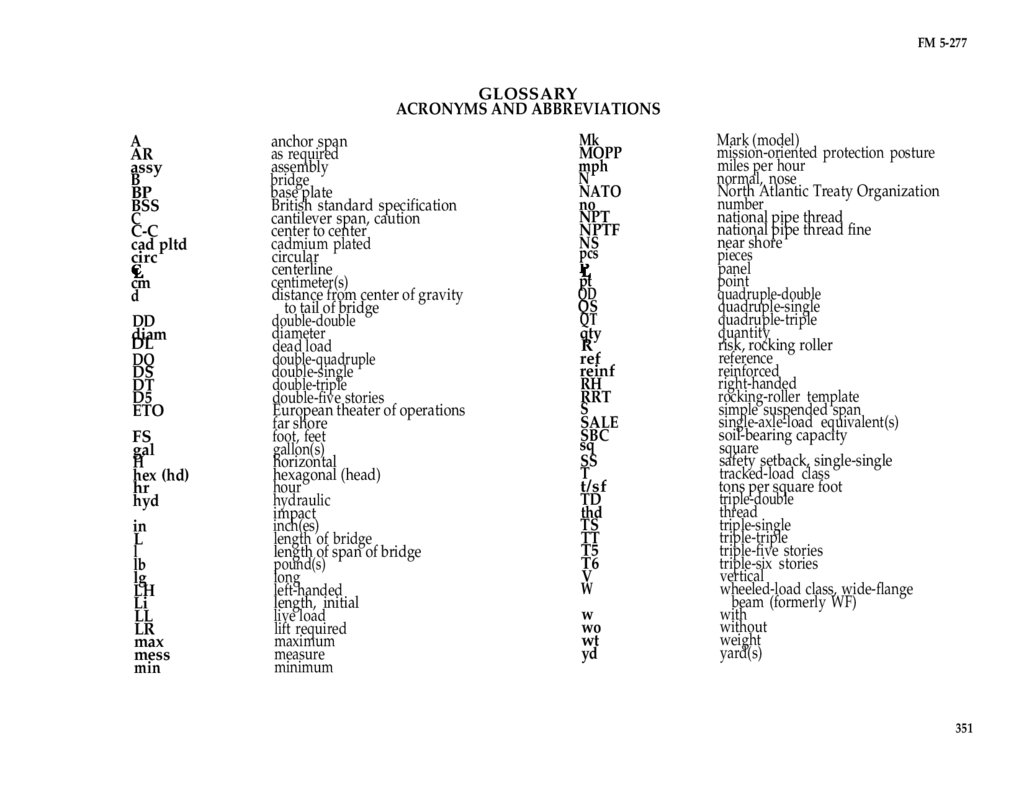
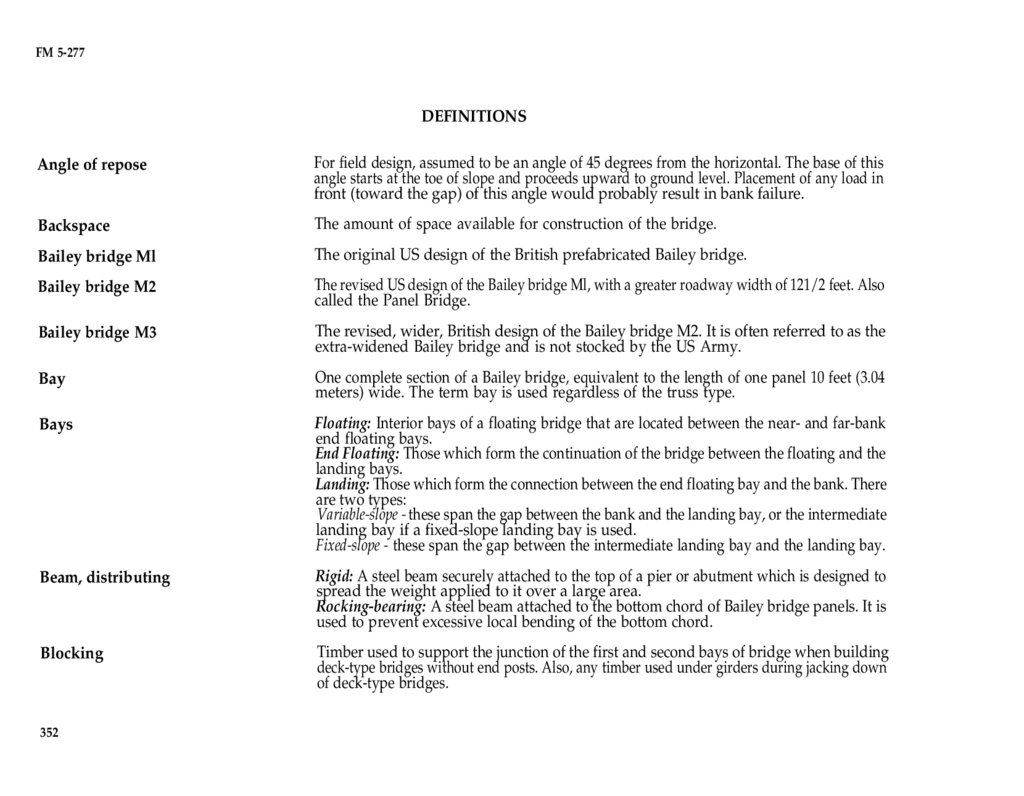
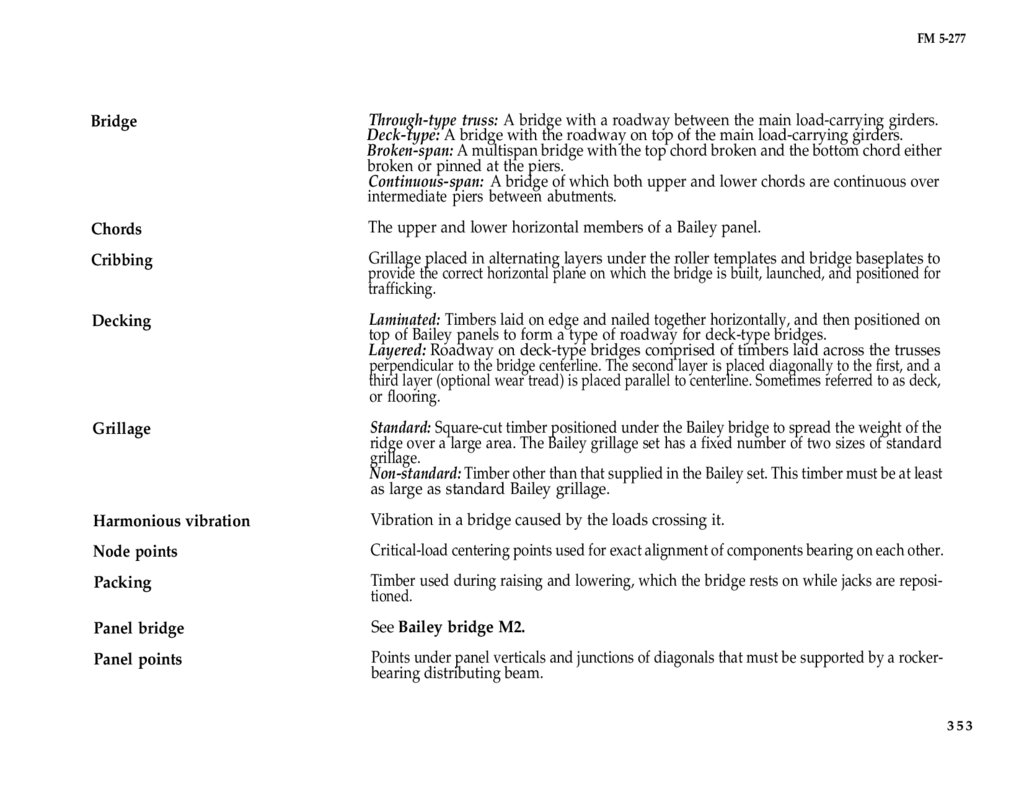
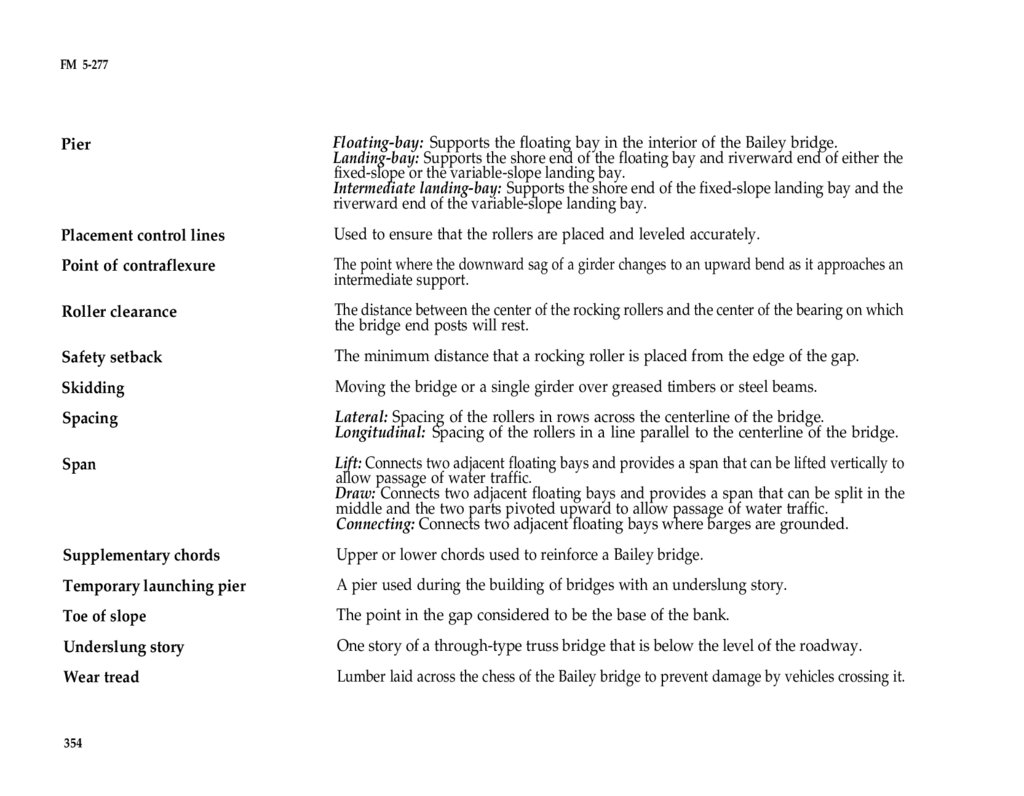
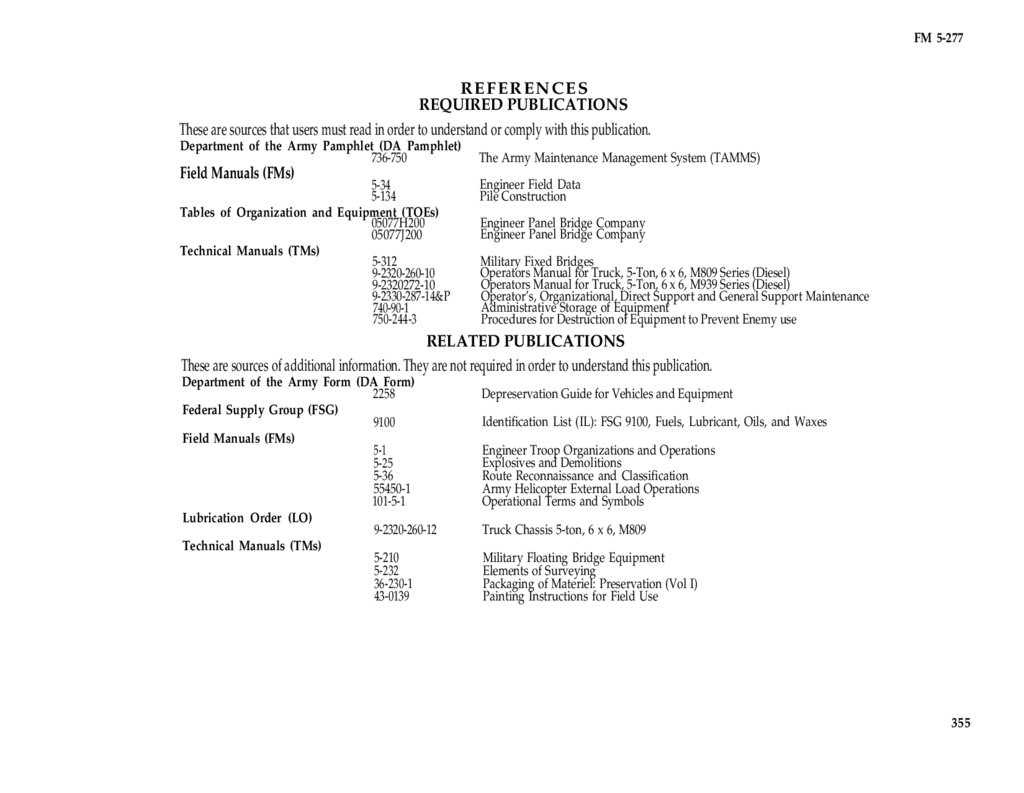
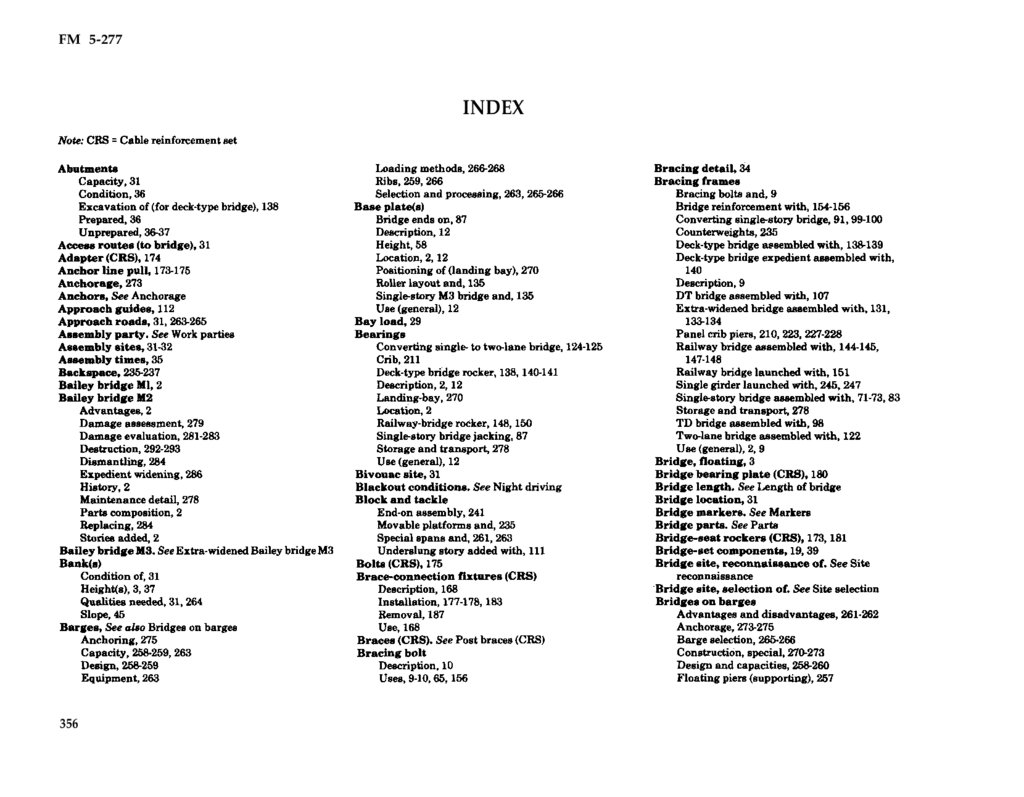

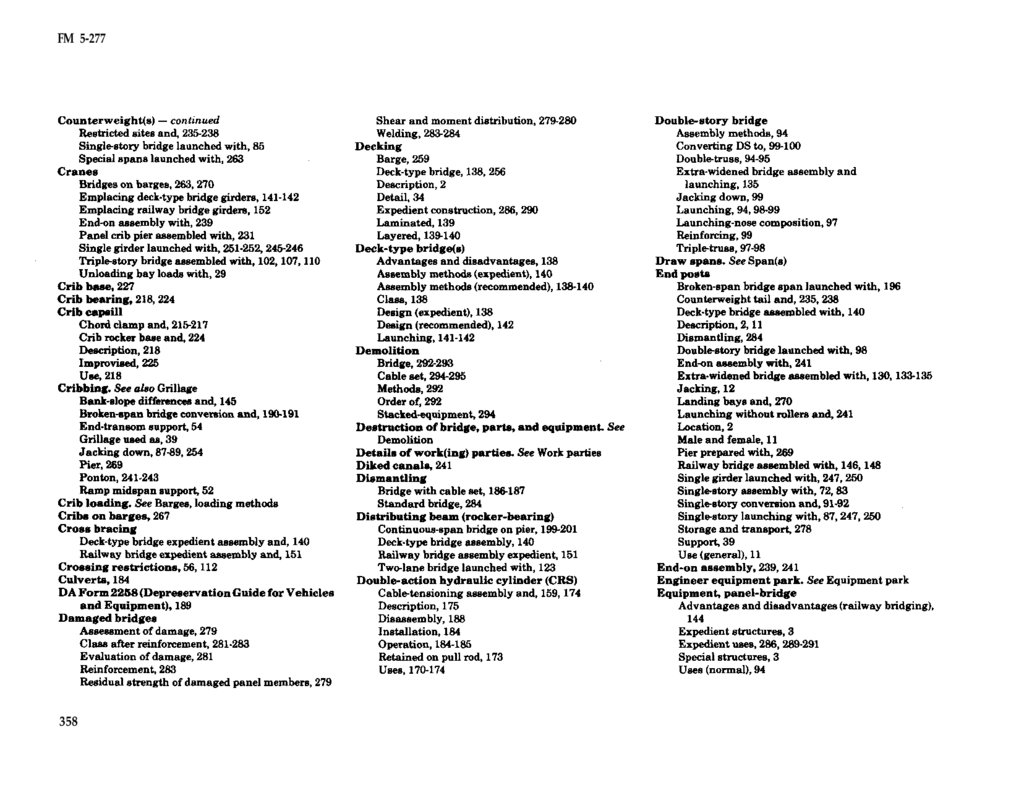
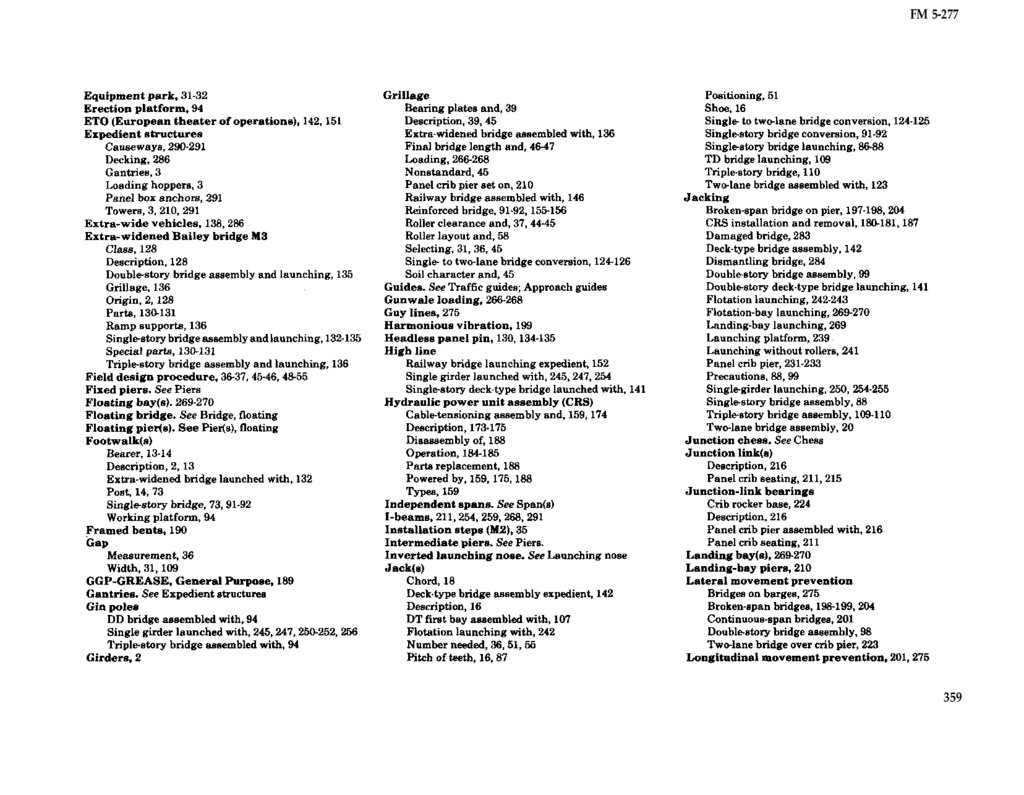
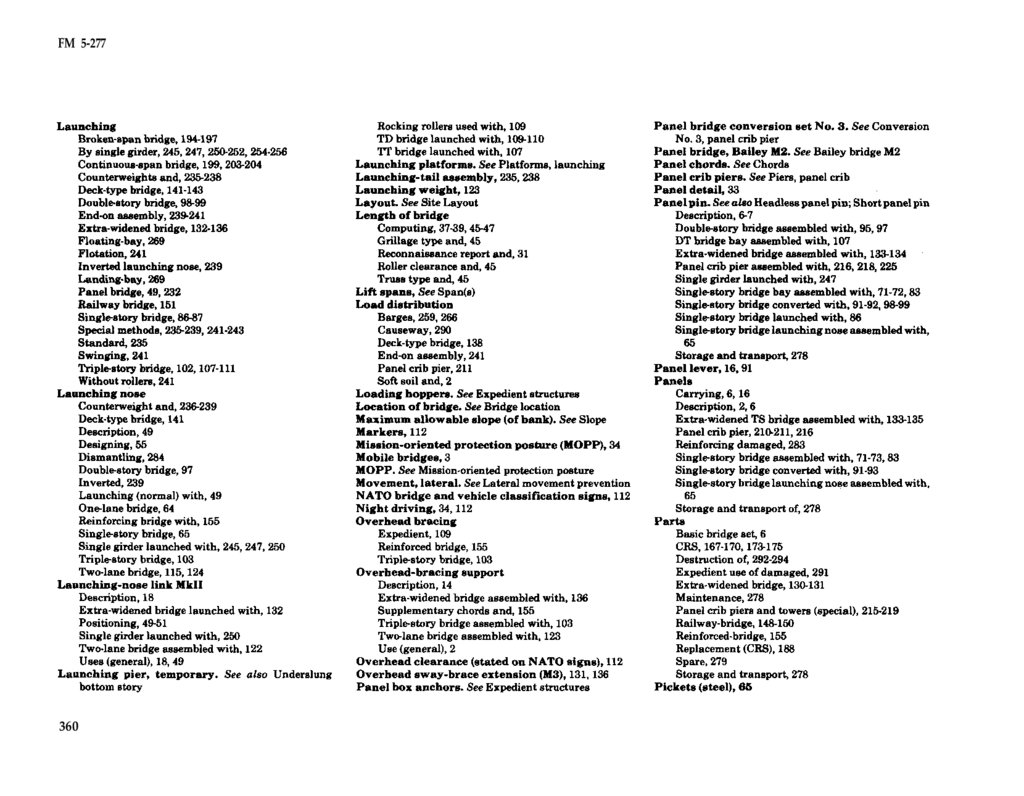
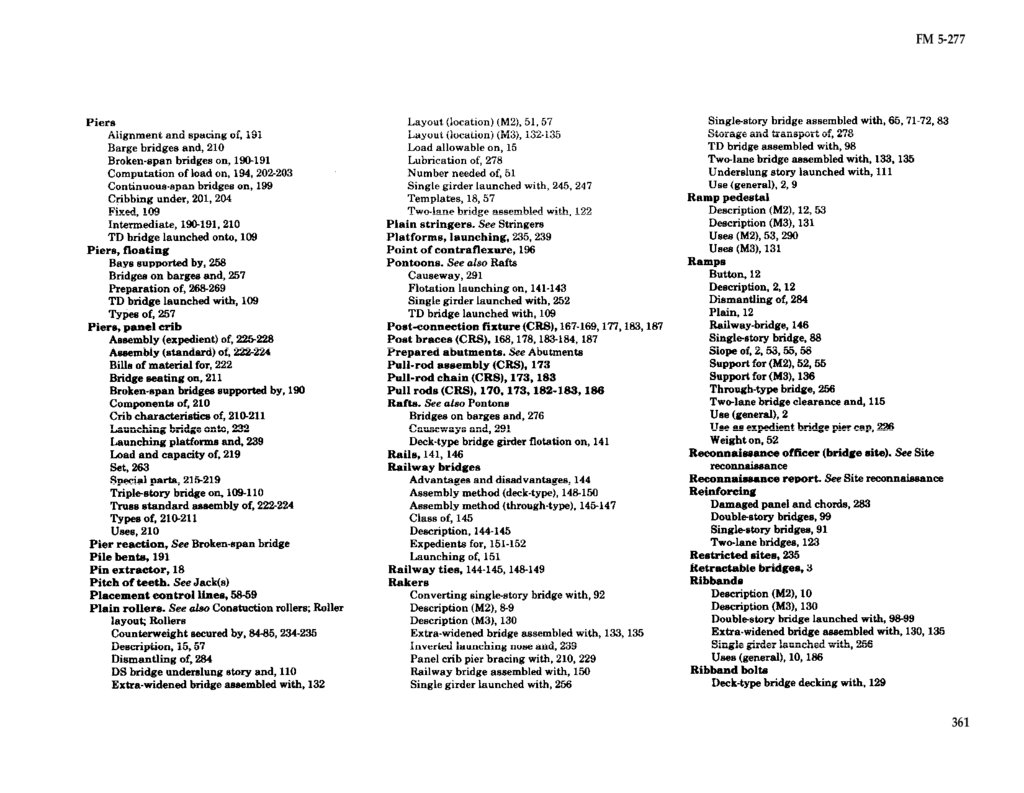
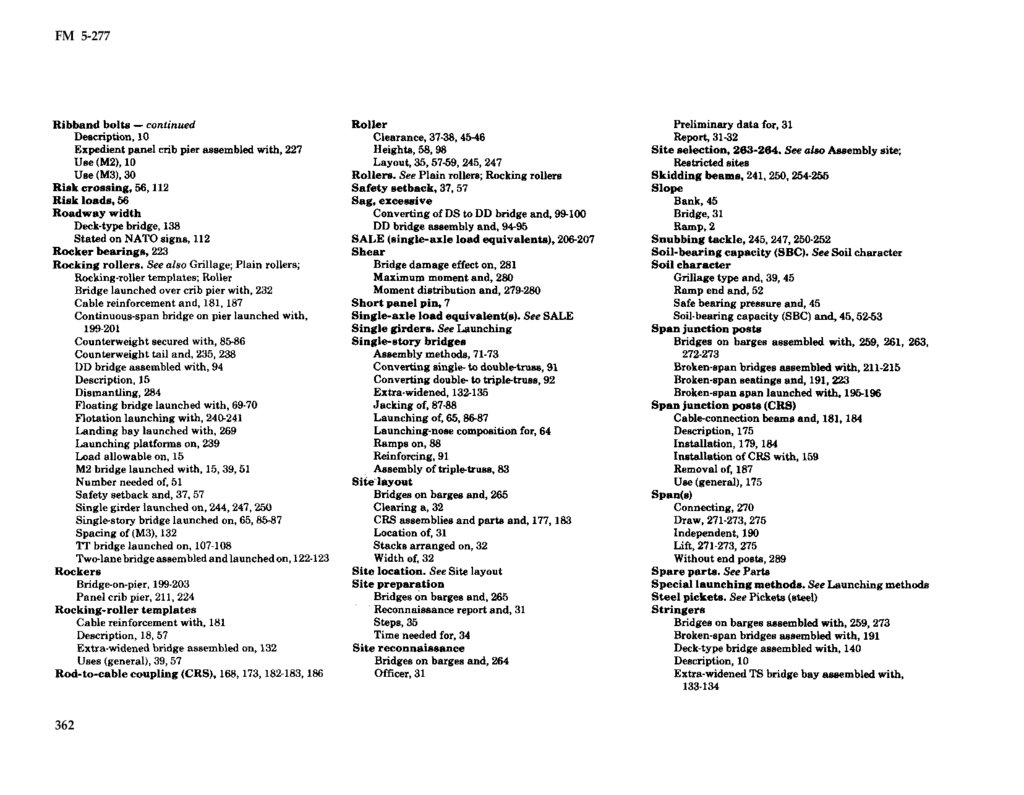
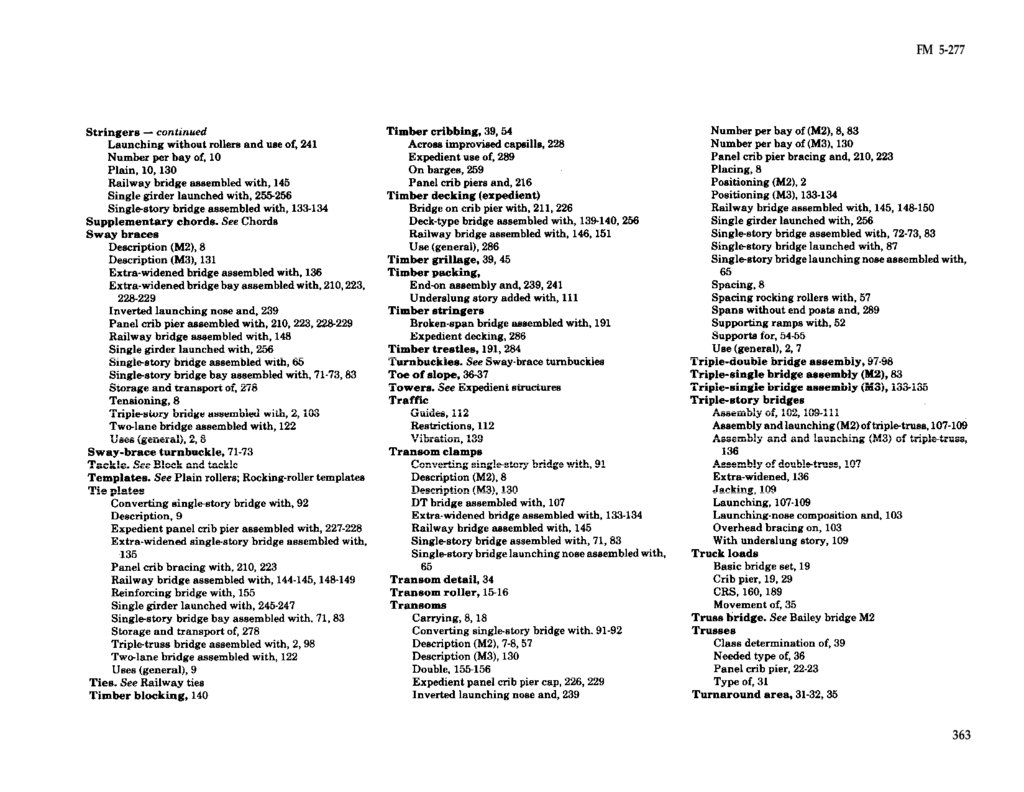
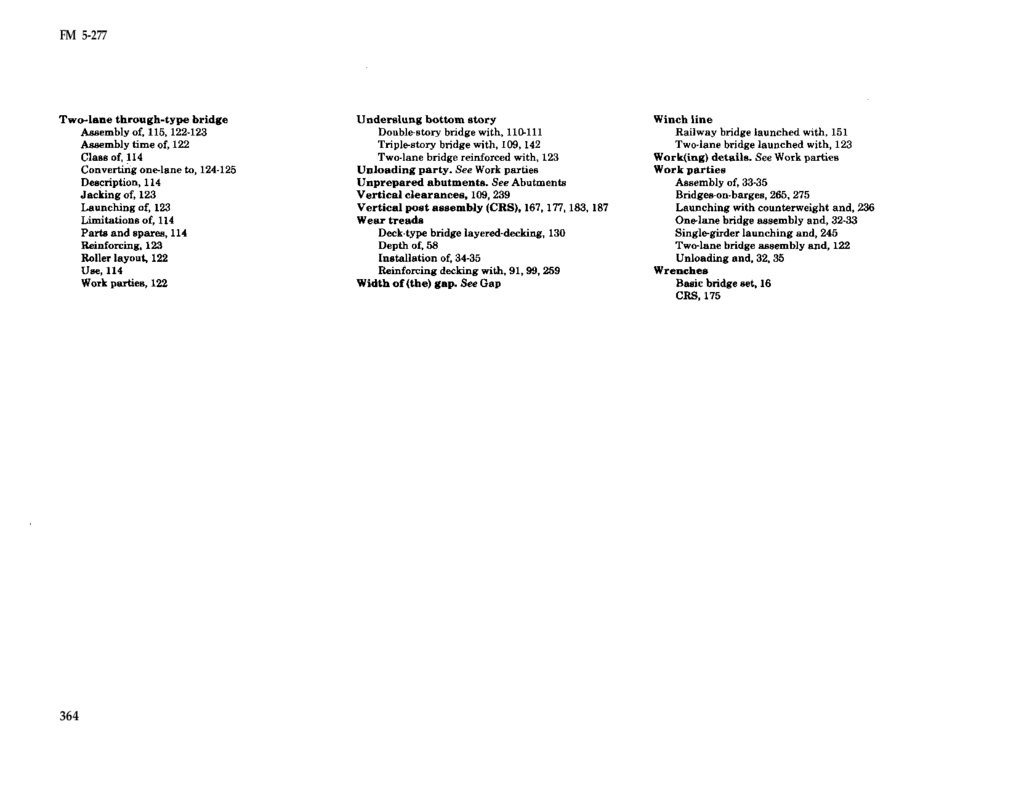
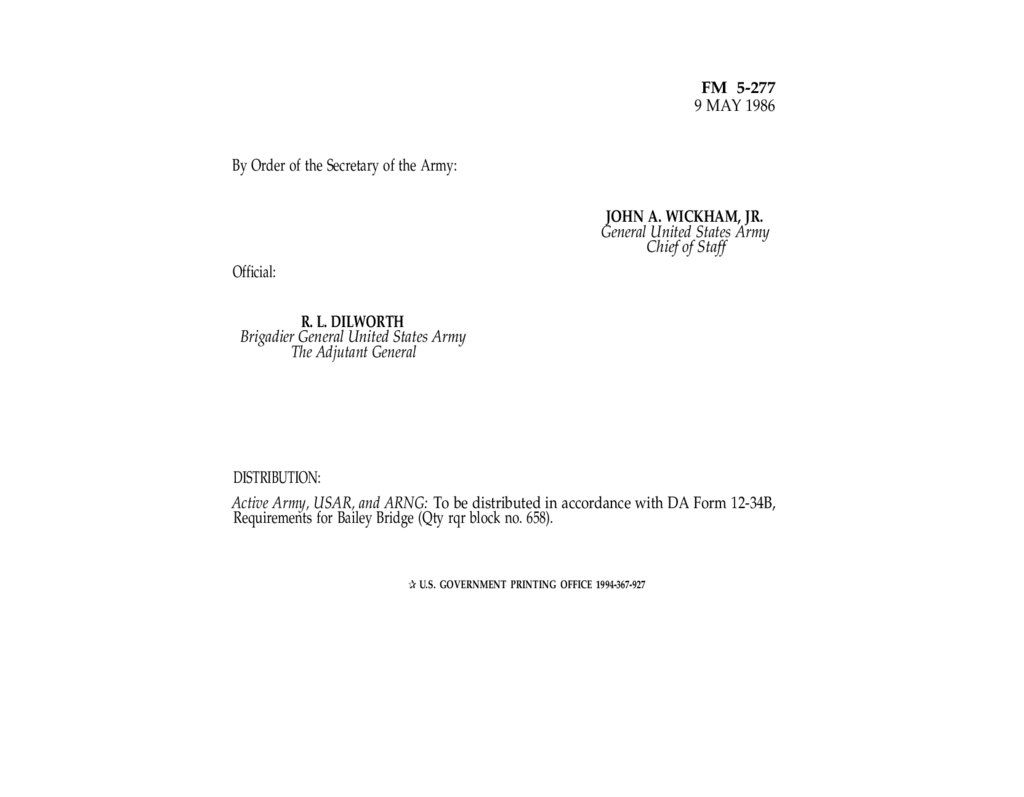
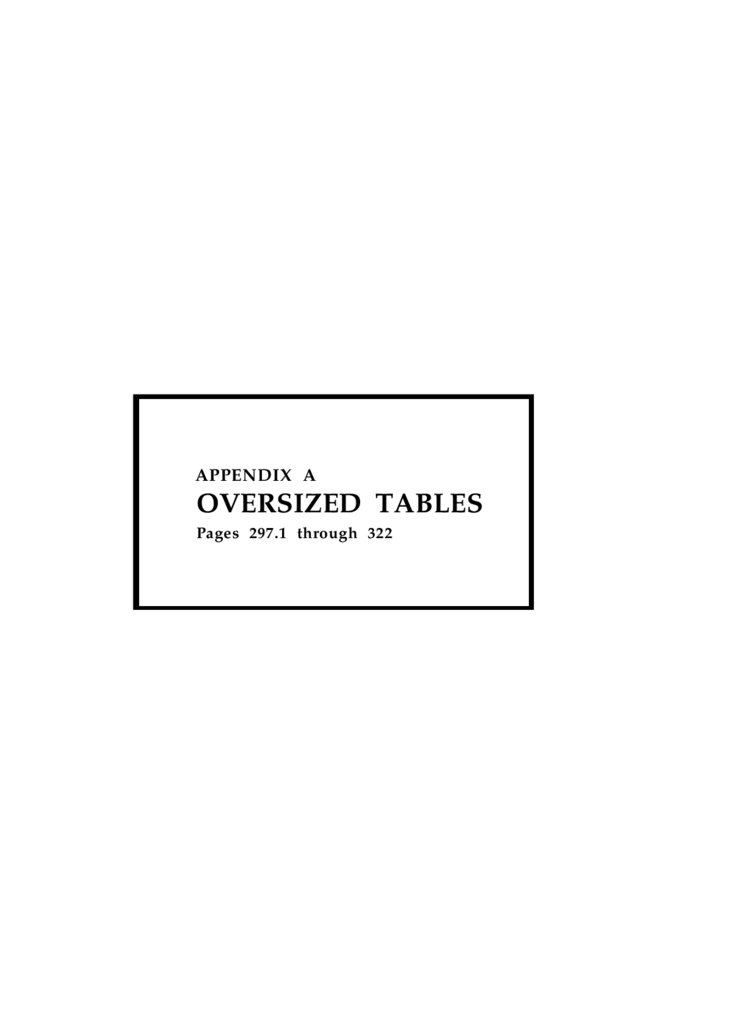
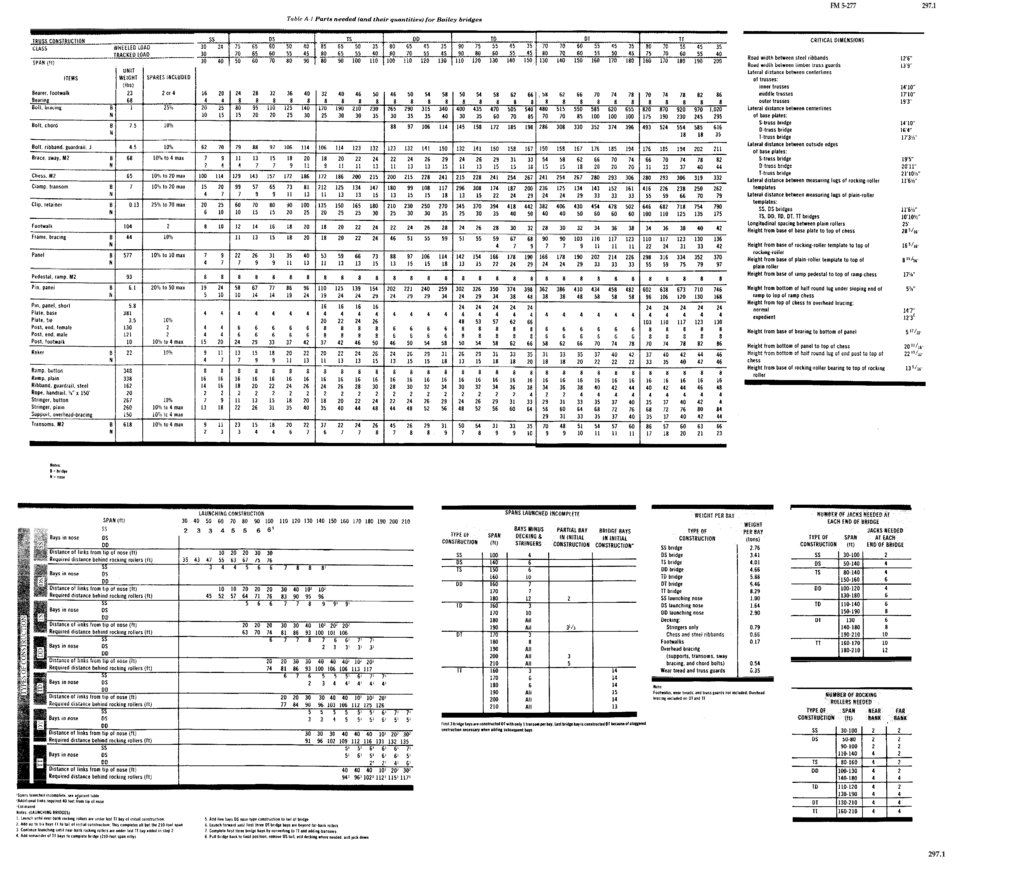

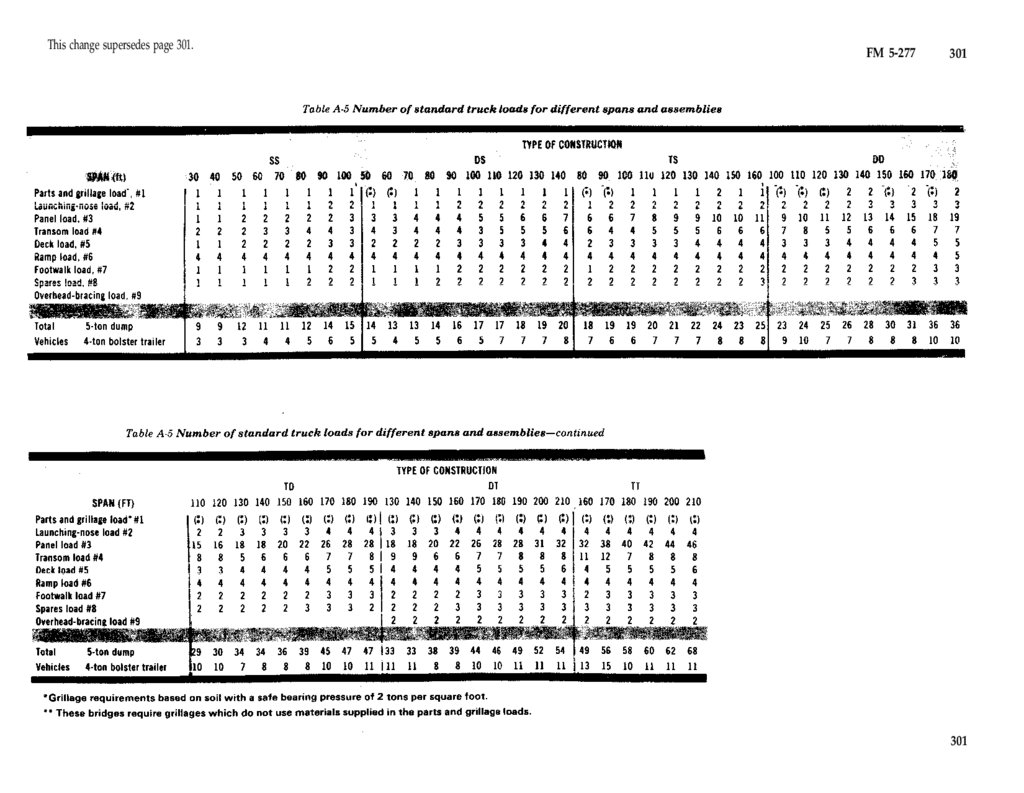
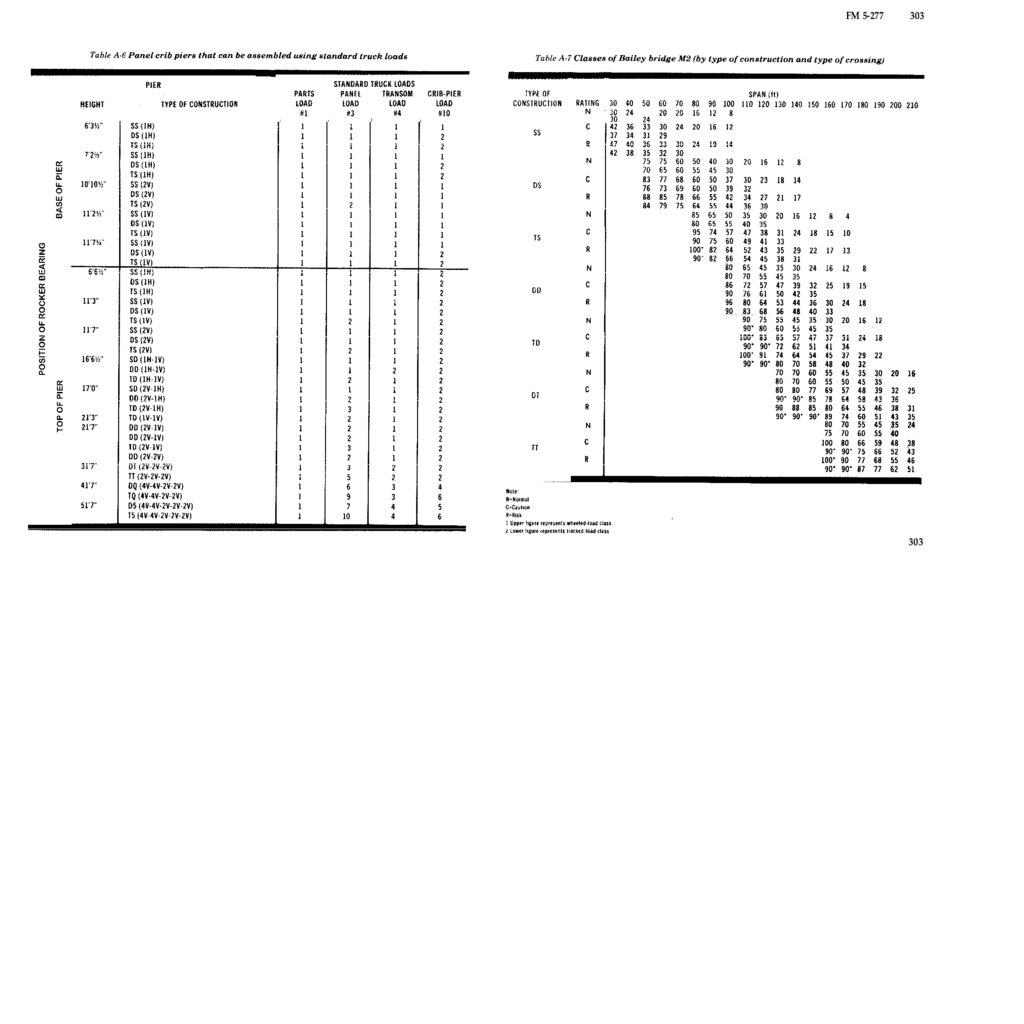
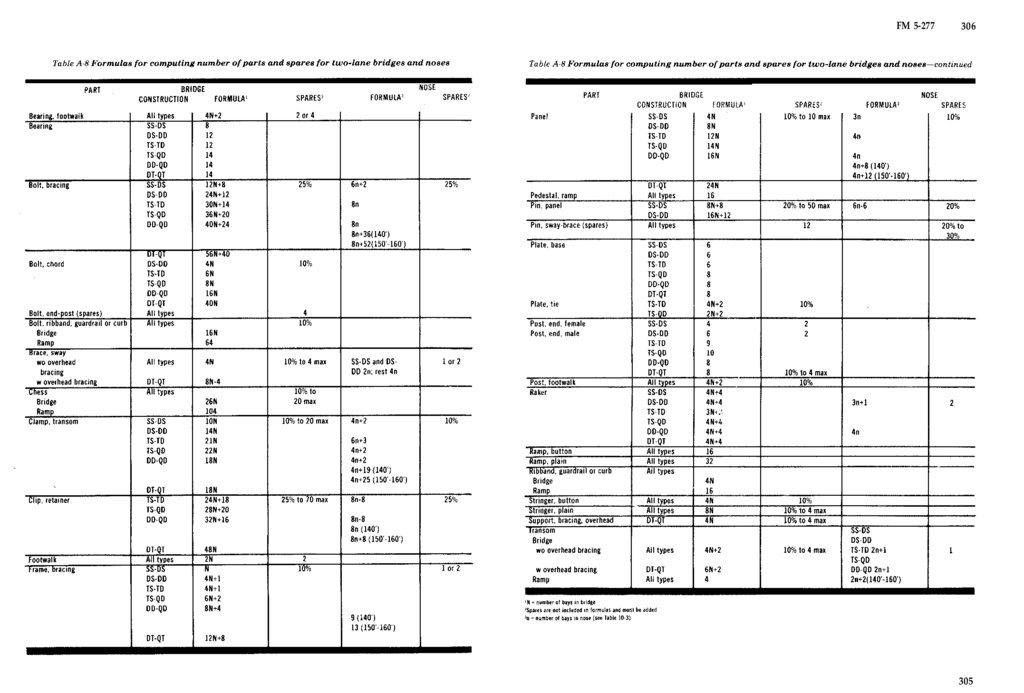
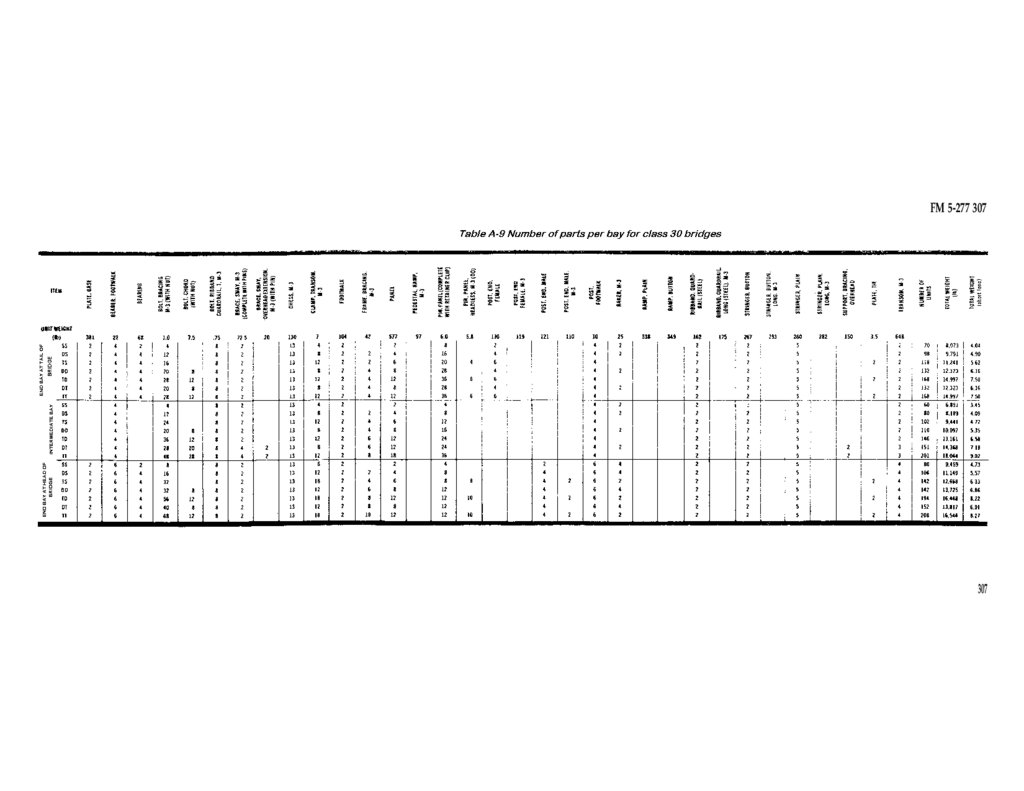
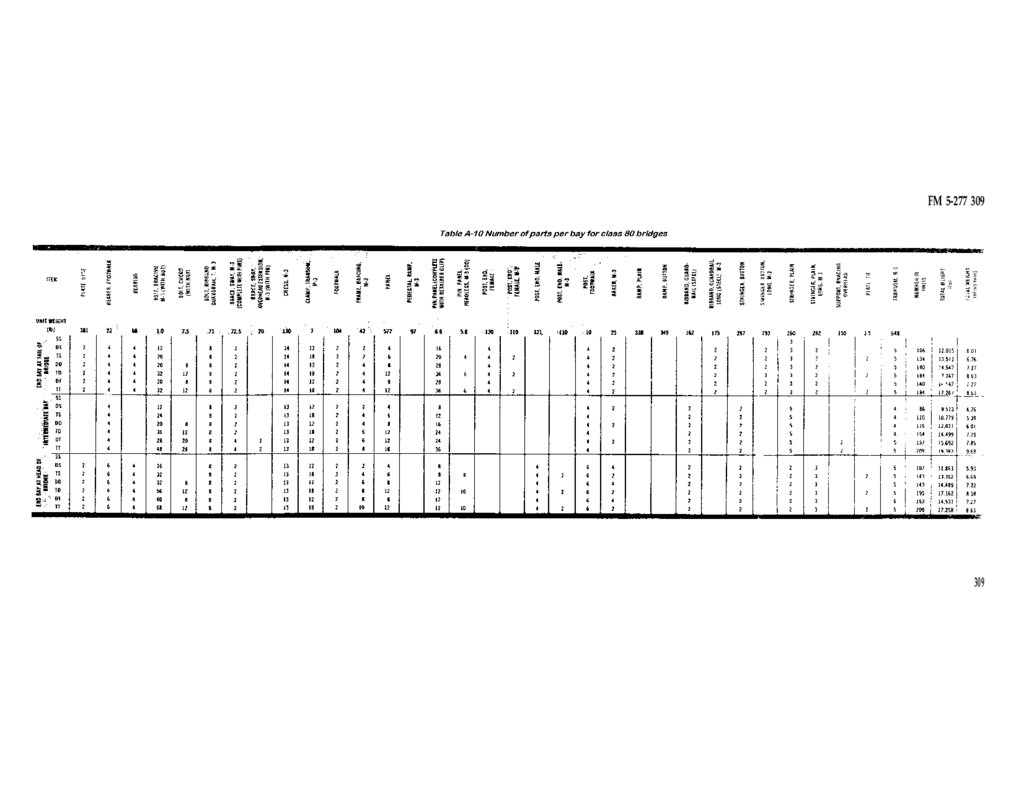
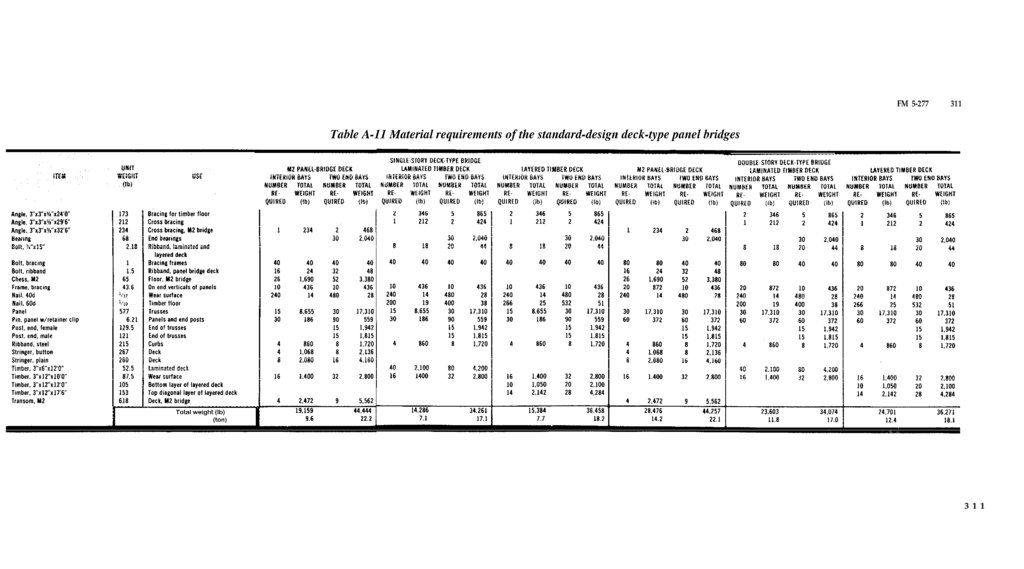
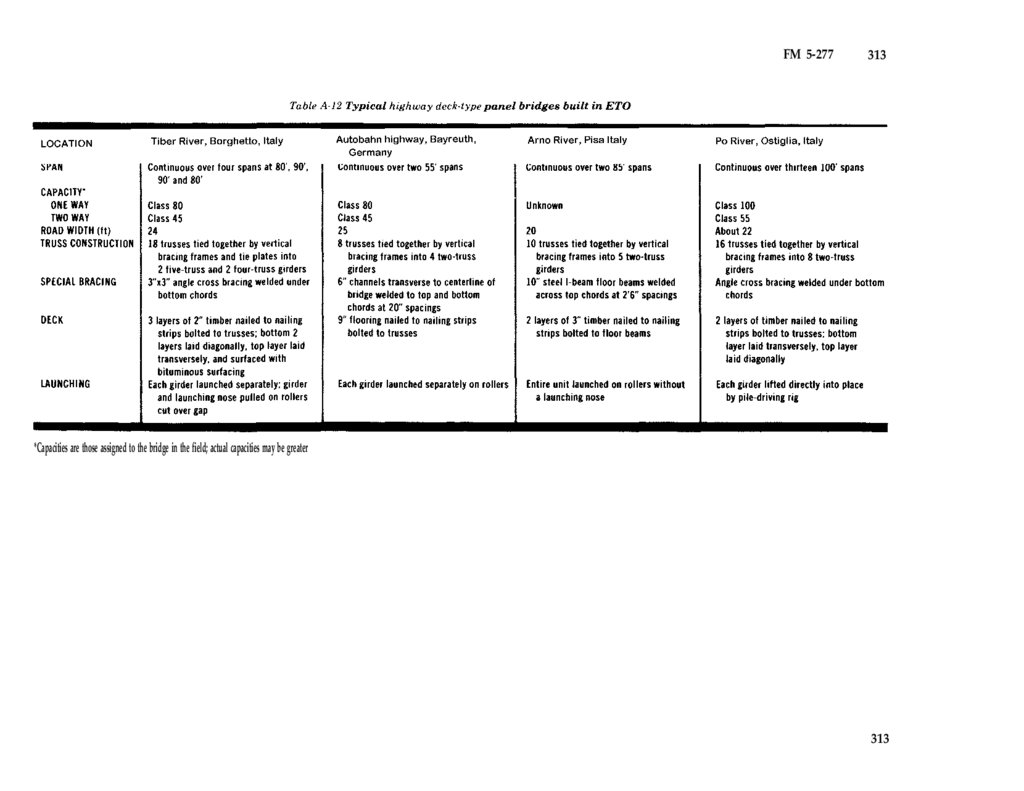
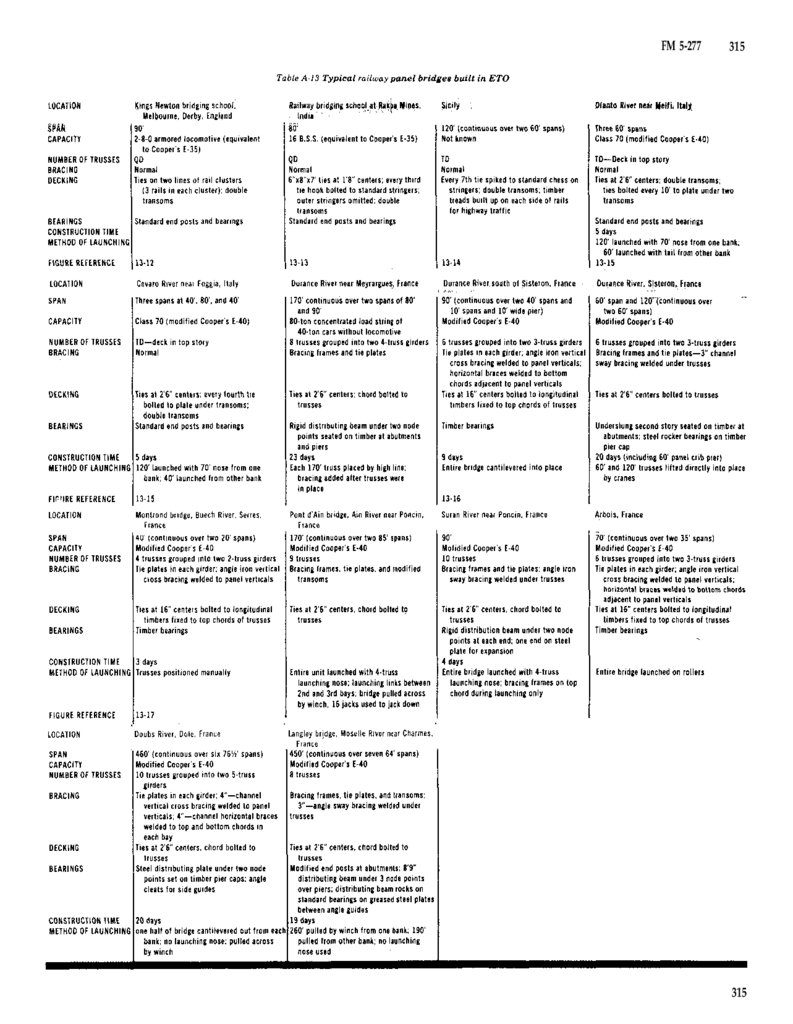
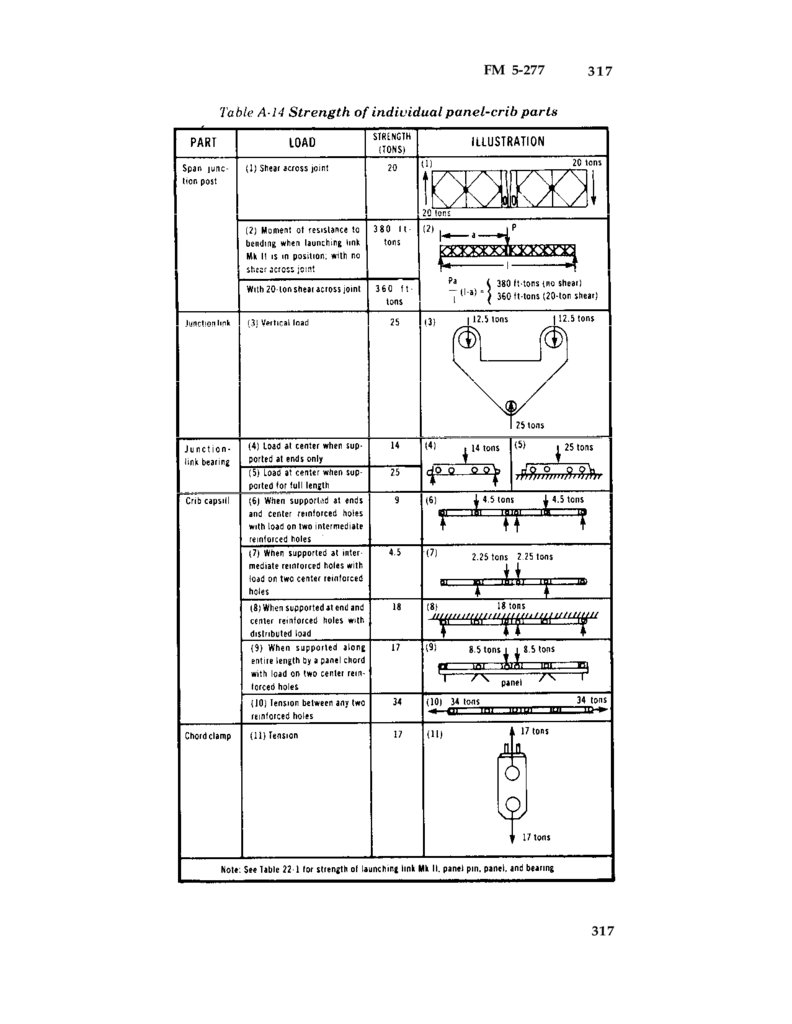
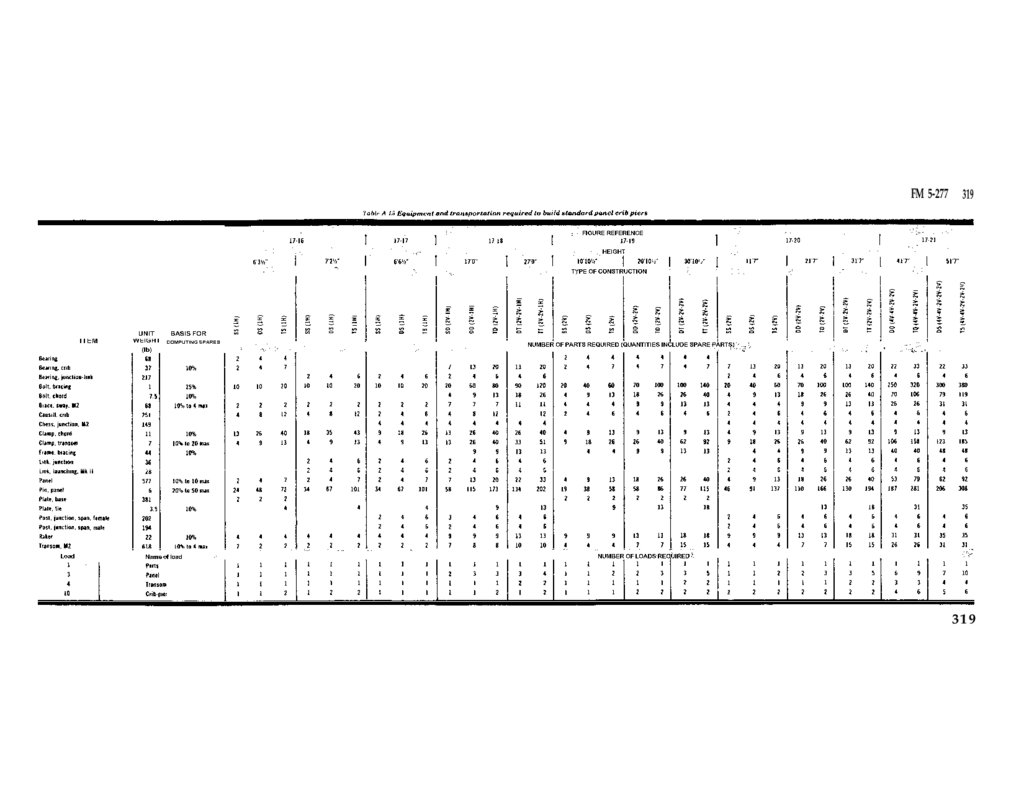
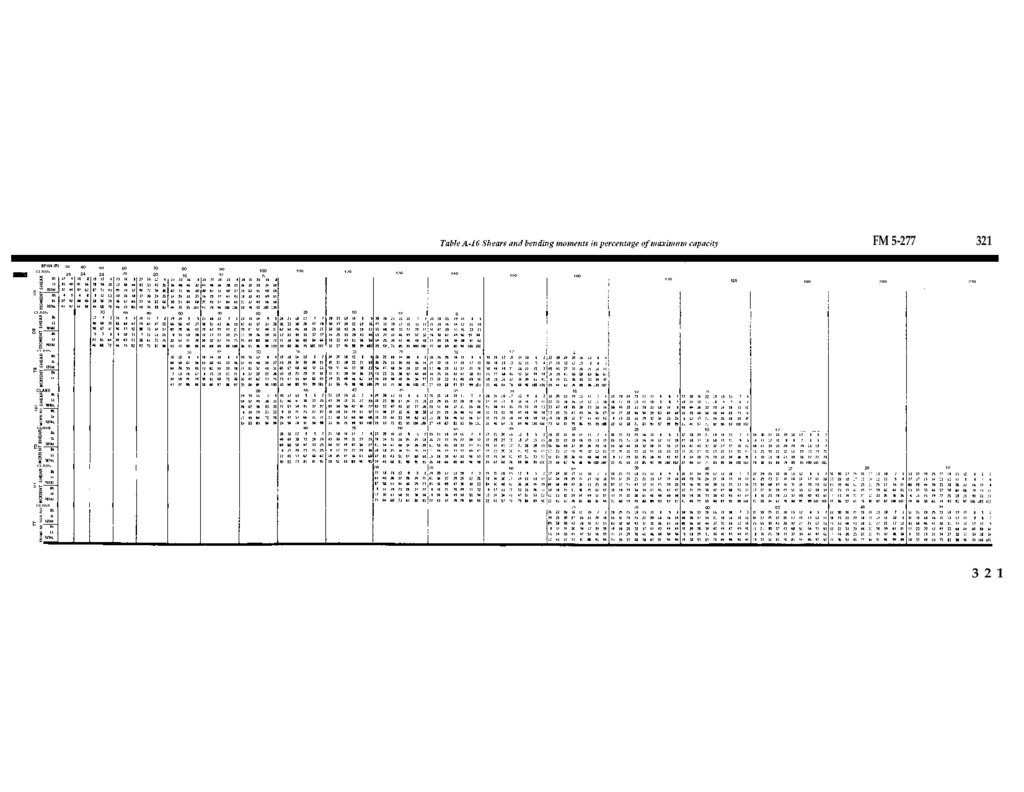

 marketing
marketing






